- Publisher’s Message
- Editor’s Notebook
- Airline News
- Airport Community
- Airport Employment News
- Airport Safety & Security
- AOA Reflections
- Company Spotlight
- Ground Services
- New York Aviation History
- Non-Rev Traveler
- Airport & Aviation Events
- Airport Employment
- Latest Issue

Subscribe for Updates
Get the latest local airport and aviation news delivered right into your inbox each week!
By signing up, you agree to the our terms and our Privacy Policy agreement.
News Updates

LaGuardia Terminal B Achieves LEED Gold Certification

STV Elevates Kristen Van Gilst to Chief of Staff

April 2024 Publisher’s Message

Travel By Air, The Golden Years: 1920s-1960s
The story of commercial air travel, in a heavier-than-air, winged aircraft, began on January 1, 1914, when the world’s first scheduled passenger service took to the skies in a single-engine Benoist flying boat piloted by pioneering aviator Tony Jannus for the St. Petersburg-Tampa Airboat Line. That morning, as a crowd of 3,000 gathered at St. Pete’s municipal pier, a ticket for the inaugural round-trip flight to Tampa was auctioned off, and former mayor Abraham Pheil won the honor with a bid of $400. Prior to lifting off from the St. Petersburg waterfront, Pheil climbed aboard the open cockpit biplane and squeezed onto a single wooden seat beside Jannus. Flying no higher than fifty feet over the water, the flight across the bay to Tampa took 23 minutes, as opposed to the two hours it would take by steamship, or the nearly 12 hours by railroad. Henceforth, the St. Petersburg-Tampa Airboat Line made two flights daily, six days a week, and charged a regular fare of five dollars per passenger. While the Airboat Line only operated for four months, it carried more than 1,200 passengers across the bay, and led the way for regularly scheduled trans-continental flights.
The Golden Age of Flight
In post-World War I, as the aviation industry grew, several commercial airlines began operations delivering U.S. Airmail, and then carrying passengers. In the 1920s and 1930s, the period between the two World Wars became known as the Golden Age of Flight. Many of the most notable early airlines were founded during this time period; Western Air Express and Ford Air Transport Service in 1925; Pan American Airways in 1927, which flew airmail from Key West to Havana, and Transcontinental & Western Airlines in 1930 (later TWA), when Western Air Express merged with Transcontinental Air Transport.
Life aboard a 1920s airliner was quite different from what it is today. Flying was a novel, upscale experience reserved for the wealthiest members of society and business travelers. Airliners carried less than 20 passengers and flew at lower altitudes in unpressurized cabins, frequently landing to refuel. Air travel was noisy and cold, and passengers wore their coats and hats to keep warm. In order to accommodate their every need, uniformed air stewards assisted passengers with their baggage and helped them board the aircraft. Onboard amenities included meals that typically included fruit compotes, cold fried chicken, and elegantly composed sandwiches served on lightweight dishware or wicker baskets. Before the advent of instrument flight in 1929, airplanes could not fly safely at night and had to circumvent mountains. Turbulence, lengthy flight times, airsickness, and other flight-related discomforts often resulted in travel anxiety. In order to keep air travelers at ease, airlines hired nurses to attend to passengers. In 1930, Ellen Church, a nurse and licensed pilot, was hired by Boeing Air Transport (now United Airlines) as the first female stewardess. Despite these discomforts, service evolved quickly in the 1930s. According to the Smithsonian National Air and Space Museum, the airline industry expanded from transporting 6,000 passengers in 1930 to over 450,000 by 1934, and 1.2 million by 1938.
The Douglas DC-3 would revolutionize commercial air travel when it had its first flight in 1935. Faster, larger, and more comfortable than its predecessors; the first DC-3, the Douglas Sleeper Transport, was the pinnacle of luxury, with plush seats in four main compartments designed to fold down from the cabin ceiling into sleeping berths. The aircraft could accommodate up to twenty-eight passengers for shorter day flights and fourteen overnight. As a reliable, economical, and profitable airliner, commercial aviation industry giants such as American, United, and TWA ordered the DC-3 for their fleets in 1936 and many other airlines followed suit in the next two years.

The 1930s heralded in many of the earliest commercial trans-Atlantic flights. Pan American Airways was a forerunner, carrying passengers across the Atlantic in their fleet of flying boats, or ‘Clipper’ aircraft. Transatlantic service began in May of 1939, first flying from Port Washington, Long Island, as the new Marine Air Terminal at LaGuardia was being built. That same year, Boeing 314s were considered the ultimate ‘Clippers’, carrying up to seventy-four passengers across the Atlantic and entering trans-Pacific service, linking all the continents in the Northern Hemisphere. The B-314 was a long-range flying boat that could land anywhere at sea, providing the destination had a sheltered harbor in which it could taxi to. But transport in the 314 was still reserved for the very wealthy, and a return ticket between Manhasset Bay in Port Washington to Southampton, England cost over $650; the equivalent of over $12,000 today.
Striving to provide the most pleasant flight experience, Pan American Airways set the gold standard of passenger service. The Boeing 314 had a large upper flight deck and a lower passenger cabin divided into five seating compartments. There was a galley kitchen, a baggage compartment, men, and women’s changing and restrooms, as well as a main lounge that converted into a dining room. White-gloved, tuxedo-clad stewards catered to their passenger’s needs. Meals were lavish experiences with gourmet foods and drink served on fine china, and silverware set on white linen tablecloths. Sleeping quarters on the 314 were roomier than earlier Clippers and its aft De Lux Compartment was called the ‘Bridal Suite’.
“I have heard many planes referred to as flying hotels, but none is more worthy of that description than the Pan American Airways Clipper.” A Wright Aeronautical Co. observer on a B-314 survey flight
First flown in 1938, the Boeing 307 Stratoliner was the first four-engine airliner with a pressurized cabin, allowing it to cruise at an altitude of 20,000 feet, well above the clouds and higher than rough weather. Pan American entered the B-307 into scheduled domestic service on July 4, 1940, with routes to Latin America, and from New York to Los Angeles. The nearly 12-foot-wide cabin carried thirty-three passengers in comfort and provided space for comfortable berths for overnight travelers, as well as observation areas for those who bought the more expensive seats. The airplane’s circular fuselage provided maximum space for five crew members and the Stratoliner was the first land-based airliner to have a flight engineer as a member of the crew.
With the onset of the Second World War, commercial air travel came to a virtual halt and was limited only to those serving the war effort. But commercial aviation, along with the aviation industry as a whole, grew substantially during wartime with the development and production of large-scale aircraft and the utilization of ex-military bombers and transports that were easily converted into commercial airliners. In the post-war years, Lockheed C-69 Constellations, used as transports by the U.S. Army Air Forces, were purchased from the government by TWA and converted into civilian airliners for their fleet. After TWA’s first transatlantic demonstration flight in the Constellation, or ‘Connie’ in December of 1945, TWA launched its transatlantic service in the Connie with a flight from New York to Paris on February 6, 1946.
The Golden Age of Air Travel
After 1945, American aircraft technology set the standard for international air operations, and toward the end of the 1940s, major carriers achieved a strong foothold on international travel.
As the decade of the 1940s ended, the era of commercial flight between the 1950s and 1960s was born and became known as the ‘Golden Age of Air Travel’ and the ‘Jet Age’. By 1950, the trans-Atlantic route became the most traveled in the world, and its growing trade produced high profits and intense competition between major international airlines. In the United States, commercial jet service began with the introduction of the Boeing 707 and Douglas DC-8. Larger and more economical than its previous airliners, Pan American began international flights on the B-707 in October of 1958. National Airlines soon began domestic jet service with the 707, and American Airlines opened its own domestic jet service in January of 1959, with a flight from New York to Los Angeles. At the end of the decade, for the first time in history, more people in the United States traveled by air than by railroad.

Despite its immense growth, air travel was still expensive and reserved for the elite – celebrities, and movie stars, who were called the ‘Jet Set,’ a name coined in the early 1950s by journalist Igor Cassini. Since commercial flight was still a unique, awe-inspiring event, passengers often documented their experience on airline postcards and posed for group photos prior to boarding. They dressed in their finest clothes, with women in dresses and heels, and men in tailored suits. First Class was spacious, and ‘economy’ seating provided up to six inches more legroom than today. With an increased market for air travel, airlines competed to outdo each other by offering their passengers extravagant amenities; in-flight entertainment, free-flowing cocktails, and fancy multi-course meals that included soup, salad, carved meats, vegetables, dessert, and even lobster. In a 1952 TWA (Trans World Airlines) ad captioned, ‘’Have dinner tonight with the stars!”, an elegantly dressed couple is depicted sitting before a lavishly set table while being served by a burgundy-coated steward and a perfectly coiffed stewardess in uniform and cap.
As the Golden Age of Air Travel led on, well into the 1960s, those who were fortunate enough to enjoy travel on the newest commercial jetliners featured some of the biggest celebrities of the day, including the Beatles, who arrived at JFK International in New York from London aboard a Pan American Boeing 707, to thousands of screaming fans, and some 200 journalists in February of 1964 ….fifty years after the first scheduled flight in the Benoist flying boat before a crowd of 3,000. And while the principles of flight remain the same, commercial air travel as we know it today may not be as lavish an experience as it once was during its Golden Days, but it certainly has come a very long way.

Experience the Golden Days of Air Travel
Today, the Pan Am Museum Foundation Exhibit at the Cradle of Aviation Museum in Garden City, Long Island pays tribute to Pan American World Airways as a pioneer in commercial aviation through the preservation of Pan Am artifacts, memorabilia, and images that commemorate the company’s history and the people behind this legendary airline.
Also today, at the TWA Hotel at JFK International Airport, visitors are welcome to view the New York Historical Society’s curated exhibitions celebrating TWA’s history. Located within and throughout the former iconic TWA terminal, designed by Eero Saarinen in 1962, the exhibits allow visitors to experience the Jet Age through authentic artifacts, interactive displays, uniforms, memorabilia, and personal narratives. Both are a must see!

Julia Lauria-Blum earned a degree in the Visual Arts at SUNY New Paltz. An early interest in women aviation pioneers led her to research the Women Airforce Service Pilots (WASP) of WW II. In 2001 she curated the permanent WASP exhibit at the American Airpower Museum (AAM) in Farmingdale, NY, and later curated 'Women Who Brought the War Home, Women War Correspondents, WWII’ at the AAM. Julia is the former curatorial assistant at the Cradle of Aviation Museum and is currently an editor for Metropolitan Airport News .
RELATED NEWS & UPDATES

National, the Sunshine Airline

LaGuardia Gateway Partners Welcomes Frontier Airlines to LGA Terminal B

Korean Air to Roll Out Eco-Friendly Uniforms for Maintenance, Aerospace and Cargo Teams

Korean Air Celebrates 45 Years of Serving New York

Air Premia Joins TSA PreCheck Program, Expediting Security Screening for U.S. Travelers

Avianca Airlines Perfectly Times Its Landing In Times Square
Such an interesting historical synopsis of commercial aviation! Well done!
In June 1967 I flew out of El Toro Marine Air Base California towards Vietnam. I returned to SF International in September 1968 via another commercial airline. As did thousands of other GIs going to Vietnam but not so many coming home. I highly recommend purchasing the book by BJ Elliott Prior titled Behind My Wings.
Thank you for comments, Robert. I look forward to obtaining a copy of Behind My Wings and reading about the GIs returning home. I have very strong visual memories of the returning veterans, and especially the POWs.
Save my name, email, and website in this browser for the next time I comment.
This site uses Akismet to reduce spam. Learn how your comment data is processed .
Type above and press Enter to search. Press Esc to cancel.

- Aviation History
Aviation In The 1920’s – 1930’s
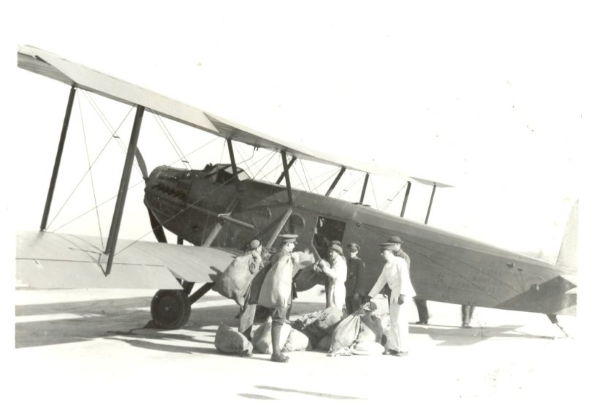
It is unknown when the first passenger aircraft services took place in the United States, but one of the earliest recorded instances was in 1913.
Sular Christofferson transported passengers between San Francisco and Oakland harbours by hydroplane.
Another early instance was in 1914 when passengers were carried from Tampa and St. Petersburg, Florida by a Benoist airboat.
One of the first steps in commercial aviation was the development of the multi-engine airplane by Alfred W. Lawson after WW1.
The Lawson C-2, built in 1919, was created specifically to carry passengers.
Related Article – Instrument Proficiency Check (IPC): 4 Things You Need To Know
The plane was somewhat a failure; the price of military aircraft was much cheaper, so the C-2 was not worth the price to buy.
Lawson went on to build the L-3 and L-4, both larger aircraft that were capable of carrying 34 passengers and up to 6,000 pounds of cargo.
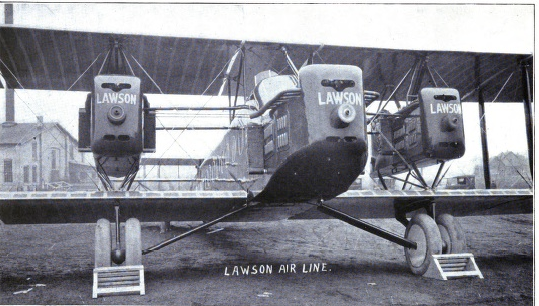
Problems arose once again, this time after the plane crashed on its first flight, causing the development of the L-4 to come to a halt.
In 1920, a Florida entrepreneur by the name of Inglis Uppercu started to offer international flights from Key West, Florida, to Havana, Cuba.
The service was eventually extended to other parts of the country, and there were flights between Miami and the Bahamas, New York and Havana, and the Midwest states of Cleveland, Ohio, and Detroit.
Uppercu’s Aeromarine Airways’ “airborne limousines” were going strong until one crashed off the coast of Florida, resulting in the death of four passengers and the company going out of business in 1924.
One of the big moments in commercial aviation came when mail began to be delivered by air.
In the early 1900s, the common means of transportation for mail was by railroad systems connecting cities in the country.
The first official airmail flight took place in 1918, and it rapidly increased after that.
Related Article – Airline Transport Pilot Certificate (ATP): 4 Things You Need To Know

By 1925, the U.S. Post Office was delivering 14 million pieces of mail per year by airplane.
This new mailing method was especially popular among those in the financial industry who wanted a quicker way to mail checks and documents.
Airmail was eventually transferred to private companies from the government, and the Contract Air Mail Act of 1925, known as the Kelly Act, was sponsored.
The act was the first big step in creating the private U.S. airline industry.
Soon after the establishment of the Kelly Act, the Post Office began to give out contracts to private companies after they bid on certain routes.
This continued to expand for almost a decade, and the private companies went on to become the major transportation players in commercial aviation.
Henry Ford was awarded the Chicago-Detroit and Cleveland-Detroit routes after obtaining the Stout Metal Airplane Company in 1925.
He went on to establish the Ford Air Transport Service, and he developed the “Tin Goose,” an all-metal Ford Trimotor.
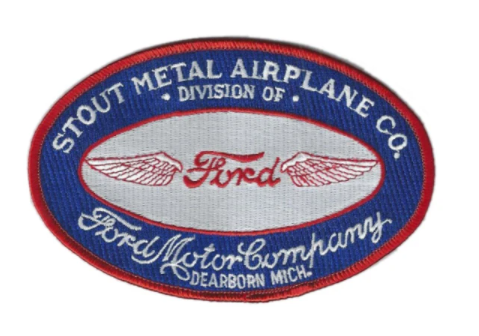
Ford was involved in the mailing industry for a short three years before going back to manufacturing.
The government created a national aviation policy in 1926 after President Calvin Coolidge appointed a board headed by Dwight Morrow, a senior partner in J.P. Morgan.
Morrow was not supportive of directly subsidizing airlines.
Instead, he wanted the government to fund a national air transportation system, which was taken up and recommended by Congress in the Air Commerce Act of 1926.
Related Article – 12 Runway Markings and Signs Explained By An Actual Pilot
The act gave a lot of authority to the Secretary of Commerce, who then had a role in the development of air navigation systems, air routes, the licensing of pilots and aircraft, and investigations surrounding accidents.
The Kelly Act was eventually amended by Congress, and the government carriers were paid based on the weight of the mail they were carrying.
These changes played a big role in the financial success of the airlines.
Research and training were also going through changes in the 1920s, especially with the establishment of a foundation by Harry Guggenheim.
His foundation aimed to develop flight instruments and educate aeronautical engineers at universities.
Besides his foundation, Guggenheim was involved in funding the Western Air Express, which included a $180,000 experiment to know if airlines could profit solely from passenger transportation.
The experiment failed after they were not able to make sufficient money without the subsidies.
The Western Air Express experiment was one of many that failed.
This changed in May of 1927 when Charles A. Lindbergh flew solo to Paris.
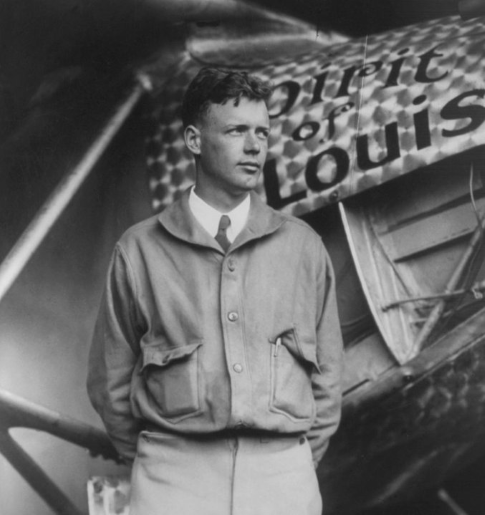
After the successful flight, investors were excited, and aviation stocks tripled between 1927 and 1929.
This helped propel the commercial aviation industry forward.
Even with all of the developments in commercial aviation, passengers could still get to their destination faster by train in the late 1920s.
There were too many limitations with planes compared to trains, which were able to travel through mountains, could run at night, and did not have to land and refuel like aircraft.
On top of that, trains were more comfortable than planes.
Passengers in the air dealt with loud noises, forcing them to put cotton in their ears, and the cabins were un-pressurized.
Despite all of the uncomfortable and limiting aspects of air travel, air travel grew in popularity.
The number of airline passengers in the United States went from less than 6,000 in 1926 to about 173,000 in 1929.
The passengers mostly consisted of businessmen, who increasingly had their tickets paid by employers.
The Ford Trimotor 5-AT, introduced in 1928 and produced through 1932, was popular among most U.S. airlines.
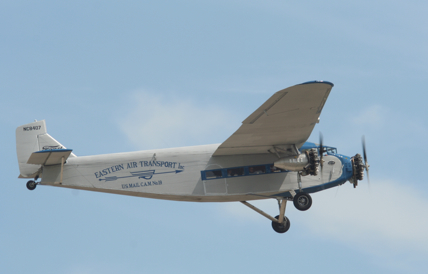
It carried up to 15 passengers, and there was one still being used all the way up until 1991 in Las Vegas.
The aviation industry continued to grow with the creation of jobs, airports, warehouses, aeronautical schools, and new technology.
The first instrument navigation package was used by U.S. Army lieutenant James Doolittle in September 1929.
Related Article – 5 Best Low Time Pilot Jobs With 250 Hours
Research at the Full Flight Laboratory, established by Harry Guggenheim, helped create an extremely accurate barometer, a radio direction beacon to help land, and a Sperry artificial horizon and gyroscope.
These allowed Doolittle to fly 15 miles without having to look outside his cockpit, revolutionary for air travel.
Even with all of the advancements and excitement in commercial aviation during the 1920s, the part of the industry dealing with passenger-only routes failed to make a profit.
It wasn’t until the 1930s that these airlines began to make financial gains.

Aviation in the 1920's
4.5 out of 5 (111 ratings), related articles you might be interested in:.
Leave a Reply Cancel reply
Your email address will not be published. Required fields are marked *
Notify me of follow-up comments by email.
Notify me of new posts by email.
Vintage photos show how drastically air travel has changed in the last century
- The 1950s are widely known as the golden age of air travel, when flying was a glamorous affair.
- Before that, flights were super loud, cold, and unpressurized.
- Today, flying is all about having the same conveniences we are used to having on the ground.

Air travel has changed significantly over the last century.
From the very first flight in the early 1900s to seat-side, hand-carved hams in the 1950s , to today's touch-screen entertainment systems, air travel has come a long way .
Keep scrolling to see what air travel looked like in every decade.
Planes in the 1920s shook loudly and were unpressurized. Air travel was often slower than train travel and only happened during the day.
The 1920s saw the first planes designed exclusively for passengers, according to the Smithsonian National Air and Space Museum .
Planes during this time usually held fewer than 20 passengers, reached a cruising altitude of 3,000 feet or less, and were slower than traveling by train. Additionally, planes were flying at speeds of around 100 mph, had to stop to refuel often, and could only travel by day, the Metropolitan Airport News reported.
Flying in the 1920s was also an uncomfortable experience for passengers because it was loud and cold, as planes were made of uninsulated sheets of metal that shook loudly in the wind.
Cabins were also completely unpressurized.
Nonetheless, air travel gained in popularity.
Flight attendants were introduced in the 1930s, and traveling by plane generally became more comfortable.
In the 1930s, female flight attendants, then called stewardesses, were first introduced to make flying more comfortable, according to the National Air and Space Museum . Their roles were similar to current-day flight attendants.
However, the first African-American flight attendant, Ruth Carol Taylor, didn't take to the skies until 1958, according to the museum .
Not only was the service better than in the 1920s, but airplanes themselves had become more comfortable. They were soundproofed, heated, and the seats were upholstered, the Metropolitan Airport News reported.
The planes could also fly much higher, reaching a cruising altitude of around 13,000 feet, which reduced turbulence and made travel by aircraft a lot faster (around 200 mph), USA Today reported.
The first pressurized commercial transport aircraft was introduced in 1938, according to the National Air and Space Museum .
In the 1940s, World War II changed commercial air travel.
During World War II, planes were being developed for the purpose of war, rather than commercial flight, Gizmodo reported.
The National Air and Space Museum reported, "Few members of minority groups flew before World War II. But as the economy rapidly expanded and the number of minority-owned businesses increased, more people of color began to fly."
These, however, often faced discrimination, as many airports were segregated at the time, and air travel remained mostly white, Air & Space Magazine reported.
Once the war ended, the US and Europe were left with a lot of planes, as well as large new airbases with long runways, which they repurposed for commercial flight.
New airports were built closer to Europe's main cities, like today's London Heathrow Airport, which was finished in 1946, according to its official website . Transatlantic flights, such as between New York and London, became a daily occurrence, Air & Space Magazine reported.
The 1950s are considered the golden age of air travel. Passengers dressed up and enjoyed inflight meals of prime rib and lobster.
Despite being known as the golden age of air travel, flying in the '50s was not cheap. In fact, a roundtrip flight from Chicago to Phoenix could cost today's equivalent of $1,168 when adjusted for inflation. A one-way flight to Europe could cost more than $3,000 in today's dollars, according to the May 27, 1955 issue of Collier's magazine, as reported by Gizmodo .
Passengers got what they paid for, though. Flying was extremely glamorous: people dressed up, booze was served in fancy glassware, and meals consisted of dishes like roast beef, lobster, and prime rib, The Atlantic reported.
However, while plane cabins were mostly integrated, some US airports were segregated until as late as 1963, Air & Space Magazine reported , despite desegregation efforts having begun in 1948.
Flying was becoming more commonplace in the 1960s, and it was less glamorous than in the previous decade.
Flying became more and more common in the 1960s. Passengers didn't dress up as much as before, though they typically dressed up more than passengers do today.
Passengers flying in the 1960s could also fly without any form of ID, HuffPost reported. That meant that they could just show up at the airport half an hour before departure and walk straight up to the gate.
Even loved ones could walk all the way to the gate without a ticket to send people on their way.
While a couple of exceptions exist, such as the aforementioned flight attendant Ruth Carol Taylor, African Americans were not allowed to work on planes in any capacity until the 1960s, according to the National Air and Space Museum. Marlon D. Green became the first commercial African-American pilot in 1965, paving the way for others.
Security screenings didn't become mandatory until the early 1970s when bigger flights meant more passengers.
Security screenings didn't become mandatory until 1973, and even those were pretty relaxed compared to the airport security we go through today, The Boston Globe reported.
The "Jumbo Jet," or the Boeing 747, opened up the skies for millions of travelers who previously couldn't afford it in 1970, CNN Travel reported. Airlines, now able to fly large numbers of passengers, could sell tickets at a more reasonable price.
Still, there was plenty of legroom and flight attendants catered to passengers' every need.
From 1970 to around 1974, American Airlines even featured a piano lounge in the rear of its 747s, which would be advertised as "the ultimate in informal conviviality in the skies," HuffPost reported.
In the 1980s you could smoke cigarettes on flights, meals were included, and you could check as many bags as you wanted.
Flying saw some fun arrangements in the '80s.
Continental Airlines (now United Airlines) even tested out a "Pub" configuration complete with a bar stocked with alcohol and circular tables surrounded by swivel chairs, Forbes reported.
Passengers could also make a visit to the cockpit during the flight where children were given a commemorative wing pin to remember the experience, USA Today reported.
In the 1990s, passengers could experience inflight entertainment for the first time.
Air travel in the '90s saw the single biggest change up until that point: the slow but inevitable banning of smoking, Condé Nast Traveler reported.
Inflight meals , though not always the tastiest, were also free, seats were outfitted with phones, and inflight entertainment was in its nascent stages.
In the 2000s, 9/11 and other threats significantly changed airport security and what passengers could take in their carry-on luggage.
After 9/11 in 2001, air travel changed drastically.
Before 9/11, the Transportation Security Administration, or TSA, didn't even exist. Travelers could go through security with items including liquids and small pocket knives, and they could wear bulky jackets. Passengers could even keep their shoes on, according to TSA's website .
All that changed after 9/11 and other incidents in the early 2000s — including a foiled plot to detonate liquid explosives on planes departing London, NPR reported – and airport security became much stricter. Cockpit doors were reinforced and locked, and only ticketed travelers were allowed at airline gate areas, NPR reported.
In the 2010s, passengers began to expect the same conveniences on planes they were used to having on the ground.
From private touch-screen TVs to USB chargers in every seat, plane passengers wanted to have all the modern amenities they had on the ground.
However, air travel also began to mean grappling with extra fees for everything from carry-ons to seat assignments, according to Inc. , and free meals were a rarity.
The COVID-19 pandemic brought significant changes to air travel in 2020.
Much changed in air travel in 2020.
Amid the coronavirus pandemic , airlines had to make significant changes for passengers to feel safe and to help slow the spread of COVID-19.
Many airlines blocked middle seats to ensure social distancing, according to Delta , though most resumed offering the seats around December 2020.
Several airlines also stopped serving food and drinks on flights or served them in little plastic baggies dispensed upon boarding.
All domestic airlines finally stopped requiring passengers to wear masks in April 2022, Forbes reported.
In 2023, summer air travel ramped up once again, surpassing pre-pandemic levels, according to the TSA, and as reported by Forbes . Airline revenues also inched back near record levels, The Guardian reported.
- Main content
Birth of Aviation
The history of commercial aviation, first u.s. passenger airliners.
Western Air Express’s success would be followed by that of other CAM carriers, many of whom would also go on to become major players in the airline industry including CAM-5 carrier Varney Airlines (which would later be acquired by Boeing and eventually merged with United Airlines) and CAM-2 carrier Robertson Aircraft Corporation with chief pilot Charles Lindbergh (which would become American Airlines, currently the largest airline in the world).
Below is a list of some of the earliest known U.S. passenger airliners leading up to the first passenger flight of Western Air Express in 1926, which began what is claimed to be the first “year-round overland passenger airline transportation service” in the United States:
- Search Please fill out this field.
- Manage Your Subscription
- Give a Gift Subscription
- Sweepstakes
- Travel Tips
What Travel Looked Like Through the Decades
:max_bytes(150000):strip_icc():format(webp)/maya-kachroo-levine-author-pic-1-2000-1209fcfd315444719a7906644a920183.jpg)
Getting from point A to point B has not always been as easy as online booking, Global Entry , and Uber. It was a surprisingly recent event when the average American traded in the old horse-and-carriage look for a car, plane, or even private jet .
What was it like to travel at the turn of the century? If you were heading out for a trans-Atlantic trip at the very beginning of the 20th century, there was one option: boat. Travelers planning a cross-country trip had something akin to options: carriage, car (for those who could afford one), rail, or electric trolley lines — especially as people moved from rural areas to cities.
At the beginning of the 1900s, leisure travel in general was something experienced exclusively by the wealthy and elite population. In the early-to-mid-20th century, trains were steadily a popular way to get around, as were cars. The debut regional airlines welcomed their first passengers in the 1920s, but the airline business didn't see its boom until several decades later. During the '50s, a huge portion of the American population purchased a set of wheels, giving them the opportunity to hit the open road and live the American dream.
Come 1960, airports had expanded globally to provide both international and domestic flights to passengers. Air travel became a luxury industry, and a transcontinental trip soon became nothing but a short journey.
So, what's next? The leisure travel industry has quite a legacy to fulfill — fancy a trip up to Mars , anyone? Here, we've outlined how travel (and specifically, transportation) has evolved over every decade of the 20th and 21st centuries.
The 1900s was all about that horse-and-carriage travel life. Horse-drawn carriages were the most popular mode of transport, as it was before cars came onto the scene. In fact, roadways were not plentiful in the 1900s, so most travelers would follow the waterways (primarily rivers) to reach their destinations. The 1900s is the last decade before the canals, roads, and railway plans really took hold in the U.S., and as such, it represents a much slower and antiquated form of travel than the traditions we associate with the rest of the 20th century.
Cross-continental travel became more prevalent in the 1910s as ocean liners surged in popularity. In the '10s, sailing via steam ship was the only way to get to Europe. The most famous ocean liner of this decade, of course, was the Titanic. The largest ship in service at the time of its 1912 sailing, the Titanic departed Southampton, England on April 10 (for its maiden voyage) and was due to arrive in New York City on April 17. At 11:40 p.m. on the evening of April 14, it collided with an iceberg and sank beneath the North Atlantic three hours later. Still, when the Titanic was constructed, it was the largest human-made moving object on the planet and the pinnacle of '10s travel.
The roaring '20s really opened our eyes up to the romance and excitement of travel. Railroads in the U.S. were expanded in World War II, and travelers were encouraged to hop on the train to visit out-of-state resorts. It was also a decade of prosperity and economic growth, and the first time middle-class families could afford one of the most crucial travel luxuries: a car. In Europe, luxury trains were having a '20s moment coming off the design glamour of La Belle Epoque, even though high-end train travel dates back to the mid-1800s when George Pullman introduced the concept of private train cars.
Finally, ocean liners bounced back after the challenges of 1912 with such popularity that the Suez Canal had to be expanded. Most notably, travelers would cruise to destinations like Jamaica and the Bahamas.
Cue "Jet Airliner" because we've made it to the '30s, which is when planes showed up on the mainstream travel scene. While the airplane was invented in 1903 by the Wright brothers, and commercial air travel was possible in the '20s, flying was quite a cramped, turbulent experience, and reserved only for the richest members of society. Flying in the 1930s (while still only for elite, business travelers) was slightly more comfortable. Flight cabins got bigger — and seats were plush, sometimes resembling living room furniture.
In 1935, the invention of the Douglas DC-3 changed the game — it was a commercial airliner that was larger, more comfortable, and faster than anything travelers had seen previously. Use of the Douglas DC-3 was picked up by Delta, TWA, American, and United. The '30s was also the first decade that saw trans-Atlantic flights. Pan American Airways led the charge on flying passengers across the Atlantic, beginning commercial flights across the pond in 1939.
1940s & 1950s
Road trip heyday was in full swing in the '40s, as cars got better and better. From convertibles to well-made family station wagons, cars were getting bigger, higher-tech, and more luxurious. Increased comfort in the car allowed for longer road trips, so it was only fitting that the 1950s brought a major expansion in U.S. highway opportunities.
The 1950s brought the Interstate system, introduced by President Eisenhower. Prior to the origination of the "I" routes, road trippers could take only the Lincoln Highway across the country (it ran all the way from NYC to San Francisco). But the Lincoln Highway wasn't exactly a smooth ride — parts of it were unpaved — and that's one of the reasons the Interstate system came to be. President Eisenhower felt great pressure from his constituents to improve the roadways, and he obliged in the '50s, paving the way for smoother road trips and commutes.
The '60s is the Concorde plane era. Enthusiasm for supersonic flight surged in the '60s when France and Britain banded together and announced that they would attempt to make the first supersonic aircraft, which they called Concorde. The Concorde was iconic because of what it represented, forging a path into the future of aviation with supersonic capabilities. France and Britain began building a supersonic jetliner in 1962, it was presented to the public in 1967, and it took its maiden voyage in 1969. However, because of noise complaints from the public, enthusiasm for the Concorde was quickly curbed. Only 20 were made, and only 14 were used for commercial airline purposes on Air France and British Airways. While they were retired in 2003, there is still fervent interest in supersonic jets nearly 20 years later.
Amtrak incorporated in 1971 and much of this decade was spent solidifying its brand and its place within American travel. Amtrak initially serviced 43 states (and Washington D.C.) with 21 routes. In the early '70s, Amtrak established railway stations and expanded to Canada. The Amtrak was meant to dissuade car usage, especially when commuting. But it wasn't until 1975, when Amtrak introduced a fleet of Pullman-Standard Company Superliner cars, that it was regarded as a long-distance travel option. The 235 new cars — which cost $313 million — featured overnight cabins, and dining and lounge cars.
The '80s are when long-distance travel via flight unequivocally became the norm. While the '60s and '70s saw the friendly skies become mainstream, to a certain extent, there was still a portion of the population that saw it as a risk or a luxury to be a high-flyer. Jetsetting became commonplace later than you might think, but by the '80s, it was the long-haul go-to mode of transportation.
1990s & 2000s
Plans for getting hybrid vehicles on the road began to take shape in the '90s. The Toyota Prius (a gas-electric hybrid) was introduced to the streets of Japan in 1997 and took hold outside Japan in 2001. Toyota had sold 1 million Priuses around the world by 2007. The hybrid trend that we saw from '97 to '07 paved the way for the success of Teslas, chargeable BMWs, and the electric car adoption we've now seen around the world. It's been impactful not only for the road trippers but for the average American commuter.
If we're still cueing songs up here, let's go ahead and throw on "Lifestyles of the Rich and Famous," because the 2010s are when air travel became positively over-the-top. Qatar Airways rolled out their lavish Qsuites in 2017. Business class-only airlines like La Compagnie (founded in 2013) showed up on the scene. The '10s taught the luxury traveler that private jets weren't the only way to fly in exceptional style.
Of course, we can't really say what the 2020 transportation fixation will be — but the stage has certainly been set for this to be the decade of commercial space travel. With Elon Musk building an elaborate SpaceX rocket ship and making big plans to venture to Mars, and of course, the world's first space hotel set to open in 2027 , it certainly seems like commercialized space travel is where we're headed next.
:max_bytes(150000):strip_icc():format(webp)/Ellie-Nan-Storck-00d7064c4ef24a22a8900f0416c31833.jpeg)

Air Travel in the 1920s
Farm history portal, 1920's, 1930's.
- Introduction
- Accidents & Illnesses
- Building the Lines
- Bringing Electricity
- Changing Farm Work
- Changing Rural Homes
- Community Churches
- Diversity In Religion
- Family Time
- Feeding The Family
- Flour Sack Clothes
- Going To School
- Impact of the REA
- Indoor Plumbing
- Migration Out
- Migration In
- Prohibition Of Alcohol
- School Days
- School Programs
- Surviving The Weather
- Who Lived In York Co.?
- Tractored Out
- Technological Advances
- Picking Corn
- Harvesting Wheat
- Cultivating
- Animal Hybrids
- Conservation
- Contour Plowing
- Crop Rotation
- Cropping Patterns
- Culling The Herds
- Different Breeds, Purposes
- Fertilizers
- Henry A. Wallace
- Henry Beachell
- Hybrid Crops
- Planting & Harvesting
- Selective Breeding
- Shelterbelts
- The Science Of Hybrids
- Worldwide Depression
- Wall Street to RFD
- What Followed The Crash
- Burning Corn for Fuel
- Couldn’t Even Buy a Job
- RFD to Main Street
- Foreclosures
- Penny Auctions
- Radical Farm Protests
- Barter Economies
- New Financial Laws
- WPA Arts Projects
- SSA, the Social Security Administration
- The Politics Of The REA
- Political Attitudes
- A 1930s Balance Sheet
- Depression Legacy
- Backlash – The FDA
- Early Pesticides
- Grasshoppers are Coming
- Calling Off School
- Farm Numbers Decline
- FSA CO-OP Farmsteads
- Fsa Photographers
- Groundwater Irrigation
- Hitchhiking
- Irrigation Techniques
- Kingsley Dam
- New Deal Farm Laws
- No Water, No Crops
- Riding The Rails
- Surface Water Irrigation
- The Dust Bowl
- World Events
1940's
- Building Bombs & Planes
- Canteens Greet Gis
- Changes In Eating Habits
- Civil Rights For Minorities
- Conscientious Objectors
- Enlistments & The Draft
- Internment In America
- K-12 & Consolidation
- Land Grant Universities
- Local Sports
- Minorities On Base
- More Rights For Women
- Nisei Invade … Nebraska
- Normal Life & War Brides
- Pop Culture At War
- Postwar Food & Fun
- REA Promise Fulfilled
- Rural Bases
- Rural Medicine
- Strains on Rural Housing
- The Blizzard Of ’49
- The GI Bill
- The Home Front
- TV Turns On
- War Stories
- Fertilizing
- A Jeep Is A Jeep, Right?
- Allis Chalmers Tractors
- Case Tractors
- Cultivators
- Fixing Machinery
- Ford-Ferguson Tractors
- Horses Lose Their Jobs
- John Deere Tractors
- Haying Equipment
- IH Farmall Tractors
- Postwar Technology
- REA In The Field & Barn
- Self-Propelled Combines
- Surplus Everywhere
- Tractor Innovations
- Berlin Airlift
- Co-ops Expand
- Economic Boom
- Exports & Imports
- Food For Peace
- Food For War
- Information Age Begins
- Labor Shortages
- POWs Work The Fields
- Rural Banking
- The Marshall Plan
- Transportation
- UNRRA & Private Relief
- Antibiotics & Additives
- Barns – Functions & Forms
- Breeding & Insemination
- Changing Crops, Soybeans
- Fertilizer Explodes
- Hybrids, Fertilizer & Irrigation
- Livestock Grows
- Storing The Bounty
- Veterinary Medicine
- Victory Gardens
- Aerial Crop Dusting
- Biological Controls
- Delta Airlines
- Herbicides, 2,4-D +
- Insecticides, DDT +
- Pesticide Regulations
1950's & 1960's
- Duck & Cover
- Fallout Shelter For Cows
- Frozen Foods
- Life Goes On
- Living At Ground Zero
- Planting Fields of ICBMS
- Protests at Home
- RURAL AM. EDUCATION
- Shrinking Farm Numbers
- The Extension Service
- Vietnam War
- Watching an A-bomb
- Harvest Technology
- Allis-Chalmers Tractors
- Corn Combines
- Cotton Harvesting
- Ford Tractors
- From Barns To Behlen Buildings
- J. I. Case Tractors
- Massey-Harris becomes Massey-ferguson
- Minimum Tillage Changes Planters & Cultivators
- Other Tractors In The 1950s And 60s
- Tractor Pulling
- Ag Lobbies Washington
- Agribusiness
- Farm Families Going To The City
- Farmers Teach Wall Street Futures
- Farming For The Government
- Food Stamps
- IBP & Boxed Beef
- Ike’s Farm Programs
- JFK’s Farm Programs
- Johnson’s Farm Programs
- Supermarkets Dominate
- The Rise & Fall Of The Omaha Stockyards
- Truman’s Farm Program
- Planter Technology
- DDT is Banned and Earth Day Begins
- Multiple Choices
- Silent Spring & The Environmental Movement
- The Environmental Movement Begins
- The Insect Challenge
- Center Pivots Take Over
- Connections Between Surface And Groundwater
- Exporting Water
- First Pivots Installed
- How Pivots Work
- Making Circles Into Squares
- Nebraska’s Unique Natural Resource Districts
- Other Center Pivot Innovators
- Robert Daugherty & Valmont
- State To State Water Agreements
- The 1950s Worldwide Boom In Irrigation
- Valmont’s Center Pivot Patent Runs Out
1970's - Today
- Farming in the 70s to Today
- City Problems Come Home
- Internet Connections
- A Nation of Immigrants
- Language, Ed. & Culture
- The New Wave
- The Political Debate
- Rural Pop Culture
- Rural Recruits
- “Average” Farmers
- Declining Towns
- Raising Kids
- Future Sources Of Ethanol
- Changes in the Meat Industry
- Crops & Climate Change
- Global Production Of Ethanol
- Grown Up Fertilizer Industry
- Organic Farming
- Bt & Roundup Ready Crops
- “Pharm” Animals & Plants
- The GMO Backlash
- The Green Revolution Phase II
- Afghan Boycott
- Foreclosures & Bank Failures
- Farm Strike
- Food Price Hikes
- An End to Agricultural Subsidies?
- New Agricultural Markets
- Women on the Farm
- Climate Change
- Computers as a Tool
- Tillage Technology
- Other Tractor Manufacturers
- AGCO Tractors
- CLAAS Tractors
- CNH, Case New Holland Tractors
- Partial Bibliography
- Chemical Companies Buy Seed Companies
- Insecticides – DDT’s Rise, Fall & Rise Again
- The Herbicide 2, 4-D
- How Herbicides Work
- Organic Agriculture & Pesticides
- The EPA, The Endangered Species Act & Pesticides
- Cycles Of Drought
- The End Of Dams For Surface Irrigation
- Paying Farmers to Not Irrigate
- Global Warming Research Heats Up
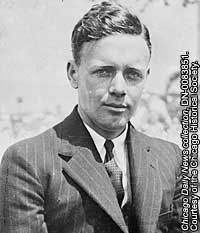
A young Charles Lindbergh was trained in Lincoln and later became the first person to fly solo across the Atlantic ocean.
In 1927, Charles A. Lindbergh, “Lucky Lindy,” flew nonstop from New York to Paris, completing the world’s first solo transatlantic flight. Lindbergh learned to fly at Ray Page’s Flying School in Lincoln, Nebraska. Before his transatlantic flight in “The Spirit of St. Louis,” Lindbergh was a barnstormer, flying from town to town and astounding rural residents with aerial acrobatics, such as loops, rolls, spins, dives, walking on the wings, and parachute jumping. Barnstormers dropped leaflets and buzzed small towns to draw a crowd for the next air show. Many people in Nebraska were impressed by the acrobatics, and some even paid $5 each for a plane ride. Air mail postal service started on the East Coast in 1918 and in 1921 expanded to California. The decade of the 1920s saw increased use of airplanes for mail, passenger, and freight service. Fourteen domestic airlines were founded in 1926.
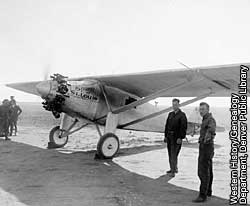
Charles Lindbergh’s airplane, the Spirit of St. Louis.
Start exploring now by clicking on one of these seven sections.
Farm Life / Water / Crops / Making Money / Machines / Pests & Weeds / World Events
Little you care for vows that you made. Little you care how much I have paid. My heart is aching, My heart is breaking, For somebody’s taking my place.
They call… no date. I promised you I’d wait. I want them all to know I’m strictly single, oh.
I’ll walk alone because to tell you the truth I’ll be lonely, I don’t mind being lonely when my heart tells me you are lonely too. I’ll walk alone, they’ll ask me why and I’ll tell them I’d rather. There are dreams I must gather, dreams we fashioned the night you held me tight.
I’ll always be near you wherever you are, each night in every prayer. Just whisper, I’ll hear you, no matter how far. So, close your eyes and I’ll be there. Please walk alone, but send your love and your kisses to guide me. Till you’re walking beside me, I’ll walk alone. Darling, all by myself, I’ll walk alone.
Lyrics by Sammy Cahn, music by Jule Styne. Also featured in the film “Follow The Boys” (1944).
Dinah Shore was born as Fanny Shore in Tennessee and raised in Nashville where she began singing at a nightclub at age 14. When she was attending local Vanderbilt University, she paid for school by singing on radio station WSM. Her program was called “Our Little Cheerleader of Song.” For her theme song, she chose the blues standard “Dinah” popularized by Ethel Waters. After graduation, she moved in New York in 1938 where a flustered radio announcer called her Dinah. The name stuck. She made it big when Eddie Cantor hired her for his radio show. That was followed by a string of hits, her own radio show, movies and, in 1951, the first of a series of television talk shows. She died in 1994.

The captains of aircraft walked out. I noticed that the big Canadian with the slow, easy grin had printed “Berlin” at the top of his pad and then embellished it with a scroll. The red-headed English boy with the two-weeks’-old mustache was the last to leave the room.
Late in the afternoon we went to the locker room to draw parachutes, Mae Wests [lifevests] and all the rest. As we dressed, a couple of Australians were whistling. Walking out to the bus that was to take us to the aircraft, I heard the station loudspeakers announcing that that evening all personnel would be able to see a film: Star-Spangled Rhythm. Free.
We went out and stood around the big, black four-motored Lancaster, “D for Dog.” A small station wagon delivered a thermos bottle of coffee, chewing gum, an orange, and a bit of chocolate for each man. Up in that part of England the air hums and throbs with the sound of aircraft motors all day, but for half an hour before takeoff the skies are dead, silent and expectant. A lone hawk hovered over the airfield, absolutely still as he faced into the wind. Jack, the tail gunner, said, “It’d be nice to fly like that.” D-Dog eased around the perimeter track to the end of the runway. We sat there for a moment. The green light flashed and we were rolling … ten seconds ahead of schedule.
The takeoff was as smooth as silk. The wheels came up, and D-Dog started the long climb. As we came up through the clouds, I looked right and left and counted fourteen black Lancasters climbing for the place where men must burn oxygen to live. The sun was going down and its red glow made rivers and lakes of fire on the top of the clouds. Down to the southward, the clouds piled up to form castles, battlements, and whole cities, all tinged with red.
Soon we were out over the North Sea. Dave, the navigator, asked Jock if he couldn’t make a little more speed. We were nearly two minutes late. By this time, we were all using oxygen. The talk on the intercom was brief and crisp. Everyone sounded relaxed. For a while, the eight of us in our little world of exile moved over the sea. There was a quarter moon on the starboard beam and Jock’s quiet voice came through the intercom, “That’ll be flak ahead.” We were approaching the enemy coast. The flak looked like a cigarette lighter in a dark room: one that won’t light – sparks but no flame – the sparks crackling just above the level of the cloud tops. We flew steady and straight, and soon the flak was directly below us. D-Dog rocked a little from right to left, but that wasn’t caused by the flak. We were in the slipstream of other Lancasters ahead, and we were over the enemy coast. Then a strange thing happened. The aircraft seemed to grow smaller. Jack in the rear turret, Wally the mid-upper gunner, Titch the wireless operator, all seemed somehow to draw closer to Jock in the cockpit. It was as though each man’s shoulder was against the others. The understanding was complete. The intercom came to life, and Jock said, “Two aircraft on the port beam.” Jack in the tail said, “Okay, sir. They’re Lancs.” The whole crew was a unit and wasn’t wasting words.
The cloud below was ten-tenths. The blue-green jet of the exhausts licked back along the wing, and there were other aircraft all around us. The whole great aerial armada was hurtling toward Berlin. We flew so for twenty minutes, when Jock looked up at a vapor trail curling above us, remarking in a conversational tone that, from the look of it, he thought there was a fighter up there. Occasionally the angry red of ack-ack burst through the clouds, but it was far away, and we took only an academic interest. We were flying in the third wave.
Jock asked Wally in the mid-upper turret, and Jack in the rear, if they were cold. They said they were all right and thanked him for asking. He even asked how I was and I said, “All right so far.” The cloud was beginning to thin out. Off to the north we could see lights, and the flak began to liven up ahead of us. Buzz, the bomb-aimer, crackled through on the intercom, “There’s a battle going on over on the starboard beam.” We couldn’t see the aircraft, but we could see the jets of red tracer being exchanged. Suddenly, there was a burst of yellow flame and Jock remarked, “That’s the fighter going down. Note the position.” The whole thing was interesting, but remote. Dave, the navigator, who was sitting back with his maps, charts and compasses, said, “The attack ought to begin in exactly two minutes.” We were still over the clouds.
But suddenly those dirty gray clouds turned white and we were over the outer searchlight defenses. The clouds below us were white, and we were black. D-Dog seemed like a black bug on a white sheet. The flak began coming up, but none of it close. We were still a long way from Berlin. I didn’t realize just how far. Jock observed, “There’s a kite on fire dead ahead.” It was a great, golden, slow-moving meteor slanting toward the earth. By this time we were about thirty miles from our target area in Berlin. That thirty miles was the longest flight I have ever made.
Dead on time, Buzz the bomb-aimer reported, “Target indicators going down.” At the same moment, the sky ahead was lit up by bright yellow flares. Off to starboard another kite went down in flames. The flares were sprouting all over the sky, reds and greens and yellows, and we were flying straight for the center of the fireworks. D-Dog seemed to be standing still, the four propellers thrashing the air, but we didn’t seem to be closing in. The clouds had cleared, and off to the starboard a Lanc was caught by at least fourteen searchlight beams. We could see him twist and turn and finally break out. But still, the whole thing had a quality of unreality about it. No one seemed to be shooting at us, but it was getting lighter all the time. Suddenly, a tremendous big blob of yellow light appeared dead ahead; another to the right and another to the left. We were flying straight for them.
Jock pointed out to me the dummy fires and flares to right and left, but we kept going in. Dead ahead there was a whole chain of red flares looking like stoplights. Another Lanc was coned on our starboard beam. The lights seemed to be supporting it. Again we could see those little bubbles of colored lead driving at it from two sides. The German fighters were at him. And then, with no warning at all, D-Dog was filled with an unhealthy white light.
I was standing just behind Jock and could see all the seams on the wings. His quiet Scots voice beat in my ears, “Steady lads, we’ve been coned.” His slender body lifted half out of the seat as he jammed the control column forward and to the left. We were going down. Jock was wearing woolen gloves with the fingers cut off. I could see his fingernails turn white as he gripped the wheel. And then I was on my knees, flat on the deck, for he had whipped the Dog back into a climbing turn. The knees should have been strong enough to support me, but they weren’t, and the stomach seemed in some danger of letting me down too. I picked myself up and looked out again. It seemed that one big searchlight, instead of being twenty thousand feet below, was mounted right on our wingtip. D-Dog was corkscrewing. As we rolled down on the other side, I began to see what was happening to Berlin.
The clouds were gone, and the sticks of incendiaries from the preceding waves made the place look like a badly laid-out city with the streetlights on. The small incendiaries were going down like a fistful of white rice thrown on a piece of black velvet. As Jock hauled the Dog up again, I was thrown to the other side of the cockpit. And there below were more incendiaries, glowing white and then turning red. The cookies, the four-thousand-pound high explosives, were bursting below like great sunflowers gone mad. And then, as we started down again, still held in the lights, I remembered that the Dog still had one of those cookies and a whole basket of incendiaries in his belly, and the lights still held us, and I was very frightened.
While Jock was flinging us about in the air, he suddenly yelled over the intercom, “Two aircraft on the port beam.” I looked astern and saw Wally, the mid-upper, whip his turret around to port, and then looked up to see a single-engine fighter slide just above us. The other aircraft was one of ours. Finally, we were out of the cone, flying level. I looked down, and the white fires had turned red. They were beginning to merge and spread, just like butter does on a hot plate. Jock and Buzz, the bomb-aimer, began to discuss the target. The smoke was getting thick down below. Buzz said he liked the two green flares on the ground almost dead ahead. He began calling his directions. Just then a new bunch of big flares went down on the far side of the sea of flame that seemed to be directly below us. He thought that would be a better aiming point. Jock agreed and we flew on.
The bomb doors were opened. Buzz called his directions: “Five left, five left.” And then, there was a gentle, confident upward thrust under my feet and Buzz said, “Cookie gone.” A few seconds later, the incendiaries went, and D-Dog seemed lighter and easier to handle.
I thought I could make out the outline of streets below, but the bomb-aimer didn’t agree, and he ought to know. By this time, all those patches of white on black had turned yellow and started to flow together. Another searchlight caught us but didn’t hold us. Then, through the intercom came the word, “One can of incendiaries didn’t clear. We’re still carrying it.” And Jock replied, “Is it a big one or a little one?” The word came back: “Little one I think, but I’m not sure. I’ll check.” Finally, the intercom announced that it was only a small container of incendiaries left, and Jock remarked, “Well, it’s hardly worth going back and doing a run up for that.” If there had been a good fat bundle left, he would have gone back through that stuff and done it all over again. I began to breathe, and to reflect again, that all men would be brave if only they could leave their stomachs at home. Then there was a tremendous whoomph, an unintelligible shout from the tail gunner, and D-Dog shivered and lost altitude. I looked to the port side and there was a Lancaster that seemed close enough to touch. He had whipped straight under us; missed us by twenty-five, fifty feet, no one knew how much.
The navigator sang out the new course and we were heading for home. Jock was doing what I had heard him tell his pilots to do so often – flying dead on course. He flew straight into a huge green searchlight, and as he rammed the throttles home he remarked, “We’ll have a little trouble getting away from this one.” Again D-Dog dove, climbed and twisted, and was finally free. We flew level then. I looked on the port beam at the target area. There was a red, sullen, obscene glare. The fires seemed to have found each other … and we were heading home.
For a little while it was smooth sailing. We saw more battles. Then another plane in flames, but no one could tell whether it was ours or theirs. We were still near the target. Dave, the navigator said, “Hold her steady, skipper. I want to get an astral sight.” Jock held her steady. And the flak began coming up at us. It seemed to be very close. It was winking off both wings, but the Dog was steady. Finally, Dave said, “Okay, skipper. Thank you very much.” A great orange blob of flak smacked up straight in front of us, and Jock said “I think they’re shooting at us.” I’d thought so for some time. He began to throw D for Dog up, around, and about again. When we were clear of the barrage, I asked him how close the bursts were and he said, “Not very close. When they’re really near, you can smell ’em.” That proved nothing for I’d been holding my breath.
Jack sang out from the rear turret that his oxygen was getting low; he thought maybe the lead had frozen. Titch the wireless operator went scrambling back with a new mask and a bottle of oxygen. Dave said, “We’re crossing the coast.” My mind went back to the time I had crossed that coast in 1938, in a plane that had taken off from Prague. Just ahead of me sat two refugees from Vienna – an old man and his wife. The copilot came back and told them that we were outside German territory. The old man reached out and grasped his wife’s hand. The work that was done last night was a massive blow of retribution, for all those who have fled from the sound of shots and blows on a stricken continent.
We began to lose height over the North Sea. We were over England’s shores. The land was dark beneath us. Somewhere down there below, American boys were probably bombing up Fortresses and Liberators, getting ready for the day’s work. We were over the home field. We called the control tower and the calm, clear voice of an English girl replied, “Greetings D-Dog. You are diverted to Mulebag.” We swung round, contacted Mulebag, came in on the flare path, touched down very gently, ran along to the end of the runway and turned left. And Jock, the finest pilot in Bomber Command, said to the control tower, “D-Dog clear of runway.”
When we went in for interrogation, I looked on the board and saw that the big, slow-smiling Canadian and the red-headed English boy with the two-weeks’-old moustache hadn’t made it. They were missing.
There were four reporters on this operation. Two of them didn’t come back. Two friends of mine, Norman Stockton of Australian Associated Newspapers, and Lowell Bennett, an American representing International News Service. There is something of a tradition amongst reporters, that those who are prevented by circumstances from filing their stories will be covered by their colleagues. This has been my effort to do so. In the aircraft in which I flew, the men who flew and fought poured into my ears their comments on fighters, flak, and flares in the same tone that they would have used in reporting a host of daffodils. I have no doubt that Bennett and Stockton would have given you a better report of last night’s activity.
Berlin was a thing of orchestrated Hell – a terrible symphony of light and flames. It isn’t a pleasant kind of warfare – the men doing it speak of it as a job. Yesterday afternoon, when the tapes were stretched out on the big map all the way to Berlin and back again, a young pilot with old eyes said to me, “I see we’re working again tonight.” That’s the frame of mind in which the job is being done. The job isn’t pleasant; it’s terribly tiring. Men die in the sky while others are roasted alive in their cellars. Berlin last night wasn’t a pretty sight. In about 35 minutes it was hit with about three times the amount of stuff that ever came down on London in a night-long blitz. This is a calculated, remorseless campaign of destruction. Right now the mechanics are probably working on D-Dog, getting him ready to fly again.
Source: Library of Congress, Milo Ryan Phonoarchive tapes 774-775
“I left here in York, went to Hebron. That was the induction station. From Hebron I went to Pawnee City and in Pawnee City, that’s where we stayed. I was right there on the fairgrounds. There was barracks and everything made there. And what we done – the farmer, all he done was paid for the fence posts and barbwire. We would put it up for him. And that’s, [we] stayed in that.
“But we didn’t have any money. You got paid $15 for the month. Ten of it went home so the folks could have 10 dollars to spend in cash because Dad was on unemployment. And five dollars was all I got for a month. If you smoked, you had to buy your shaving cream and everything out of that five dollars. Now you take five dollars, you buy yourself shaving cream and smoking and see if you can do that nowadays. But we bought them big sacks of Golden Grain [tobacco], rolled our own cigarettes and used hand soap that was in the latrine and that’s what we shaved with. Cause you didn’t have any money. “Oh, it wasn’t bad. I mean, you got the barracks and it was just like being in the service. The only thing is, in the service you had to be taught you know, how to kill people and carry a gun, take care of your gun. There, you went out on the farms and dug in fence posts and stuff like that. It was hard work. You dig them holes. You set the post. Then run the roll of barbwire, stretch it in there. Sometimes it was woven wire fence to keep the hogs in. No, that’s – it was hard work. But nobody seemed to complain down there, because you had a place to sleep, a place to eat – which was pretty skimpy a lot of times at home. So, no, I never complained about it.”
Alvin and Delbert Apetz are first generation Americans. Their father, Carl, immigrated from Germany in 1909. Alvin is the oldest. Both kids worked on their dad’s farm until he lost it in the 1930s, Alvin worked in the National Youth Administration and Delbert joined the Civilian Conservation Corps. Both brothers were in the military during World War II. Alvin fought in Germany even though he still had relatives over there. Delbert was drafted towards the end of the war. After the war, Alvin worked construction and Delbert worked for the York Dairy and in construction. Delbert died in 2005.
“Most of them went [into the program]. There was just a few that wouldn’t have anything to do with it. But, the majority of people, they all went into the program… There’s a few that said, ‘The government isn’t going to tell me what to do.’ There was a few of them. Now, I don’t think there was too many. They didn’t want the government to tell them what to do. That’s the whole story. You had to abide by their rules. If you had to leave 10 acres out, they came out and measured it, and checked it, and checked you out.”
LeRoy Hankel was raised on a farm and spoke German in the home. He only learned English after he went to school. He started farming for himself in 1937 renting ground for years until he could buy his own land in 1948. That was also the first year they had indoor plumbing. He and his wife Blondina had five children. Later, LeRoy served as an assessor for York county for 13 years. LeRoy passed on in 2005.
“Well, the improvement in the seeds is one [big change in agriculture]. And REA is one. That sure changed the farm life. And the improvement in the seeds. And of course, some of this farm machinery now is just massive. It’s so different than what it used to be. This multi-row – 12-row, 16-row – when I first started working in the shop, they used to list corn one row at a time with a hard ground lister behind three head of horses. One row at a time! And that was just the way a horse would plod. Now, they have these big tractors, what, maybe eight miles an hour, maybe even more.
Yeah, 12-rows, 16 – however many rows they have. That is why the farms have become bigger in acreage, too. They can handle it. But there’s another reason for that. Just in recent weeks, there’s been an article in the State Journal about the trouble that some farmers are getting into. Young farmers, they’ve spent maybe 20 years farming, they’re in their 40s, and they have to give it up. Because when they go to their banker their banker says, ‘Well, you’re not big enough.’ If you’re not farming a thousand acres and see the possibility of farming 12- or 13-hundred acres five years down the road, the banker frowns on that. He wants to see that expansion. He wants to see that increase in size.
“That’s one of the changes that takes place. You know, there was a time when the farmer, when he went to town behind horses with a buggy or wagon, he was almost compelled to go to his nearest small town, his nearest town. Now, he goes out and he sits down in his car. He can go any distance he wants to, in any direction of the compass that he wants to, 20, 30 miles. That’s one of the things that’s contributed to the decline of the small town. They have a wider choice. And the larger businesses are competition that the small town just can’t meet. It’s difficult for them to meet it. Only the exception ever meets it.
“In Gresham, our main street in Gresham was pretty well filled with buildings at that time. And there was a business in each building. And at that time, the people that lived in Gresham, most of the people that lived in Gresham, in the morning they’d get up and go downtown into their business in the main street of Gresham. Now, of course, that Gresham main street has dried up. There isn’t much there anymore. There’s a bank and a post office and a beer tavern and an insurance agency. And that just about winds it up. So, the people that live in Gresham now, they live in Gresham, it’s a bedroom community, but they work elsewhere.”
Walter Schmitt is a first generation American. His father was immigrated from Germany and his mother from Czechoslovakia. He grew up in his father’s blacksmith shop in Gresham, Nebraska. He graduated from high school in 1930 and went to work with his father. After his father died, he kept the shop open until his health failed in the early 1990s. Walter passed on in 2008 and left over $3.5 million to the University of Nebraska-Lincoln for scholarships.
Question: “And what did your husband say?”
Carla Due was born in Denmark. Her parents emigrated to Nebraska when she was about two years old, but they decided the trip would be too dangerous for Carla. She grew up with her grandparents. When she was about 10 or 12 her folks tried twice to get her to come to the U.S. but she resisted. Finally, when she was 16 she crossed the Atlantic alone on a ship. She helped her parents farm, learned English, met her husband Bernard at a dance and then helped him farm.
“Well, I remember when I bought the farm. I bought it from the other banker here in town. And he said, ‘That’s got good water under it. You can irrigate that.’
“And I said, ‘I don’t think I will ever irrigate.’ Well, boy I was sure wrong. We was drilling a well a shortly after that. And it made a big difference. That irrigation changed the whole country.”
Harvey Pickrel was born in 1916 on a farm south of York, Nebraska. Harvey and his brother helped their father on the farm in many ways. They would harness the horses to the plow and, later on, drive the tractor and plow the fields. When he was old enough, Harvey started farming on his own. Harvey has seen a lot of good and bad years out on the farm, and he’s seen a lot of changes in the way farming is done.
“I must have said, ‘Well, if we’re dead, we’re just dead.’ That’s all I can remember because I don’t remember talking to her [the photographer Dorothea Lange]…
“I never once thought about living this long [81 years in 1979]. Well, I just didn’t think we’d survive. You want to know something we’re not living much better than we did, as high as everything is, than we did then…
Nettie Featherston and her family were trying to get to California when they ran out of money in Carey, Texas, in 1937. A local cotton grower took pity on the family and hired them to harvest his cotton. They were living in a small shack near Childress when photographer Dorothea Lange drove up, talked with Nettie and took photos of her. Lange recorded the desperation in her face and in her voice: “If you die, you’re dead – that’s all.” Nettie eventually moved to Lubbock, Texas, and never made it to California although several in her family did.
[Darrel Coble:] “The wind and the dust just blew every day. The one that I remember come in here from the north that evening. Dad was in the field, and I don’t know why as dry as it was. This thing [dust storm] rolled in there, and he got caught on the tractor. And he started for the house, but he couldn’t see the house. But we had an old chickenhouse just out east of the house. And the back wheel just clipped the corner of that chickenhouse, and he knew where he was at then. And he just stopped there and got in the chickenhouse and spent the night in the chickenhouse. [Laughter.] Of course, we had kerosene lamps and everything. It got so dark you couldn’t even see without – Kerosene lamps didn’t make no light so you could see by…
“Ah, it kind of scared me, best I can recall [laughs]. I thought maybe the world was coming to an end, I didn’t know [laughs]…
“Last spring we had some pretty bad days. They weren’t the old black dusters, but I mean, there was plenty of dust in the air…
[Question:] “Do you like living in this country?” “You bet.”
[Question:] “How come?”
“It’s just home. Dad always says, ‘Anybody ever come out here and wear out two pairs of shoes here, they’d never leave.’ I’ve known some that did do it in later years.”
[Question:] “Tell me about what was it like in Colorado?”
[Lois Houle:] “It was terrible. [Laughs.] We had dust storms and droughts. We survived back there as long as we possibly could. I can remember one dust storm back there. We were coming from my grandparents’ in Straton. And as we got closer to home, you could see this big gray matter up in the air. And the minute we got home, we had a storm cellar built with things to eat and everything else in it. We were all taken to the storm cellar right away, and they went in and closed the house all up good. And we stayed down there until the storm was over. It just came to the point where we couldn’t live any more back there. And we had relatives out here already.”
[Question:] “Did they write back or anything?”
“Oh, yes! Oh, yeah! Everything was ‘beautiful’ out here. [Laughs.] This was the land of milk and honey out here.” [Woody Guthrie’s “Dust Bowl Refugee”]
Darrell Coble was a three-year-old kid “Fleeing a Dust Storm” in the famous photograph by Arthur Rothstein. The photo was taken in Cimarron County, Oklahoma, in April 1936 and came to symbolize the impact that dust could have. Darrell lived in the same county for all of his life. In 1977, he farmed 190 acres but still needed to work as a propane truck driver to make ends meet. He died in 1979. Lois (Adolf) Houle was photographed by Dorothea Lange in Wapato, Wasington, in August 1929. Her family left the high plains of Colorado after several years of drought and dust storms.
“Earnie Rupp was a John Deere dealer in Gresham, and he talked me into getting the FSA [Farm Security Administration] loan. Well, they didn’t make the payments on the tractor, but they bought me the livestock. So, that’s what we lived on. We milked cows, and some chickens, eggs, you know. We’d go to town with a can of cream and several dozen eggs. That’s what bought out groceries. For my wife and I, if you bought $5 worth of groceries, that would last you a week. ‘Course, we had our meat and stuff.
“When I got that FSA loan, it was for a $1,020, and I looked at the check and thought, ‘Oh, my God, I’ll never on God’s earth pay that off, you know.’ And now, what’s $1,000 now? Well, it really tied you down. But, yeah, they gave us some money to buy hogs. And I bought a team of horses, and I bought some milk cows so I could make a living anyway.”
Question: “Did they work with you? I mean did they – I know that part of what they were trying to do was to teach people how to do bookkeeping and all that kind of stuff.”
“Well, yeah. And they kind of taught us to do that. You had to keep a good book. Yeah.”
lroy Hoffman grew up on a farm near York. He went to a rural school and started high school in York. But he came down with scarlet fever and had to be quarantined. Shortly after, his father also came up ill and Elroy had to leave school to work on the home place and as a hired man on other farms. For a time, he worked for the brothers of David Wessels. He and his wife Florence had two children. Elroy died in 2005.
“Now, that’s where you got started at when they run the renters off. We was helping them. I was working for a renter. Now the fellow I worked for, Frank Heine, is dead. He knows about him. He had half of that country out there. He’d have, oh maybe on a half section of land, there’d be two or three houses, you know, of me and him and you. Families living in them making a decent living working for him. Well, he seen he could buy tractors up, and [he said] ‘You get off! I don’t need you no more. I don’t need you no more.’
“The fellow I worked for, he bought four new tractors at one time and three combines, see. Case tractors and combines. Well, you take a four-up team of mules – well, one tractor can do as much in a day as one team could do in a week and not be as expensive. Gas then, you know – You may not believe it, but he knows, we bought gas right here in Goodlett for nine- and ten-cents a gallon. They seen they could make so much more money by farming all of their land and running the little farmer off.”
Walter Ballard was one of six displaced farm workers photographed by Dorothea Lange in 1937 in Hardeman County, Texas. Walter couldn’t find a job and began riding the rails across the Great Plains to find any job he could. Later, he began working for the WPA. He called it “the hardest and the heaviest work I ever done.” But, he’s proud that many of the buildings, parks and roads the WPA built are still around.
“Oh, yes. There were some of the young fellows in the neighborhood. They sure did [join the CCC enthusiastically]. What were they going to do? They couldn’t get a job. They couldn’t make a penny anywhere. They were just glad there was such a thing they could go into… They didn’t take the money and go and have fun with it. They got $5.00 and the rest went to their families, their parents or whatever, who were needing it. And it was sure the rescue of a lot of families.”
Abandoned Farmhouse
He was a big man, says the size of his shoes on a pile of broken dishes by the house; a tall man too, says the length of the bed in an ustairs room; and a good, God-fearing man, says the Bible with a broken back on the floor below the window, dusty with sun; but not a man for farming, say the fields cluttered with boulders and the leaky barn.
A woman lived with him, says the bedroom wall papered with lilacs and the kitchen shelves covered with oilcloth, and they had a child, says the sandbox made from a tractor tire. Money was scarce, say the jars of plum preserves and canned tomatoes sealed in the cellar hole. And the winters cold, say the rags in the window frames. It was lonely here, says the narrow country road.
Ted Kooser is the first U.S. Poet Laureate choosen from the Great Plains and “a major poetic voice for rural and small town America,” according to James Billington, Librarian of Congress. Kooser was appointed laureate in 2004 after a 30-year career as a poet. In 2004, his book Delights and Shadows was awarded the Pulitizer Prize for Poetry. Ted lives on a farmstead outside rural Garland, Nebraska, and teaches at the University of Nebraska-Lincoln where he is the recipient of the first U of N Presidential Professorship.
“When you see a full town turn out as that train pulls into the siding up here at Fairmont – not just the Fairmont people, but I don’t think but that maybe the cop was the only one [left] in Geneva. And I don’t think that there was maybe half a dozen people in York that weren’t at that siding on both sides of the train. And that train crept into that siding and stopped up there. And here they stand with coffee, with flags, welcome signs, you name it. They were there, from the little kids up to the good looking gal’s, mom and dad, grandma and grandpa, wagons sitting across the streets with the cars. They came from I don’t know where, but a reception committee like that is hard to forget…
“Welcoming us to the base. And they wouldn’t let go of us. As a result, a lot of us call this place home. This is our home. I live over south of Omaha, Nebraska [135 miles away]. Little town called Plattsmouth, Nebraska. I come down here at least twice, maybe three times a month. I can’t let go of this place. They say you can take the farm out of the kid but you can’t take the kid out of the farm, you’re looking at him. This is home. “
Sedgefield Hill grew up in an urban environment of St. Paul, Minnesota. When he joined the Army Air Corps in World War II, he and many others were sent to bases in rural areas. Sedgefield found a friendly environment in the towns and country surrounding the Fairmont Nebraska Airbase. He served in the 451st Bomb Group as a mechanic. The group flew hundreds of missions from bases in Italy. After the war, Sedgefield moved to Plattsmouth, Nebraska, just south of Omaha. He still returns to the Fairmont area often. “This is home,” he says.

The North Platte Canteen became the subject of a book by bestselling author and award-winning journalist Bob Greene: Once Upon a Town: the Miracle of the North Platte Canteen. Greene interviewed people who volunteered at the Canteen and some of the veterans who were among the six million soldiers who stopped in North Platte on their way to duty stations across the country.
Greene tells the stories of Nebraskans who sacrificed their own food rations and gasoline supplies so they could feed the soldiers. Day after day, volunteers prepared fried chicken, sandwiches, cookies and cakes. They loaded their cars with farm-fresh eggs, cheese and milk and drove miles on muddy roads to work in the North Platte Canteen.
One woman Greene interviewed said working at the Canteen made you “feel like you had done something worthwhile, for the glory of God and the glory of your nation. You would pray that those boys you had just seen would come back home. They were not much older than we were.” Greene says some volunteers had sons in the military, and one woman was working in the Canteen when she received word that her son had been killed in action.
With tears in their eyes, the soldiers told Greene they may have only stopped in North Platte for 10 minutes, but they never forgot it. The smiles, food, and friendliness overwhelmed the homesick soldiers. One veteran told Greene, “The biggest thing was how those people made you feel really appreciated.” One veteran recalls that men on the battlefields who had been through North Platte would often talk about it. “They would talk about it like it was a dream. Out of nowhere: ‘How’d you like to have some of that food from the North Platte Canteen right about now.'”
In 1973, the Union Pacific tore down the depot soon after the passenger trains were replaced by freight trains.
Although the troop trains are gone, North Platte today is home to the largest railroad classification yard in the world. Workers in the repair facility fix an average of 50 locomotives every day, and 18-20 cars per hour, with shifts running 24 hours per day. The shop replaces 10,000 pairs of wheels every year. Every 24 hours, Bailey Yard handles 10,000 railroad cars, each day sorting 3,000 cars into eastbound and westbound yards. The yard covers 2,80 acres and has 315 miles of track. The command center at Bailey Yard is linked to the Harriman Dispatching Center at Union Pacific headquarters in Omaha, Nebraska. Union Pacific Railroad serves 23 states. The main line in Nebraska is the busiest corridor in the country, with 135 trains operating on this line every 24 hours. Union Pacific ships grain, coal, food products, wood, metals, chemicals, minerals, and cars.
For the past 110 years, weather observers have kept track of the climate at thousands of places across the United States and the world. They’ve recorded temperature, rainfall, winds and other weather patterns day in and day out. From those data, they have described what is “normal” for a given place at a given time of the year. They have also been able to recognize cycles of drought throughout the recorded history.
Every decade or two over the historic record, a given region experienced dry conditions with devastating consequences for agriculture. But there are problems to overcome in this emerging science.
First, how do you actually define a “drought?” The Central Plains states like Nebraska can expect to receive somewhere around 20-inches of rain during a normal year. Alabama can expect to get over 55-inches, and their agriculture and social institutions are geared to that level of rainfall. If Alabama got only 20-inches of rain in a year, it would be a catastrophic drought for them, whereas it would be a normal year in Nebraska.
One of the other problems is that the historic record of climate change only goes back 110 years or so. So scientists have begun studying secondary indicators of climate change – the width of tree rings, lake and sand dune sediments, archaeological remains and other environmental indicators.
These studies are suggesting some interesting possibilities. For instance, drought studies may suggest why the “Lost Colony” on Roanoke Island was lost. The first English colony in North America was established on Roanoke Island in 1585. But the settlers returned to England a year later. A second group landed on Roanoke in 1587, intending to establish a permanent colony. They mysteriously disappeared by the time a supply ship reached the island in 1591.
New tree ring studies from the region have charted cycles of drought back to A.D. 1185. These studies suggest that the most severe three year period of drought in 800 years happened just as the Lost Colony was trying to get established.
Other studies have suggested that the historic droughts of the 1930s and 1950s may not have been as long or bad as droughts in prehistoric times. The 1930s drought was longer and more extensive than any drought in the last 300 years, but around A.D. 200 some parts of North America experienced drought conditions for several decades.
Paleoclimatic data have also suggested that even longer cycles can change regions from deserts to plains to forests and back over the course of centuries. These 200- and 700-year long cycles go back to the Little Ice Age and may be effected by solar activity or conditions in the ocean and atmosphere.
What all this means for farmers is that they can expect to endure times of drought, but they will have a hard time predicting exactly when or where drought might hit.
Written by Bill Ganzel of the Ganzel Group. First written and published in 2003.
“We all got in an old Model-T and started for Oregon. We started out, and, I don’t know, we got out six miles and broke the crankshaft. This old rancher, he had some old Model-T motors laying around. He said we was welcome to a crankshaft if we wanted one. So, we went back and proceeded to tear the motor out of the old Model-T and put the crankshaft in. And that night we made Baker [laughs] which is a matter of 24 miles from the night before.
“Well, then we had pretty good luck all the rest of the way. But we got around Missoula, [Montana] and we was having a good time. See somebody along the road or something. And here was this car sitting alongside the road, and a guy sleeping in it. So, we honked and hollared at him, having a good time. Pretty soon, this car was after us. We’d heard they was sending them back [police sending migrants back at state borders], wasn’t letting ’em go on through. So, we thought, ‘Well, here’s where we go back home.’ He motioned for us to pull over to the side of the road. Anyhow, he come up and introduced himself [as Arthur Rothstein] and said he was with the Resettlement Administration [the precursor of the FSA] and asked us questions about the conditons here and one thing or another. Where we was headed for. This ‘Oregon or Bust’ on the back end was what took his eye. Then, he asked us if we cared if he took some pictures of us. Oh, we said, ‘I guess not.’ I think he took eight different poses. And then after we was out there [in Oregon] I guess probably it was that fall or winter, why these pictures started showing up in the different magazines and papers. Anyhow, we got out there and I went to work on the railroad.
“In the winter of ’45, my father passed away. And then I quit working on the railroad to get ready to come come back here. And been here ever since. [Laughs.] Oh, we’ve had our ups and downs. I think I’ve been hailed out probably five, six times, and dried out three, four years. And one year we rusted out [from a plant disease called ‘rust’].” Vernon Evans was a young man working as a hired hand around Lemmon, South Dakota, when the Depression hit. He was let go and couldn’t find other work. So, Vern, his wife Flora, her sister, her brother and another friend left for Oregon where other friends were already living. Vern was lucky to find a job with the railroad the first day they were in Oregon. Vern and Flora lived in Oregon for nine years until his dad died. The returned to the farm in South Dakota and stayed. But the other people on the trip stayed in Oregon and only returned for visits. × Academic Standards forWe Read More Than Words National Art Standards
Eighth Grade Content Standard #5: Reflecting upon and assessing the characteristics and merits of their work and the work of others. Achievement Standard:
- Students compare multiple purposes for creating works of art.
- Students analyze contemporary and historic meanings in specific artworks through cultural and aesthetic inquiry.
- Students describe and compare a variety of individual responses to their own artworks and to artworks from various eras and cultures.
Robert Daugherty was born in Omaha and a self-described “city kid,” but he knew something about agriculture. His father, Robert Daugherty Sr., owned one of the larger livestock commission firms at the Omaha Stock Yards and Robert worked in the yards as a kid. During World War II he served in the Marines in the Pacific. After the war, he started Valley Manufacturing with an farmer-inventor in Valley, Nebraska. In 1952, he met Frank Zybach and bought rights to his center pivot irrigation system patents. The company was renamed Valmont Industries and is now a worldwide, diversified metal manufacturer and the largest builder of center pivot irrigation systems. Daugherty died in 2010.

- ALL OVER THE MAP
Vintage Maps Rekindle the Romance of Early Air Travel
Before pat downs and checked baggage fees, commercial flight carried an air of mystery and adventure.
In the early days of the 20th century, an exciting new mode of travel became possible. Anyone with enough money could take to the skies on a commercial flight. Trips that would take weeks by sea could be made in days by plane. A Londoner could hop over to Paris for the weekend.
As commercial flying grew, maps became a vital advertising tool, tantalizing the public with exotic destinations newly within reach.
Now a new book , Mapping the Airways, conjures the romance of those early days with a collection of maps from the British Airways Heritage Collection, the airline’s archive of records and artifacts.
“Aviation was a revolutionary way to travel,” says author Paul Jarvis, the collection’s curator. “There was an air of mystery and adventure about it.”

Early airline ads, like this one from around 1937, emphasized luxury and comfort and drew parallels to the more familiar passenger compartments of ships.
After World War I ended in 1918, lots of pilots suddenly found themselves with extra time on their hands, Jarvis says. Some of them decided to make themselves available for hire, and a number of small private airlines sprang up, using former military aircraft as their fleet. In 1924, the British government bought the best four of these small private aviation companies and merged them to create Imperial Airways, the first of several precursors to today’s British Airways.
At first, not everyone could book a ticket. “Flying was only for the wealthy, or for government servants, the military, and businessmen,” Jarvis says. The class of people who flew were used to luxury railcars, and they expected similar amenities when they flew. Plane interiors might use mahogany veneers to mimic the solid mahogany furnishings of a Pullman railcar, for example.
People dressed for the occasion too. “Men would wear a suit, collared shirt, and tie,” Jarvis says.
Longer journeys became possible in the 1920s and 30s. The travel times seem ridiculously slow today, but they would have been mind-blowingly fast at the time. One 1935 Imperial Airways timetable lists nine stops between Brussels and the Congo, with some legs traveled by train. The entire trip is advertised as taking four and a half days, but Jarvis thinks it must have taken at least five. “The airfare would include all hotels, all transfers, all food,” he says.

This 1938 poster by artist James Gardner incorporates a stylized route map, likely inspired by Harry Beck’s famous 1933 map of the London Underground .
Traveling by air was more perilous back then. One map in the book (included in the gallery of images above) depicts hills and other landmarks a pilot could use to identify his position if the plane went down in the desert between Cairo and Baghdad. The map also notes the poor condition of some roads. “Very bad going over boulders,” it says in one place, an indication that help would be slow to arrive. (See “ How to Read a Pilot’s Map of the Sky ”)
During World War II commercial flights were grounded across Europe. In Britain, the airlines were taken over by the military during the war. One use for the commercial aircraft was flying American and Canadian pilots back home after they’d flown military planes over from North America to aid the Allies in Europe, Jarvis says. (See “ Bomb-Damage Maps Reveal London’s World War II Devastation ”)
The Cold War, too, had an impact. Through the 1970s, the Soviets tightly controlled air traffic in and out of Berlin’s three airports. A map from this era (also in the gallery above) uses narrow strips to illustrate the permitted flight paths. Everything else is blocked out.
The bulk of the maps Jarvis has selected for Mapping the Airways come from the first half of the 20th century, and they capture the aesthetics of their era. Many were made by prominent artists and designers, including László Moholy-Nagy , a leading figure in the Bauhaus art and design school in Germany in the 1920s and early 30s.
Jarvis includes a few modern airline maps in his book, the kind you’d find in the seatback pocket or on a screen that tracks your flight’s progress in real time. They’re just not as evocative as the older maps. Even if you’re too young to have lived it, it’s easy to feel nostalgic for the days before excruciating security lines and embarrassing pat downs, when people put on nice clothes and took five-day flights to the Congo.
FREE BONUS ISSUE
Related topics.
- PEOPLE AND CULTURE
You May Also Like

What do long flights do to our bodies?

What is the jet stream—and how does it influence the weather?

Ground-level ozone is getting worse. Here's what it means for your health.

‘Society of the Snow’ is based on a true story. Here’s what really happened.

Cooking oil just fueled a transatlantic flight. But is it a solution or a distraction?
- Perpetual Planet
- Environment
- History & Culture
- Paid Content
History & Culture
- Mind, Body, Wonder
- Terms of Use
- Privacy Policy
- Your US State Privacy Rights
- Children's Online Privacy Policy
- Interest-Based Ads
- About Nielsen Measurement
- Do Not Sell or Share My Personal Information
- Nat Geo Home
- Attend a Live Event
- Book a Trip
- Inspire Your Kids
- Shop Nat Geo
- Visit the D.C. Museum
- Learn About Our Impact
- Support Our Mission
- Advertise With Us
- Customer Service
- Renew Subscription
- Manage Your Subscription
- Work at Nat Geo
- Sign Up for Our Newsletters
- Contribute to Protect the Planet
Copyright © 1996-2015 National Geographic Society Copyright © 2015-2024 National Geographic Partners, LLC. All rights reserved
The Zeppelin Hindenburg: When Airships Ruled | The Most Amazing Flying Machines Ever
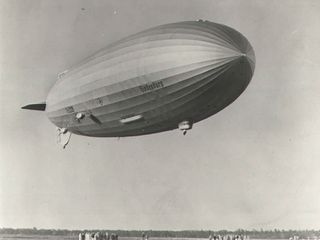
This is part of a SPACE.com series of articles on the Most Amazing Flying Machines Ever, the balloons, airplanes, rockets and more that got humans off the ground and into space.
Huge airships once embodied the future of air travel as they carried passengers across the world's oceans. That dream exploded when the zeppelin Hindenburg, the largest aircraft to ever fly, burst into flames during an attempted landing in New Jersey and collapsed into a smoldering ruin within just half a minute.
The cigar-shaped Hindenburg stretched the length of three football fields at almost 804 feet — more than three times longer than a Boeing 747 jumbo jet. That made it perhaps the most impressive of the rigid airships that used propellers for steering and filled up buoyant cells with hydrogen or helium gas to float through the sky. Such rigid airships stand in contrast to the inflatable designs of hot air balloons and blimps.
Zeppelins made by the German company Luftschiffbau Zeppelin carried out the first strategic bombing missions during World War I. The United States also experimented with turning rigid airships such as the USS Macon and USS Akron into flying aircraft carriers during the 1930s.
Flying across oceans
After World War I, airships began providing the first commercial transatlantic flights during the 1920s and 1930s. Passengers flocked to the zeppelin service as a quicker and cheaper way to cross the world's oceans compared to buying passage on ships. Even New York's Empire State Building had plans to allow dirigibles to dock with its spire (a plan scuttled by gusty winds).
A sister ship of the Hindenburg, the Graf Zeppelin, set the record for flying more miles than any airship. Its 590 flights covered more than one million miles (1,609,344 kilometers) included 144 ocean crossings during 10 years of service. It also flew around the world in just 12 days in 1929.
The Hindenburg made just 63 flights after its construction in 1936. But it could carry more than 70 passengers in style with its own dining room, a writing room, a lounge with a grand piano, and plenty of windows on the sides for viewing the scenery below.
Passengers even enjoyed having their own post office aboard the Hindenburg — the airship represented the largest flying post office ever, according to the U.S. National Postal Museum . The Hindenburg also provided the first regularly scheduled air post service between Europe and North America.
A fiery end
The Hindenburg's end came when it prepared to land at Lakehurst, New Jersey, on May 6, 1937. Flames erupted as the airship settled in near its mooring mast, and the huge airship was consumed within just 32 seconds. Luckily, 62 of the passengers and crew survived by jumping out the windows to the ground — the death toll came to 35 people on board and one member of the ground crew.
Historians still debate what brought about the downfall of the Hindenburg and the end to people's confidence in hydrogen-filled airships. Many have pointed to the flammable hydrogen gas as the reason why the airship went up in flames so quickly. A competing theory that implicated incendiary paint on the outside of the airship was largely discredited by a 2005 paper.
Whatever the case, the golden age of airships was over. Fixed-wing aircraft continued their rise as they dominated the skies for both war and commercial flights.
But lighter-than-air blimps or hybrid airships could still end up flying into the future. The U.S. military has experimented with using both blimps and airships as high-flying surveillance platforms over battlefields, and planetary scientists envision robot blimps soaring on Mars or other worlds someday.
The Greatest Moments in Flight
- The First Hot-Air Balloon
- The First Powered Airship
- The Wright Brothers & the First Flight
- World's First Commercial Airline
- Charles Lindbergh & the First Solo Transatlantic Flight
- Breaking the Sound Barrier
The Most Amazing Flying Machines Ever
- The First Airplane: Wright Flyer
- The Red Baron & Aerial Weapons of World War I
- The First Fighter Jet: Me 262 Schwalbe
- SR-71 Blackbird: Supersonic Spy Aircraft
- Saturn V Rocket & Apollo Spacecraft
Image galleries:
- Airplanes of Tomorrow, NASA's Vision of Future Air Travel
- Amazing X-Planes from the X-1 to XV-15
Join our Space Forums to keep talking space on the latest missions, night sky and more! And if you have a news tip, correction or comment, let us know at: [email protected].
Get the Space.com Newsletter
Breaking space news, the latest updates on rocket launches, skywatching events and more!
Jeremy Hsu is science writer based in New York City whose work has appeared in Scientific American, Discovery Magazine, Backchannel, Wired.com and IEEE Spectrum, among others. He joined the Space.com and Live Science teams in 2010 as a Senior Writer and is currently the Editor-in-Chief of Indicate Media. Jeremy studied history and sociology of science at the University of Pennsylvania, and earned a master's degree in journalism from the NYU Science, Health and Environmental Reporting Program. You can find Jeremy's latest project on Twitter .
Switzerland signs Artemis Accords to join NASA in moon exploration
NASA astronaut Loral O'Hara missed the total solar eclipse, but saw Earth 'moving' below her during spacewalk (photos)
What's left of the 2024 solar eclipse lives in our hearts
Most Popular
- 2 Uranus and Neptune aren't made of what we thought, new study hints
- 3 Exotic 'Einstein ring' suggests that mysterious dark matter interacts with itself
- 4 Boeing Starliner spacecraft rolls out to Atlas V rocket ahead of 1st astronaut launch (photos)
- 5 'Star Trek: Lower Decks' Season 4 blasts onto Blu-ray and DVD on April 16
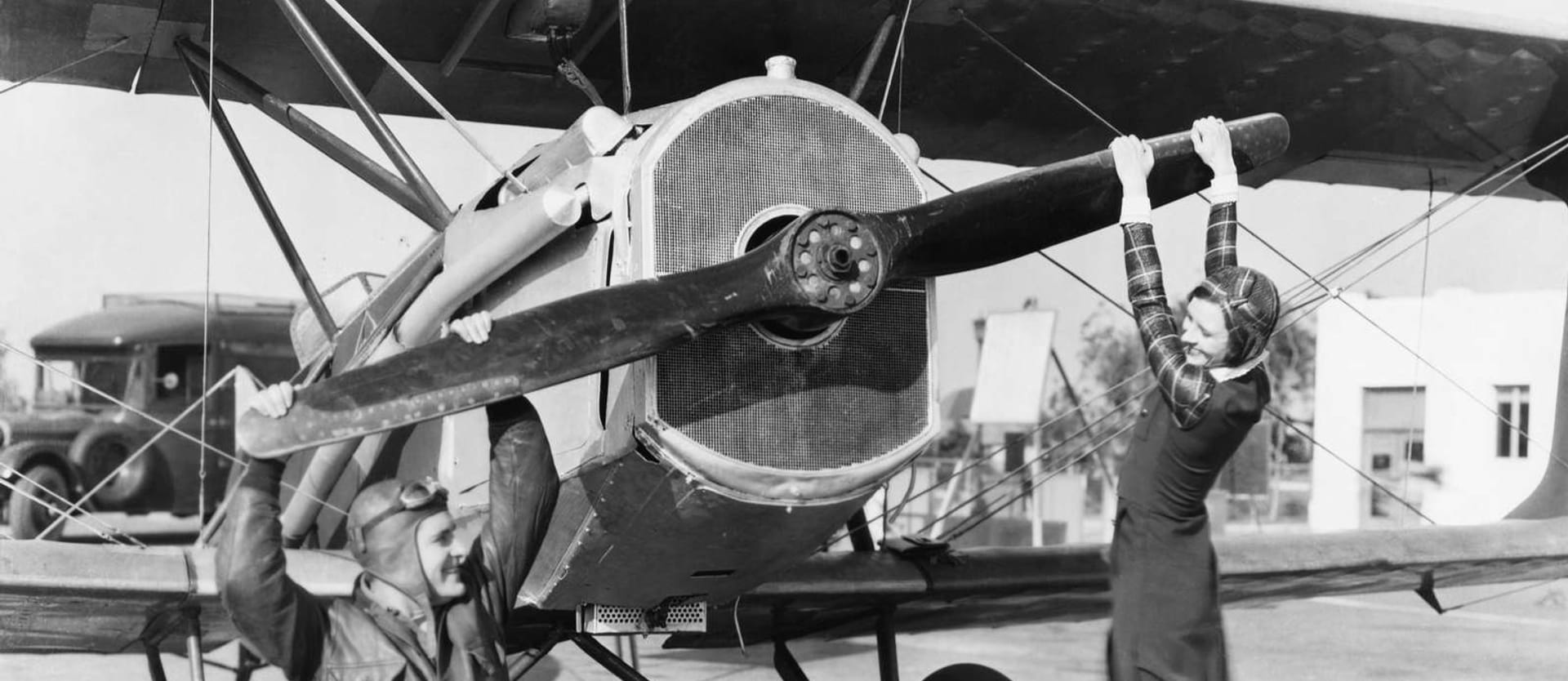
A Brief History Lesson on Travel: Why, How, and Where We Traveled in the 1920s
- 19 Dec, 2019
- 1 Comment Share
This city park in Berlin is one of the most fascinating examples of gentrification. “A crown jewel of open space,” Tempelhoft, a favorite of citizens and tourists alike, was at one time one of the main pre-WW2 airports. The home of Lufthansa, it was constructed back in 1923 and continued operating until 2008. After its closing, Berliners fought hard to keep it as a public space and now, this unique structure houses communal gardens and hosts festivals.
This is the place we would show time travelers to illustrate how the world and our values have changed in 100 years. And how flying became so routine that we often choose to stay grounded.
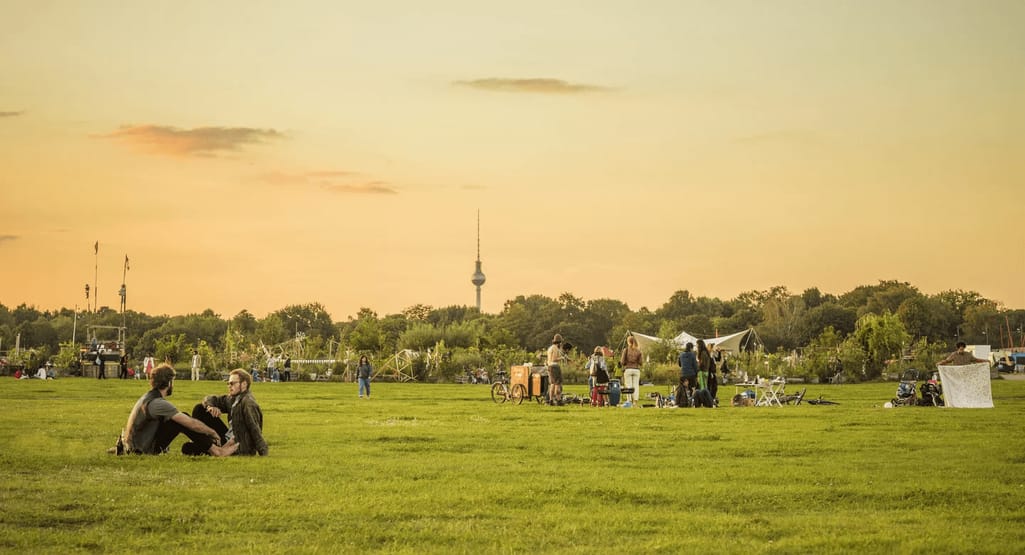
Tempelhof’s 386-hectares have enough space for joggers, cyclists, picnic goers, and dog walkers Source: visitBerlin.de
Initially, an area called Tempelhof Feld (field in German) quickly grew from a small aerodrome with a hangar to the world’s first airport with an underground railway and a terminal with a contemporary look. Although in the 1920s, air passenger travel was more of an indulgence than a necessity, the construction of an airfield was important for the future growth of the route network.
One hundred years ago, stuck between two wars and on the verge of the Great Depression, the world was optimistic, open to experiments, and hungry for freedom. And the Roaring Twenties delivered. Usually in our special Christmas commentary, we've explored the technology of today and the future . Now, with a new decade approaching, we look into the past. What was it like to experience traveling in the twenties of the 1900s? To board clunky planes, go on the first road trip, or even travel abroad and relax on a cruise ship? Let’s find out.
Vacation is the new normal
To the generation surviving World War I, life in the twenties was entirely new. Aggressive economic growth meant that luxury items were now mass-produced, and a typical middle-class family could afford the most revolutionary product - a car. Henry Ford implemented the 40-hour workweek, which improved the quality of life for a regular factory worker who now had weekends off and could join the consumerist middle class.
While most couldn’t afford a car for a one-time payment, they opted for credit.

General Motors practically invented car credit by offering prestige cars for manageable prices
By the end of the twenties, credit was used to purchase 90 percent of goods. Since splurging was more available and the work schedule became standardized, people were more inclined to take their families on vacation.
The most popular outbound destinations for Americans were the Caribbean, particularly Nassau, Jamaica, or Mexico. At one point, spending time on the beach was so widespread that the suntan went into fashion - a striking contrast to the centuries-old preference for fair skin.
While a car was becoming a common household posession, the most popular modes of transportation for the longest time remained trains and ocean liners.
Railroad - the symbol of the decade
Puffing locomotives, the distinctive sound of train horns, and engineers in overalls tending a firebox are some of the most distinctive images from the golden age of railroading. In the 1920s, trains had already existed for 100 years - about the same time we’ve lived with commercial aviation.
Because of World War II, railroads were nationalized, and the newly created US Railroad Administration invested in new equipment and established numerous changes and standards. A new design for a steam locomotive, an improved signal system, and stronger and quieter cars, made partially from steel (instead of wood), were some of the biggest implementations of the era.
Both in big cities and small towns, railway stations were focal points of community life. They were often the largest and most opulently decorated buildings in the area. Platforms filled with mingling crowds of people from all walks of life had an equalizing effect, while the trains themselves were less egalitaran. Ordinary people traveled on trains seated on simple wooden benches (or two-tier unfolding seats in sleeping cars). In the South until the end of Jim Crow laws, transportation was segregated, while white and black people traveled together in other parts of the country. Well-heeled travelers could afford cushioned cabins, usually designed by professional carpenters.

First-class train cabin with the view on the New Zealand planes
The pinnacle of long-distance travel were the sleeping, dining, and private cars first introduced by George M. Pullman in 1865. He was often invited by carriers to create luxurious cars - elaborately and excessively decorated, with plush seats and expensive chandeliers tinkling in response to the movement. The wealthy enjoyed Pullman cars well into the 20th century. Today, you can find a few Airbnb listings and book your stay in a restored car, now enabled with air conditioning and Wi-Fi.
An interesting detail present in most trains of that era were observation cars - last carriages of the train with a convenient platform for passengers to sightsee.
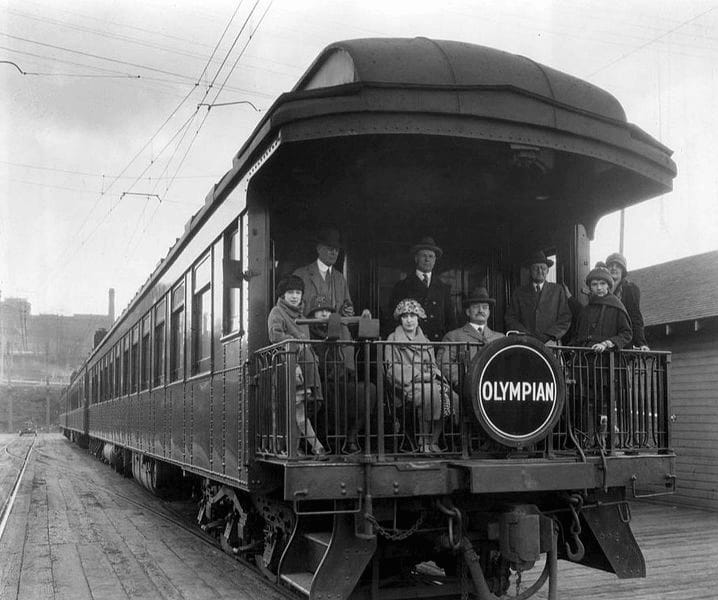
Passengers ready to enjoy the breeze, circa 1927
Prolonging the vacation on a cruise
After the RMS Titanic tragedy of 1912, the maritime standards of safety have been majorly revised and regular lifeboat inspections were introduced. These and many other changes have persuaded the public that sea travel was once again safe. By 1920s, ships and ocean liners became the trendiest mode of transportation. Because of that, the Suez Canal had to be widened to accommodate the increased traffic.

Red Star Line advertisement, 1924 Source: RetroReveries
Transatlantic journeys were advertised as a part of the vacation, offering the wealthiest all types of entertainment from swimming pools to movie theaters. To make room for more people (and sell more tickets), ship decks were divided into different classes, so traveling to and from America got more affordable. Some carriers even introduced the fourth class, promising first-class comfort for a second-class price.

Advertisement depicting newly built spaces for the tourist class including a separate dining room and entertainment options
The prohibition law in the US enabled alcohol-seeking Americans to choose other international carriers, which inherently crippled the US passenger trade. Although the liner companies tried hard to entertain people, spending several days on a ship was still considered boring.
“Auto tourists” and camping
The twenties marked the beginning of the automobile era with the record-breaking Ford Model T selling massively across the country. This was the car that changed the living and traveling of most Americans as it was comparatively cheap and easy to drive. The Tin Lizzie not only provided a bit of privacy (most cars before were open-roofed) but also became a symbol of freedom - now young people could go anywhere anytime, of course, if muddy, country roads allowed.

Camping in Yellowstone Source: Library of Congress
People were traveling to special events like auto races or carnivals, or simply to the beach. Popular attractions included Luna Parks (amusement parks were a trend of the twenties) in Denver and Coney Island, national parks like Yellowstone and Grand Canyon, the Hollywood Sign (erected in 1923) and the Museum of Modern Art in New York.
As more people took to the road in search of adventure, gas stations, cheap motor hotels (motels), convenience stores, and drive-in restaurants started popping up on the roadsides, shaping the modern American landscape.
The first travel trailers wouldn’t appear until the 30s, but road trippers often stayed at primitive campgrounds, where they put up their own tents. People whose property reached the largest highways would build tourist homes - usually one-story buildings with the most basic services to accommodate people for not more than one night.
The world's first motel opened in 1925 between San Francisco and Los Angeles. It was called Milestone Mo-Tel, charged $1.25 per night, and offered a private bathroom or even a garage in some cases. This was obviously an unseen level of comfort on the road. Before the chain grew across the country, the idea (and the naming) got picked up by lots of entrepreneurs, slowly turning the unique hospitality business into the current bonanza of cookie-cutter rooms.
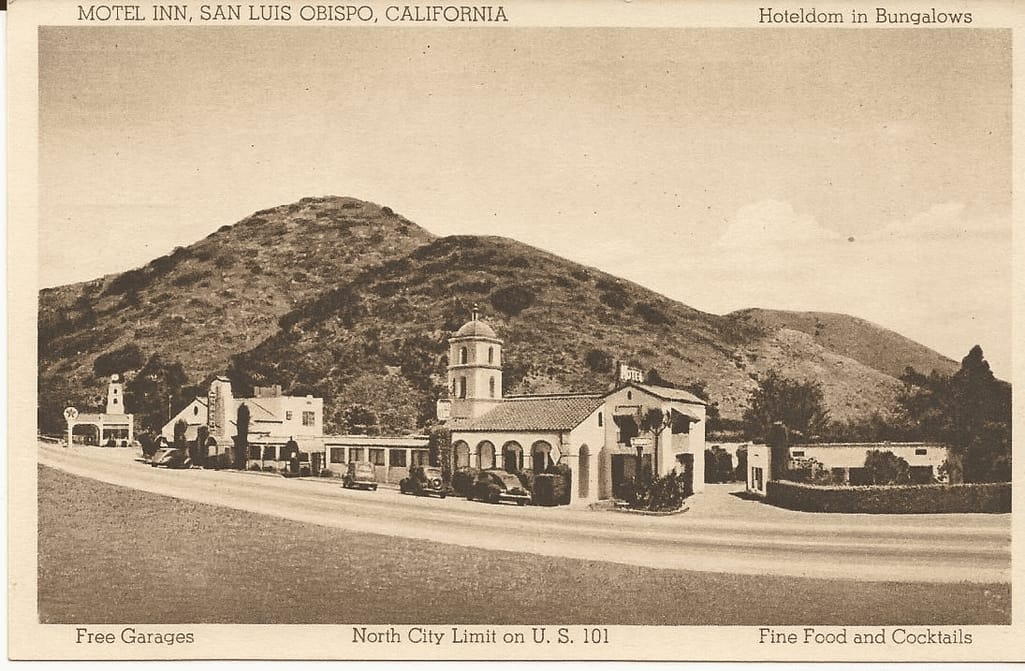
This photo taken between the 1920s and 1930s reveals that Milestone Mo-Tel was almost a luxury location compared to its predecessors
The rare luxury of flying
Although the twenties are considered the beginning of commercial aviation, it was very much on an infancy. The first flight by KLM, the oldest operating airline, took place in 1920. It carried two British journalists from London to Amsterdam. Scheduled flights started running in 1921.

Here pictured Lady Hearth - the first female passenger on a commercial airline
A typical 1920s flying experience was luxurious in a very strange sense. It was expensive - the journey from West Coast to East Coast was about $360 (about $5000 if adjusted for inflation). The legroom was non-existent, the ride was bumpy, and it was cold since most airplane windows were simply holes in the fuselage. It took longer too and in most cases, you couldn’t travel at night. Somewhere in the middle of the flight, you would consider opting for a boat or a train next time.
As for the entertainment, passengers enjoyed food and drinks or watched a movie in an impromptu cinema (on a much rarer occasion). One of the first films shown in the air was The Lost World in 1925 by Imperial Airlines. The video below shows the preparations for the historical screening.
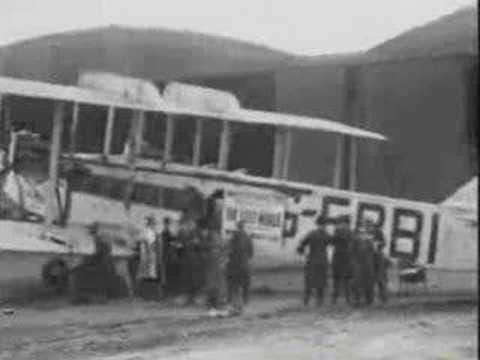
The golden age of travel ads

The Machine Age style used prominent angular typefaces, rounded contours, and confident lines

Just like today, traditional ceremonies or spending time in nature were heavily advertised
Experimental and impactful, travel ads were some of the finest artwork of the decade. Although the promised experience was rarely delivered.
The growing industry of travel agencies
People of the 1920s were already avid customers of travel agencies. The oldest one established by Thomas Cook dates back to 1840. It was the first to organize an air tour from New York to Chicago in 1927, advertising the experience of flight rather than a mere mode of transportation.

The tourist group outside a hotel in Cairo
For many, travel agencies were the only guarantee of their safety during the journey. If upper-class travelers had access to personal transit or the help of hotel staff in case of trouble, middle-class visitors had nowhere to turn, especially if they lacked experience or didn’t know the language. Prepaid group tours allowed them to relax. An agent would meet them at the train station or the port, put them on transportation, pay for them, arrange guided tours, and accompany them at every destination.
Some agencies would also publish travel guide books. Thomas Cook’s books were specifically targeted at less urbane travelers of more average means, listing hotels, restaurants, and places of interest available to people of simpler tastes.
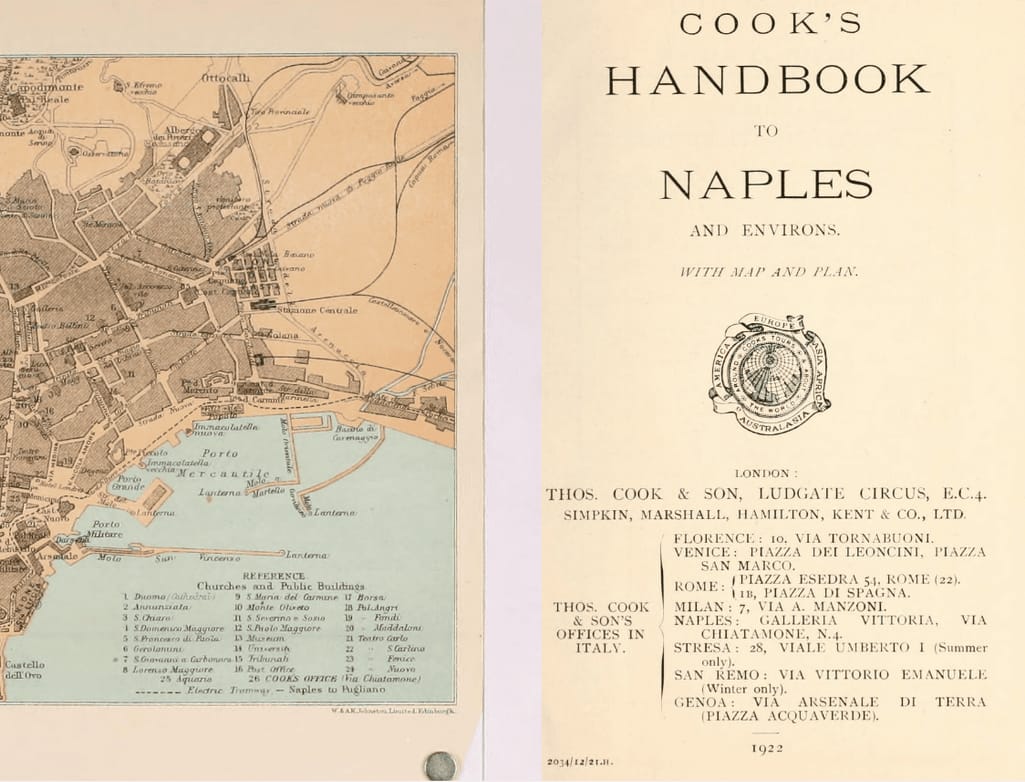
Cook’s travel books were meant to advertise an agency’s services Source: Archive.org
Today, the appeal of traditional travel agencies remains the same, but the opportunities changed drastically. If in the 1920s people wanted to visit a foreign country, it was simply unsafe to try that alone. In 2020, we want independence and search for authentic experiences. We pack light, follow the advice of Instagram influencers, and get to enjoy long vacations combining beach gateways with work. Is there a way to make travel more convenient? The new decade will show.
1920 vs 2020
The futuristic city presented in 1927’s Metropolis is almost as far from our reality as it was to people 100 years ago. Would it disappoint time travelers from the past? It’s hard to predict how the innovations unfold, but we have at least some advances to boast about. In 2019, Qantas announced its testing of the longest flight in the world - 19 hours of travel between New York and Sydney. It seems like a lot, but it will also take less than a day - in the 1920s and for the decades to come, no ship or plane would have delivered you so fast across land and sea.
Comfort is another advancement though jet lag hasn’t gone anywhere. Prices are cheap even when they’re expensive and getting a ticket is so easy we can book a trip in a few clicks (a concept we would struggle to explain to our 1920s friends).
But the most fascinating parts are not the differences, but how much we have in common, even 100 years apart. It’s the wanderlust, the simple pull to grab a tent and go for a weekend getaway to the Grand Canyon. We are enchanted still by magical (albeit unrealistic) imagery of faraway places. We desire to expand our horizons, meet people around the world, experience new ways, foods, cultures. None of this will change in the next 100 years.

Traveling by Air in Early 1920s England
The four years of the First World War accelerated the progress of aviation faster than the eleven years between the Wright Brothers’ first flight and 1914. At the end of the war, not only were there numerous aviators without anything to do, but there were numerous airplanes left idle now that there were no Germans to strafe over the Western Front. Flight naturally became even more of a sport in the early 1920s, and it also encouraged aviators to push the limits of flight (transatlantic challenges), but many others saw its commercial potential.
As early as August 1919, Aircraft Transport & Travel began its aeroplane service from London to Paris. Its innovation was soon followed by Handley Page Transport Litd, who also opened up service from London to Brussels. The following year, the Instone Air Line, which had been founded in 1919 as an aeroplane shipping company, established its own London to Paris line. The following schedule is found the 1920 edition of The Blue Guides: England :
These services start at present from Waddon Aerodrome (Waddon station on the L.B. & S.C. Railway), near Croydon, S. of London. The Paris services fly to and from Le Bourget Aerodrome (Bourget station, on the Grande Ceinture), N.W. of Paris; the Brussels service to and from Evere Aerodrome , N,E. of Brussels (half-an-hour’s cab-drive from the city). Paris Service of the Aircraft Transport & Travel Co. daily both from Waddon and from Le Bourget, at 12.30 p.m. The flight takes about 2 1/4 hrs. and the fare is £21 (return £42). Luggage allowance, 15 lb. The Airco machines on this service carry 2 or 4 passengers. Paris Service of the Handley Page Co. from Waddon on Tues., Thurs., & Sat. at noon, returning from Le Bourget on Mon., Wed., & Fri. at noon. The flight takes about 3 hrs., and the fare is £15 15/ (return £31 10/). Luggage allowance, 30 lb. — On the intermediate days the service is maintained by Breguet machines (3 passengers) of the French Messageries Aeriennes (2 Rue Galilee, Paris). Paris Service of the Instone Air Line from Waddon on Mon. & Thurs. at 12.30 p.m., returning from Le Bourget on Tues. & Fri. at 12.30 p.m. Fares £12 (return £21). Brussels Service of the Handley Page Co. from Waddon on Mon., Wed., & Fri. at noon, returning from Evere on Tues., Thurs., & Sat. at noon. The flight takes about 3 hrs., and the fare is £15 15/ (return £31 10/). Luggage allowance. 301b. A regular air-service between Hounslow and Amsterdam (Soesterberg Aerodrome; in 3£ hrs.; fare £21) is being organized by the British Aerial Transport Co., and other schemes for overseas services to the Continent have been mooted.
In his 1921 book, Whispering Europe , Everit Bogert Terhune briefly describes his trip from Paris to London in an airplane:
“I flew with my family and baggage from Paris to London in two hours and twenty-five minutes, a journey that requires a full day or night by train and boat under ordinary circumstances. We lunched in Paris at one o’clock; taxied to the Instone AirLine Aerodrome shortly after three, had our baggage and passports inspected and started for England at five minutes of four. We walked into our hotel near Piccadilly Circus at seven o’clock and had our dinner. It was safe, clean, pleasant, exhilarating, reasonable in cost—and speedy.
I am for it. After you have had a taste of it you will believe it is the only way to travel. We invented the machine. Where are our air lines between Boston and New York and Chicago and Washington? Nowhere—John Bull, the plodding and persistent, has beat us to it. I anticipate a trip across the Atlantic within the next 24 months from America to England, but not on an American line.”
He was right. This 1921 advertisement from Thomas Cook & Son (they kept abreast of all new modes of travel!) lists both commercial flights within the United States and the Britain-to-Europe flights.
Alas, the age of airline independence ended in 1923, when a Government committee recommended all airlines merge to form one strong airline to enable expansion and greater competition with non-British airlines. In 1924, Imperial Airways was formed, and absorbed the “assets and routes of Handley Page Transport, Instone Air Line, Daimler Airway and British Marine Air Navigation Co Ltd.”
Further Reading Instone Air Line Instone Air Line Timetables Handley Page Timetables
Share this:
- Click to email a link to a friend (Opens in new window)
- Click to share on Pinterest (Opens in new window)
- Click to share on Facebook (Opens in new window)
- Click to share on Tumblr (Opens in new window)
- Click to share on Twitter (Opens in new window)
- Click to share on Reddit (Opens in new window)
- Click to print (Opens in new window)
Fashioning an Education: 150 Years of Vassar Students and What They Wore
You may also like, some carriage types, the season abroad, the road to baguio.
My view of flying in WW1 was formed decades later when our primary school teachers were single ladies whose flyer fiances all died tragically. I wonder if people were already prepared, in the 1919-25 era, to trust their lives in flimsy aircraft so soon after the tragedies ended.
Passenger flights were already popular before the war. Granted, it was usually only one other person besides the pilot, but many aerodromes in England included them in their flying programs. Or it could be that people already experienced the worst (the war), and an aeroplane couldn’t harm you any more than you’d already been harmed.
Fascinating stuff. I’m amazed at how speedy and easy Terhune found his flight. If only we could still describe flying as easy. 🙁
- Pingback: Blog 2 | transformingcitiesblog
Comments are closed.
More Stories
Women’s government work.

This exhibit is now closed.
Americans were wild about aviation in the 1920s and '30s, the period between the two world wars that came to be known as the Golden Age of Flight. Air races and daring record-setting flights dominated the news. Airplanes evolved from wood-and-fabric biplanes to streamlined metal monoplanes. The military services embraced air power. Aviation came of age. Aircraft displayed here included planes used for racing, record setting, business travel, and exploration. The Wittman Buster midget racer hung near the entrance. Inside was Howard Hughes' sleek, record-setting Hughes H-1 Racer; the Curtiss J-1 Robin Ole Miss , which stayed aloft for 27 days; a Beech C17L Staggerwing, designed for business travelers; and the Northrop Gamma 2B Polar Star , which traversed Antarctica.
- Get Involved
- Host an Event
Thank you. You have successfully signed up for our newsletter.
Error message, sorry, there was a problem. please ensure your details are valid and try again..
- Free Timed-Entry Passes Required
- Terms of Use
- The Inventory
Passenger Air Travel in the 1920s As Told Through Cigarette Cards
Passenger air travel in the 1920s and 30s was a uniquely exhilarating experience — provided you could afford it. But for those of us stuck in a world where flying has become a mundane and sometimes excruciating ordeal, we can at least live vicariously through the past. A website called The Passion of Former Days has collected some promotional cards which give us a peek into the world of flight in the 1920s.
Related Content
Twenty-five cards produced by the Arents Cigarette company are now in the New York Public Library's collection . It wasn't uncommon for companies of the early 20th century to include promotional cards in their foodstuffs and tobacco products . Futurism and the latest technological advances were common themes for the cards.
These cards are undated but the Argosy aeroplane was introduced in 1926 . So the fact that the postcards mention the aircraft as new means that they're probably from the mid to late 1920s.
Of particular interest to paleofuturists might be the land lighthouses that would guide Imperial Airways planes approaching London at night. We looked at the rough American equivalent (our Highway of Light system) last year.
Check out the website The Passion of Former Days for more cards from this collection and special thanks to Slate Vault for the heads up.
Images: NY Public Library via The Passion of Former Days
Advertisement
This is what it was like to fly in the 1930s

While mankind's foray into flying began in the early 20th century, the modern air travel industry as we know it didn't truly grow its roots until the 1930s. As metal planes returned home from post-war posturing, a boom in passenger interest and sufficient technology to reach a slew of international destinations made the 1930s the start of something big. But like any major technology, commercial flight didn't come without growing pains. If you think you have a lot to complain about now when it comes to air travel, take a look at what it was like to fly in the 30s.
The birth of a global sensation. Just 6,000 Americans traveled commercially by airplane in all of 1930, according to Smithsonian National Air and Space Museum . Only four years later, that number would multiply by 75 times — 450,000 passengers flew in 1934, a number that would be dwarfed once more in another four years, when 1.2 Million Americans traveled by air. The 1930s were truly the decade that commercial air travel became a worldwide sensation.
The transition from wood to metal planes changes the world. In the aftermath of World War I, the victorious nations found themselves with quite a significant number of planes — both fighter and support vehicles — on hand. And just like that, the commercial air travel industry, ahem , took off. New, metallic planes weren't just more durable during wartime ; they also withstood the dramatic changes in climate that a vehicle might experience when traveling between, say, Boston and the Caribbean. Metal-bodied planes didn't just enable longer routes, they enabled air travel along longitudinal lines, where climates change from arctic to temperate to tropical to arid, and then back again.
Higher! Faster! A decade of full throttle flying. The transition to metal planes enabled aircraft to push past the limitations that had remained mostly set in stone since the advent of flight. The first commercial flight in 1914 hovered at a cruising altitude of just 5 feet in the air . In the 1930s, planes began to hit the 200 mph mark, and settled into a cruising altitude of about 13,000 feet .
Not for the faint of heart. British Airways Empire Class planes in the 1930s were equipped with three state-of-the art flying lavatories, but it was widely understood that their actual usage was to be avoided at nearly all costs. Just because we as humans suddenly could fly at 13,000 feet didn't mean that we had necessarily worked out all of the kinks just yet. According to Gizmodo, planes would regularly drop hundreds of feet mid air with no warning. Today's gentle alerts from the cabin to return to your seat and buckle up as the plane may experience some coming turbulence were born out of the horror of this era's actually turbulent flights.
Not if , but when you get sick. While experiments with oxygen enrichment of cabin air date back to the early 1920s, widespread adoption of standardized cabin pressurization didn't hit the airline industry until the 1940s , according to the American Institute of Aeronautics and Astronautics. This meant that oxygen tank-assisted breathing was a regular occurrence on flights in the 30s, and air sickness bowls could be found under each seat.
Extreme temperature fluctuations were also an unfortunate fact of flying at the time. Air conditioning and heating wouldn't alleviate these discomforts until the end of the decade. We have blankets on flights today because of the absolutely necessity for them in the 1930s.
It cost an arm and a leg (or half a car). A roundtrip ticket from coast to coast cost about $260 in the 1930's . Some context: the average automobile at the time cost just double that. Flying was an exciting new thrill, but only for the few who could afford it.
Pack a book to read (Or maybe just write one of your own). Our great-grandparents would be embarrassed at our tendency to bemoan the hardships of a 15 hour, non-stop flight . Today's 12-hour flight from London to Singapore would have taken 8 days in 1934 , with 22 separate layovers to refuel in exotic locales like Athens, Gaza, Baghdad, Sharja, Calcutta and Bangkok. While we may cringe at that sort of time-intensive itinerary today, it sure beat the then month-long trek by boat that was really the only alternative.
All roads lead to Cairo. While London Heathrow, Dubai and Atlanta hog the limelight when it comes to major hubs here in the present, in the 1930s it was all about Cairo . Uniquely positioned as a nexus between Europe, Africa and Asia, you would have been hard-pressed to travel anywhere between the three without touching down in Cairo along the way.
- The Scary Truth About Air Travel in the <i>Downton Abbey</i> Era
The Scary Truth About Air Travel in the Downton Abbey Era
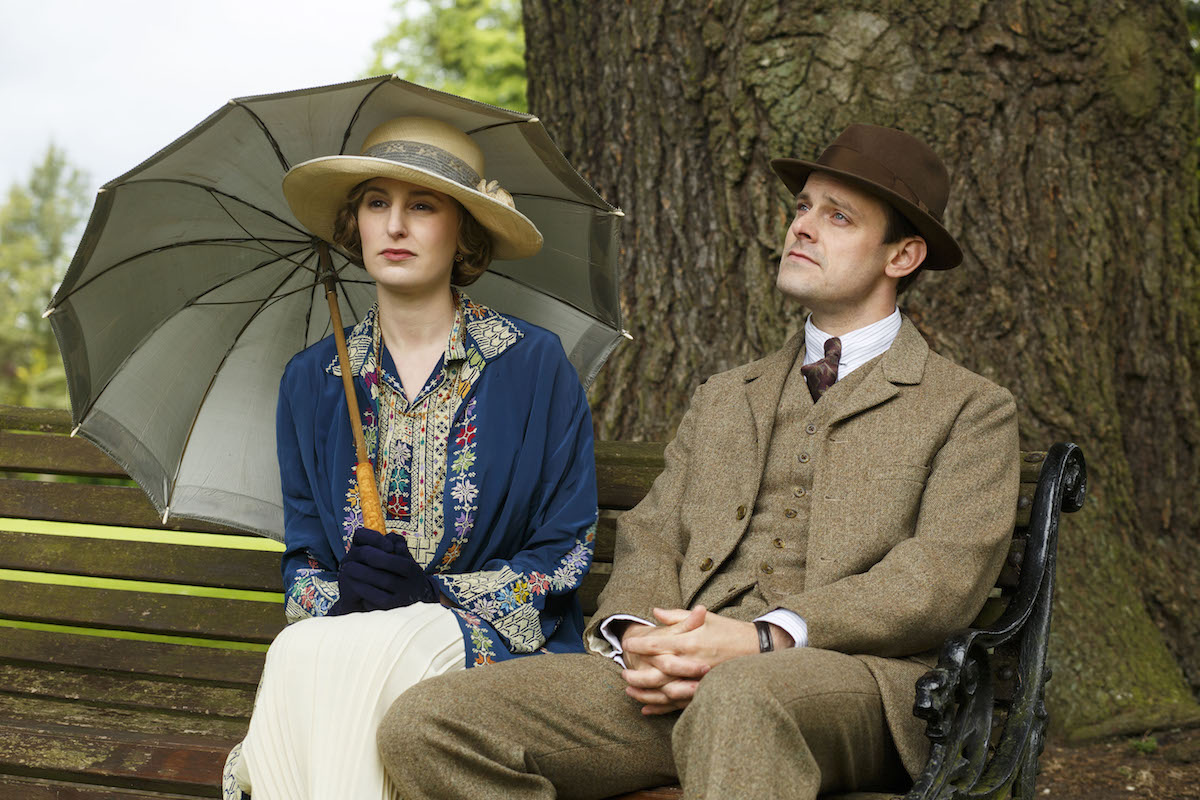
T he news on this Sunday’s episode of Downton Abbey that Bertie Pelham planned to travel to Tangier by air rather than ship was met with shock by the Crawley family—and with good reason. Though the number of airplane passengers in Europe had nearly doubled between 1923 and 1924, flying at all in the mid-1920s was a bold move.
Stunt and military pilots had been taking to the skies for years, but commercial air travel was still relatively untested. It was unsafe, even though fatalities were rare ; it was also often inconvenient and far more uncomfortable than what modern fliers might think of when they hear the words vintage aviation .
The situation was so bad that in 1925—the year the U.S. awarded a company the first contract to deliver mail by air —Henry Ford said that “the commercial airplane is as yet a considerable distance of being a success,” perhaps because the motor’s “vibration is so intense that there is little guaranty [ sic ] under such strain that it will remain intact over considerable distances.”
Yes, you read that right: the concern was whether the engines would just completely fall apart. Whether the passengers made it to their destination safely, Ford guessed, was 90% a matter of the pilot being exceptionally skilled (not that he didn’t have a vested interest in promoting travel by auto).
See Incredible Photos of Vintage Airplanes
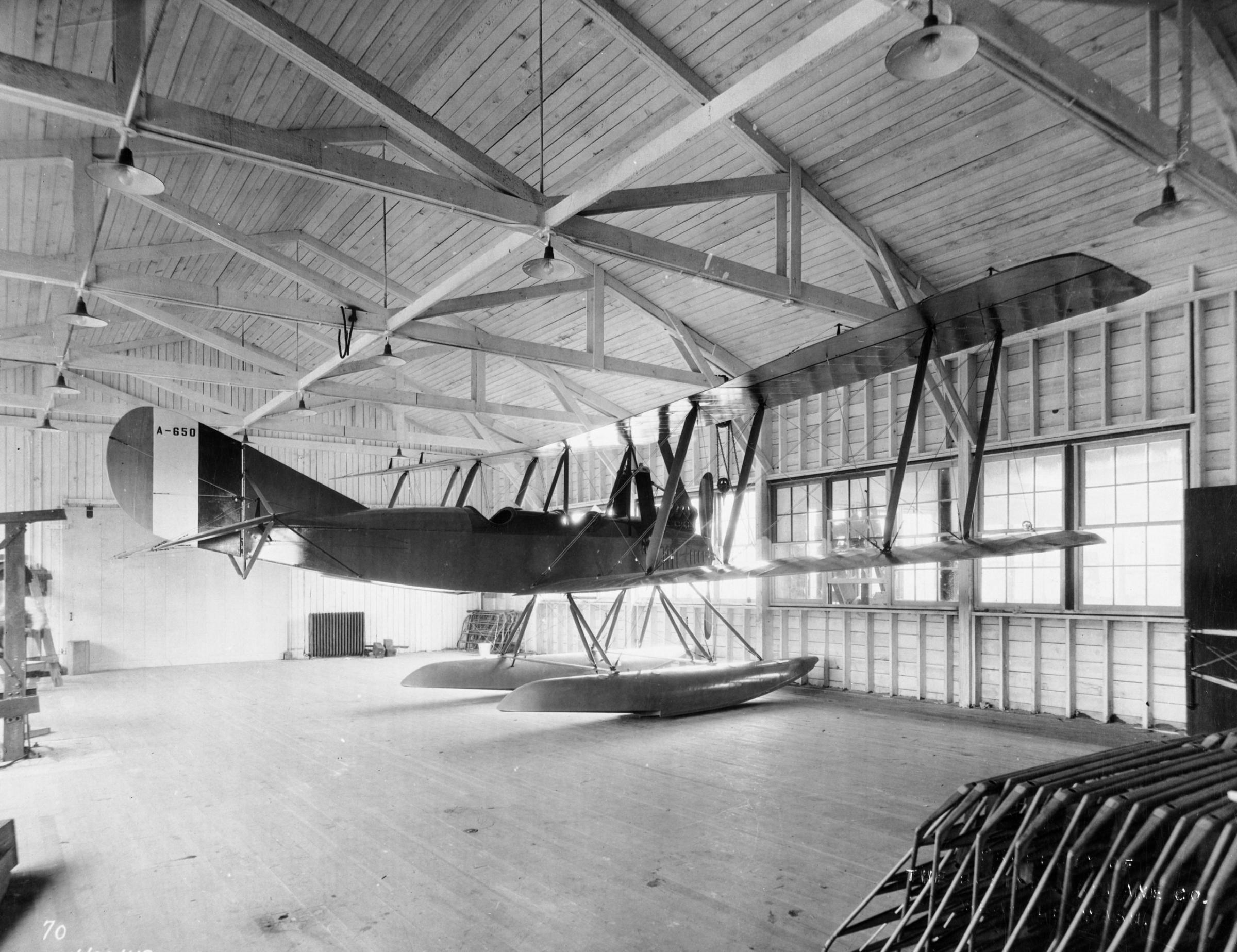
Britain’s Imperial Airways did not conduct flights at night until 1926, and planes generally took longer (especially considering frequent stops to refuel) and were more uncomfortable than trains. Planes flew low, which meant more turbulence, and into the 1920s passengers had to wear helmets and goggles. One early route from Toulouse, France, to Casablanca, via Tangier and several other cities, took 12 hours.
But, as Ford had predicted back in 1925, the business potential was great enough that in a couple of years things could change. Sure enough, they did. It wouldn’t be long before TIME commented that “[men] of affairs whose time literally is money and the semisocial people who consider air travel modern and fashionable [became] airline customers.”
Today, a nonstop flight from Toulouse to Casablanca takes about two and a half hours.
More Must-Reads From TIME
- The 100 Most Influential People of 2024
- The Revolution of Yulia Navalnaya
- 6 Compliments That Land Every Time
- What's the Deal With the Bitcoin Halving?
- If You're Dating Right Now , You're Brave: Column
- The AI That Could Heal a Divided Internet
- Fallout Is a Brilliant Model for the Future of Video Game Adaptations
- Want Weekly Recs on What to Watch, Read, and More? Sign Up for Worth Your Time
Write to Lily Rothman at [email protected]

Switch to the dark mode that's kinder on your eyes at night time.
Switch to the light mode that's kinder on your eyes at day time.
A Look at Golden age of Air Travel in the 1950s
Air travel in the 1950s was marked by a significant increase in the number of people flying, as well as advancements in aircraft technology and infrastructure. The decade saw the introduction of jet airliners, which greatly increased the speed and efficiency of air travel. The first commercial jet airliner, the de Havilland Comet, was introduced in 1952, followed by the Boeing 707 and Douglas DC-8 in the late 1950s. These new jet airliners allowed airlines to offer faster, more comfortable, and more convenient flights, and they quickly became popular with passengers.
During the 1950s, air travel was still considered a luxury, but it was becoming more affordable and accessible to the general public. Airlines offered more flights and destinations than ever before, and air travel was becoming more common for both business and leisure. Many airlines also began to offer vacation packages, which included airfare, accommodations, and activities, making it even easier for people to travel.
Passenger services during this time continued to improve, with in-flight meals, drinks, and entertainment becoming more common. Airlines also began to offer different classes of service, with first-class offering more luxurious amenities than economy class. Flight attendants were also becoming more commonplace, and their role expanded to include safety, customer service, and in-flight service.
The flight crews of the 1950s were composed of highly trained and experienced pilots, navigators, and radio operators. With the introduction of jet airliners, the flight crews were also larger than before, with a pilot, co-pilot, flight engineer, navigator, and sometimes a flight attendant as a standard crew.
#1 A female instructor stands at a chalkboard, pointing to a chalk diagram of an airplane while female students take notes at their desks during a stewardess training school, 1950.
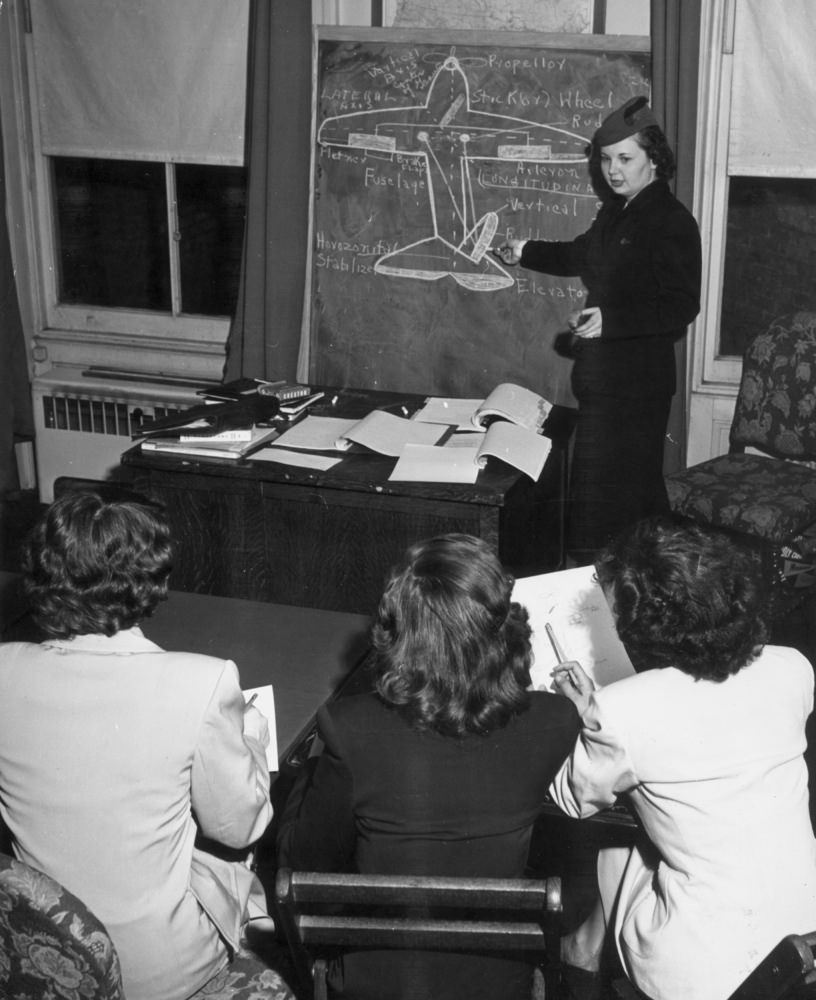
Leave a Reply Cancel reply
Your email address will not be published. Required fields are marked *
Post Comment
#2 Luggage being unloaded from airplane, 1950s
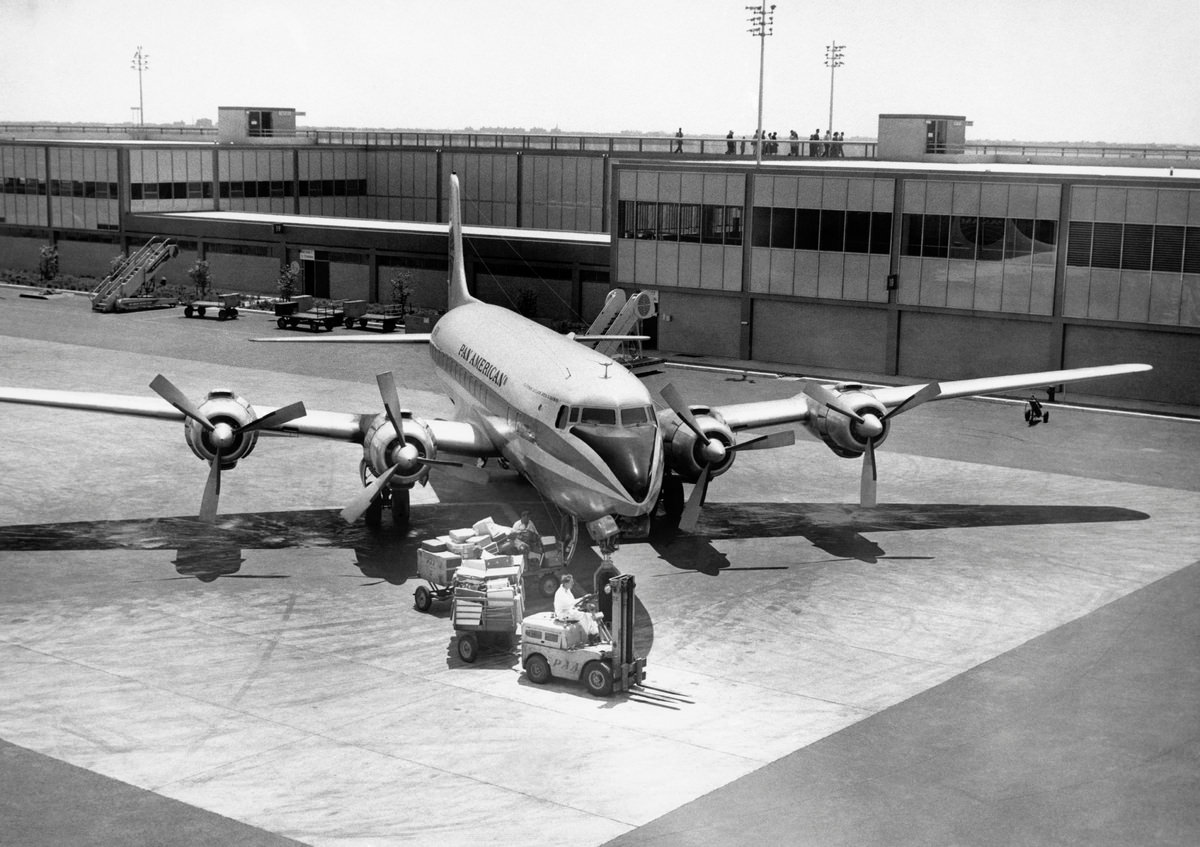
#3 Luggage being unloaded from airplane, 1950s
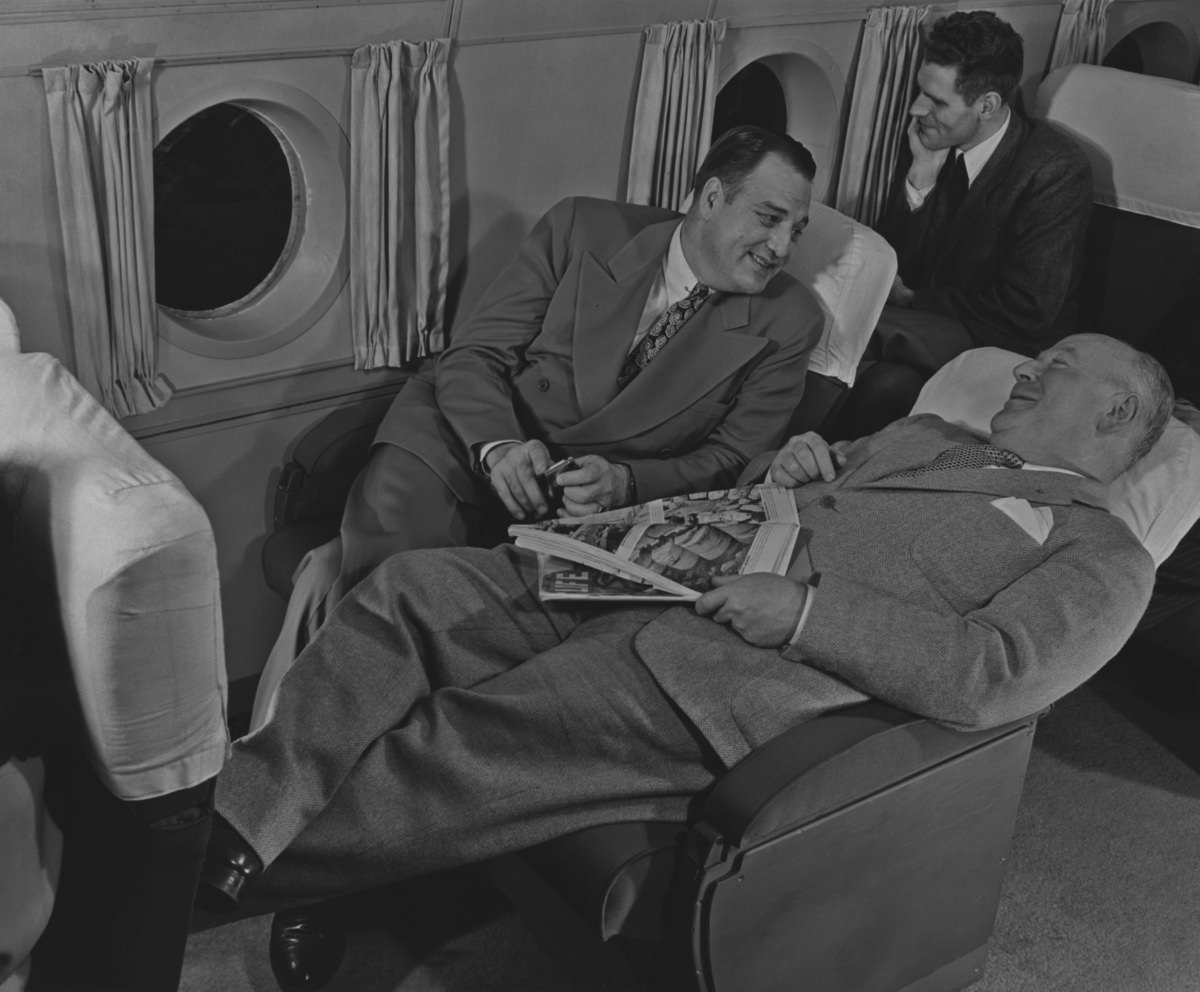
#4 A Pan American World Airways flight attendant preparing in-flight meals in the galley of an airliner, 1950s
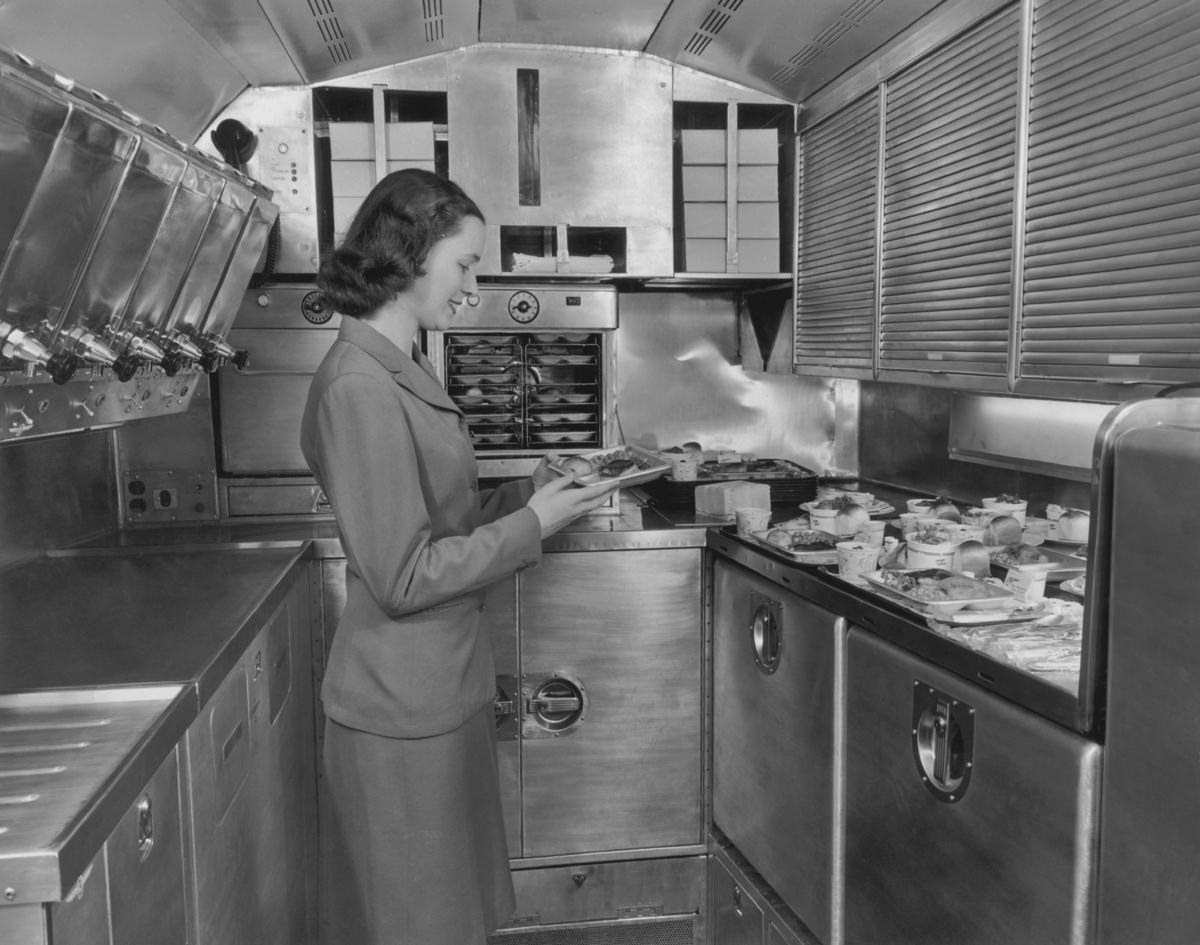
#5 A bus in bus docks at New York’s East Side Airlines Terminal. The docks are open on one side to permit exhaust fumes to escape, 1950s
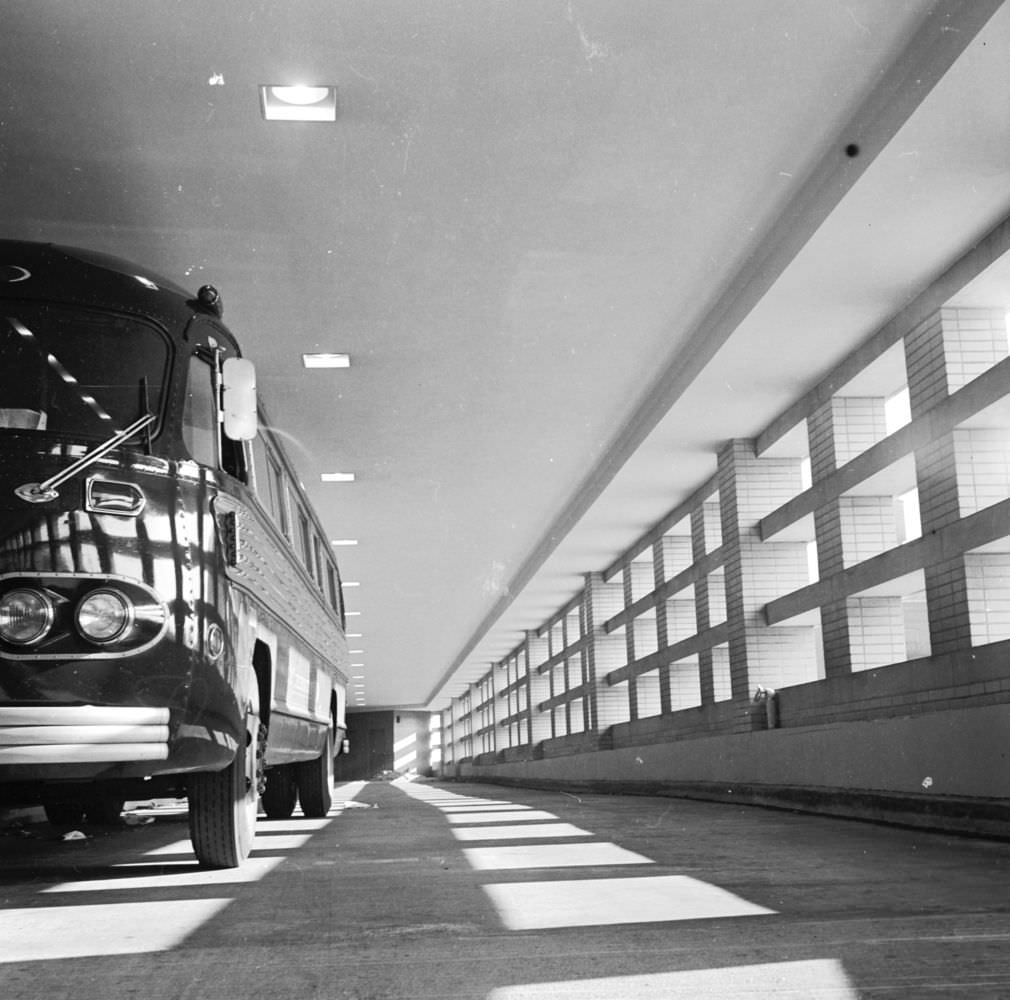
#6 Passengers checking in at New York’s East Side Airlines Terminal, 1950s
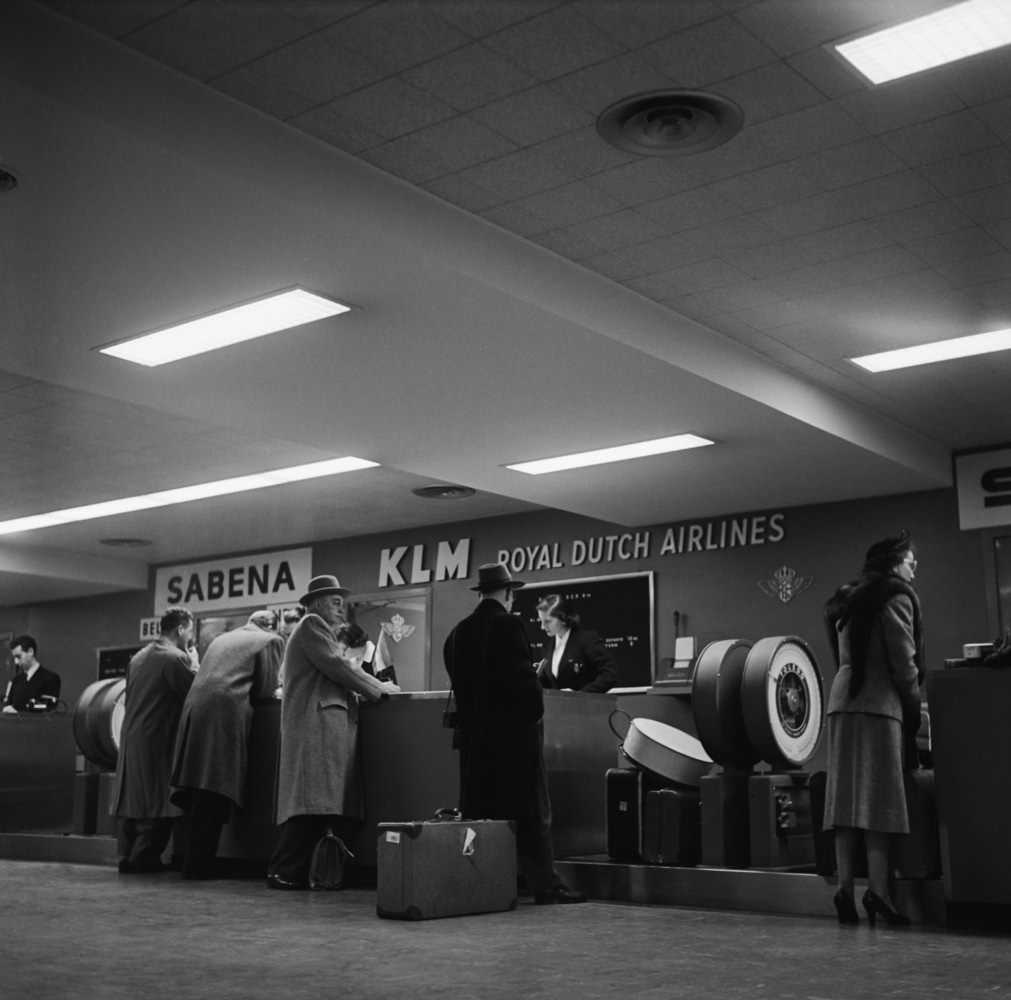
#7 Passengers checking in their baggage at New York’s East Side Airlines Terminal, 1950s
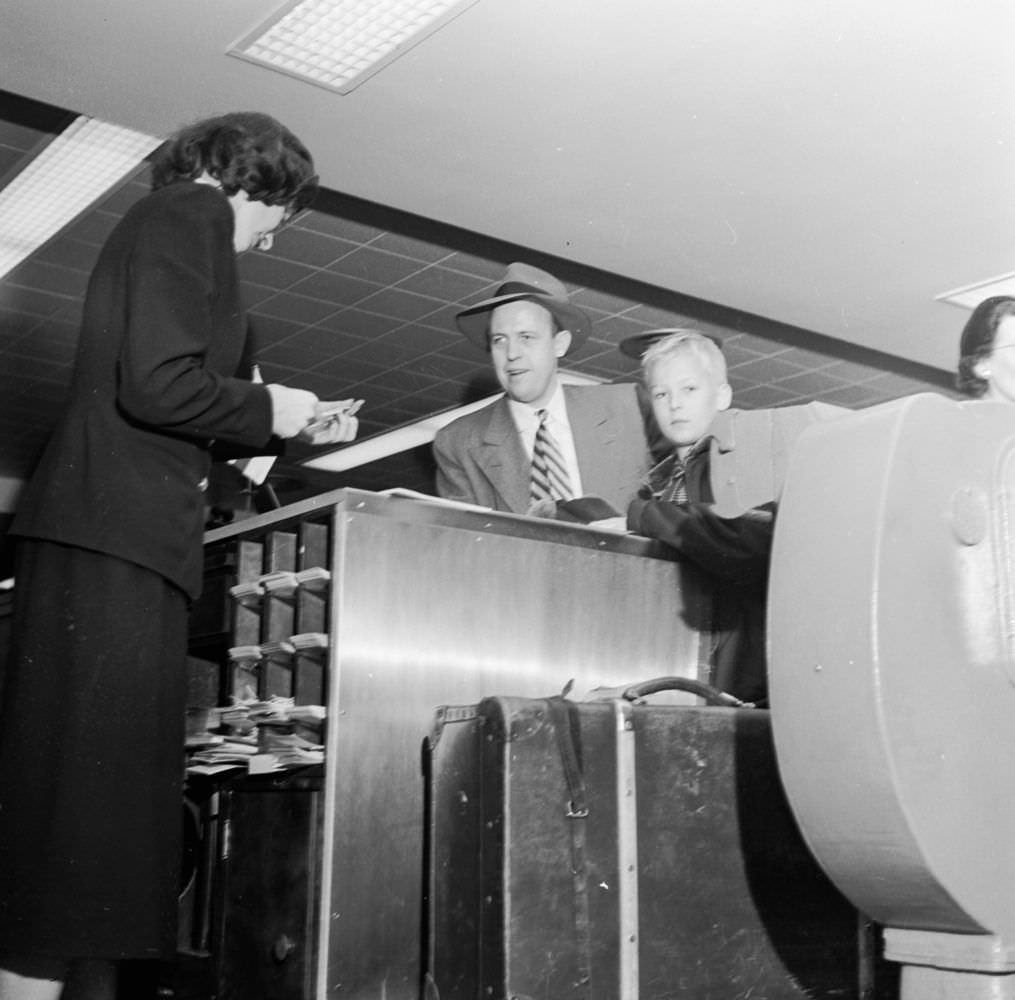
#8 Passengers checking in their baggage at New York’s East Side Airlines Terminal, 1950s
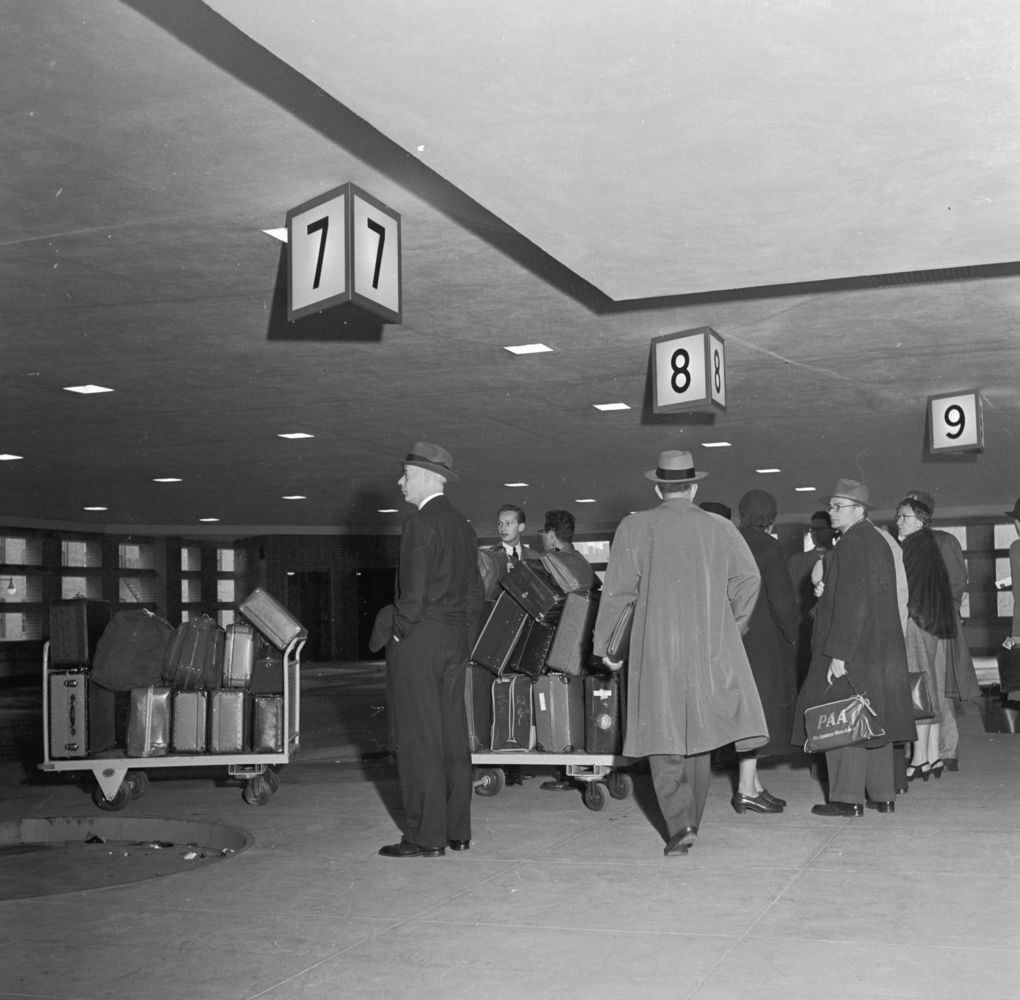
#9 New York’s East Side Airlines Terminal which operates on a 24-hour basis to provide transportation to every flight leaving from the city’s various airports, 1955.
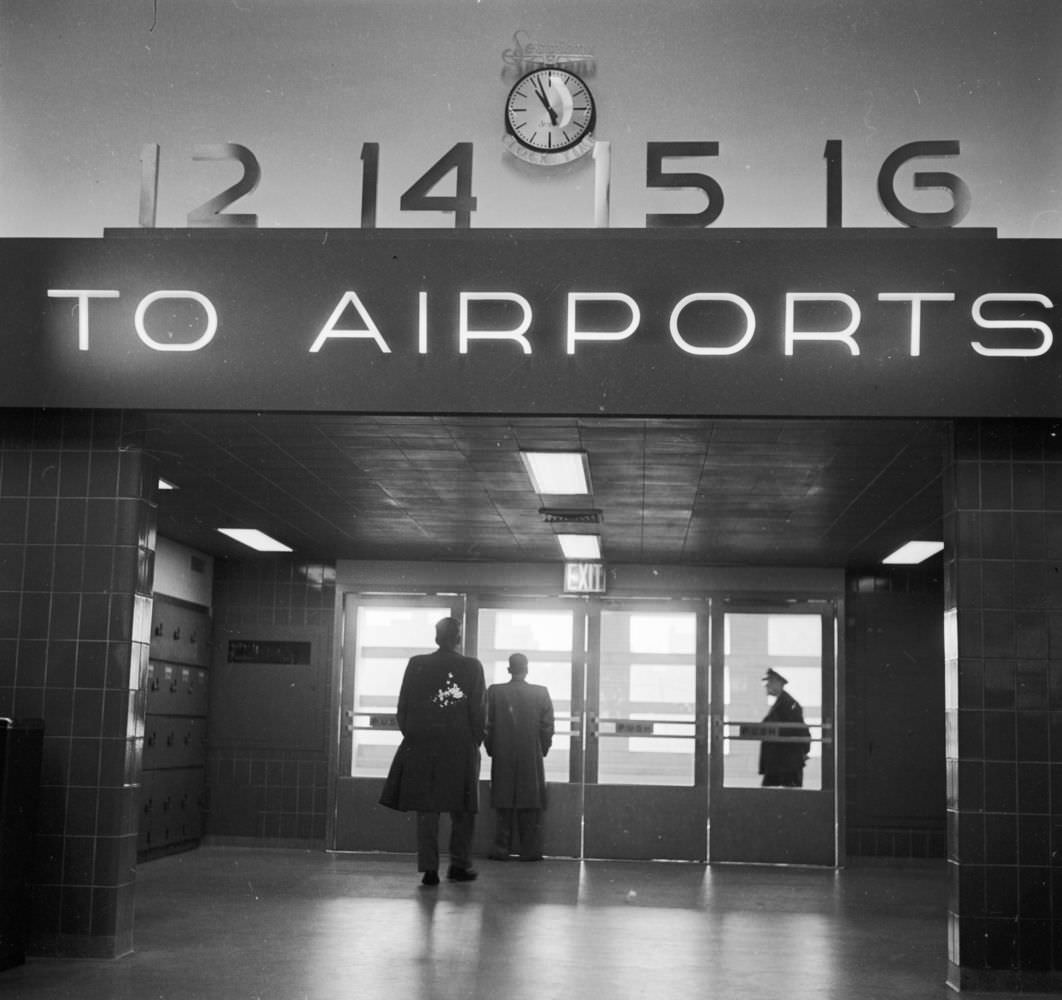
#10 A TWA pilot and stewardess greet the passengers coming off the plane, 1950
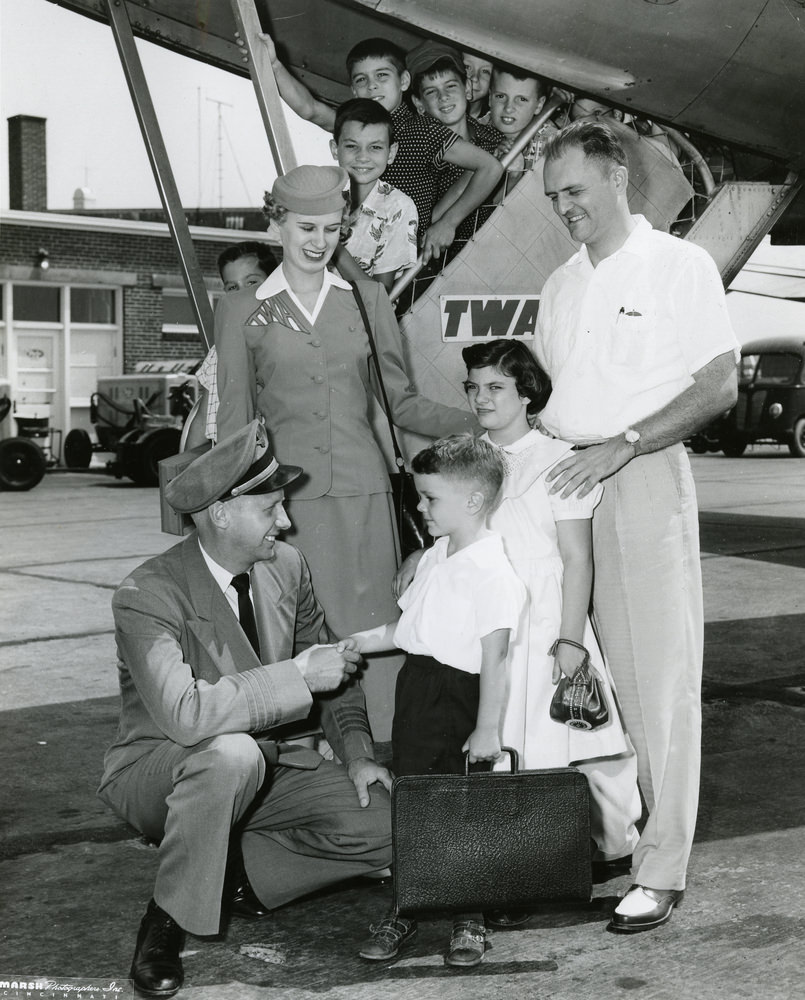
#11 PanAm Boeing 747
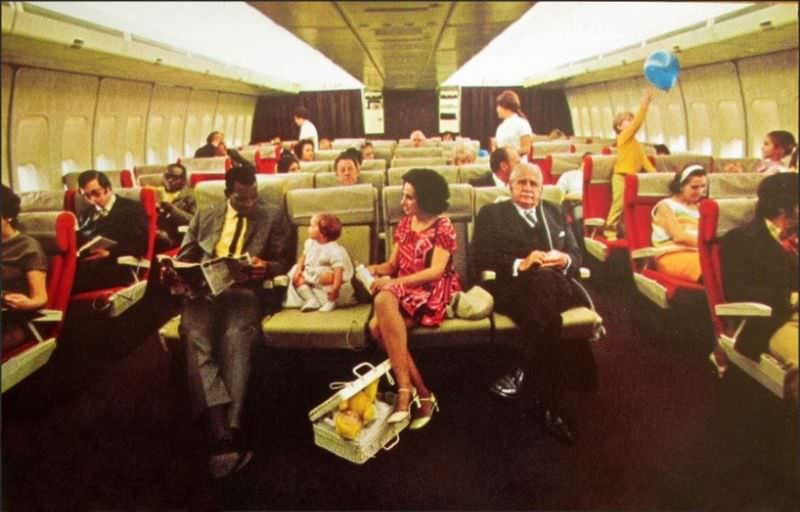
#12 A view from the control tower of the Greater Cincinnati Airport
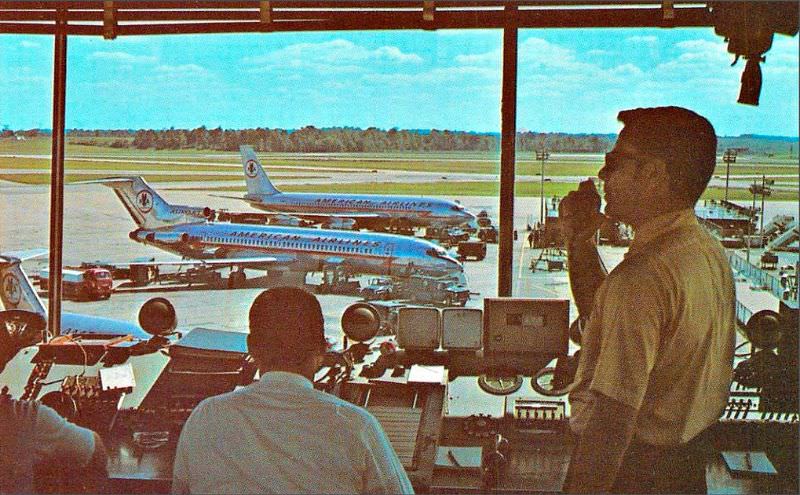
#13 American Airlines
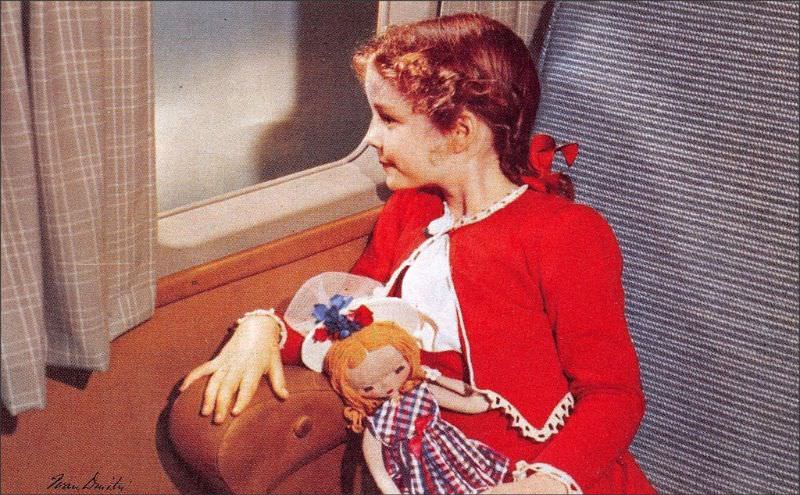
#14 Boeing 707 and 720
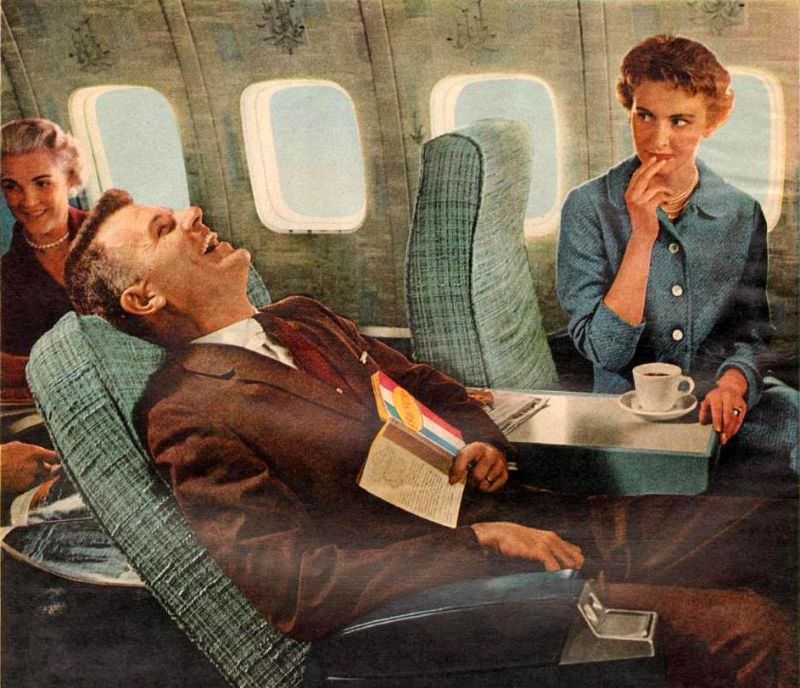
#15 Columbia Metropolitan Airport, Columbia, SC
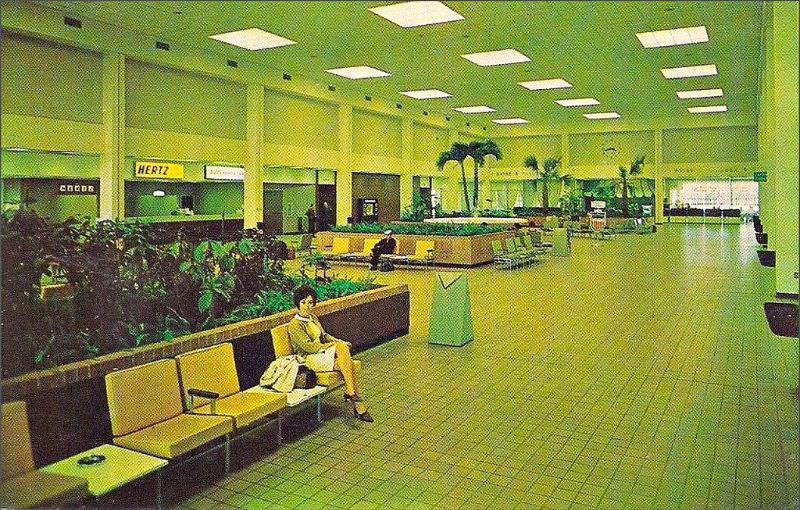

#16 Continental 747 Ponape Lounge, Airline Attendant
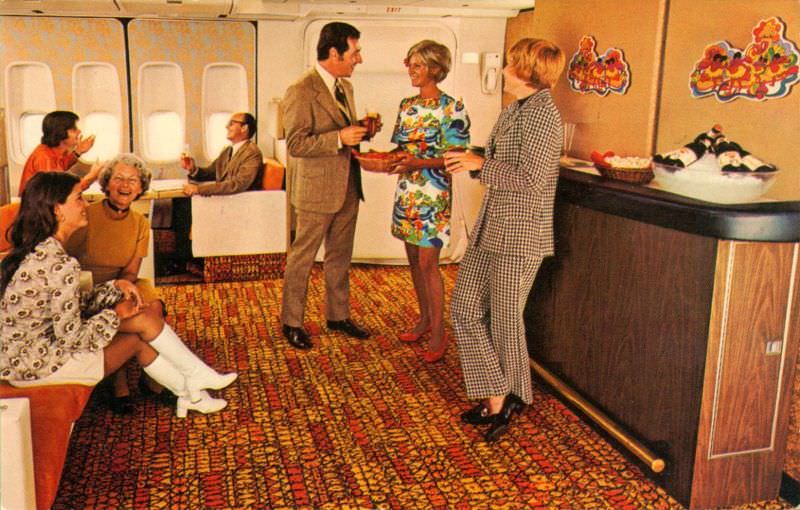
#17 Continental Airlines, 1950s
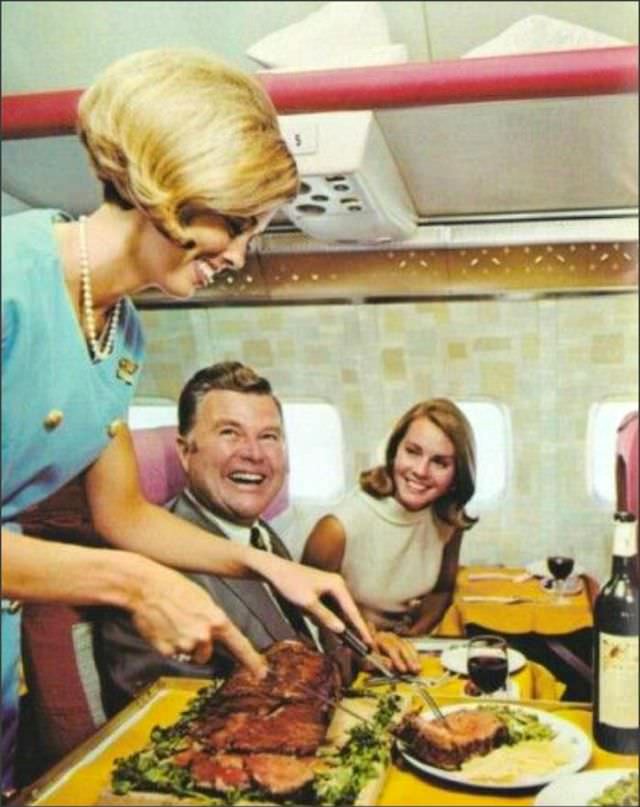
#18 Continental Airlines, 1950s
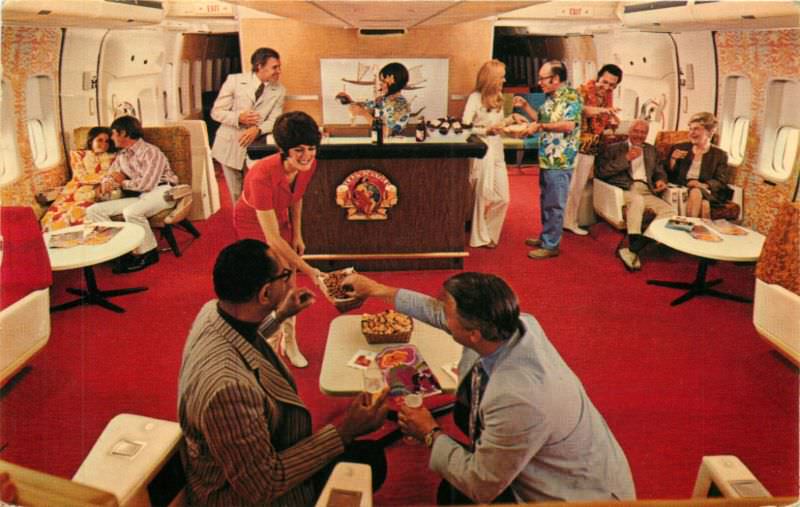
#19 DC-6 Mainliner United Airlines 48
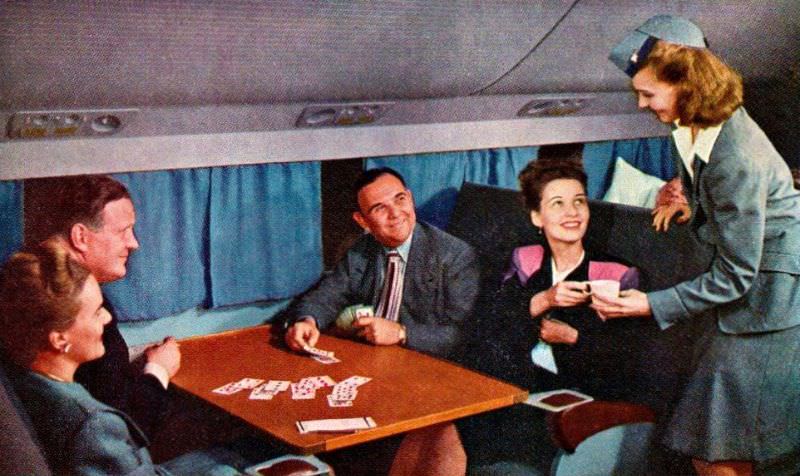
#20 Delta Airlines Convair 880
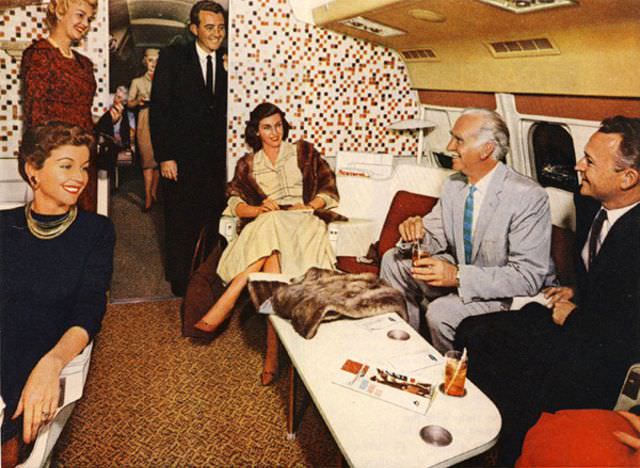
#21 Delta Airlines, 1950s
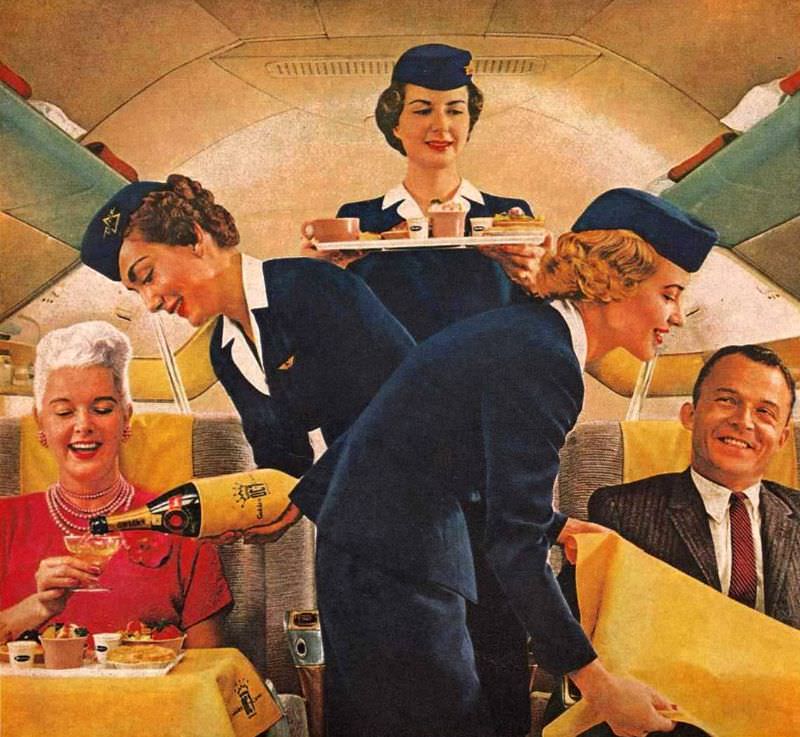
#22 Eastern Airlines Falcon Lounge, 1950s
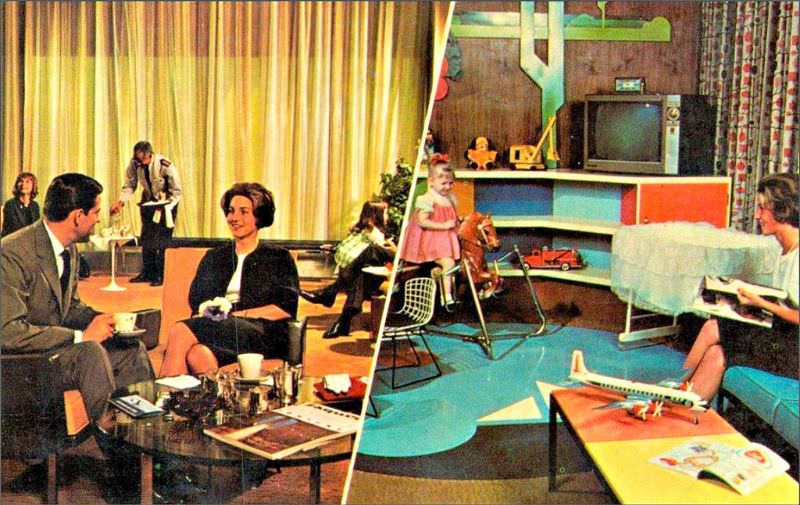
#23 Houston International Airport, 1950s
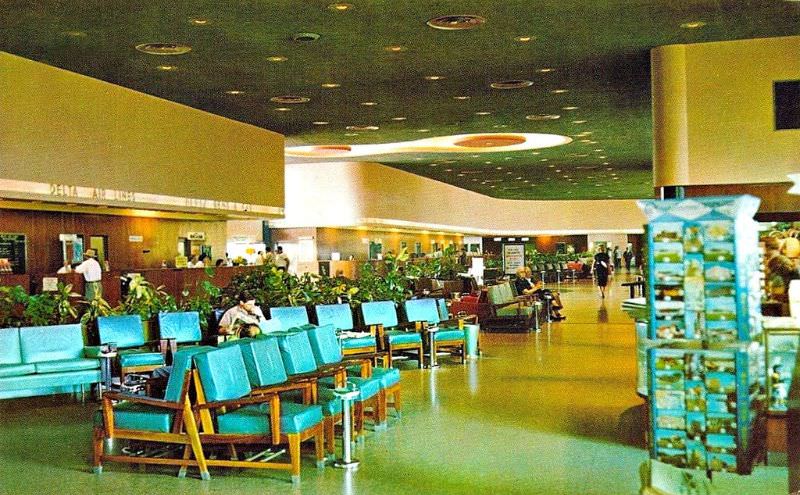
#24 Moisant International Airport, New Orleans, 1950s
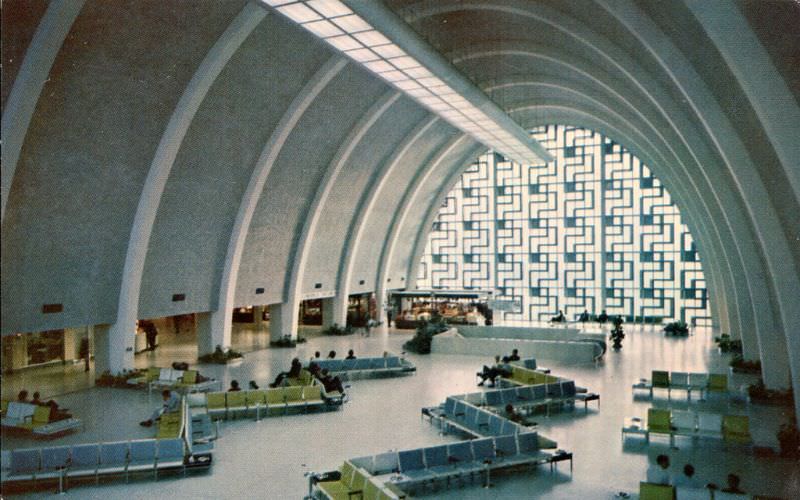
#25 Pacific Southwest Airlines (PSA) Electra Jet, 1950s
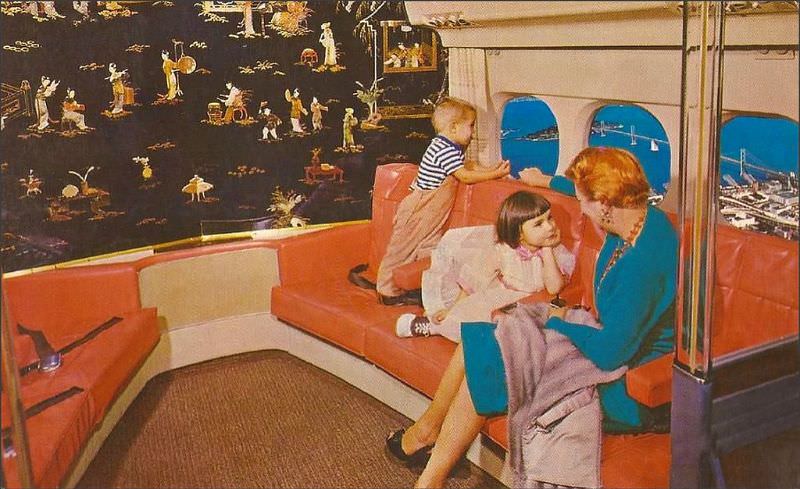
#26 Pan Am Airlines, 1950s
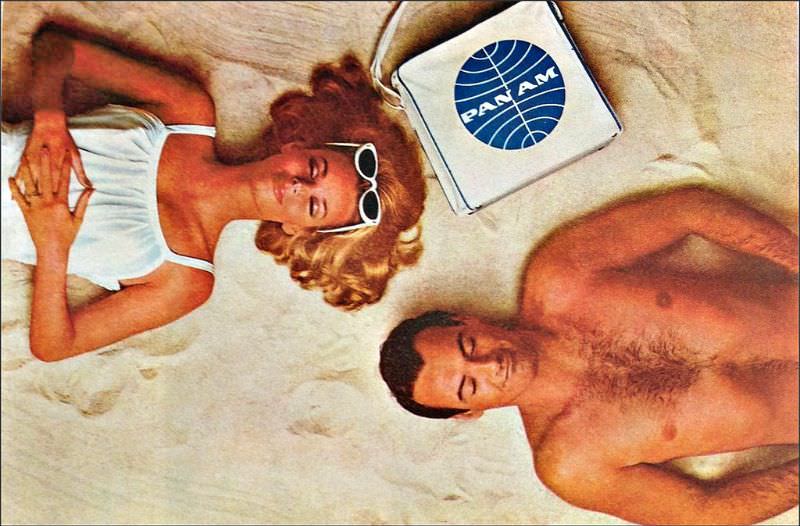
#27 United Air Lines DC-6 and DC-6B Mainliners, 1950s
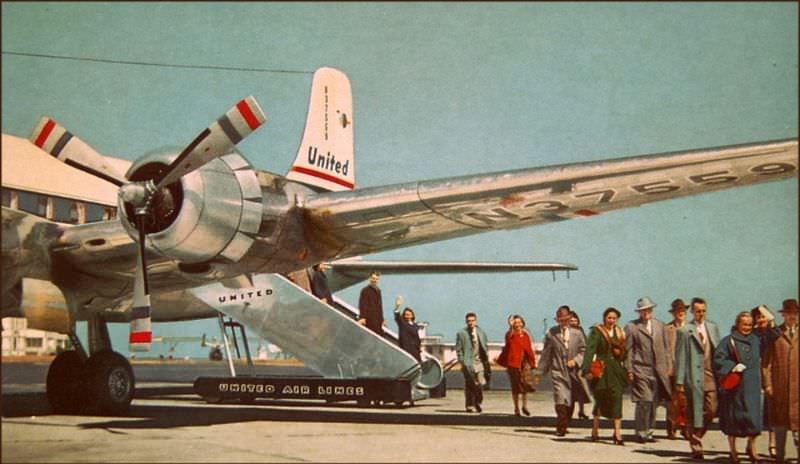
#28 United Airlines DC6 Airplane Meal Service Club Car Section, 1950s
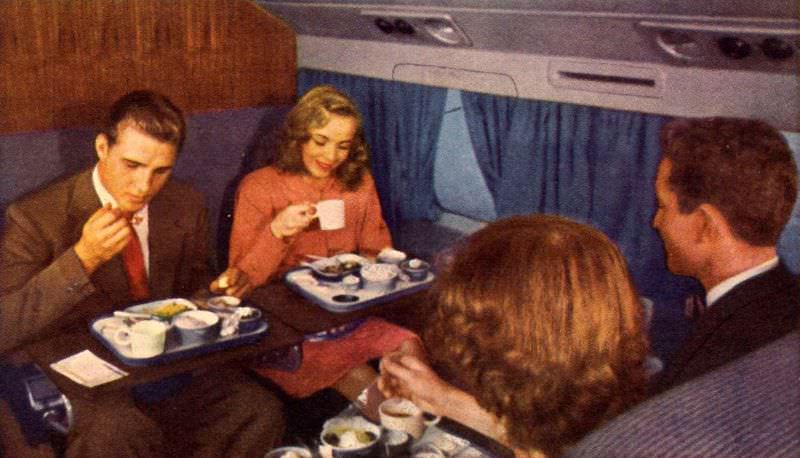
#29 United Airlines Red Carpet Service, 1950s
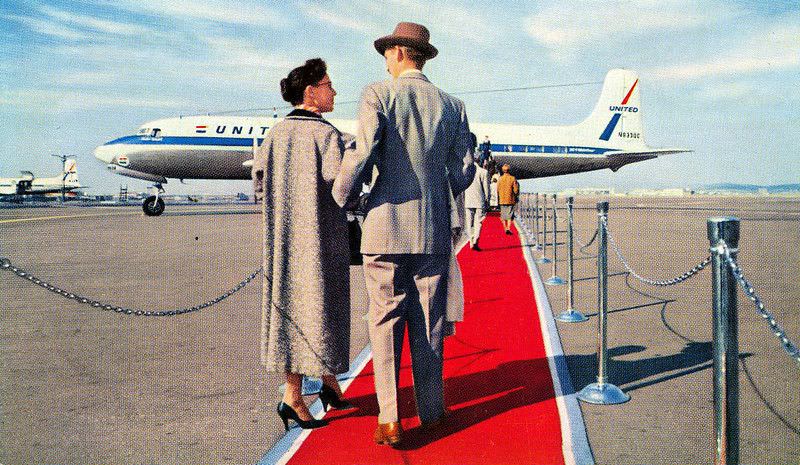
#30 United Airlines, 1950s
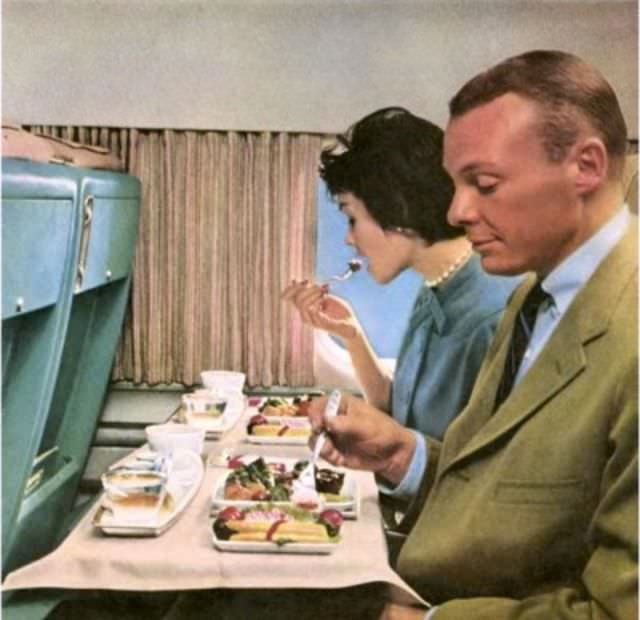
#31 United Airlines, 1950s
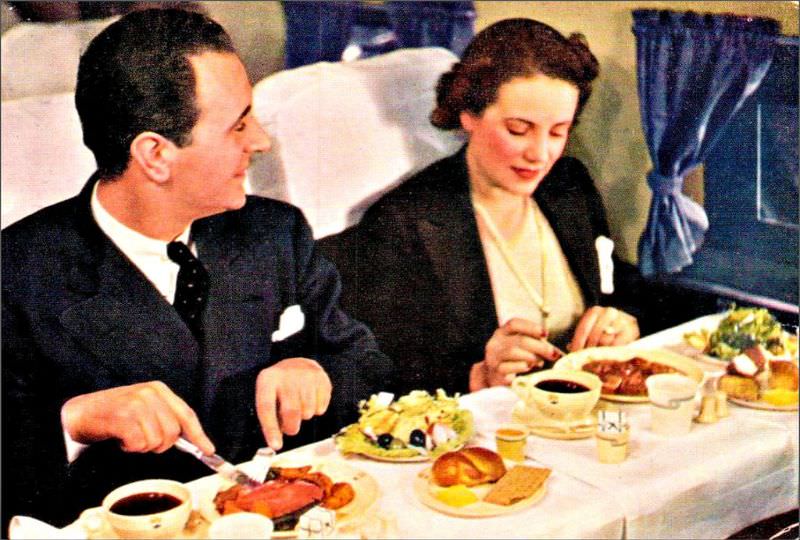
#32 Western Airlines, 1950s
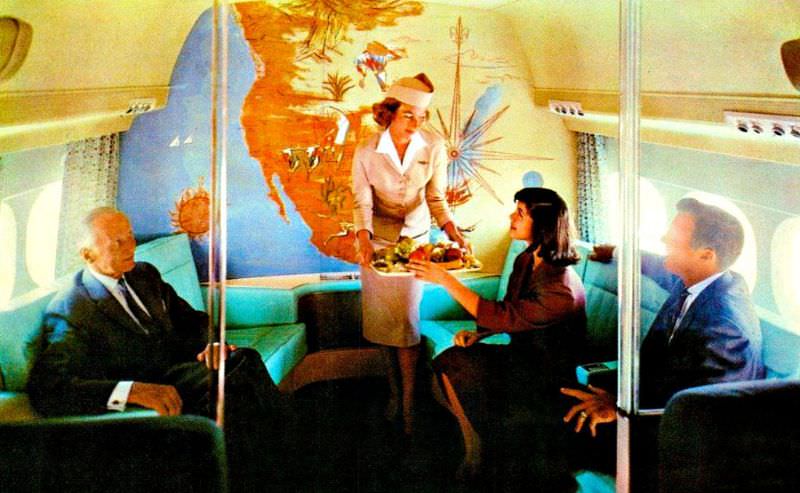
#49 An air steward serves a plate of grapes to a female passenger from a basket of fruit on a Bristol Britannia medium to long range airliner in October 1956.
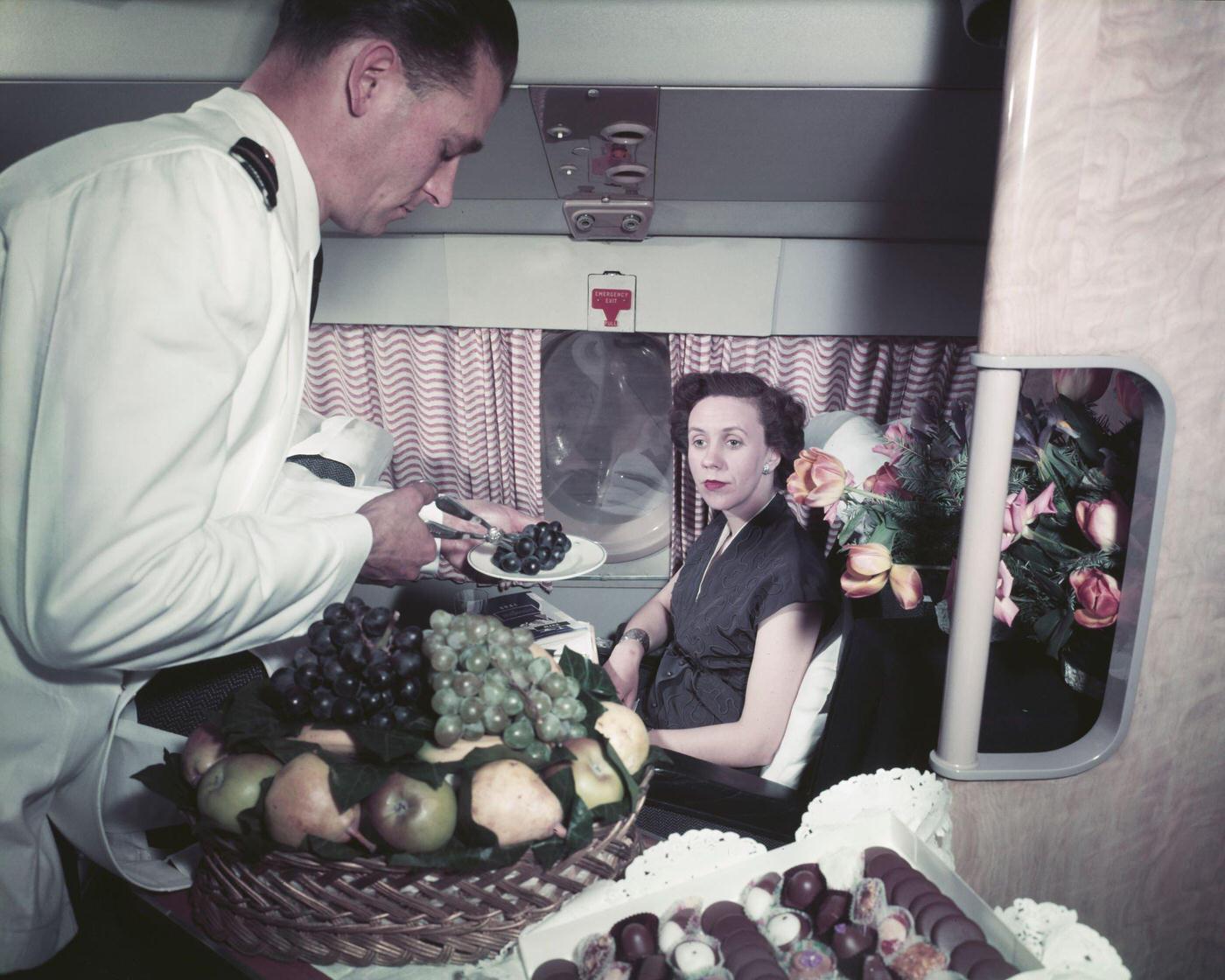
#50 Passengers board BOAC’s new Britannia propellerturbine airliner GANBI at London Airport, bound for Johannesburg, on 1st February 1957.
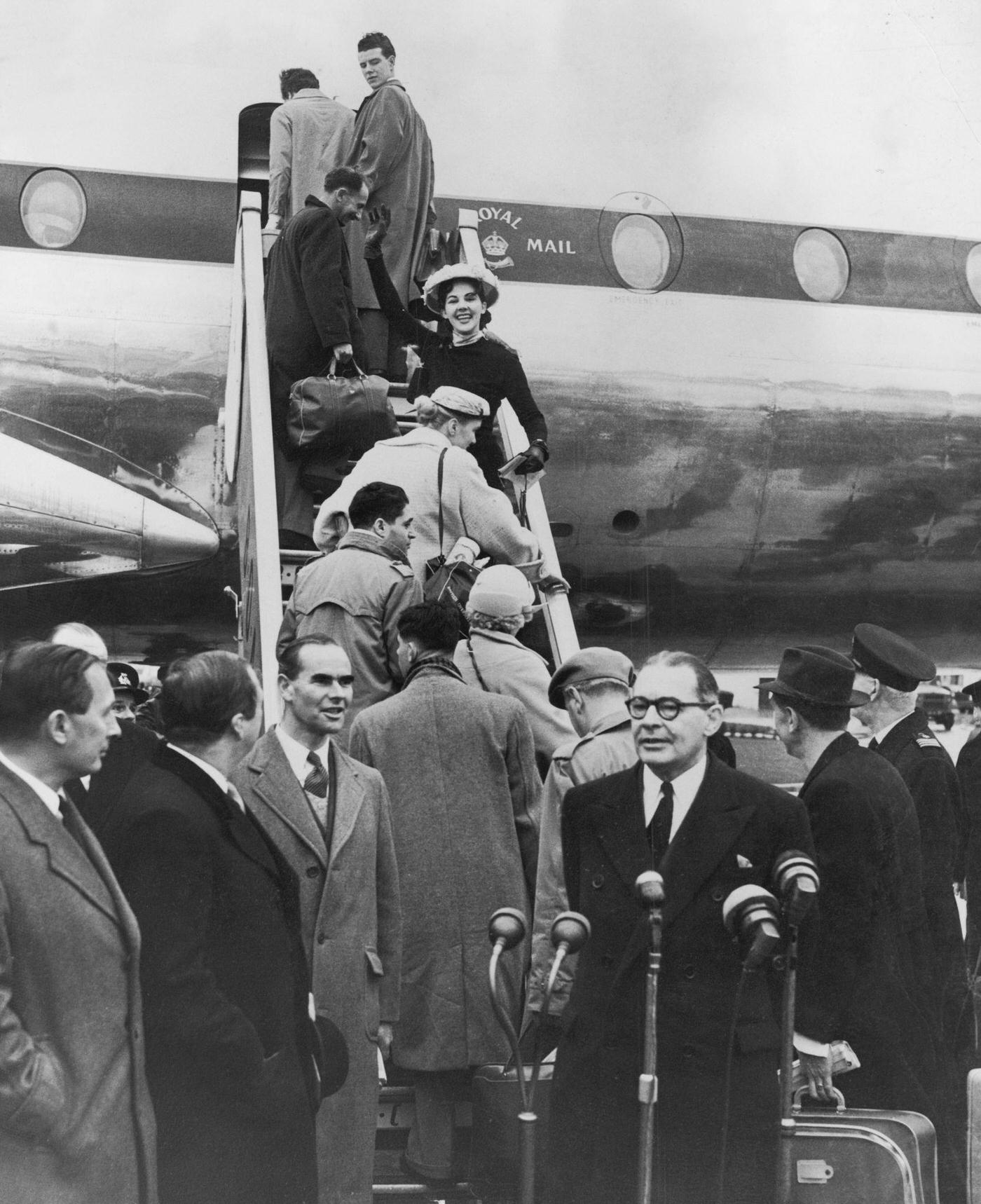
#51 Trainee BOAC cabin crew members simulate being passengers in a replica of a Hermes aircraft during their training near Heston Airport, Middlesex, in 1958.
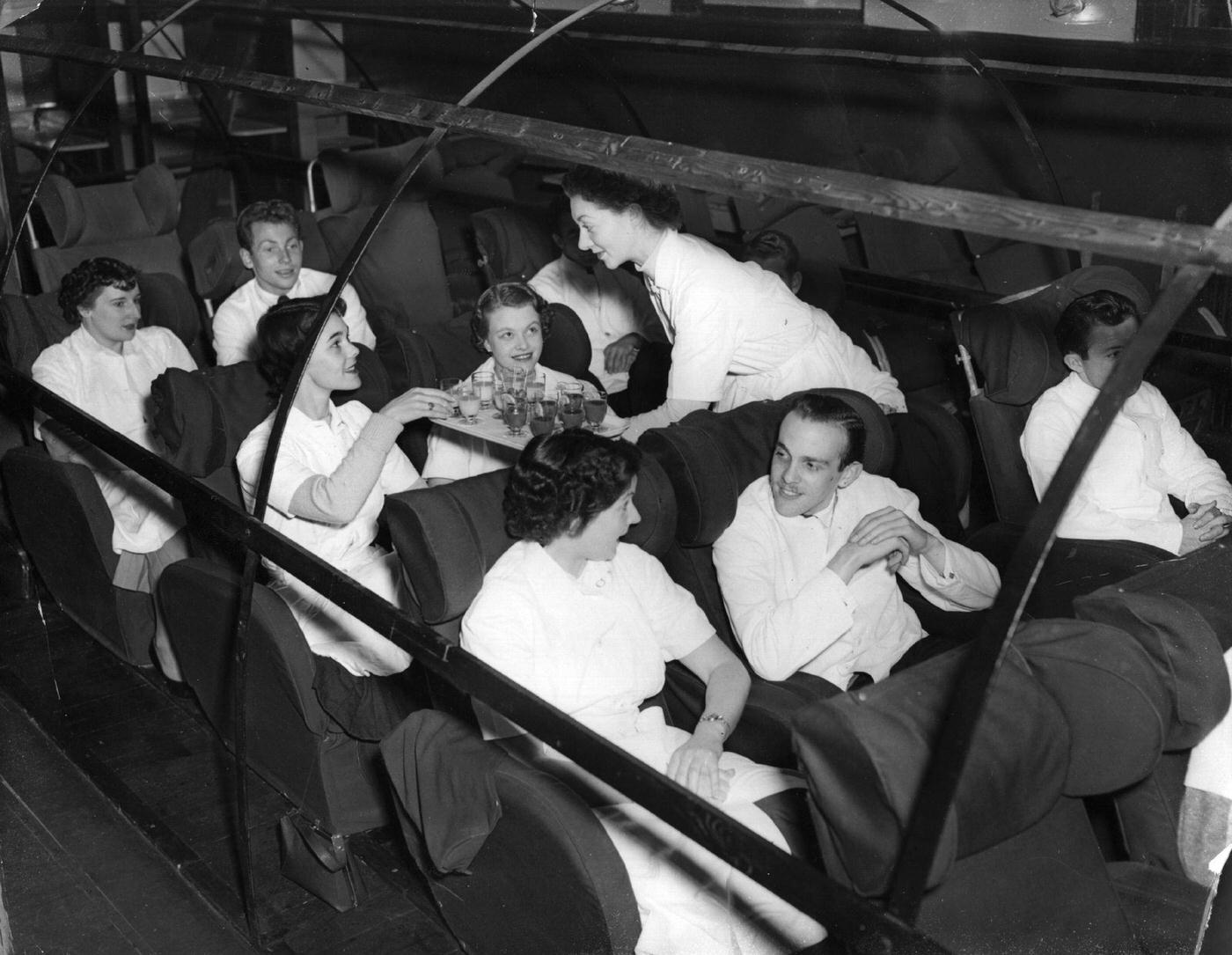
#52 Two air hostesses welcome a passenger boarding a Swiss Air aircraft at London Airport in the 1950s.
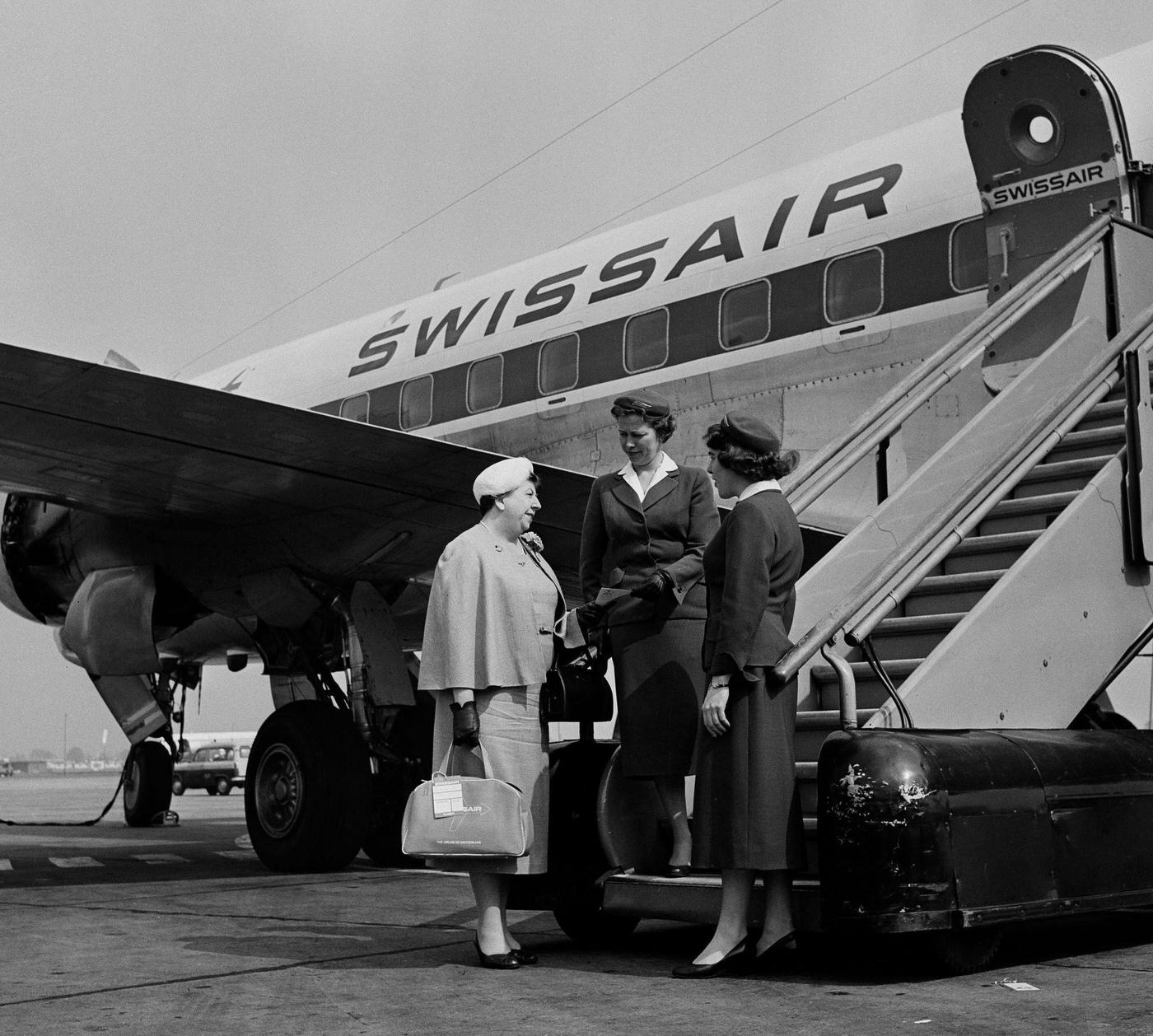
#53 Passengers relax on a flight in 1950.
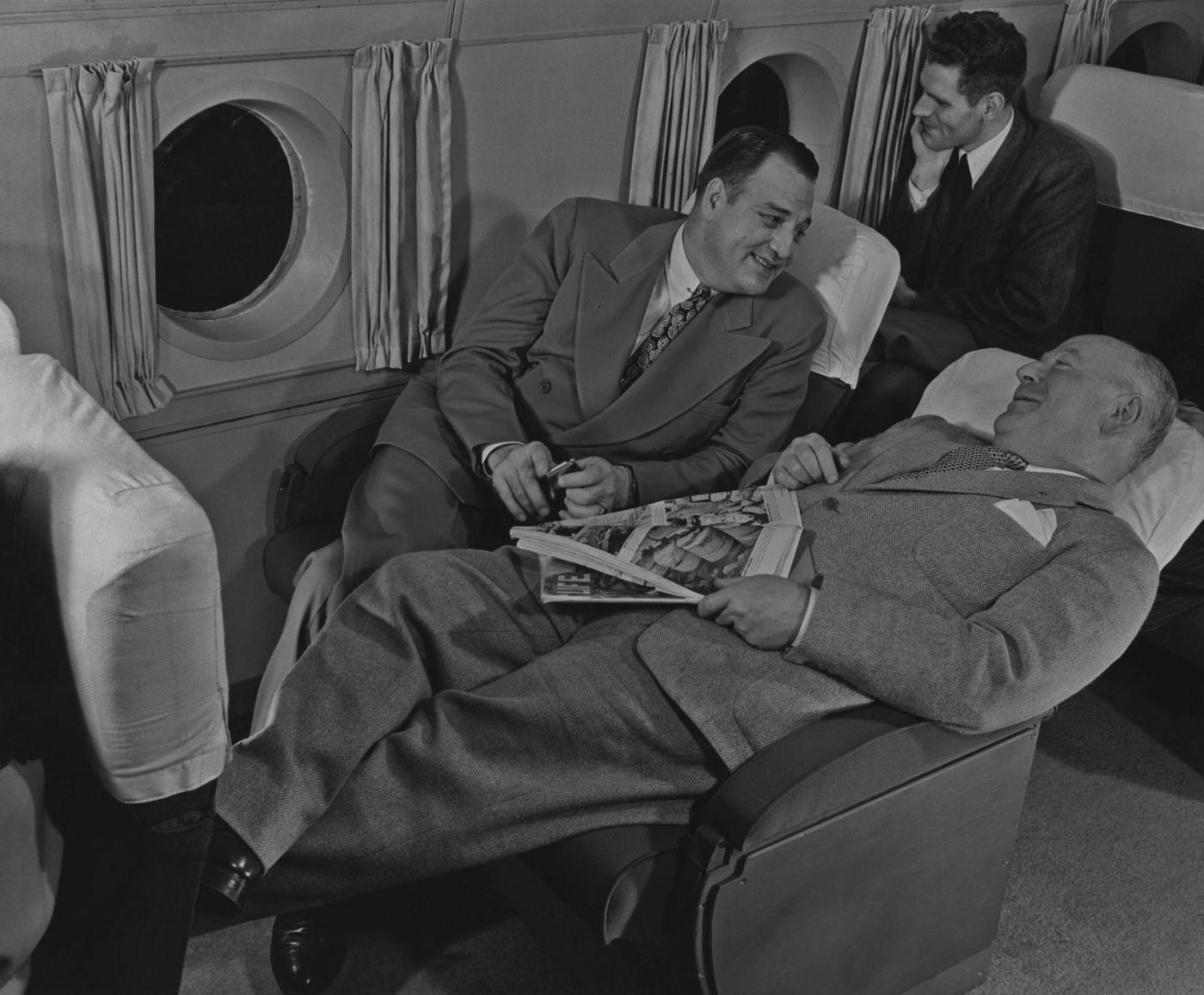
#54 The flight crew reviews the passenger list of a British West Indian Airlines plane at Piarco International Airport in Piarco, Trinidad, British West Indies, in 1952.
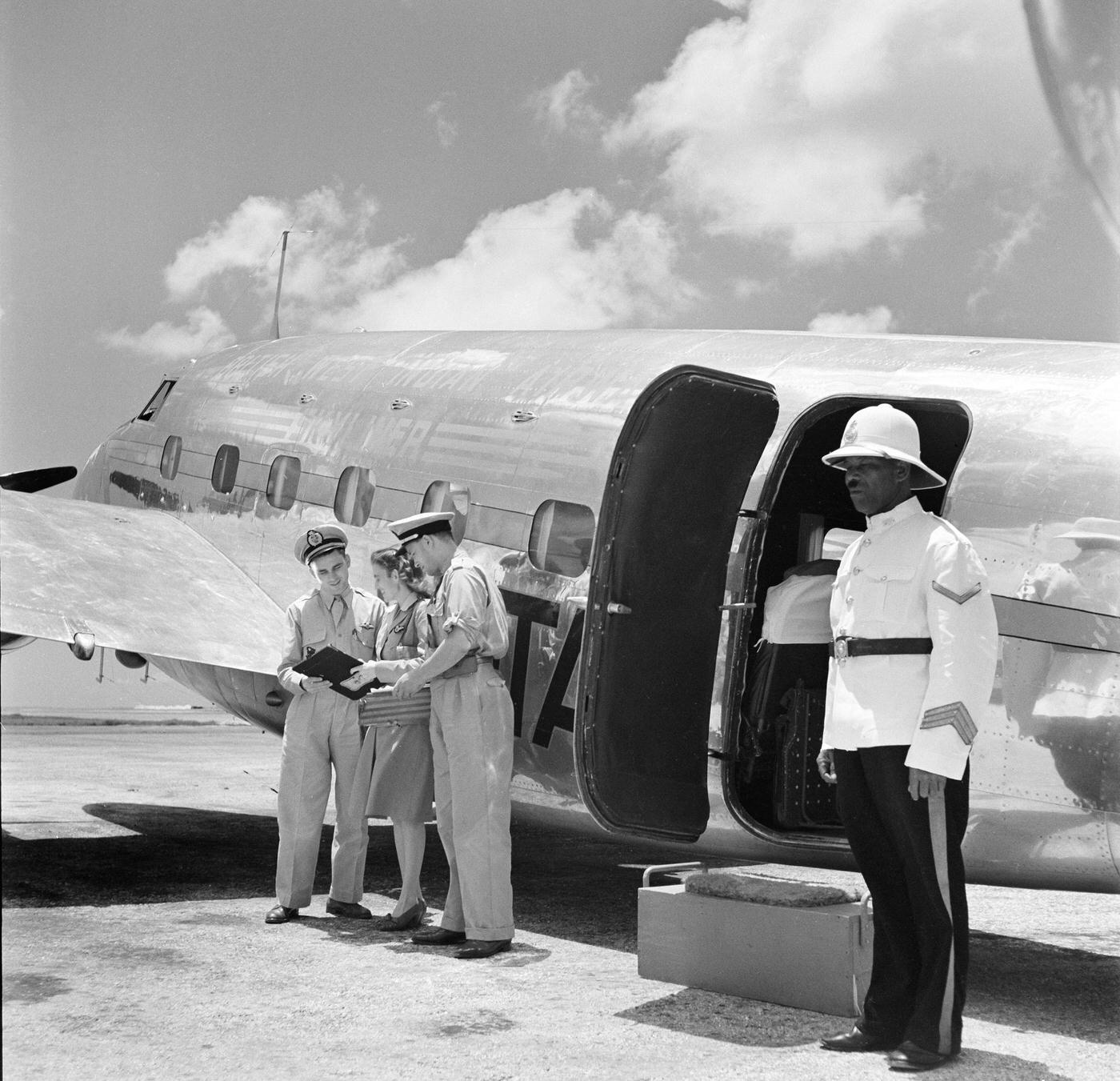
#55 A Panagraoperated passenger plane takes off from Cochabamba, Bolivia in 1955.
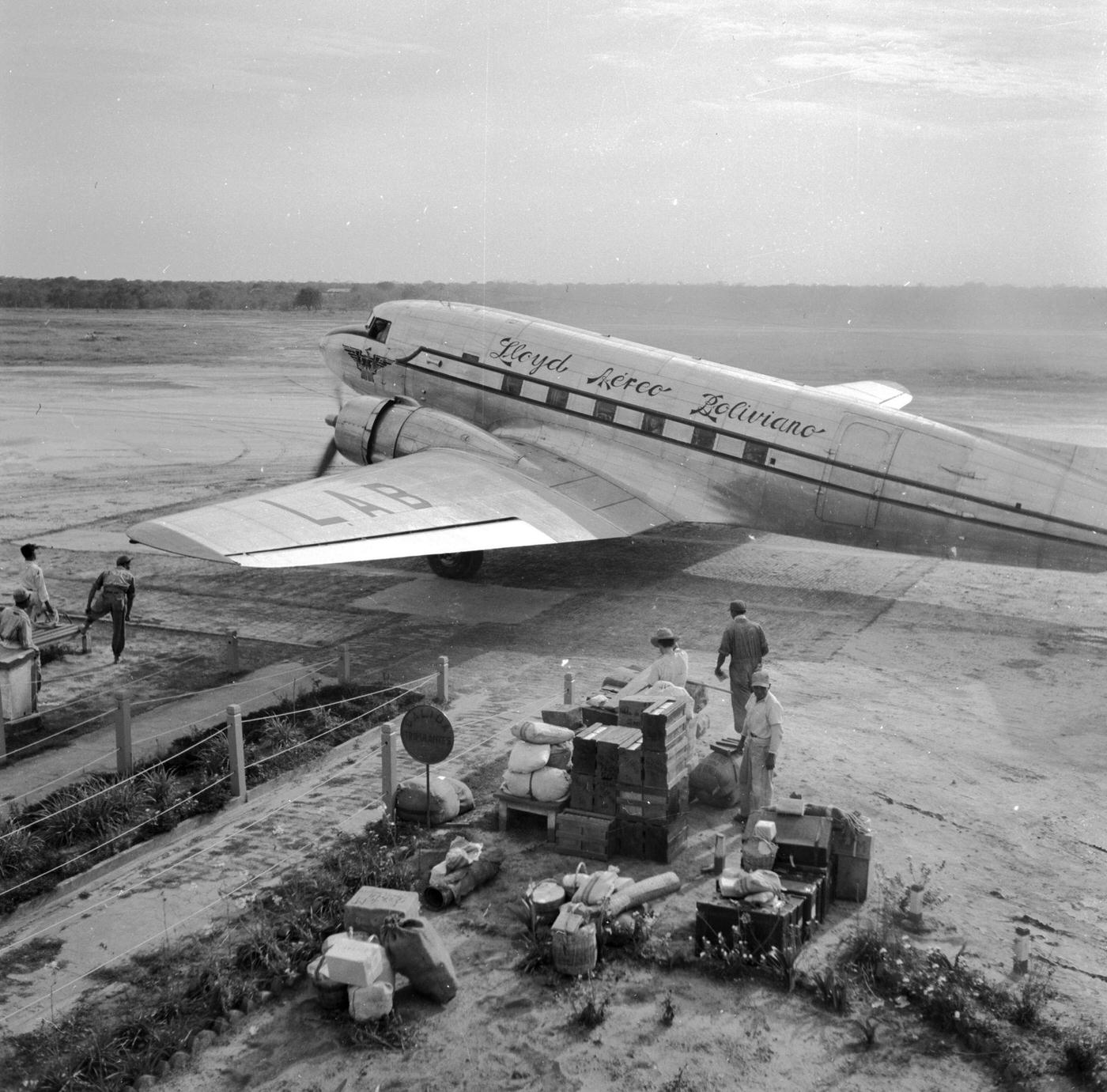
#56 Tourists raise Mexican sombreros before boarding a Canadian Pacific jet in Mexico in 1950.
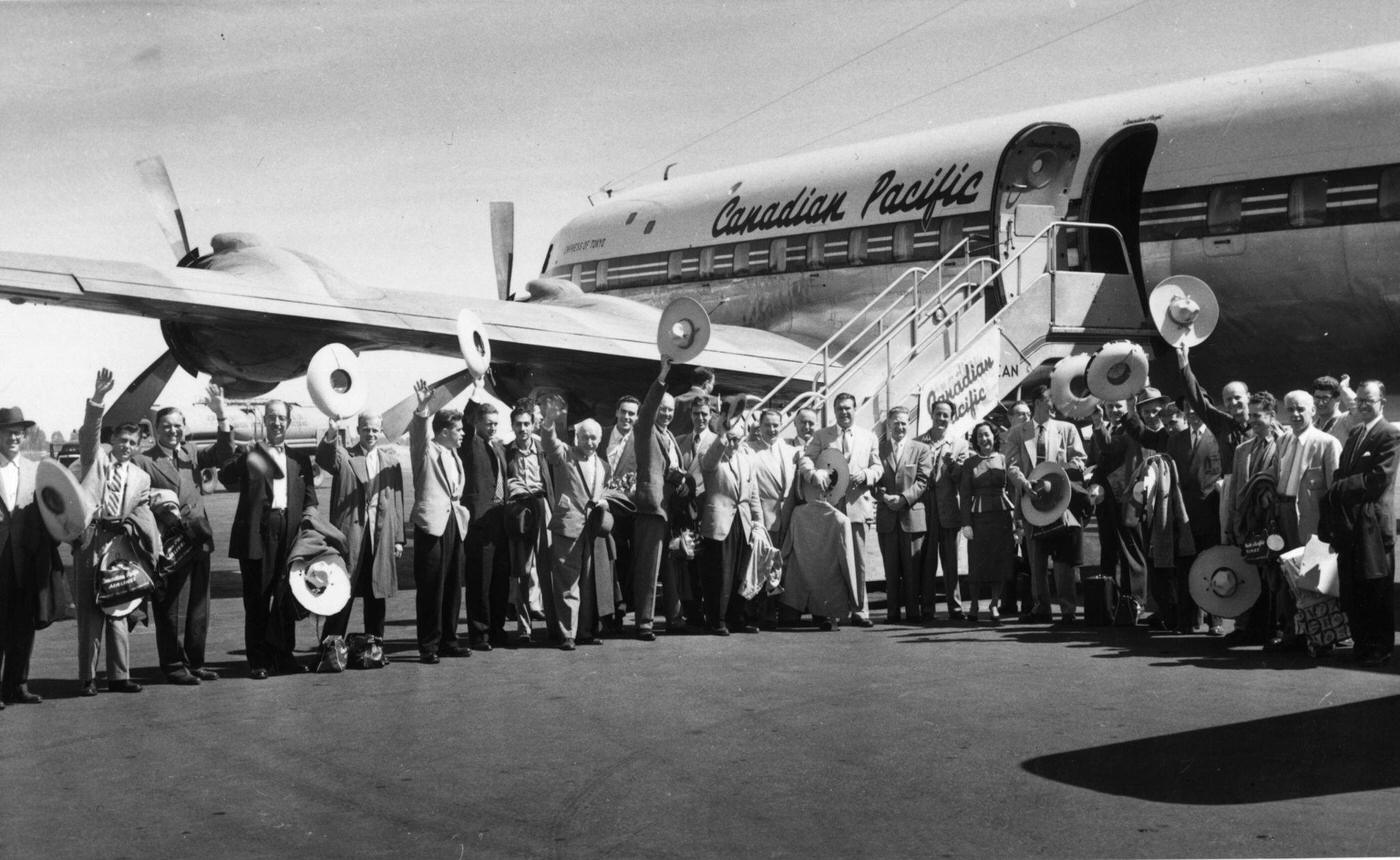
#57 Arthur Parkes, a television engineer, proves that aircraft can receive television transmissions up to a height of 12,000 feet, confounding the British Broadcasting Corporation in 1955.
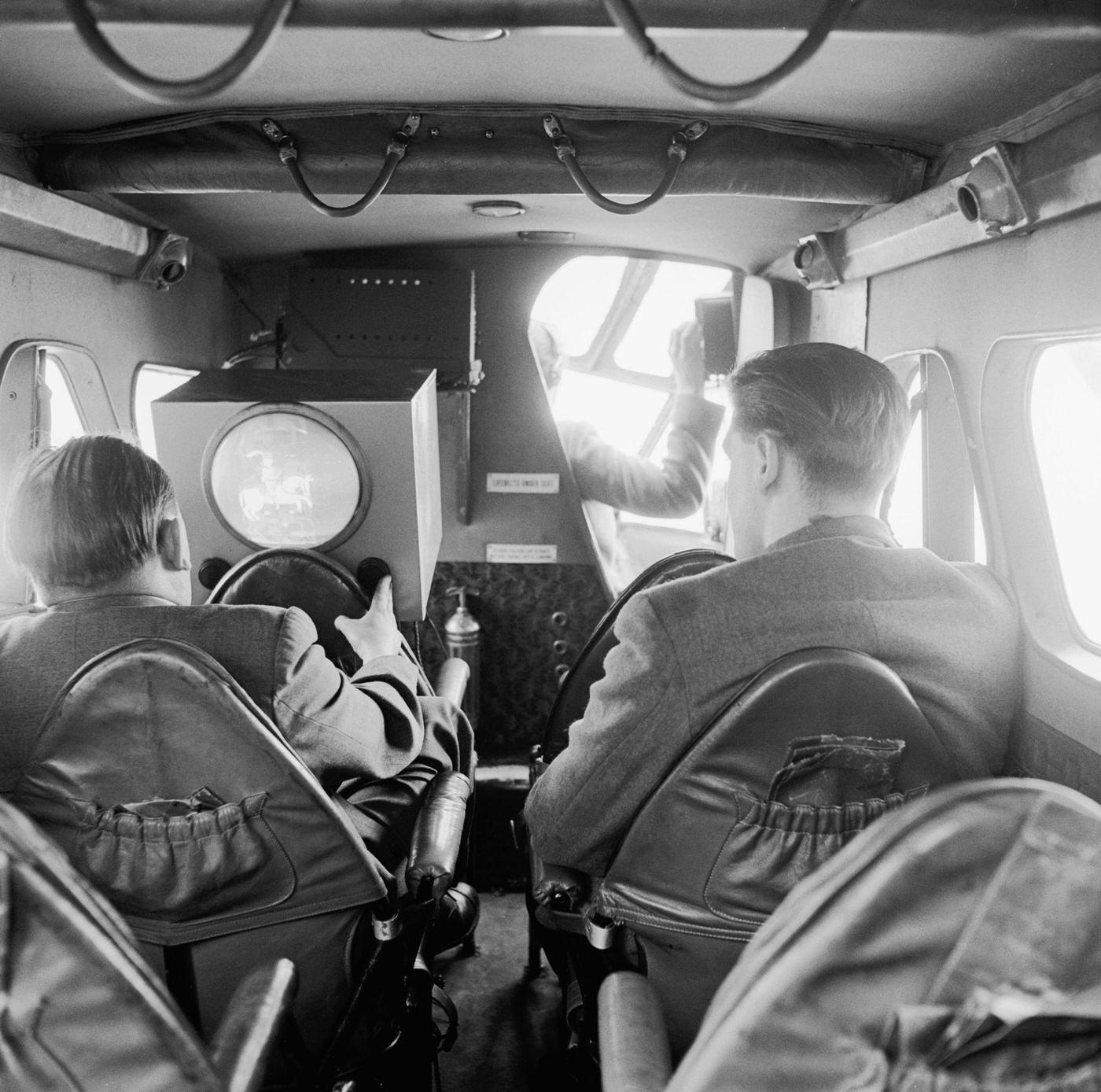
#58 A Concorde fuselage test is conducted on May 17th, 1954.
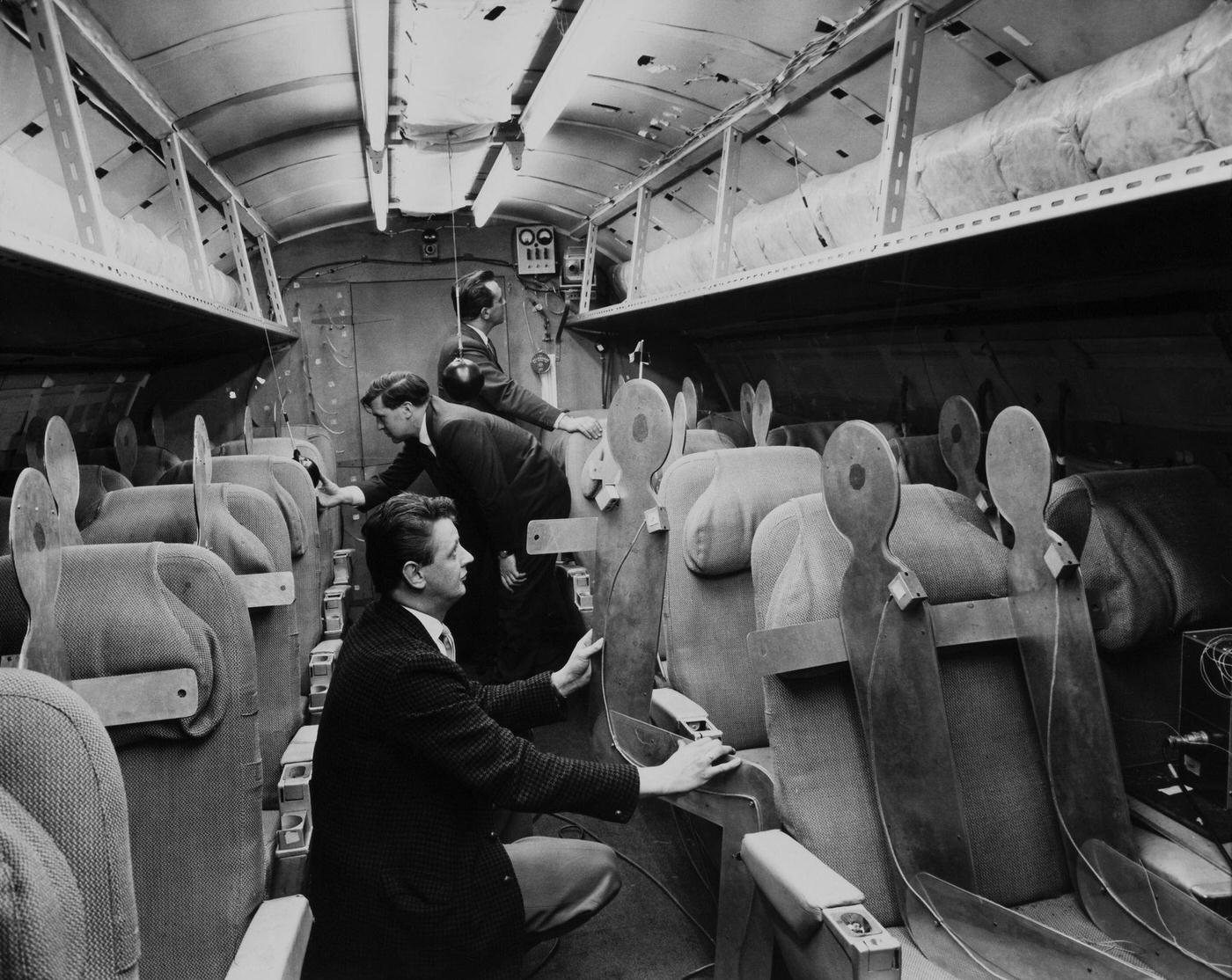
#59 A female soldier knits while traveling to a military base on a plane, as seen in a Cosmopolitan magazine photo.
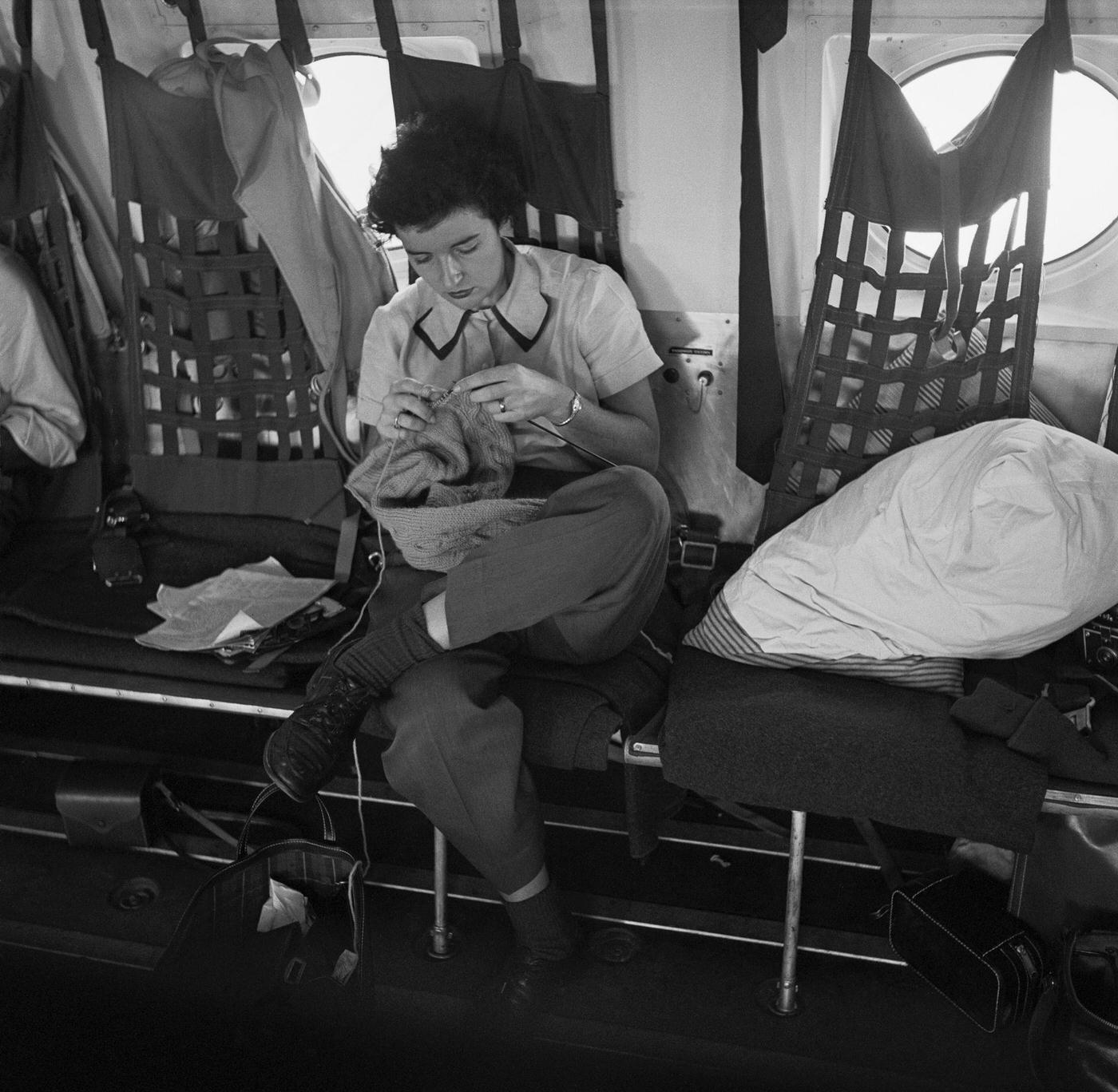
#60 A Comet airplane is pictured in 1950.
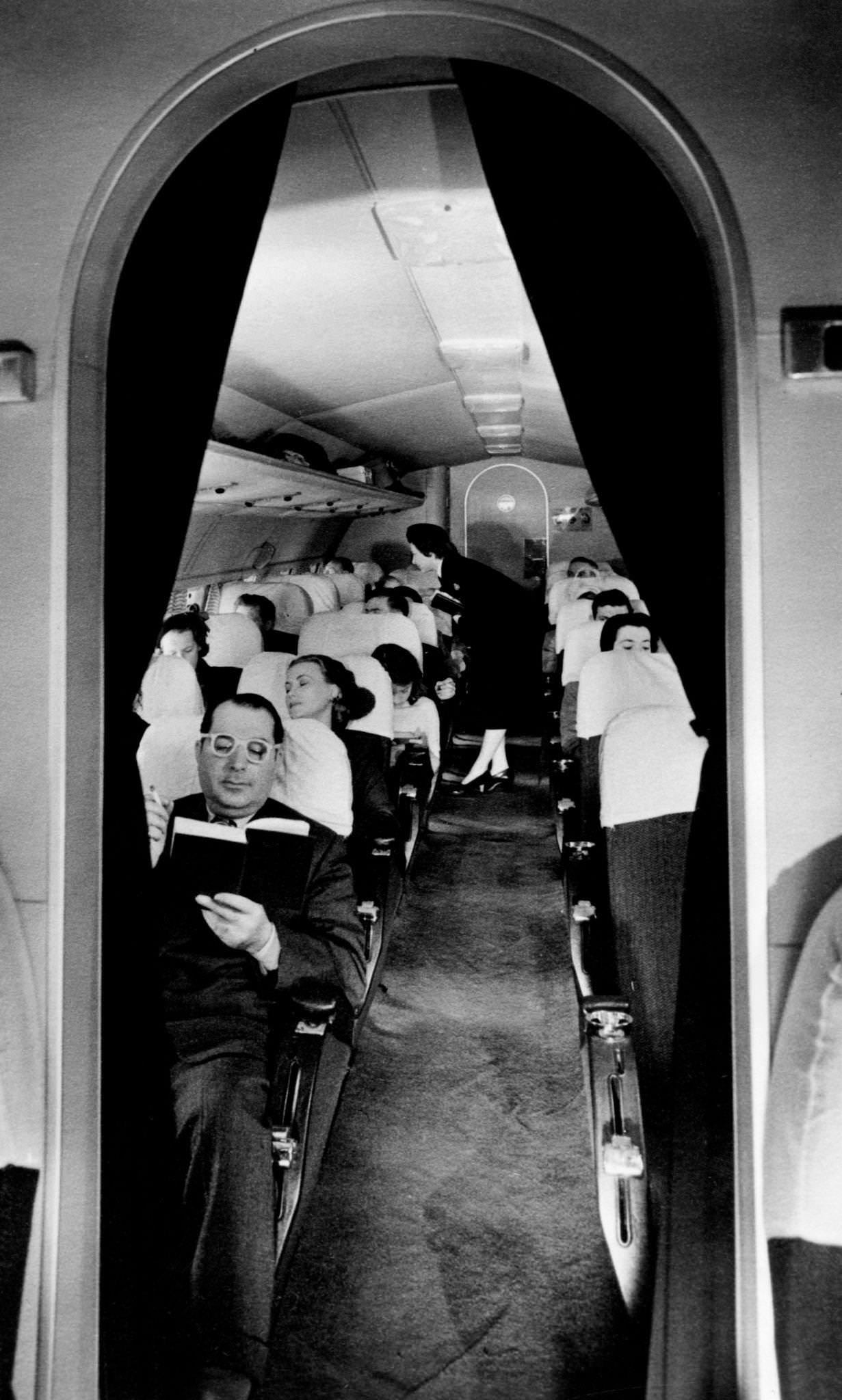
#61 A PAA Atlantic Division stewardess serves breakfast in bed to a female passenger during a transatlantic flight in 1952.
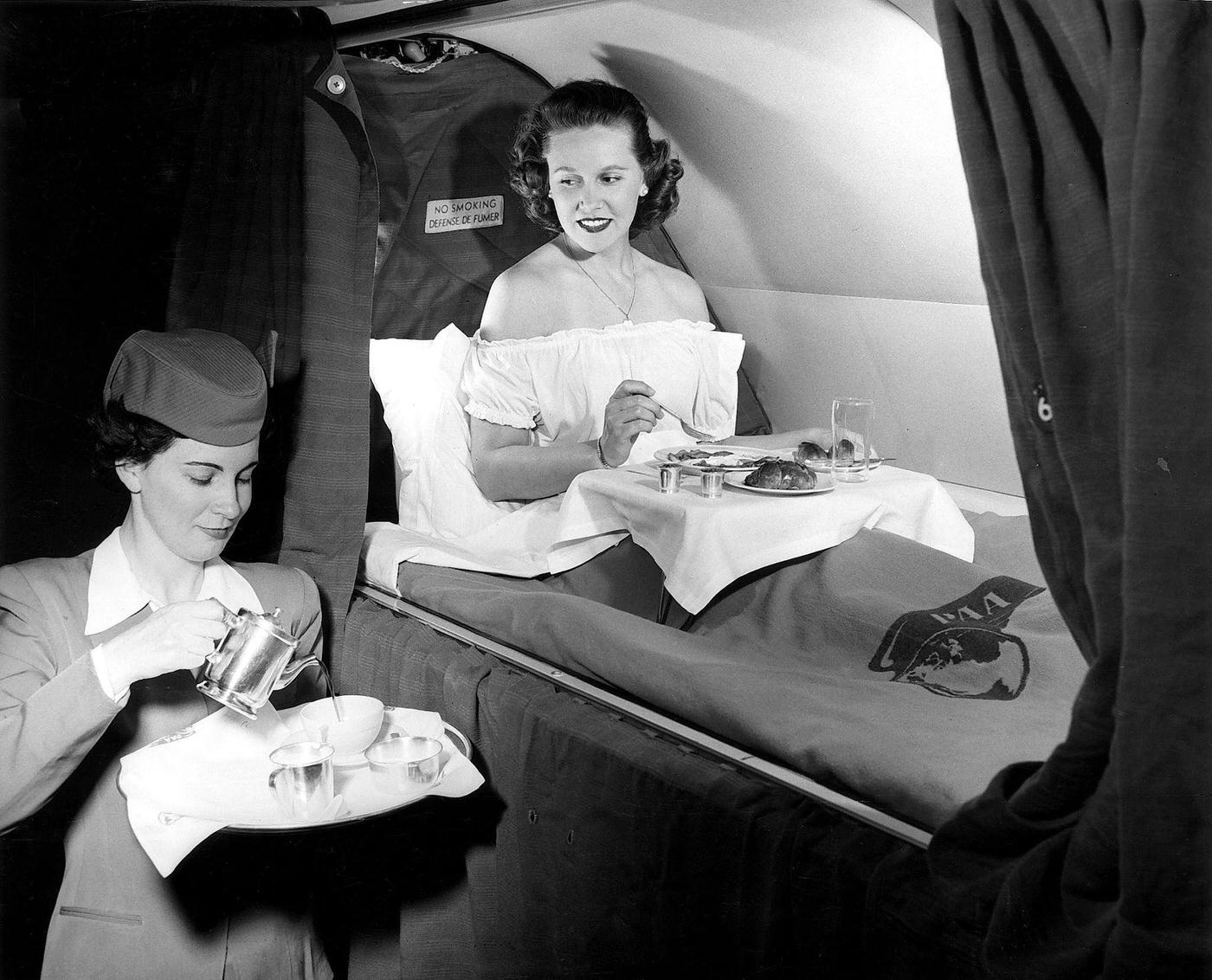
#62 A TWA pilot and stewardess greet passengers disembarking from a plane in the 1950s.
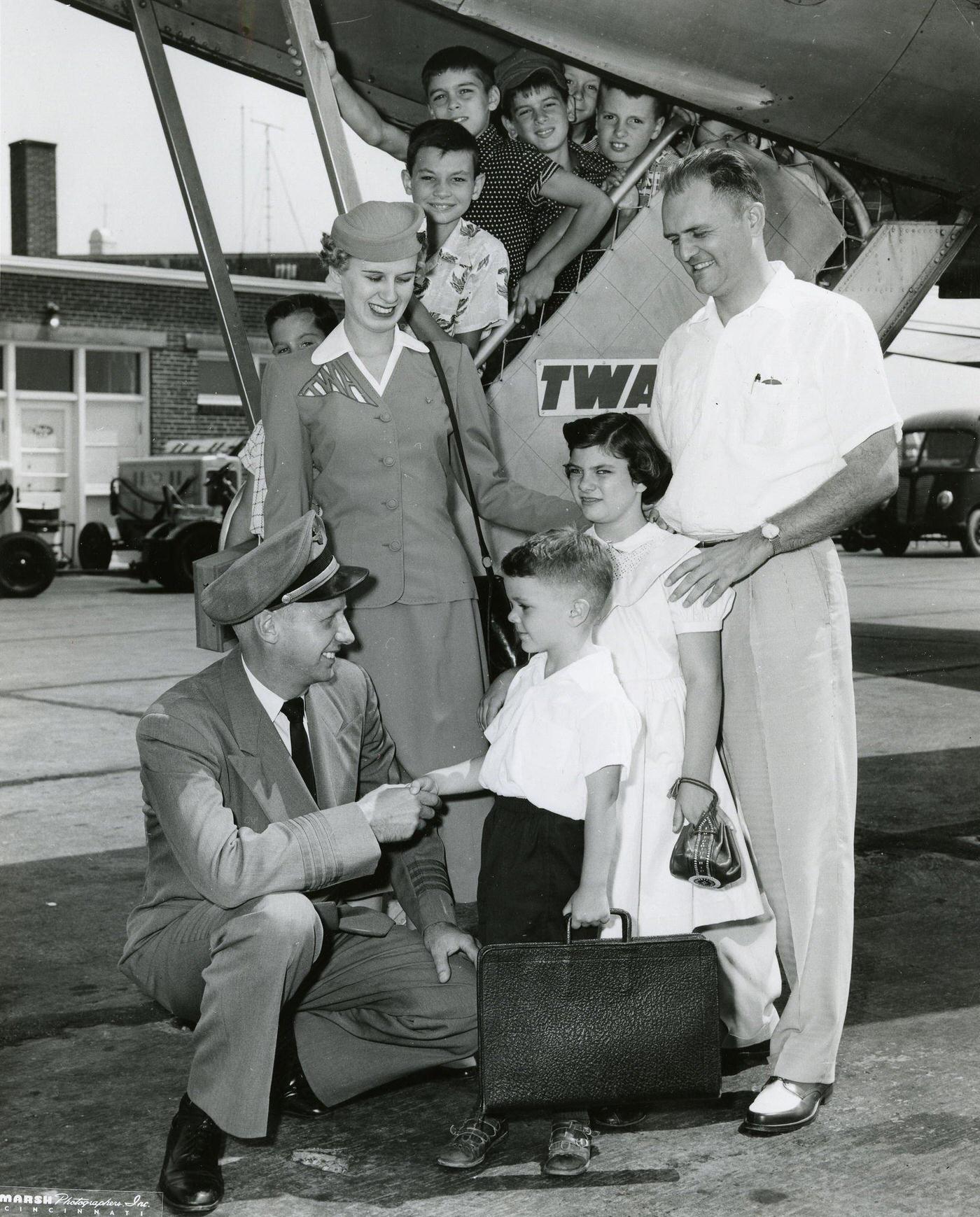
#63 Passengers and a stewardess are pictured aboard a TU114 airliner, which was the world’s largest at the time, in 1959.
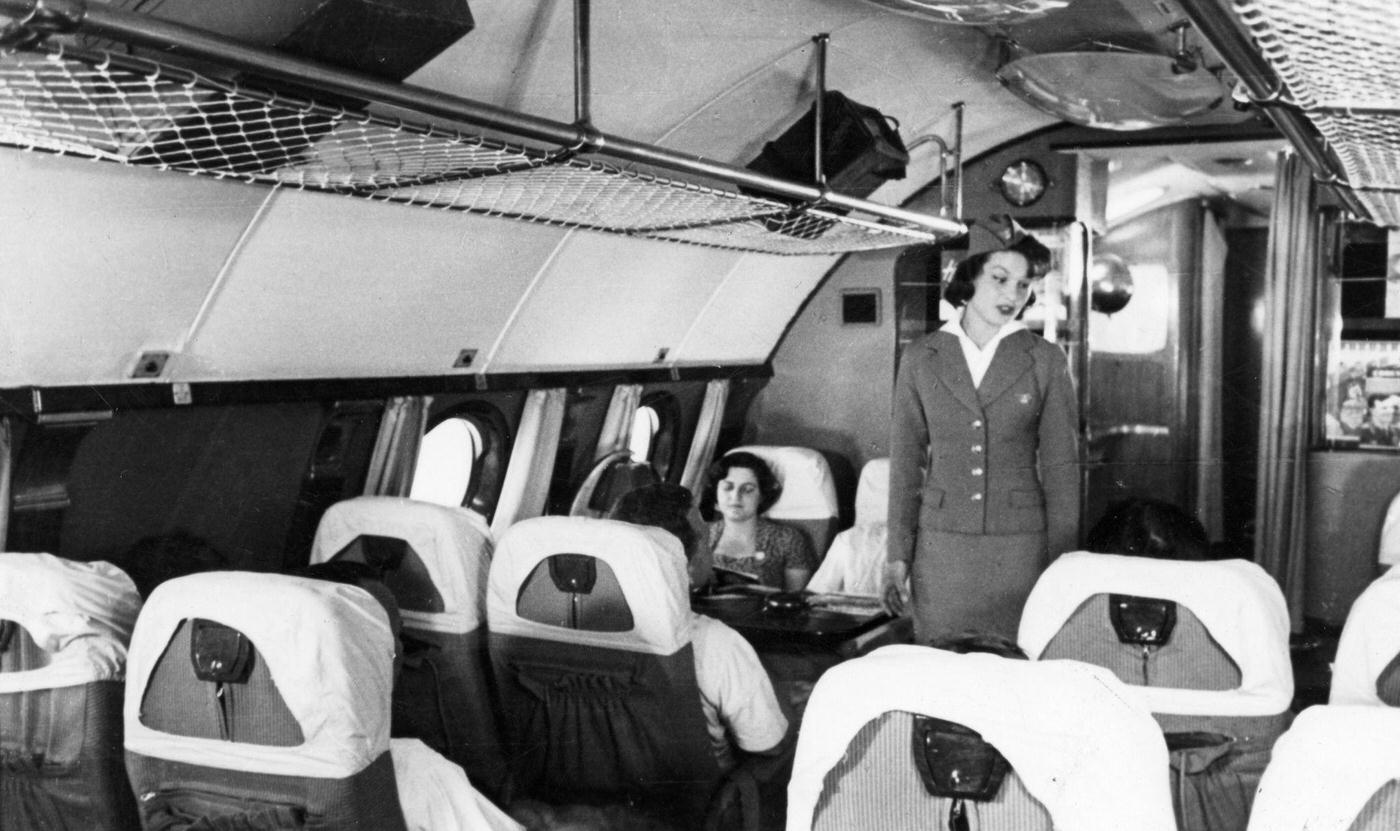
#64 A couple is seen aboard a British Overseas Airways Corporation plane in 1958.
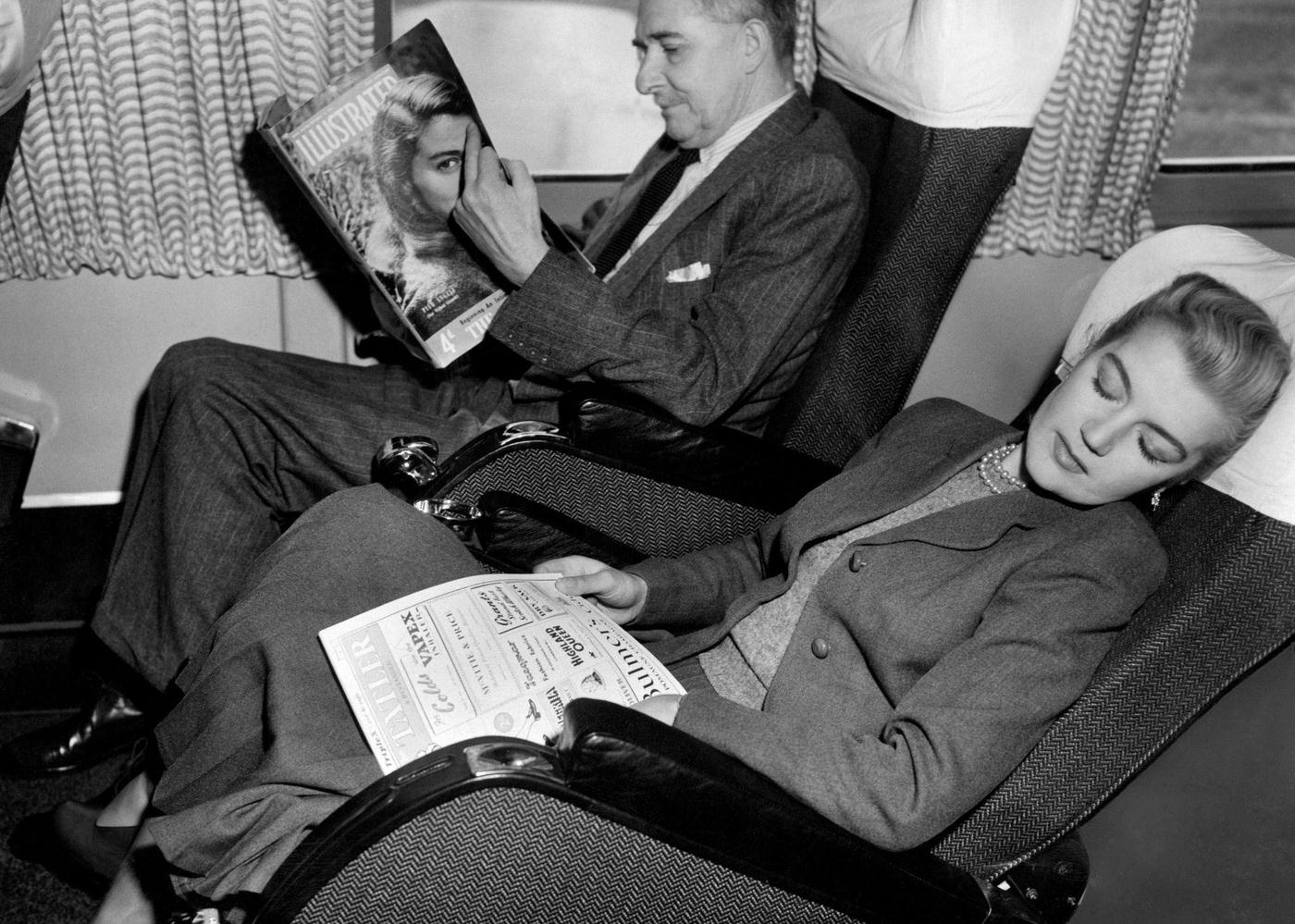
#65 A BOAC airline stewardess serves breakfast in bed to a passenger on a BOAC Speedbird Stratocruiser in 1952.
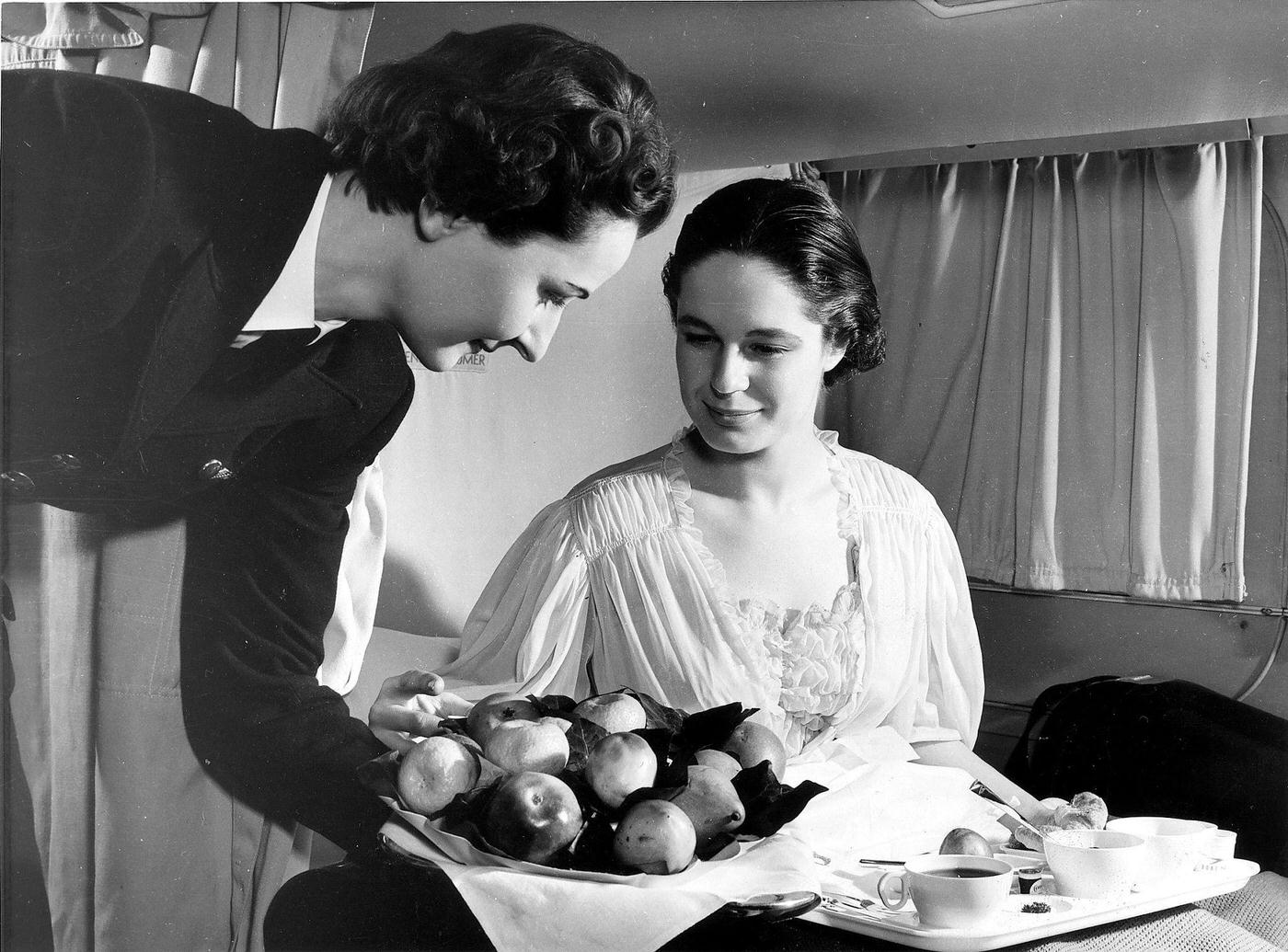
#66 A Bristol Superfreighter aircraft carries cars on crossChannel flights operated by Silver City Airways from their own airport in Ferryfield near the town of Lydd in 1955.
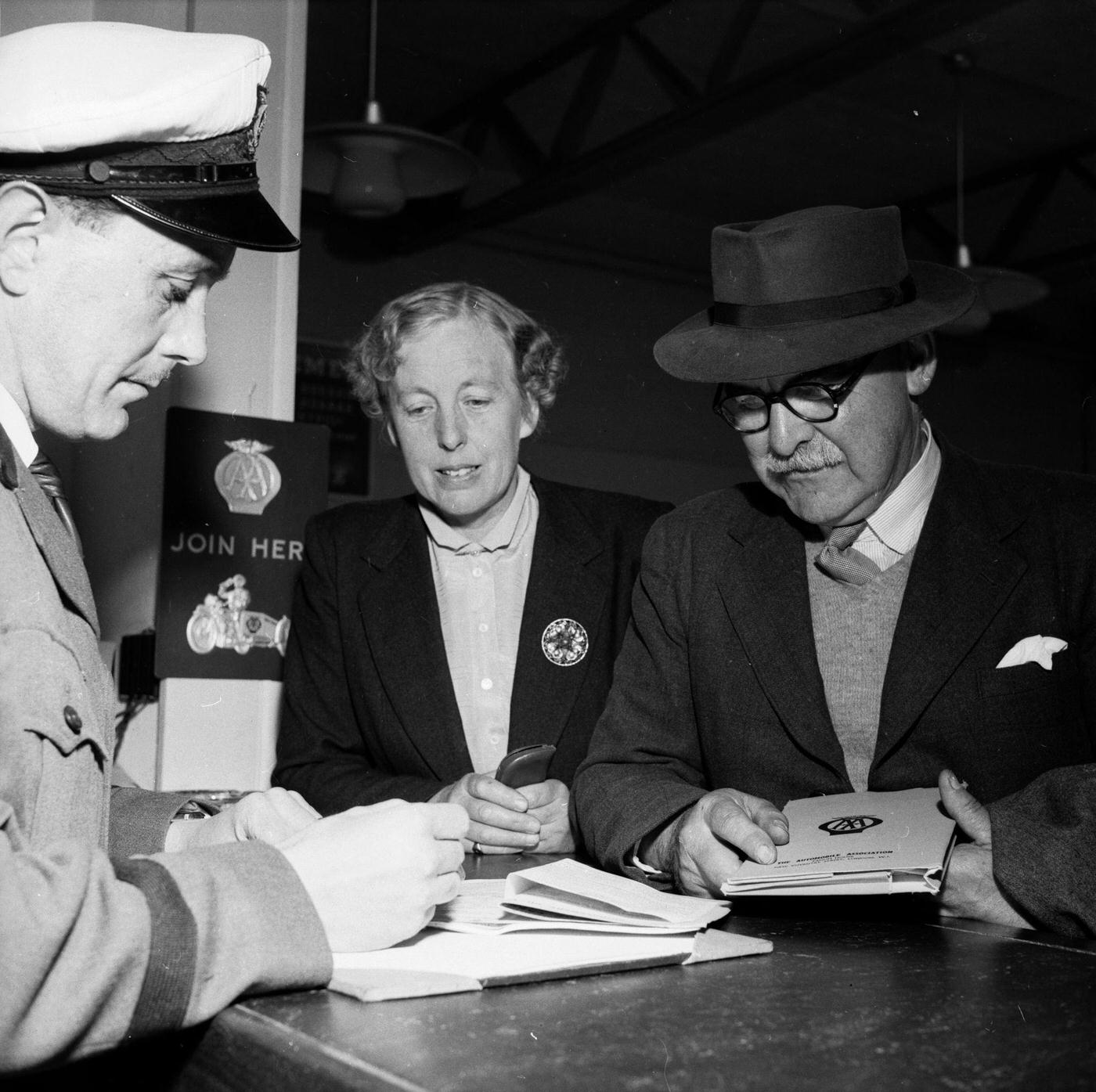
#67 Air hostesses are captured serving passengers on a plane in 1955.
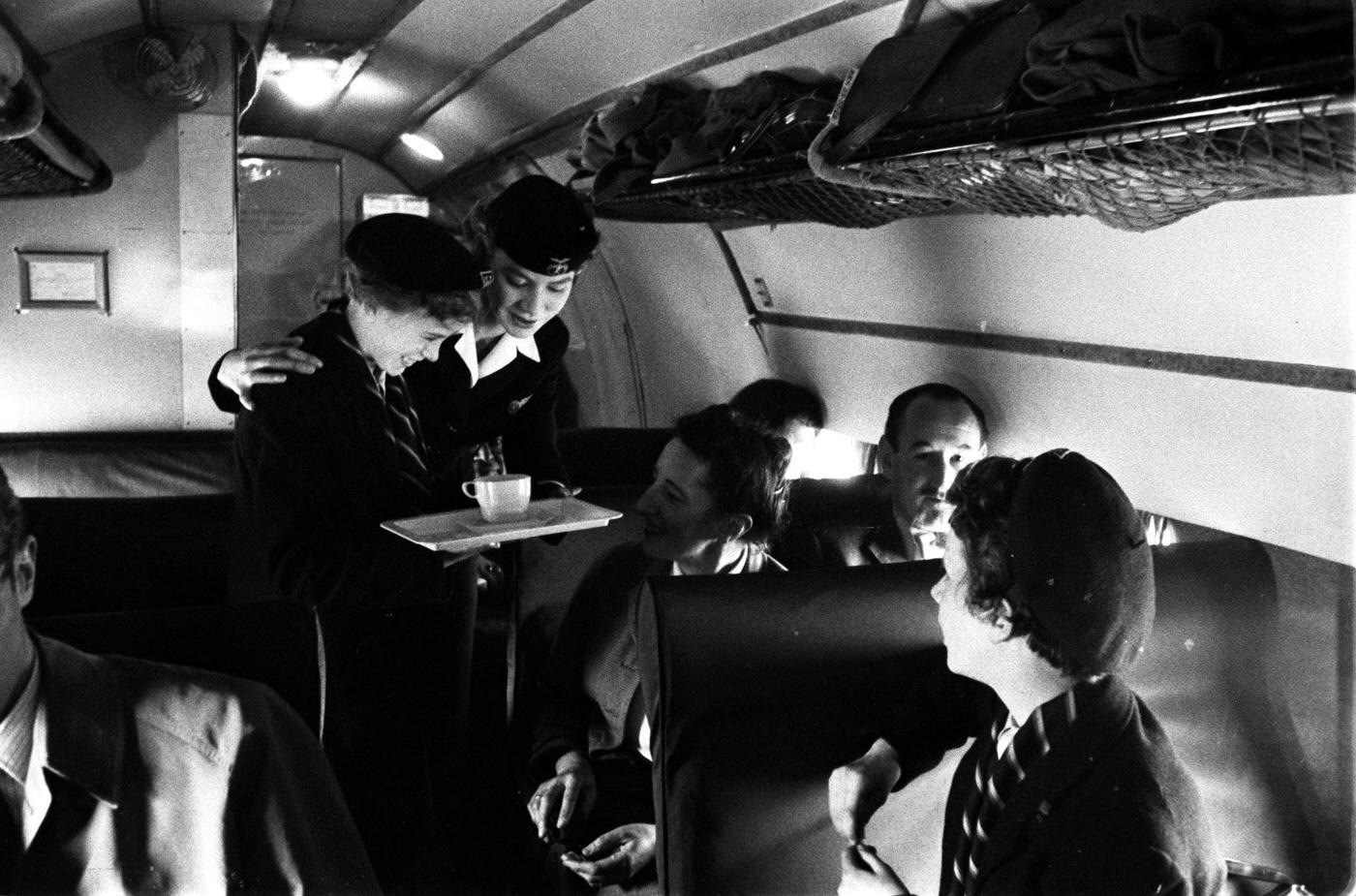
#68 Air hostess Irene Mallory is seen serving food to passengers on her trolley in 1955.
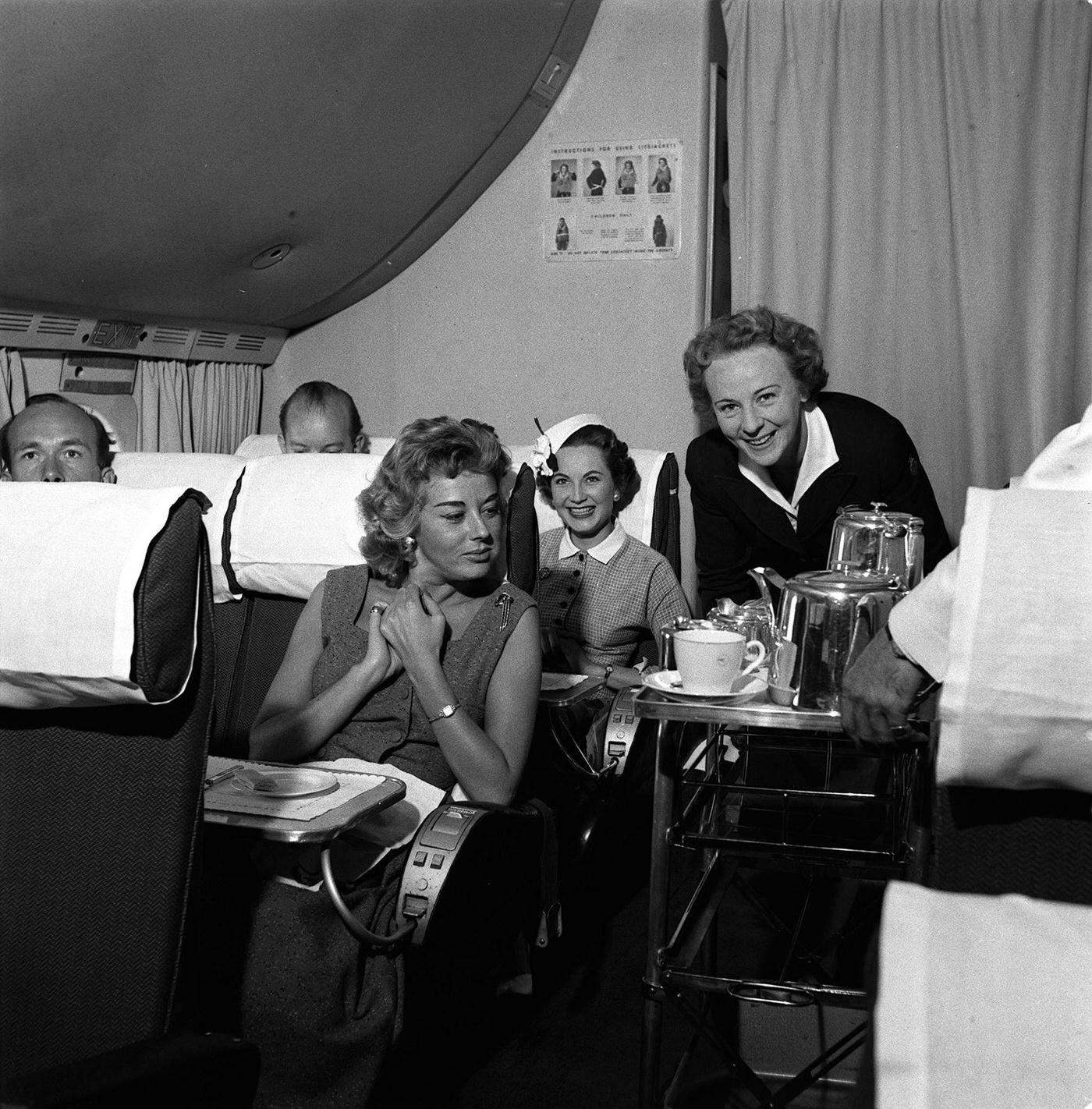
#69 Passengers are depicted on a transSiberian flight on board a TU104 airliner in July 1956.
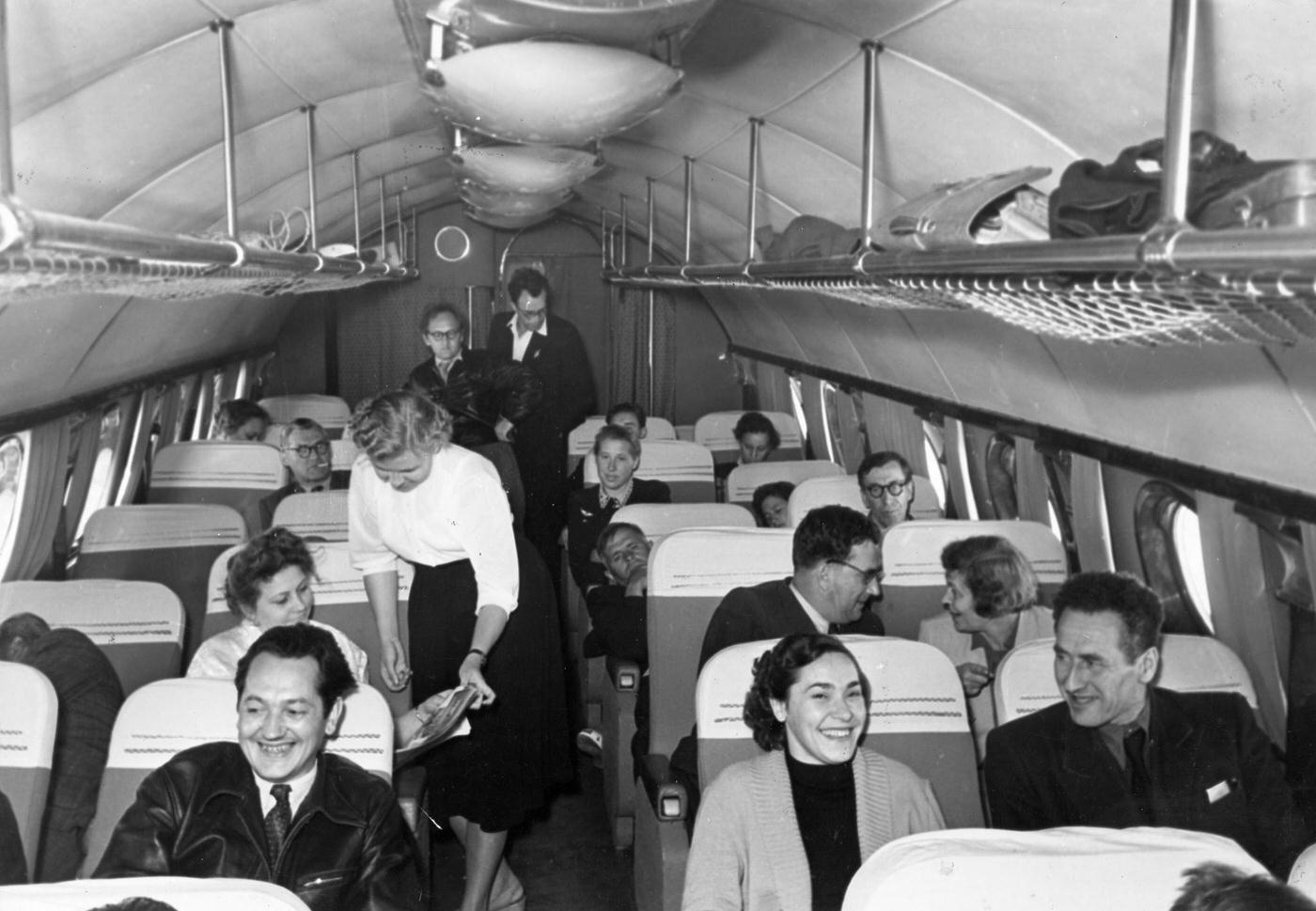
#70 A secretary from KLM is captured doing dictation on board a KLM passenger plane at Frankfurt Airport in January 1955.
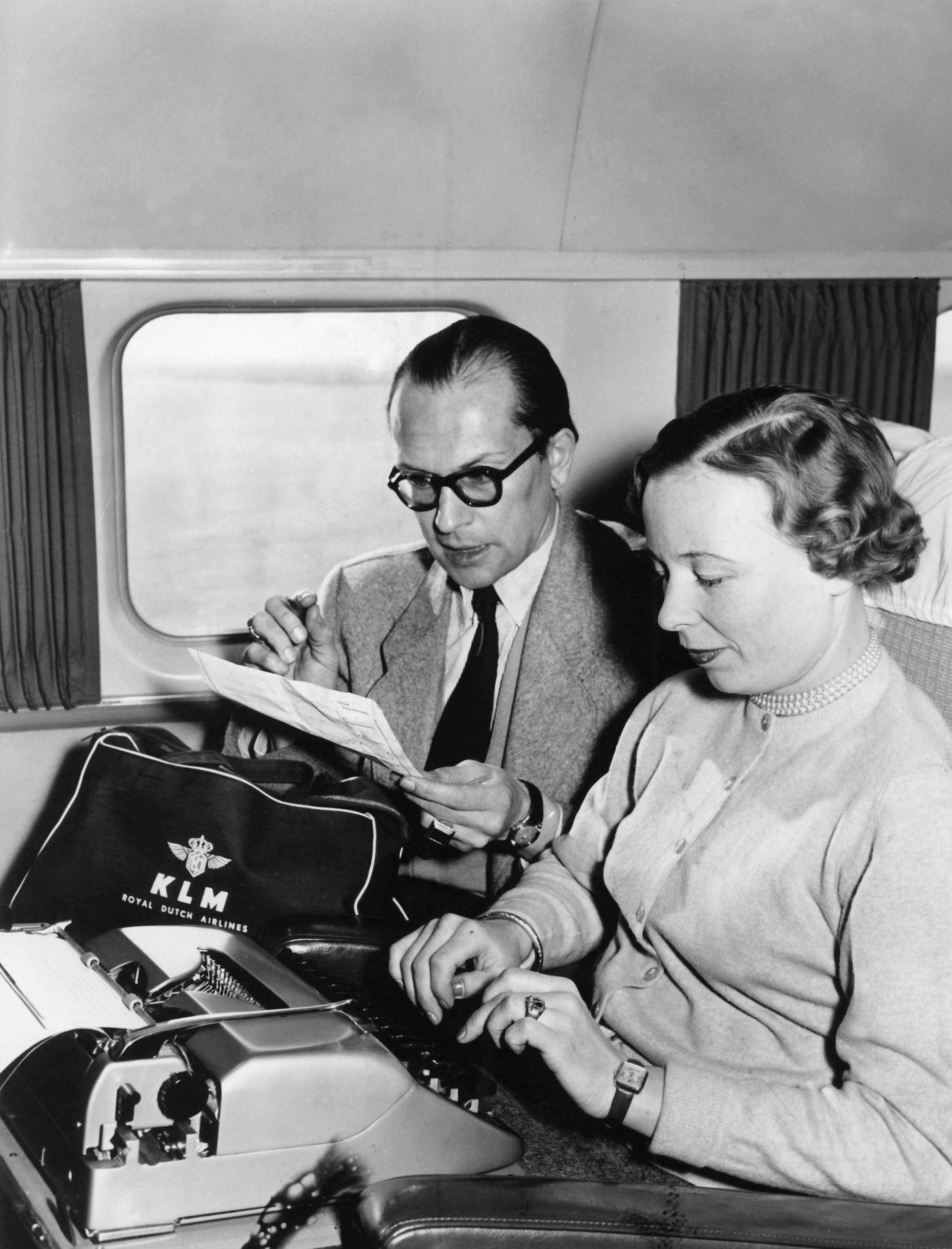
#71 The Basilica of St. Pius is inaugurated in Lourdes, France on March 25, 1958. The underground hall spans 14,000 square meters of concrete beneath the plaza.
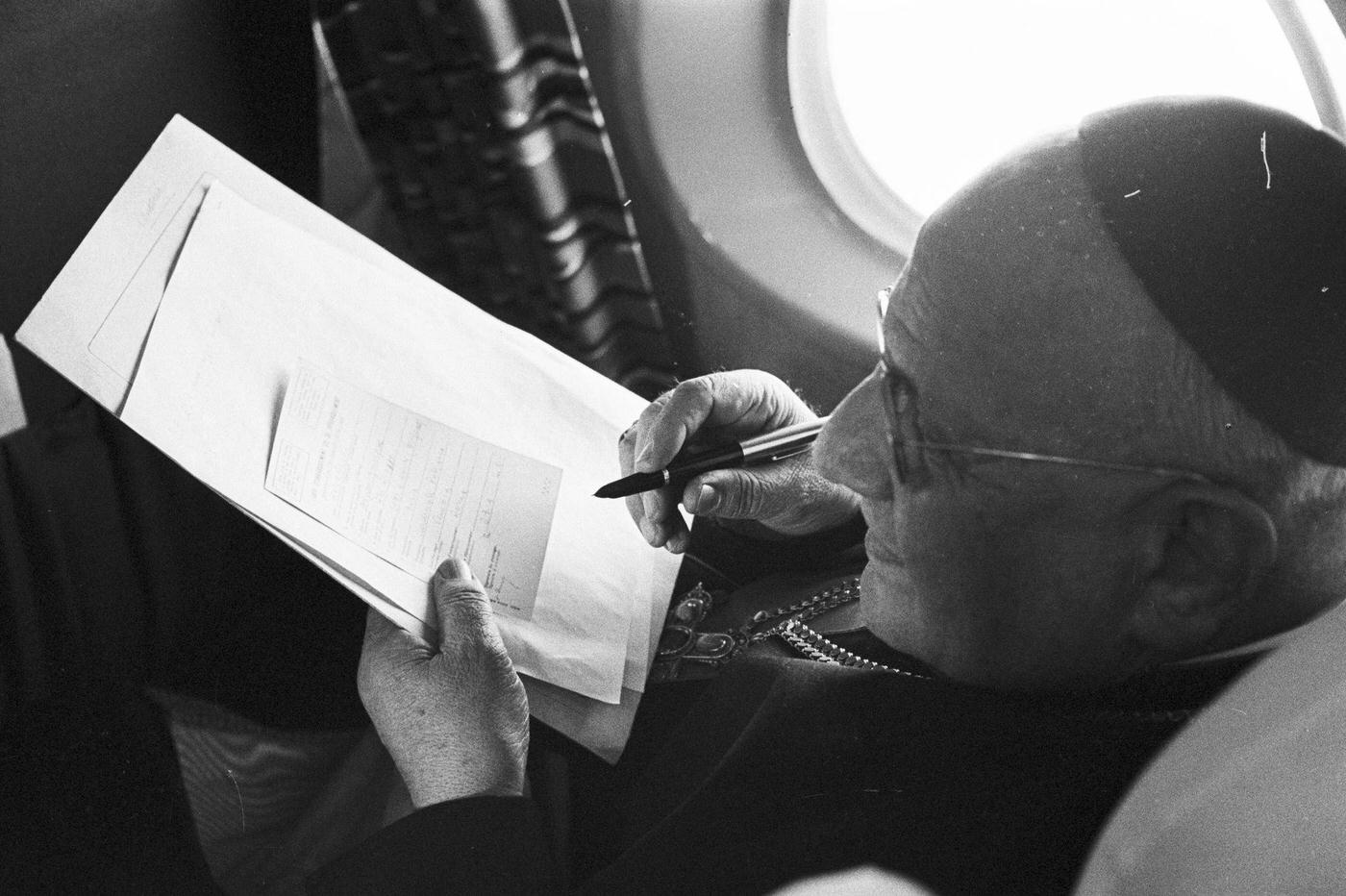
#72 A group of airline stewardesses pose inside the luxurious mockup of the Boeing Jet Stratoliner, which will enter service with airlines worldwide in 1959.
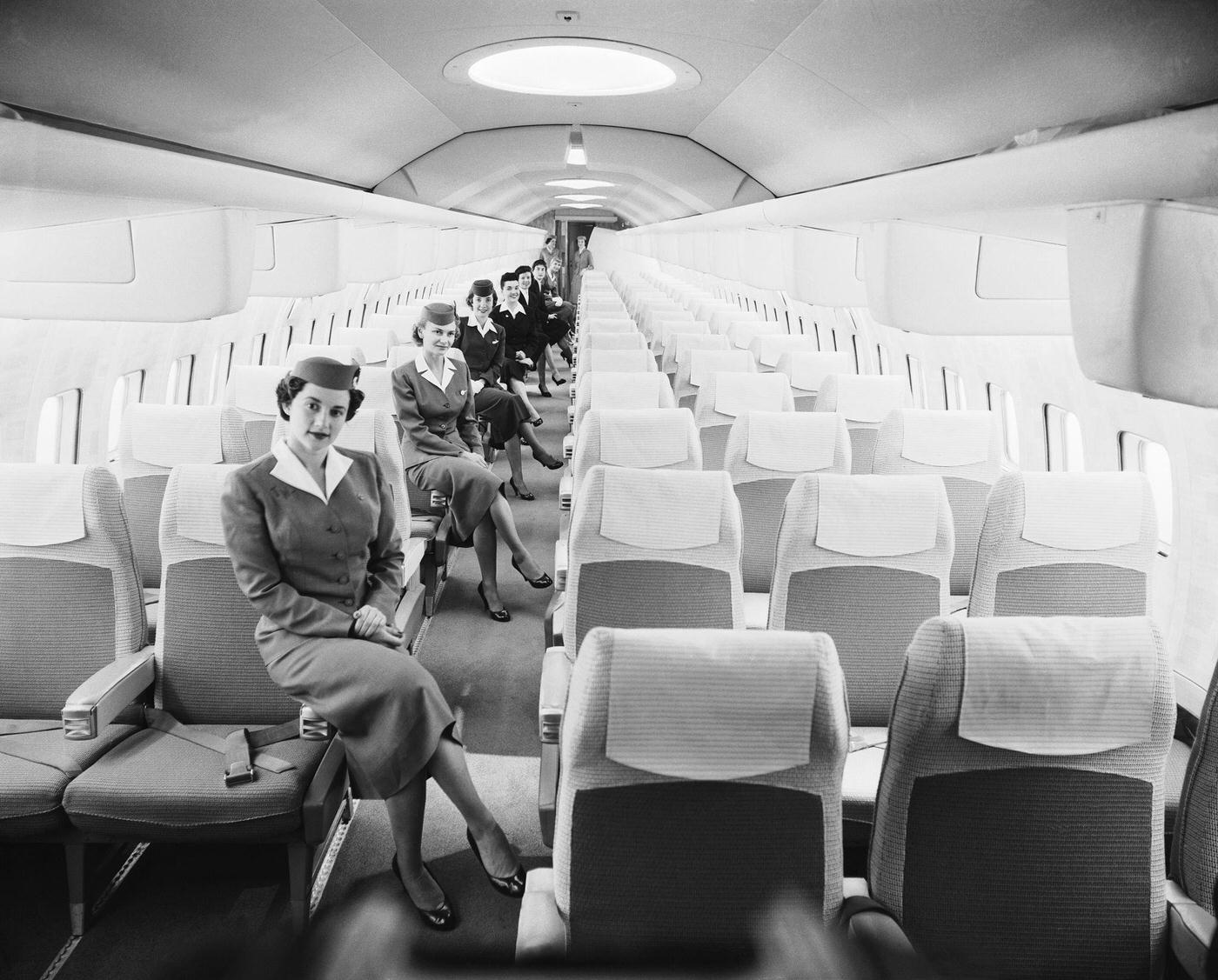
#73 Kentucky Colonel Ward Elmore, who is one of 25 people from the Laguna Honda Home in San Francisco, makes his first plane flight on August 22, 195?, and also celebrates his first 100 years.
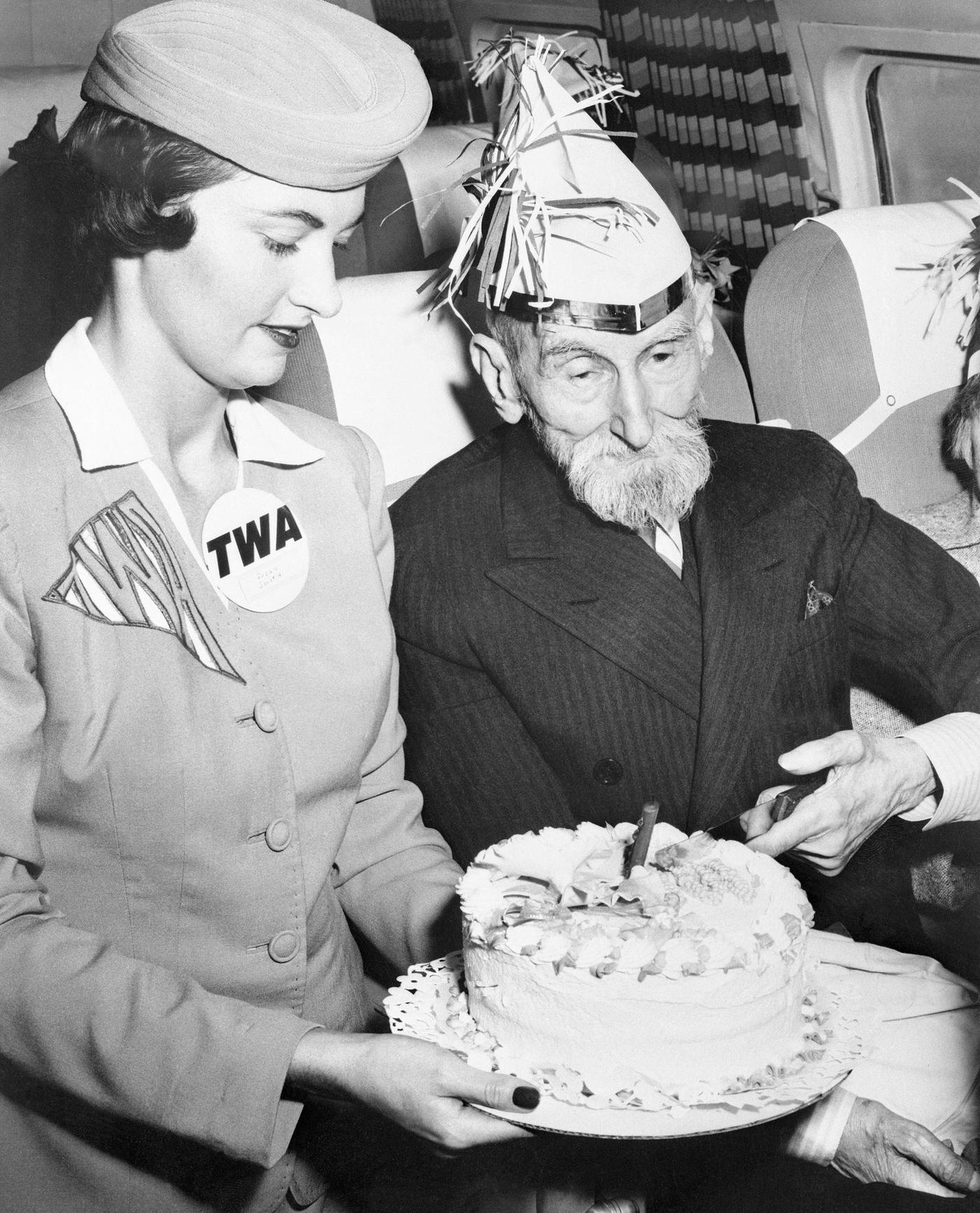
#74 In October 1956, a male air steward prepares a tray of food in the galley for passengers on board a Bristol Britannia medium to long range airliner.
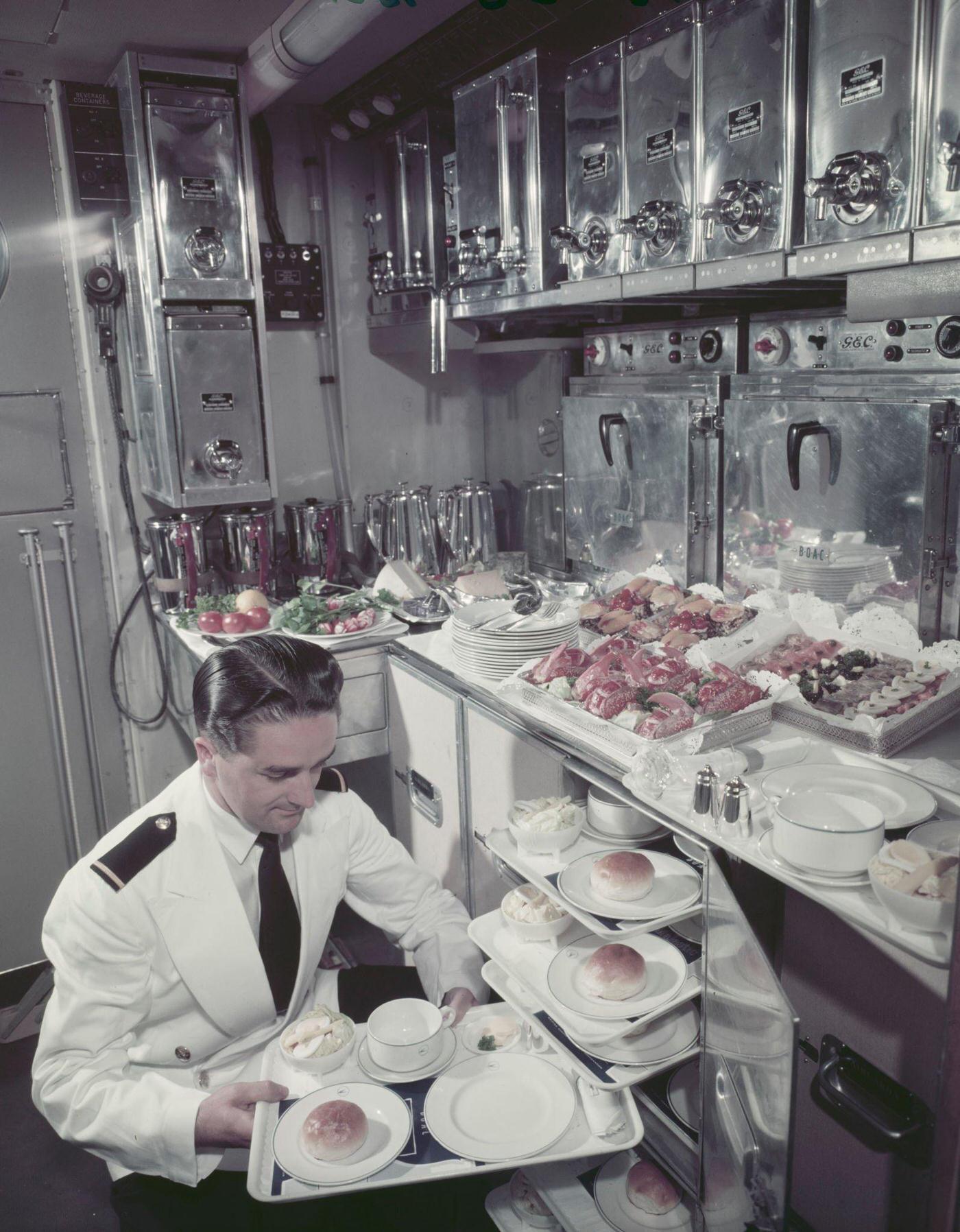
#75 Ginger Rogers, a famous screen actress, and her husband, French actor Jacques Bergerac, arrive at ParisOrly airport after flying from the United States.
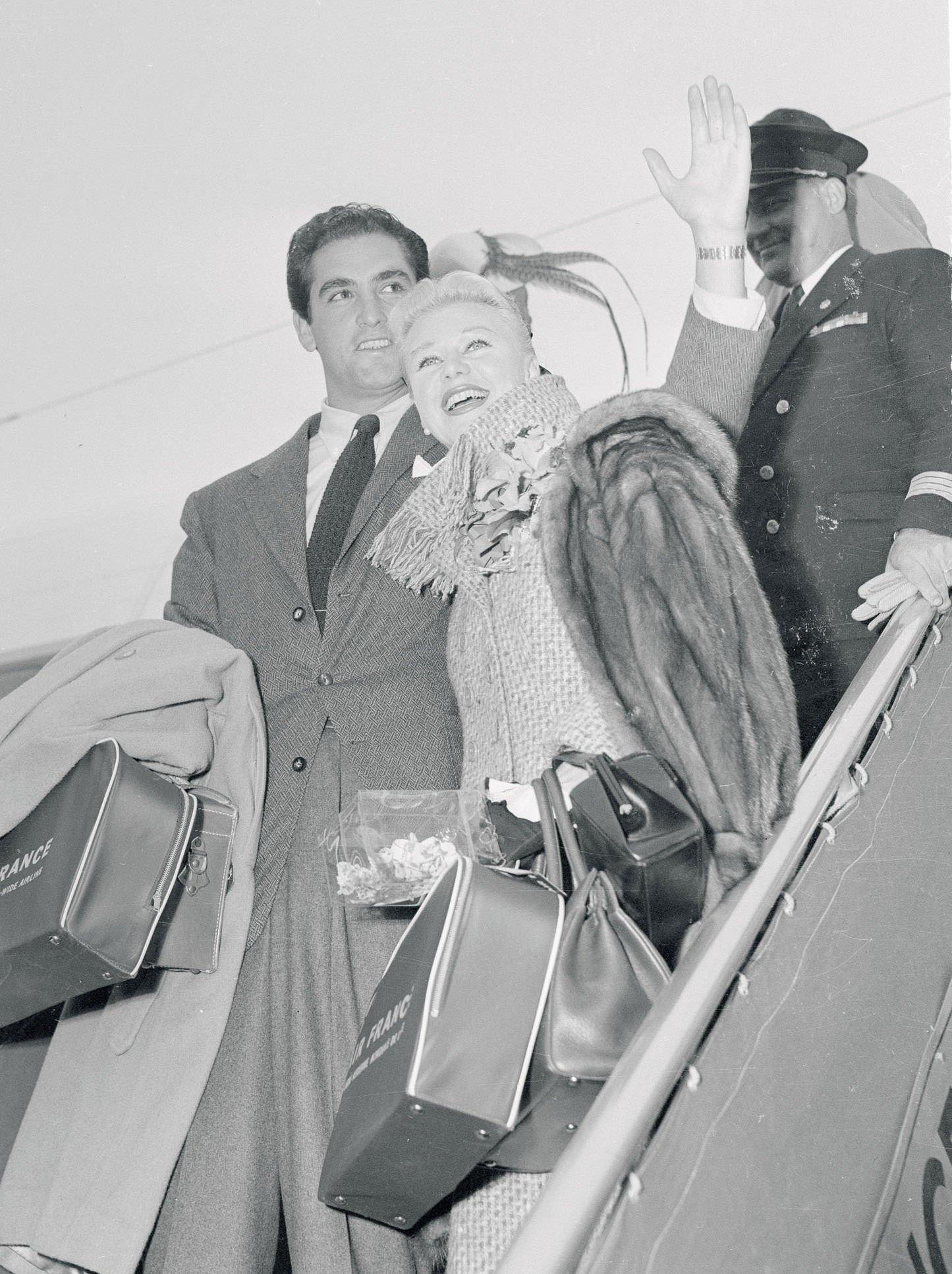
#76 The first passengers of the world’s inaugural jet service board their plane bound for Johannesburg, while nearby reporters capture the event.
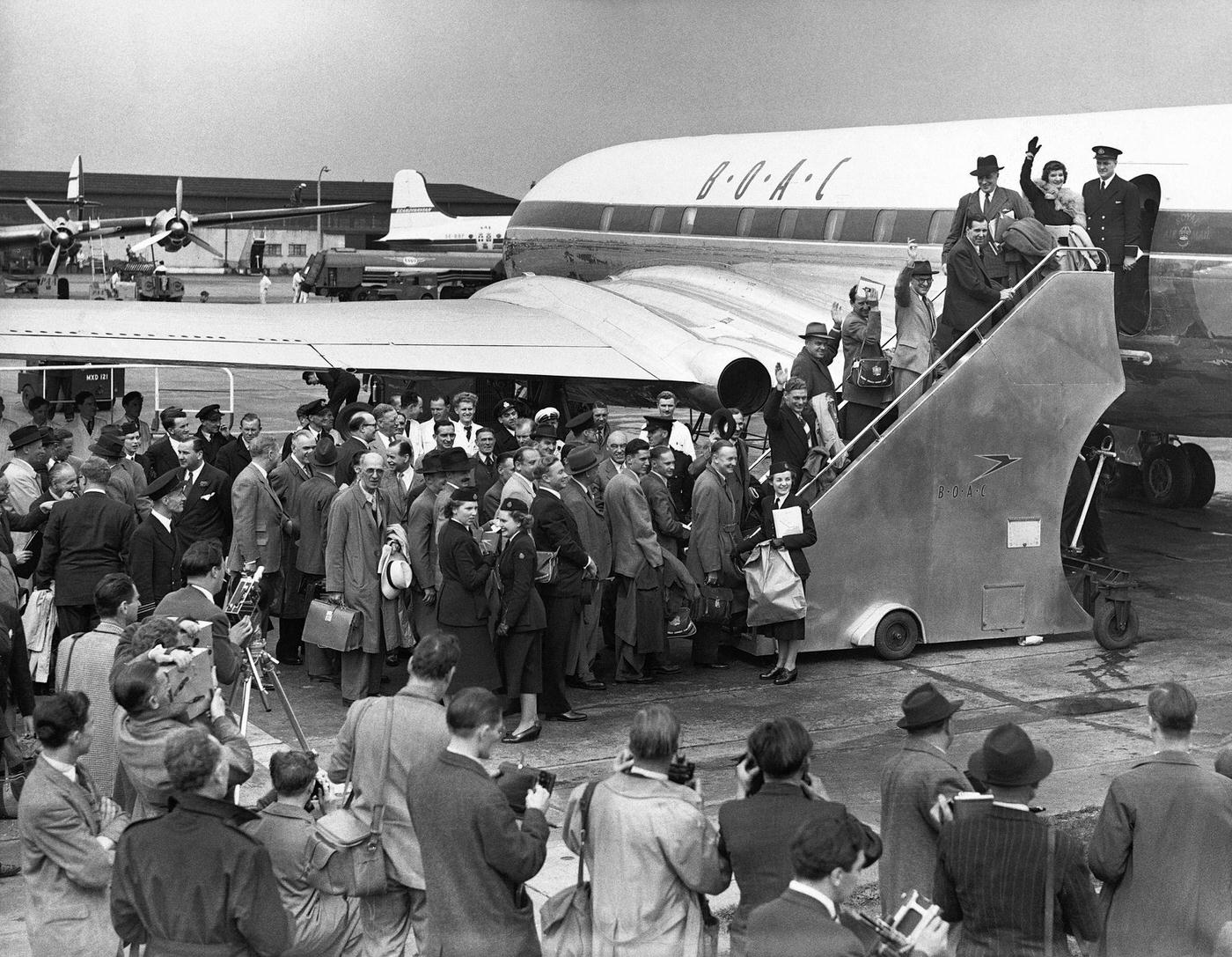
#77 Passengers get ready to nap on a Transocean Air Lines Boeing 377 Stratocruiser in the mid1950s. Transocean Air Lines was a pioneer discount airline that operated between 1946 and 1962.
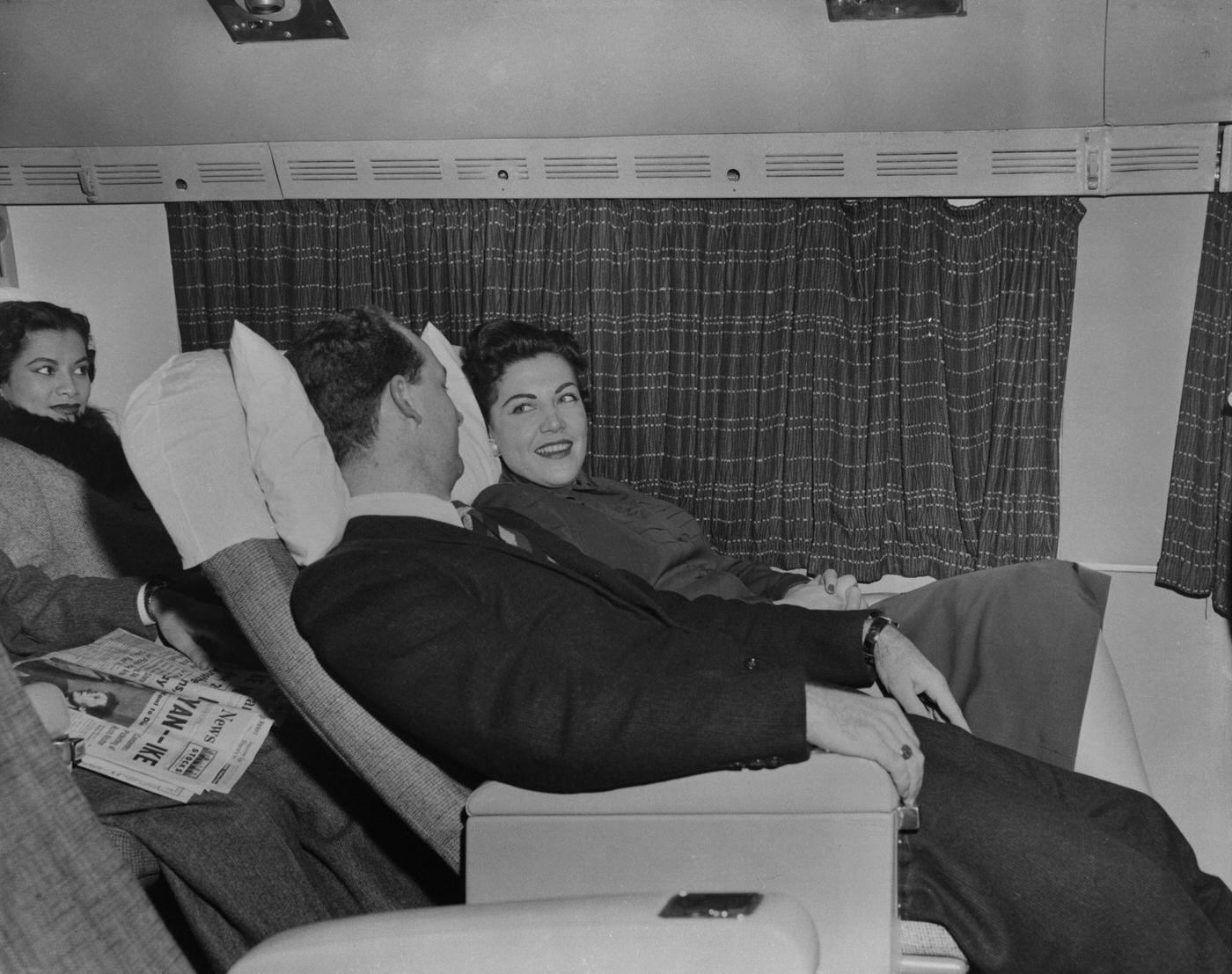
#78 Passengers are depicted on a Transocean Air Lines Boeing 377 Stratocruiser in the mid1950s.
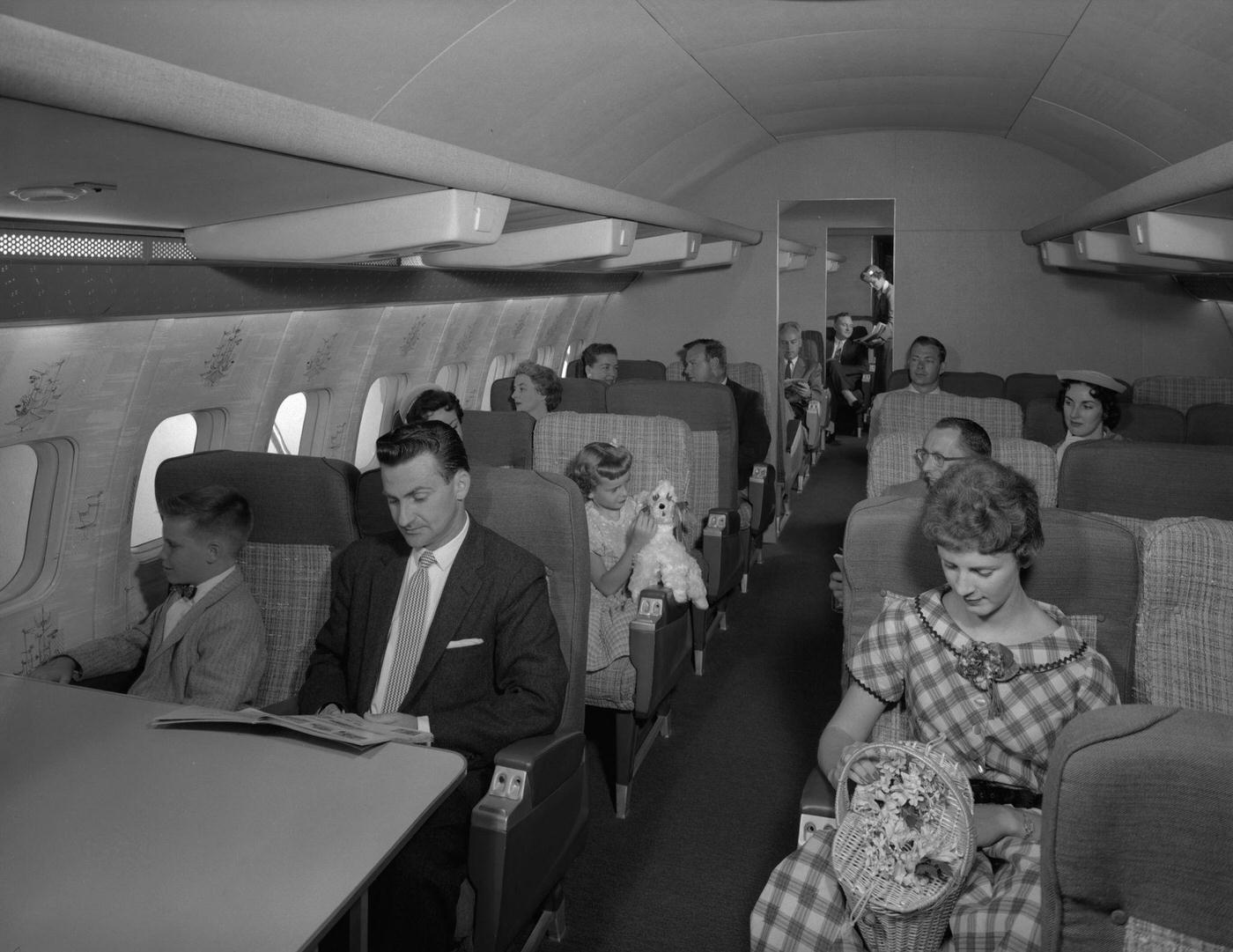
#79 An air hostess engages in conversation with passengers on a Transocean Air Lines Boeing 377 Stratocruiser in the mid1950s.
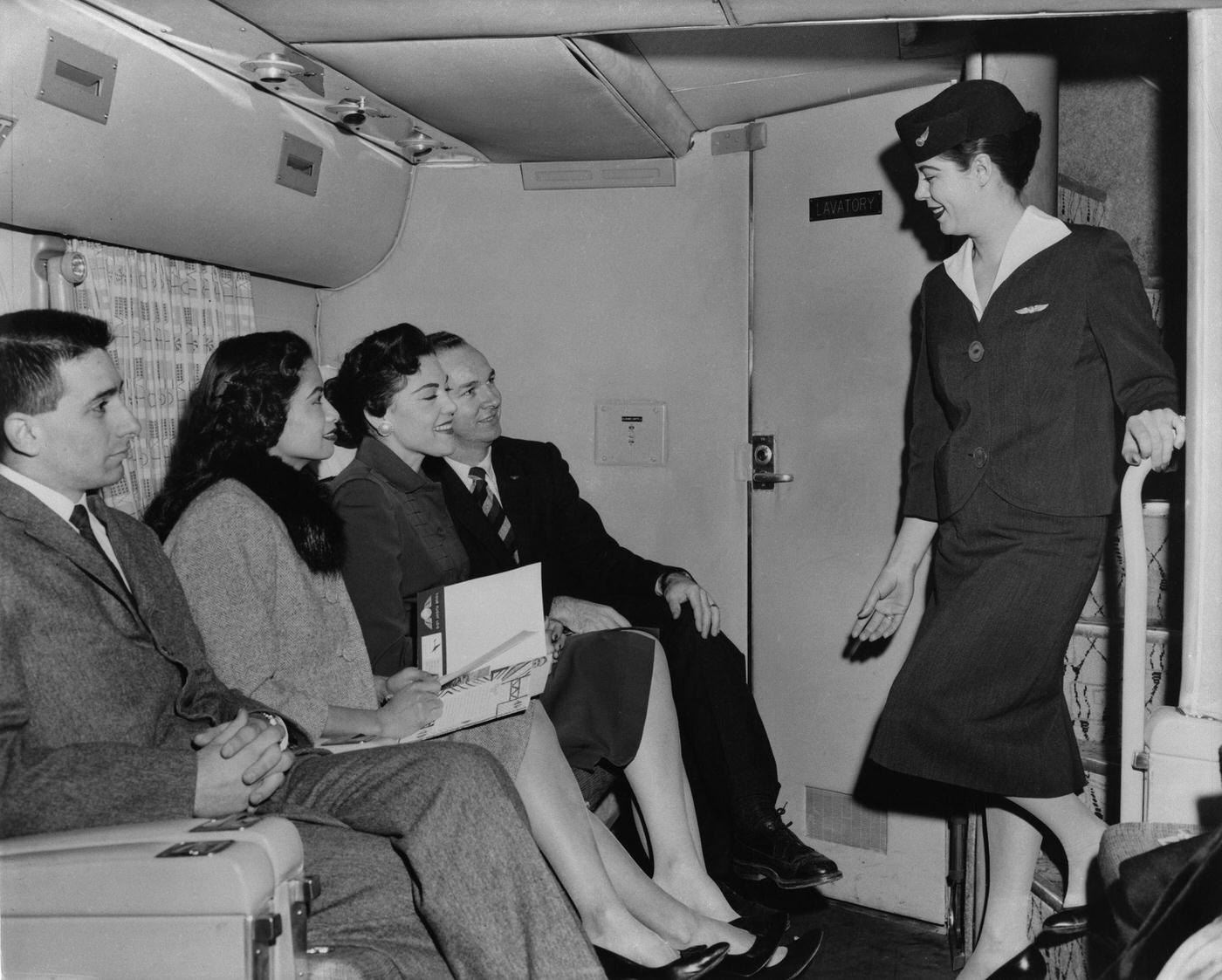
#80 The first British Comet jet passenger service from London Airport to Johannesburg is shown in this photo from 1952.
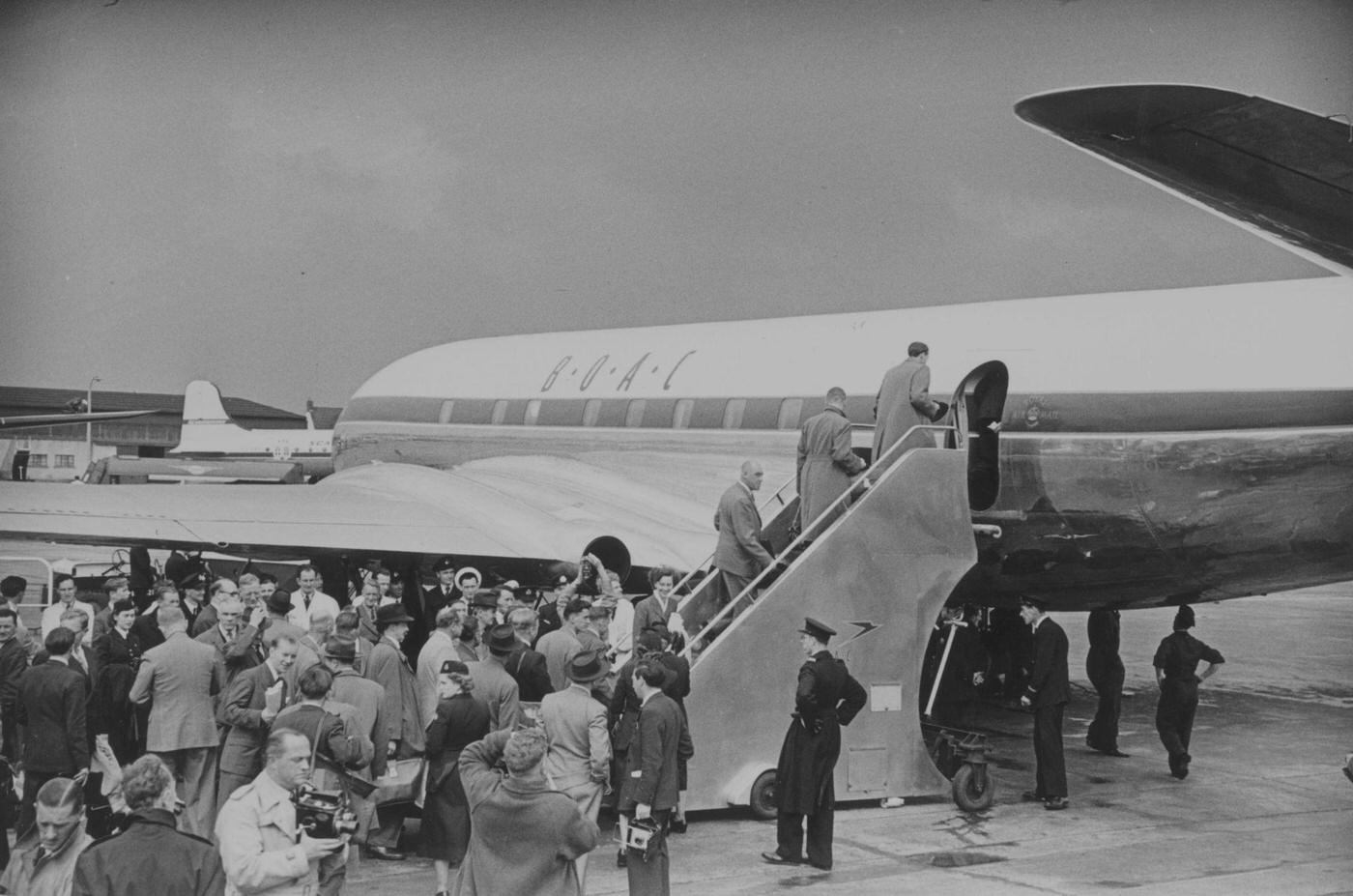
#81 Passengers bound for Johannesburg board the inaugural British Overseas Airways Corporation (BOAC) De Havilland Comet jet airliner at London Airport, marking the world’s first regular jet service.
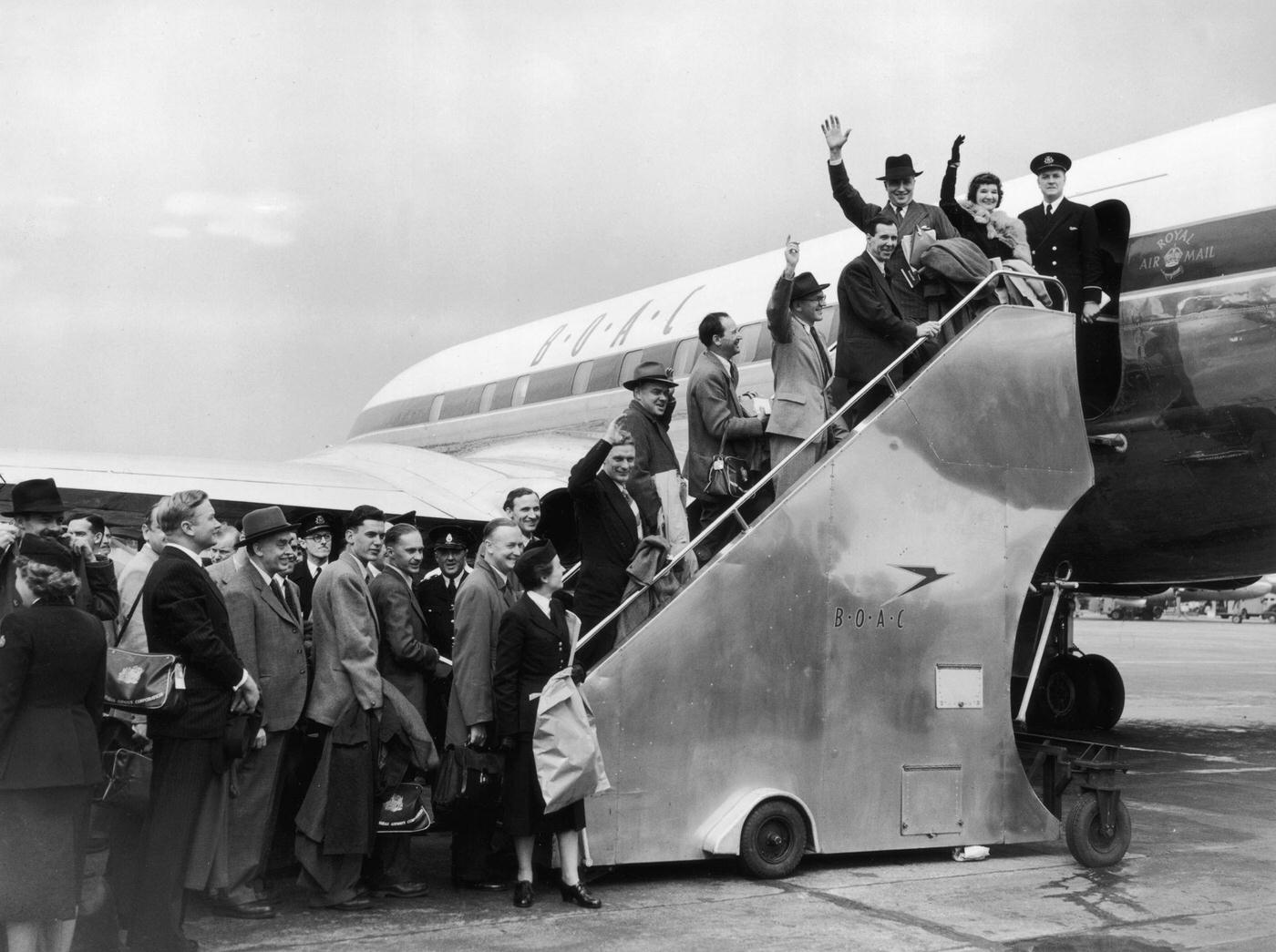
#82 The SaundersRoe SR45 Princess passenger flying boat prototype, GALUN, emerges from its hangar at the SaundersRoe Cowes facility on the Isle of Wight in the United Kingdom on October 31, 1951.
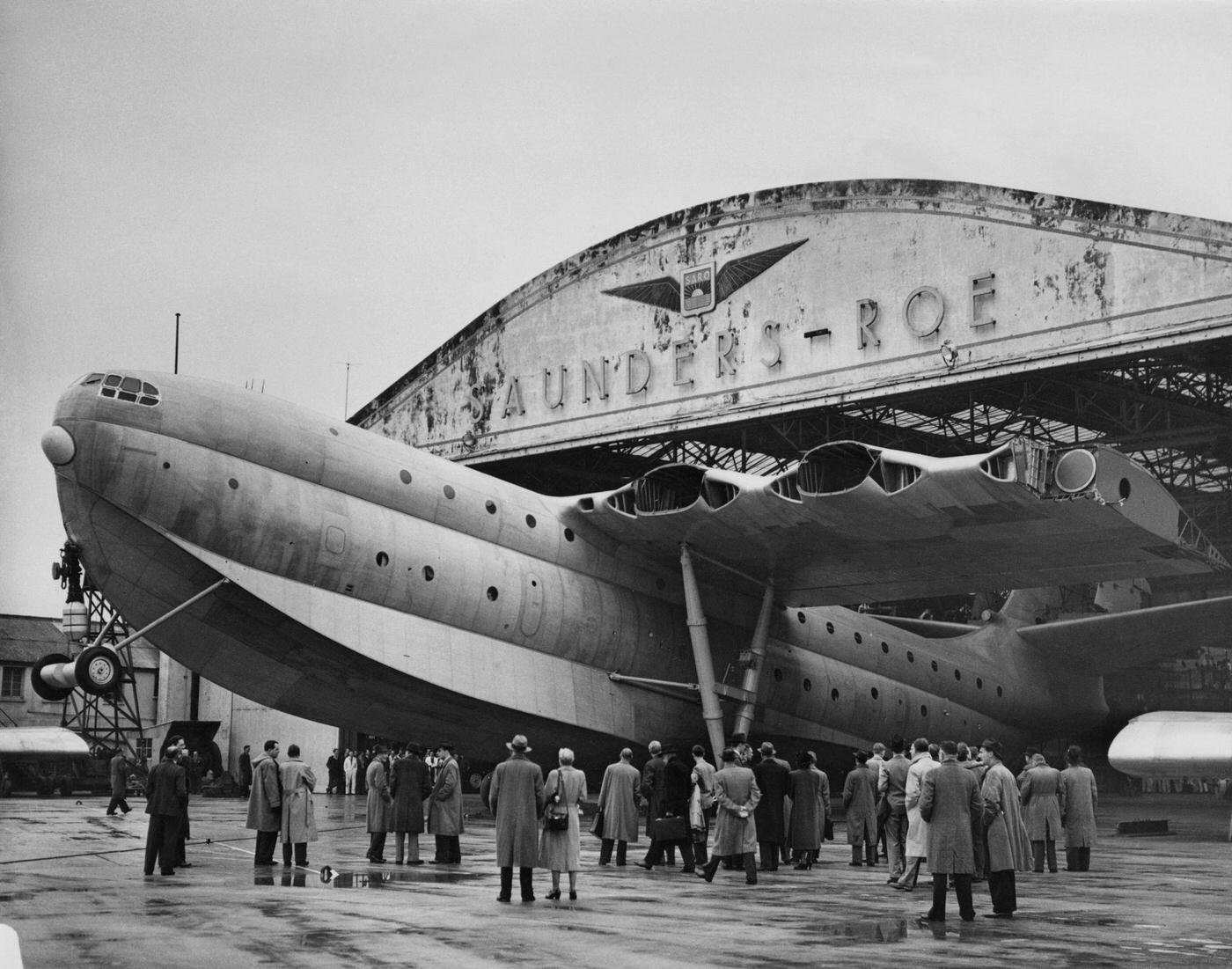
#83 Yankee catcher Yogi Berra and Phil Rizzuto play cribbage while waiting for chartered TWA flights to take off amidst a railroad strike.
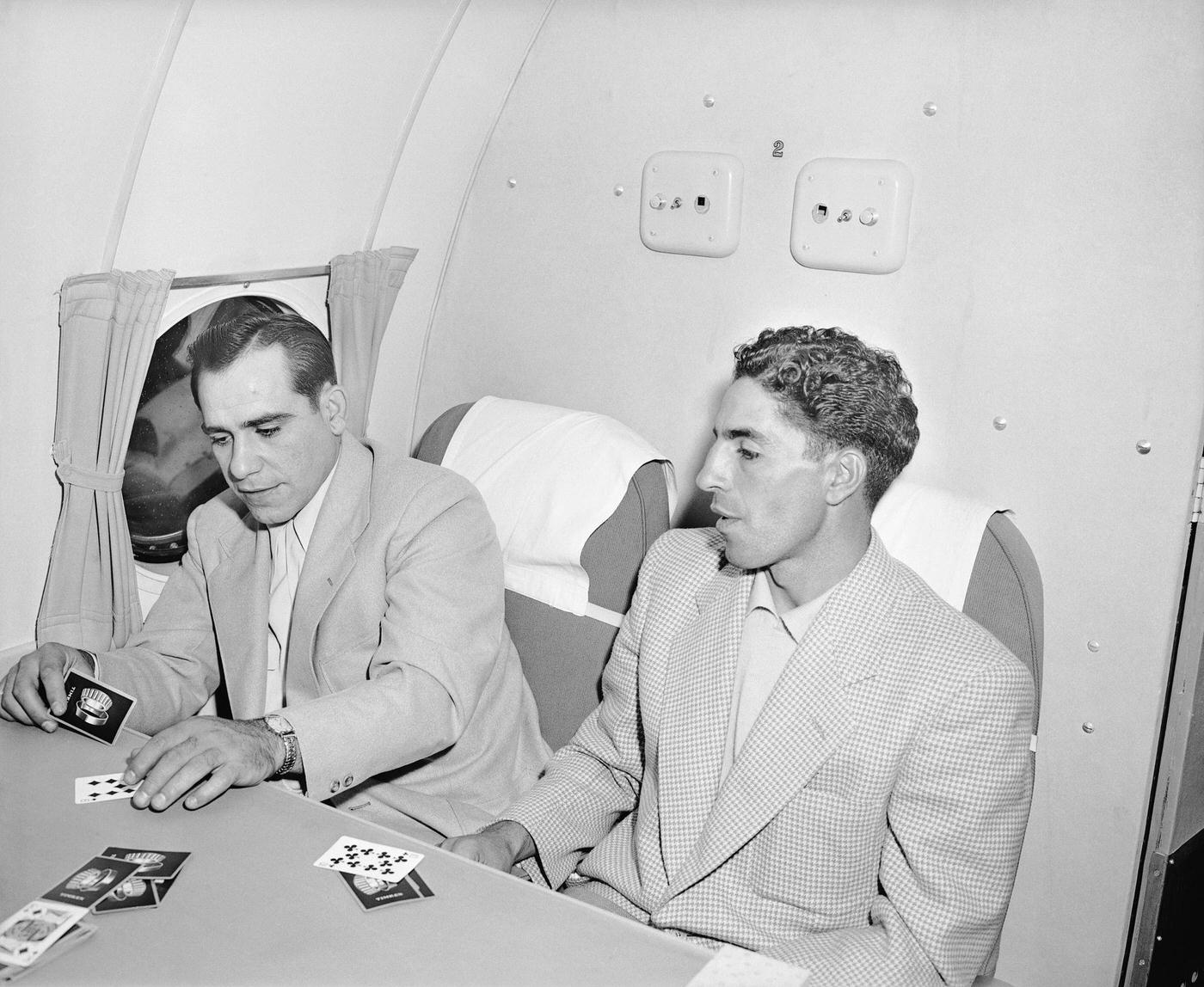
#84 Evacuees from Baghdad are about to board a flight at Esenboga Airport in Ankara, Turkey on July 25, 1958.
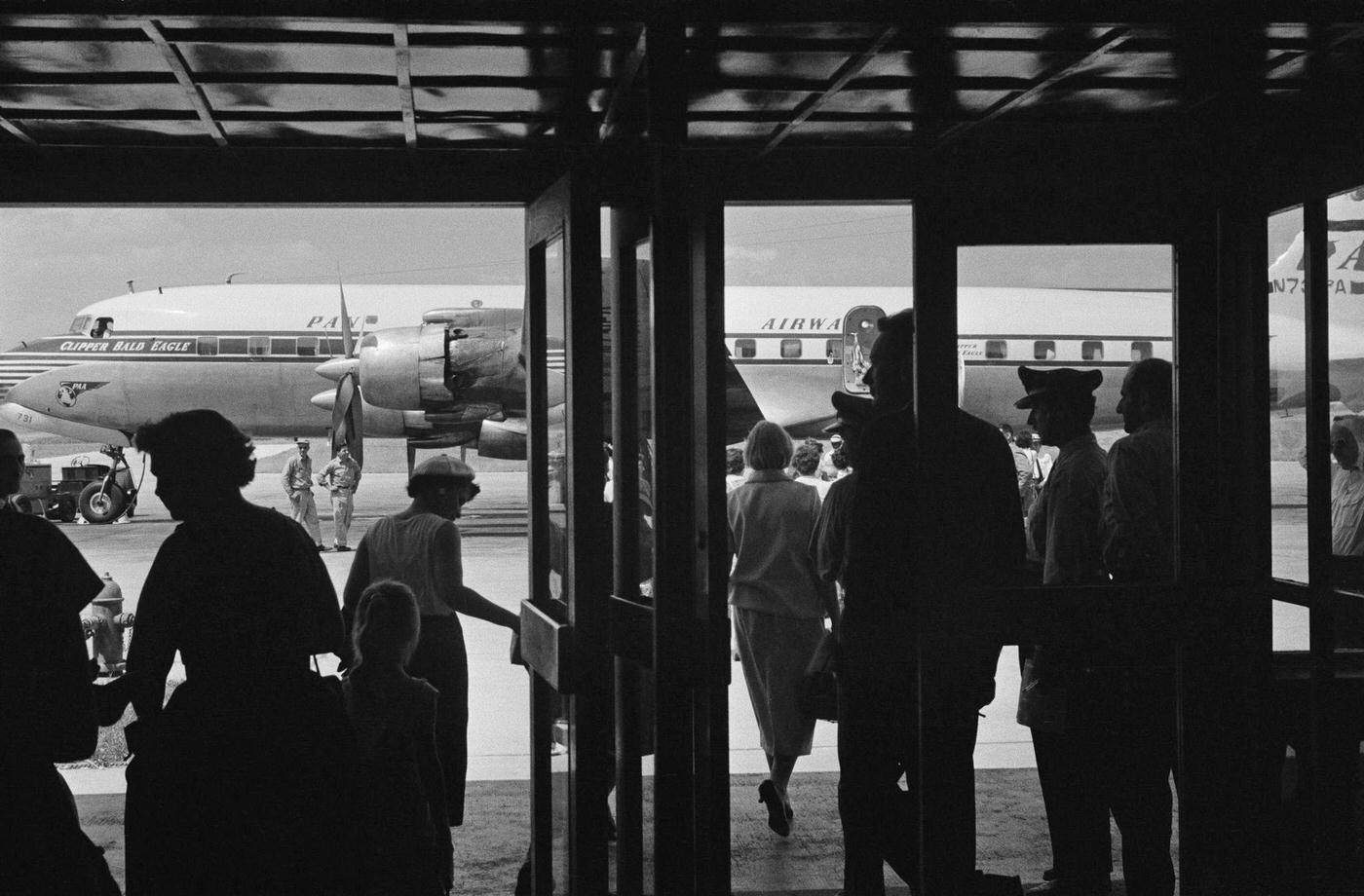
#85 Passengers disembark from a British Overseas Airways Corporation (BOAC) Canadair C4 Argonaut aircraft onto a shuttle bus at London Airport in June 1951.
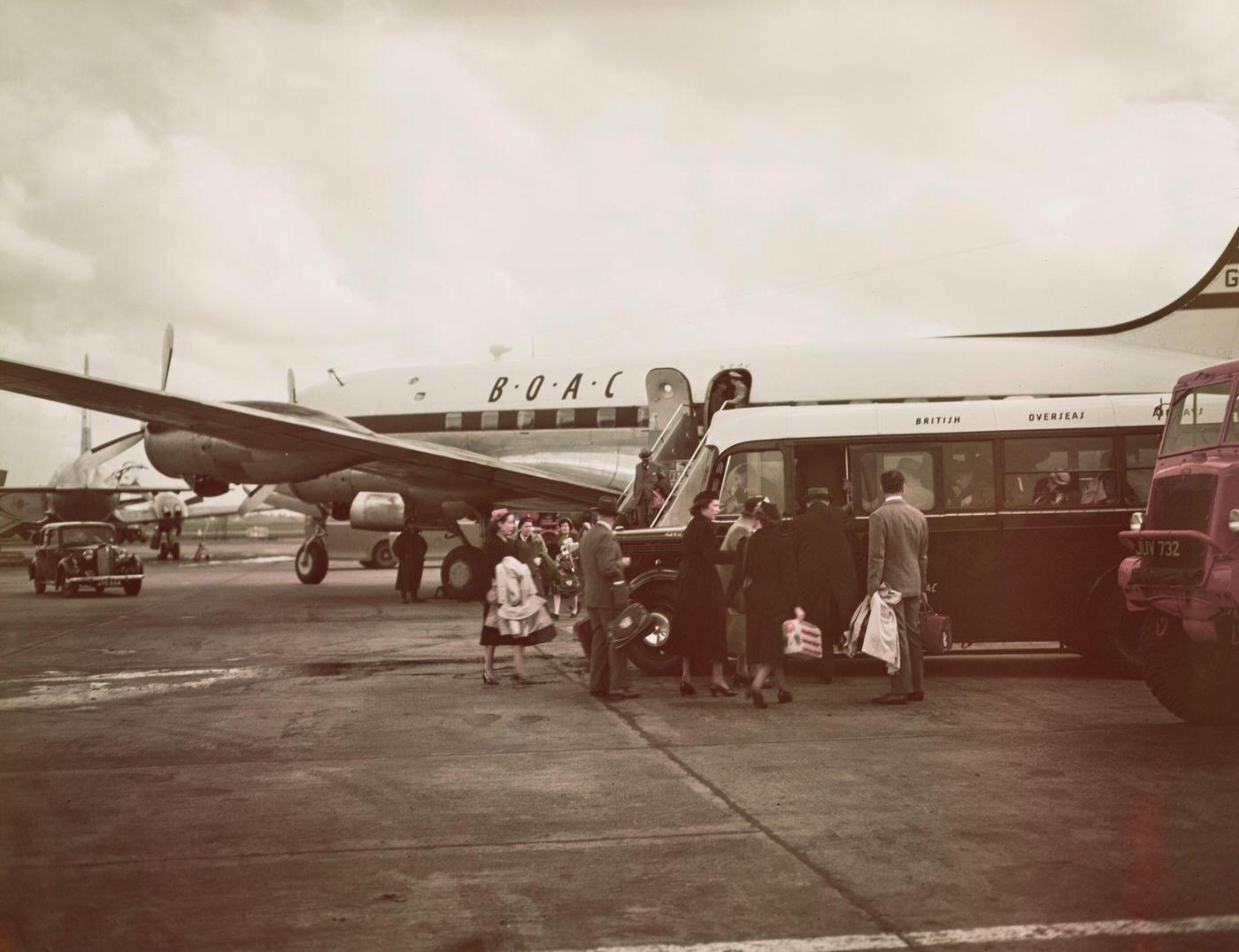
#86 The BOAC Comet is seen taxiing on the runway at London Airport before flying to Johannesburg, marking the world’s first jet passenger service.
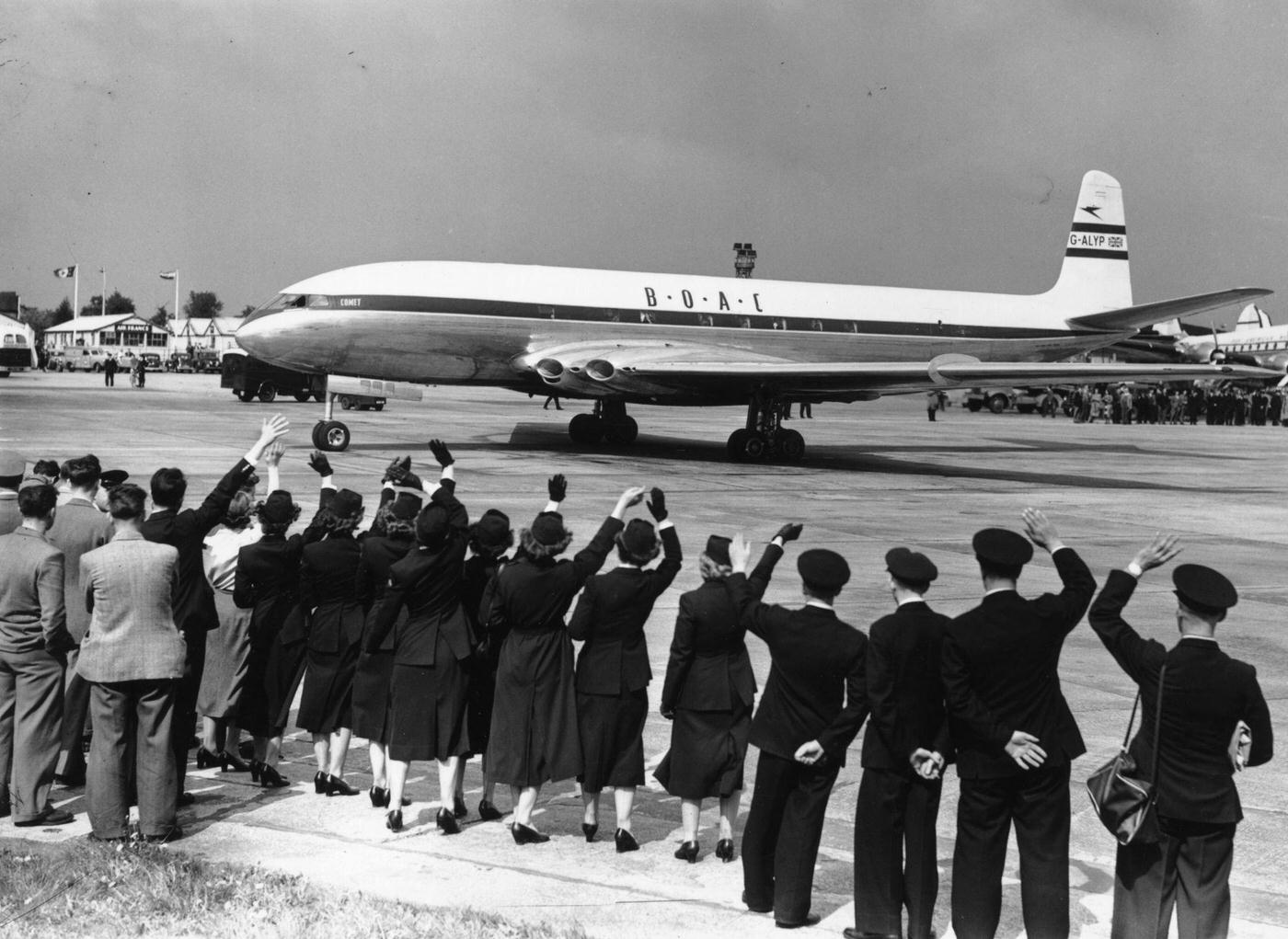
#87 Travellers sleep on board an airplane in New York, as seen in this 1950 photo from Picture Post.
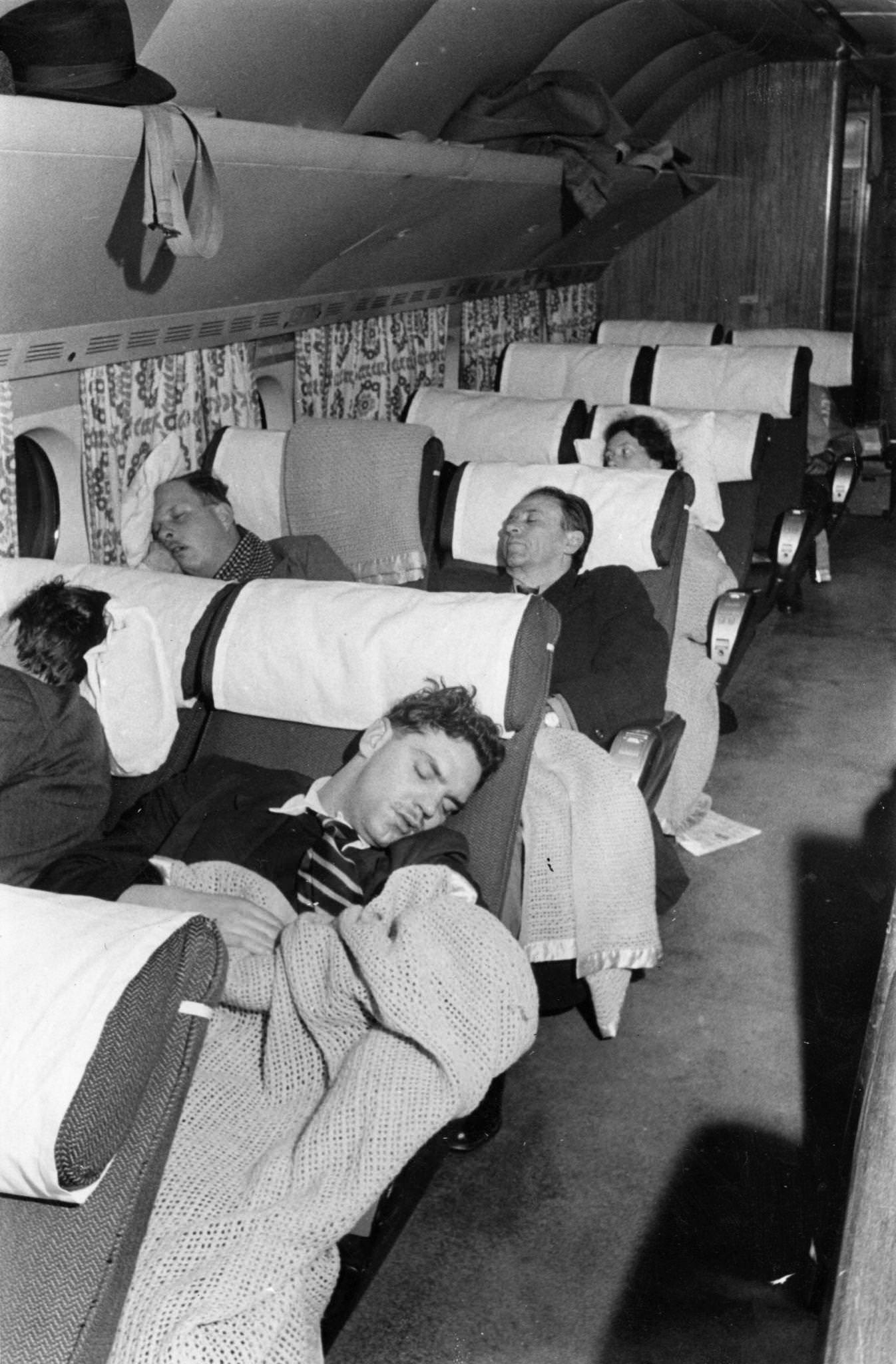
#88 Britishborn American actress Liz Taylor arrives at New York International Airport with fellow actresses Grace Kelly and Lorraine Day in 1955.
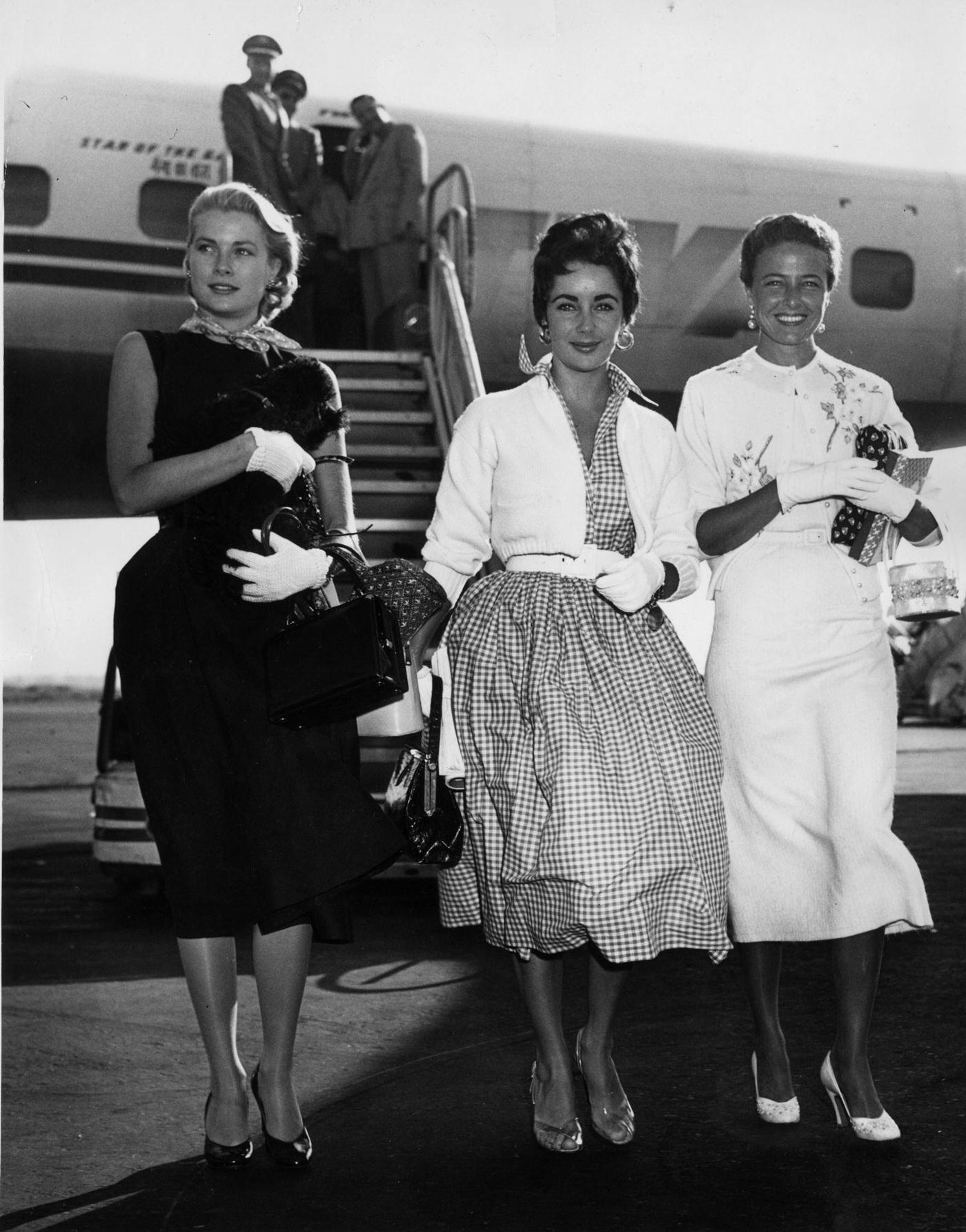
#89 In October 1956, a male air steward and female air stewardess serve food and drinks from a trolley to passengers on board a Bristol Britannia medium to long range airliner.
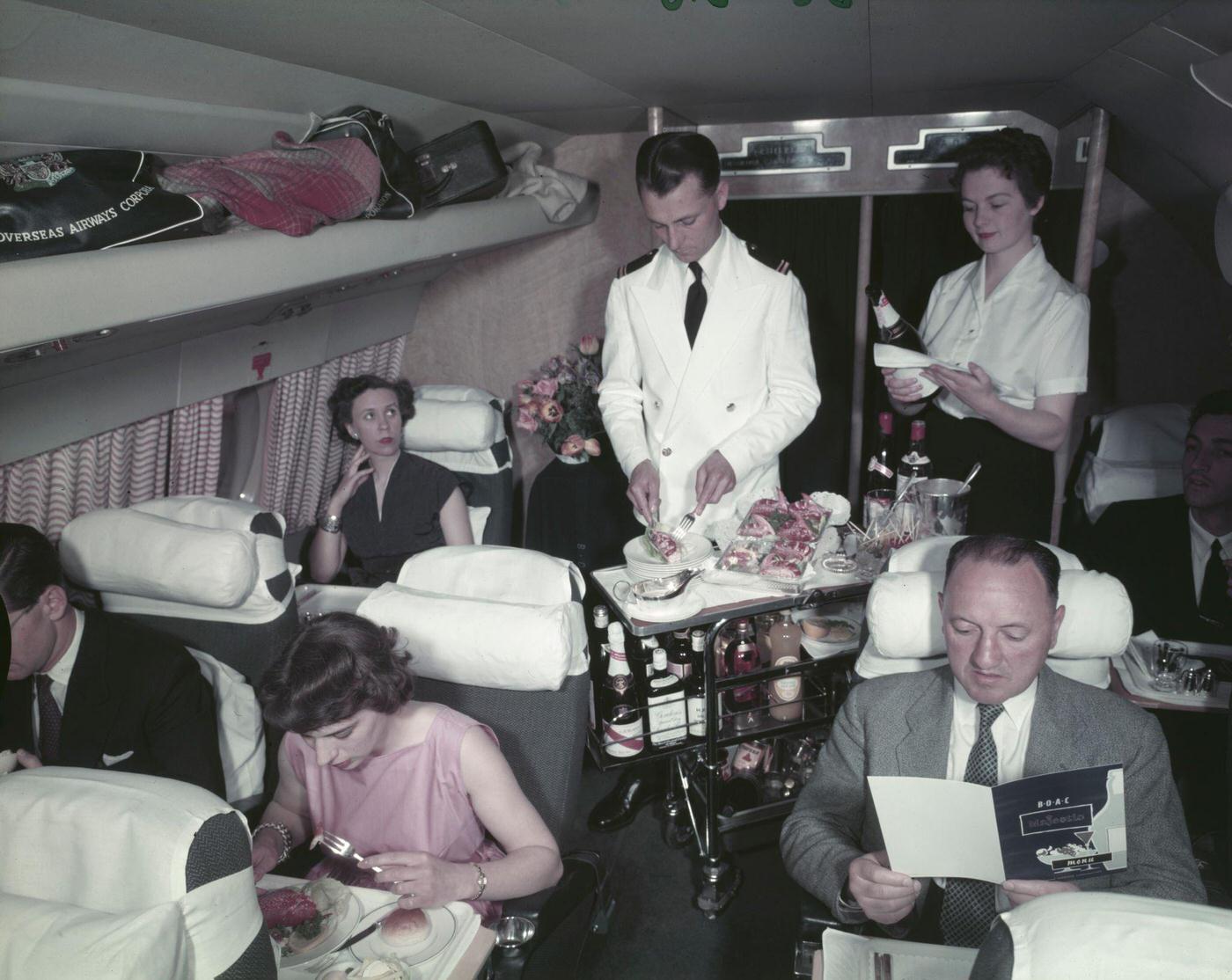
#90 A passenger on board the world’s first jet airliner service receives luncheon from E Courtney, a member of the cabin crew. The Comet flight is headed for South Africa.
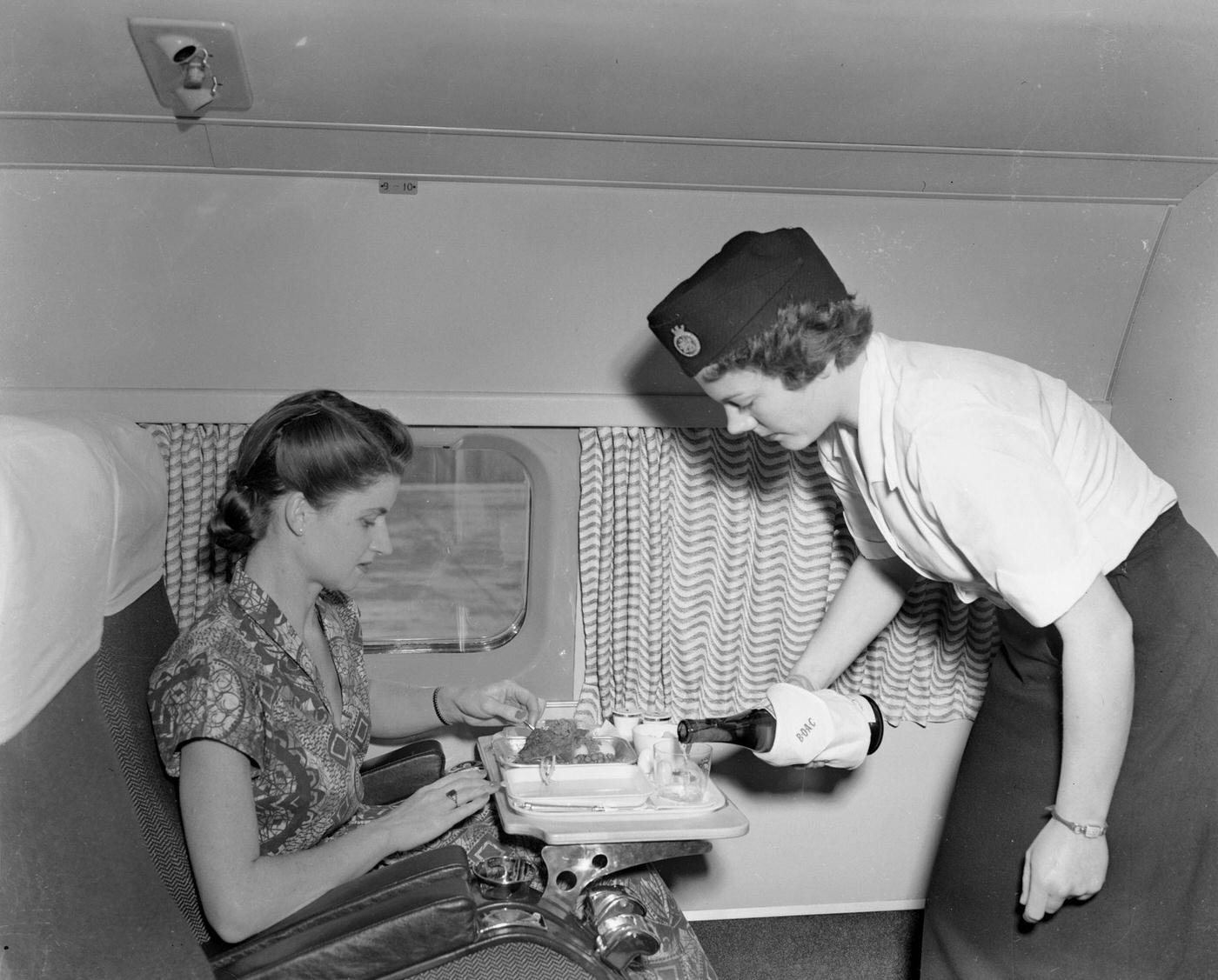
#91 Passengers boarding the jet service to Paris from the Pan American World Airways 707 Jet Clipper, which inaugurated the airline’s Trans Atlantic services to London on October 26, 1958.
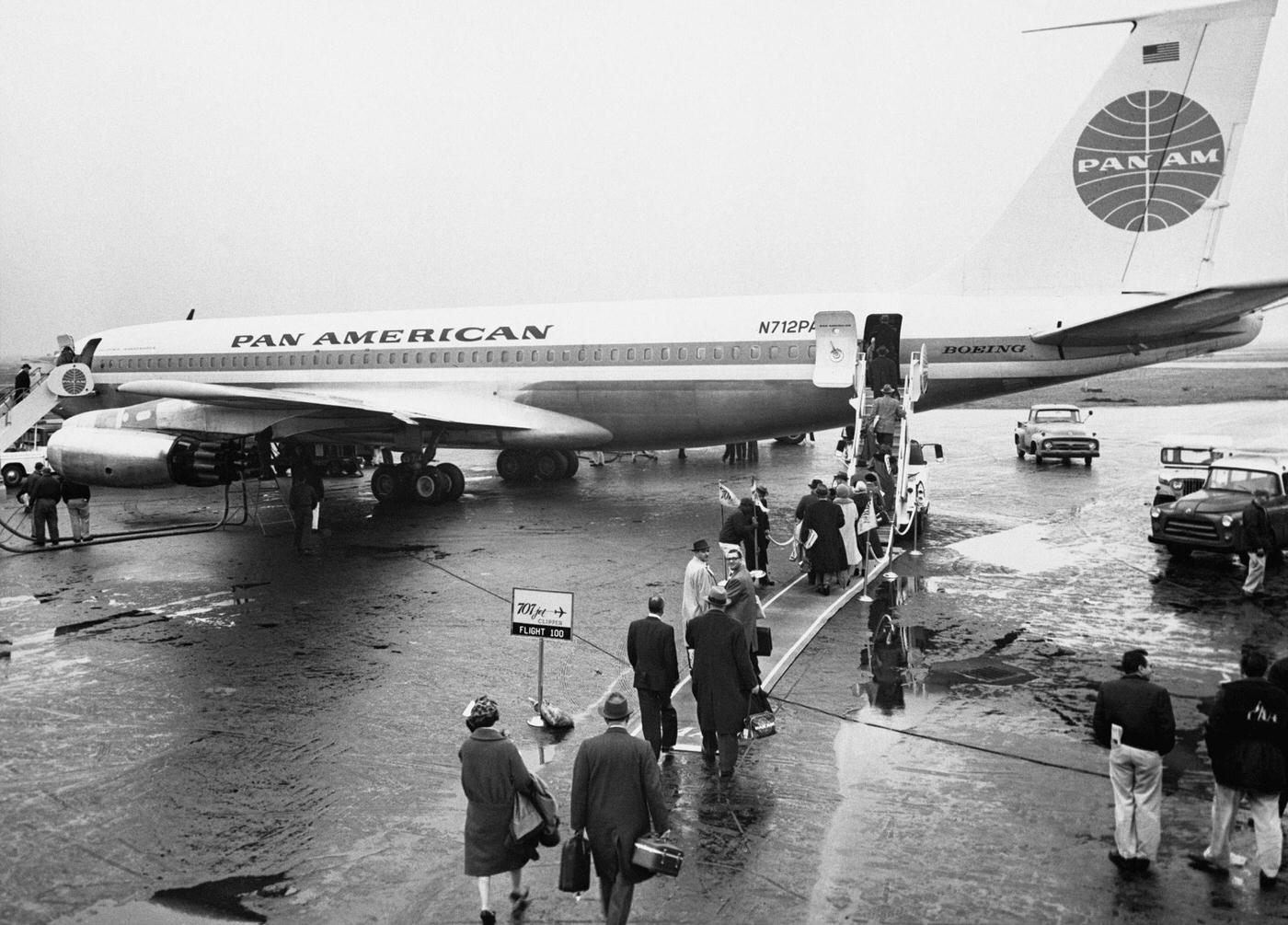
#92 Passengers enjoying a meal inside a mock-up of the Boeing 707 Stratoliner. The development of the Stratoliner began in the 1950s during the race to capture the commercial airline market.
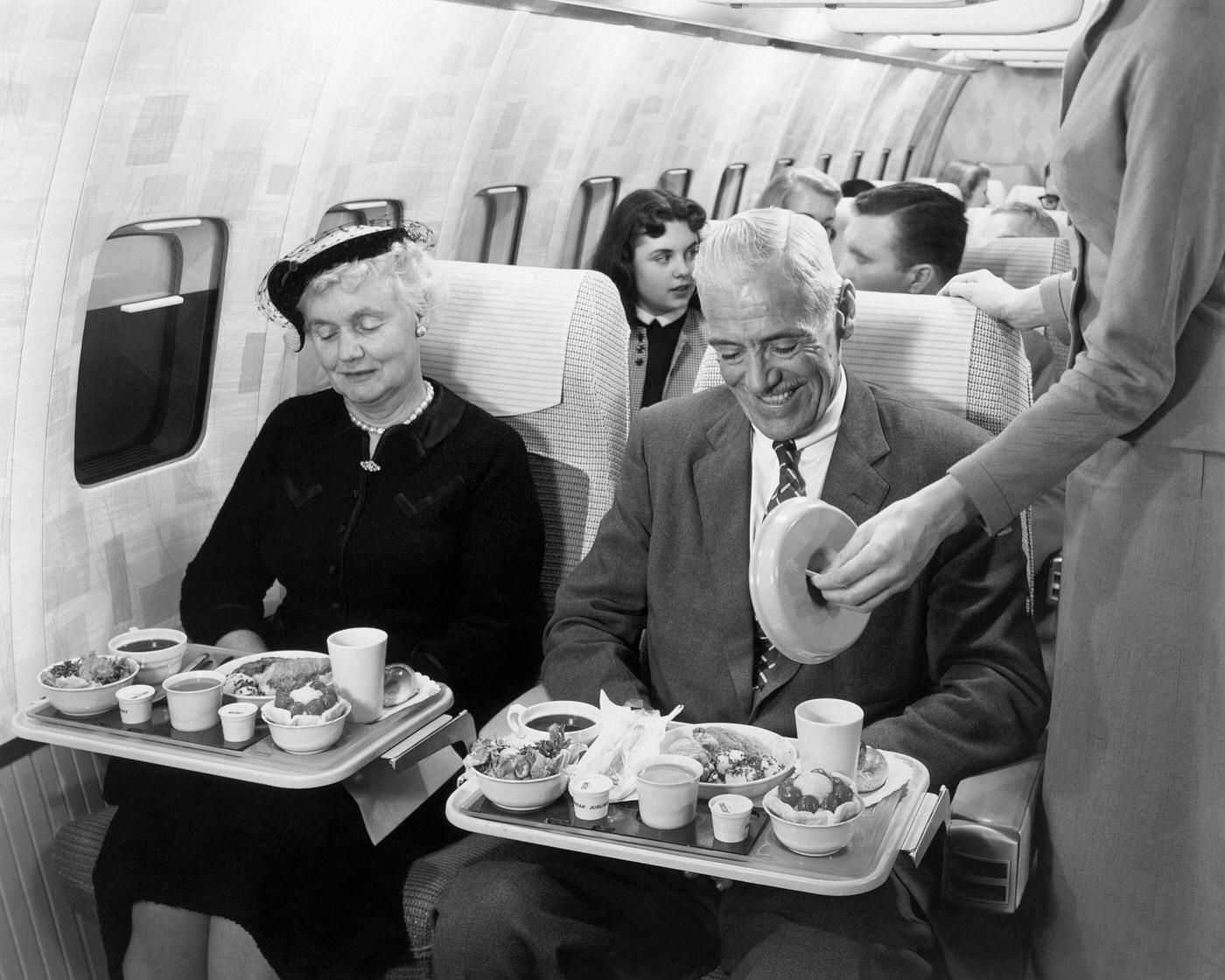
#93 Passengers dining on the Empire in 195.
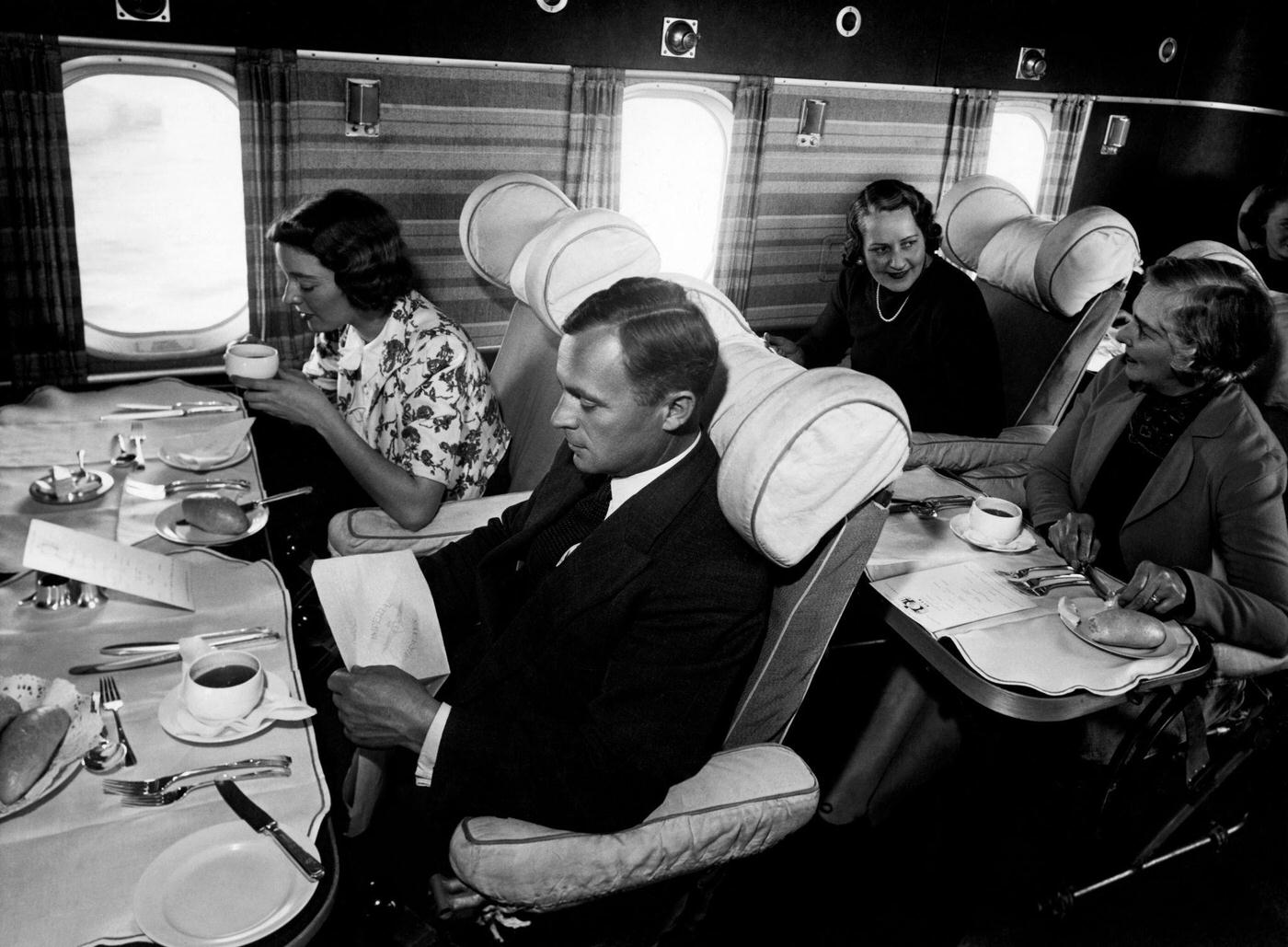
#94 Passengers playing on the Empire in 1950.
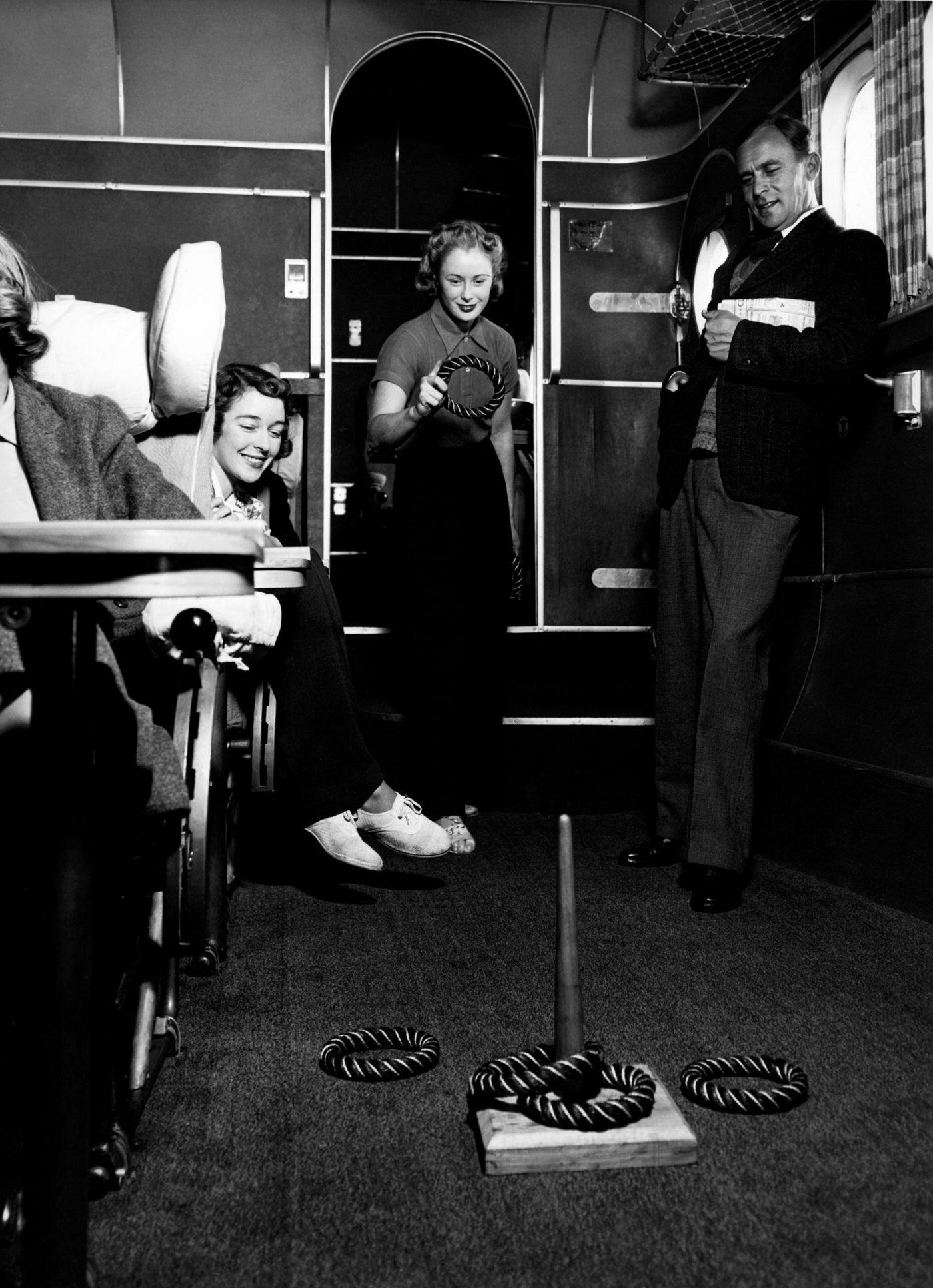
#95 A couple on a plane in 1955.
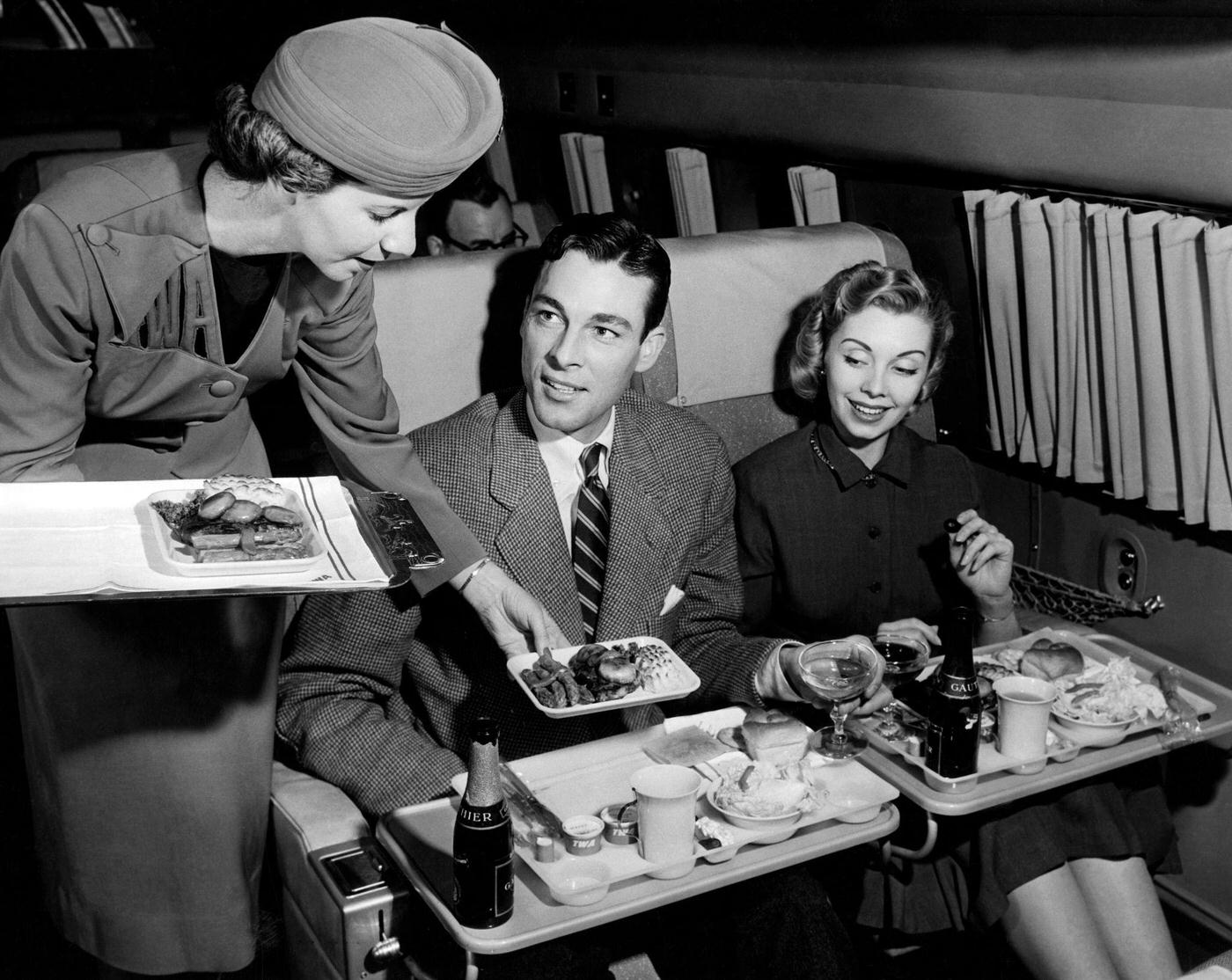
#96 On August 7, 1959, an air stewardess serves food to passengers on board a Qantas Boeing 707 plane at London airport.
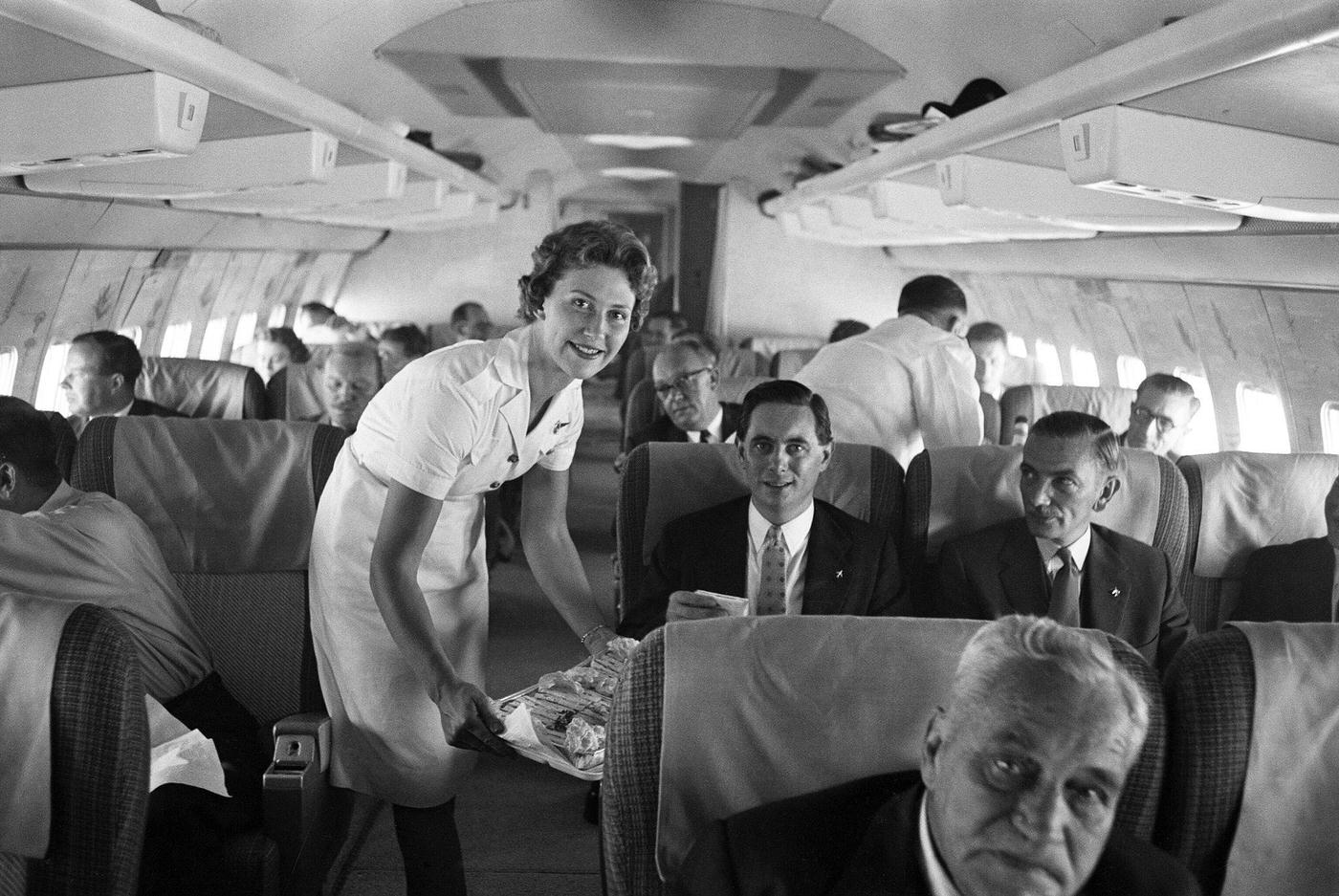
#97 In the 1950s, an interior view of a commercial passenger plane shows a flight attendant pouring a glass of wine for a man who sits next to a couple who are toasting each other with full glasses.
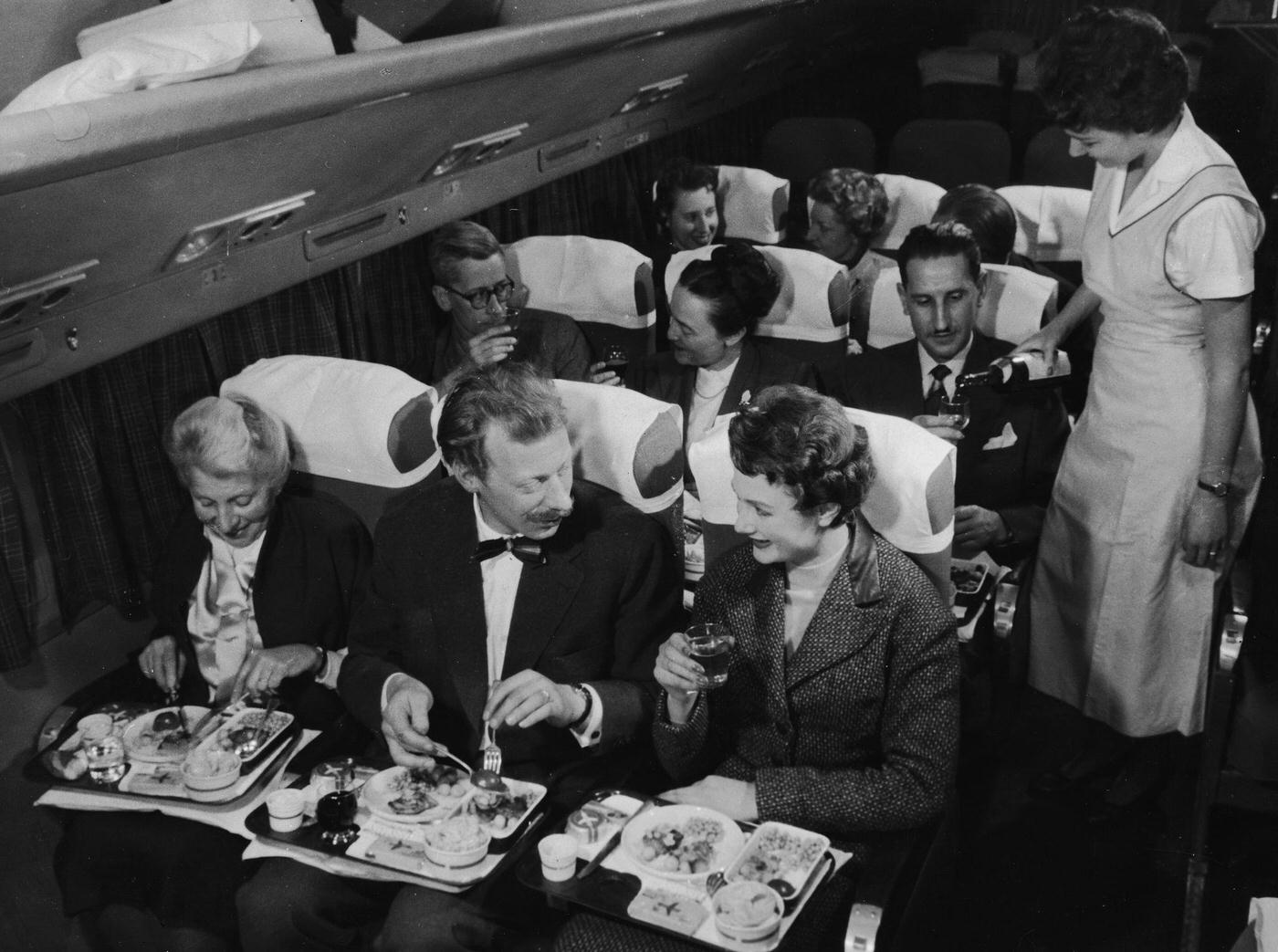
#98 In 1957, a view of airline passengers is seen along the center aisle of a plane. Many of the passengers are refugees from the failed Hungarian Revolution and are on their way to the United States.
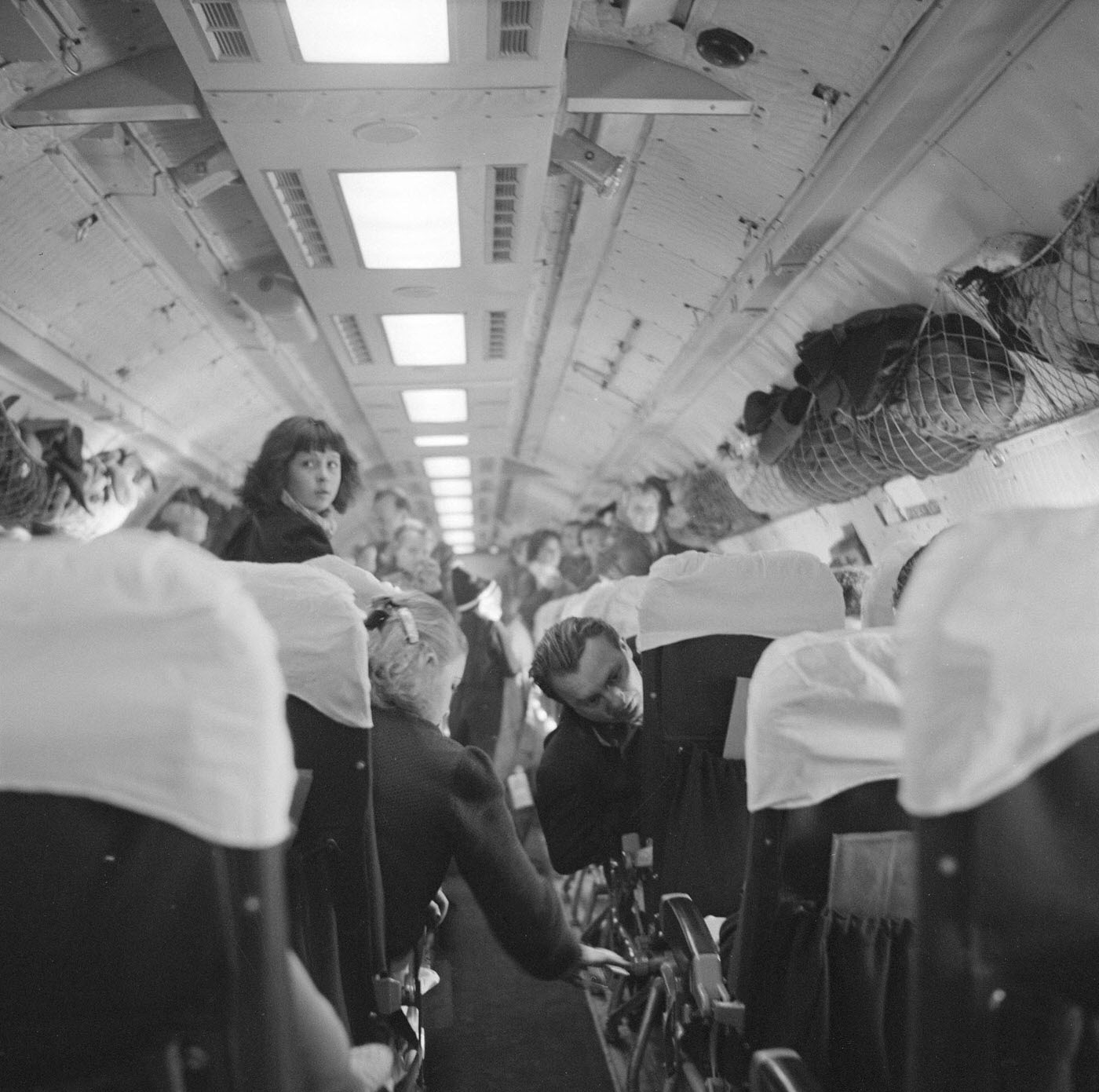
#99 Passengers enjoying a relaxing smoke on a Transocean Air lines Boeing 377 Stratocruiser in the mid-1950s. Transocean Air lines was a pioneer discount airline that flew between 1946 and 1962.
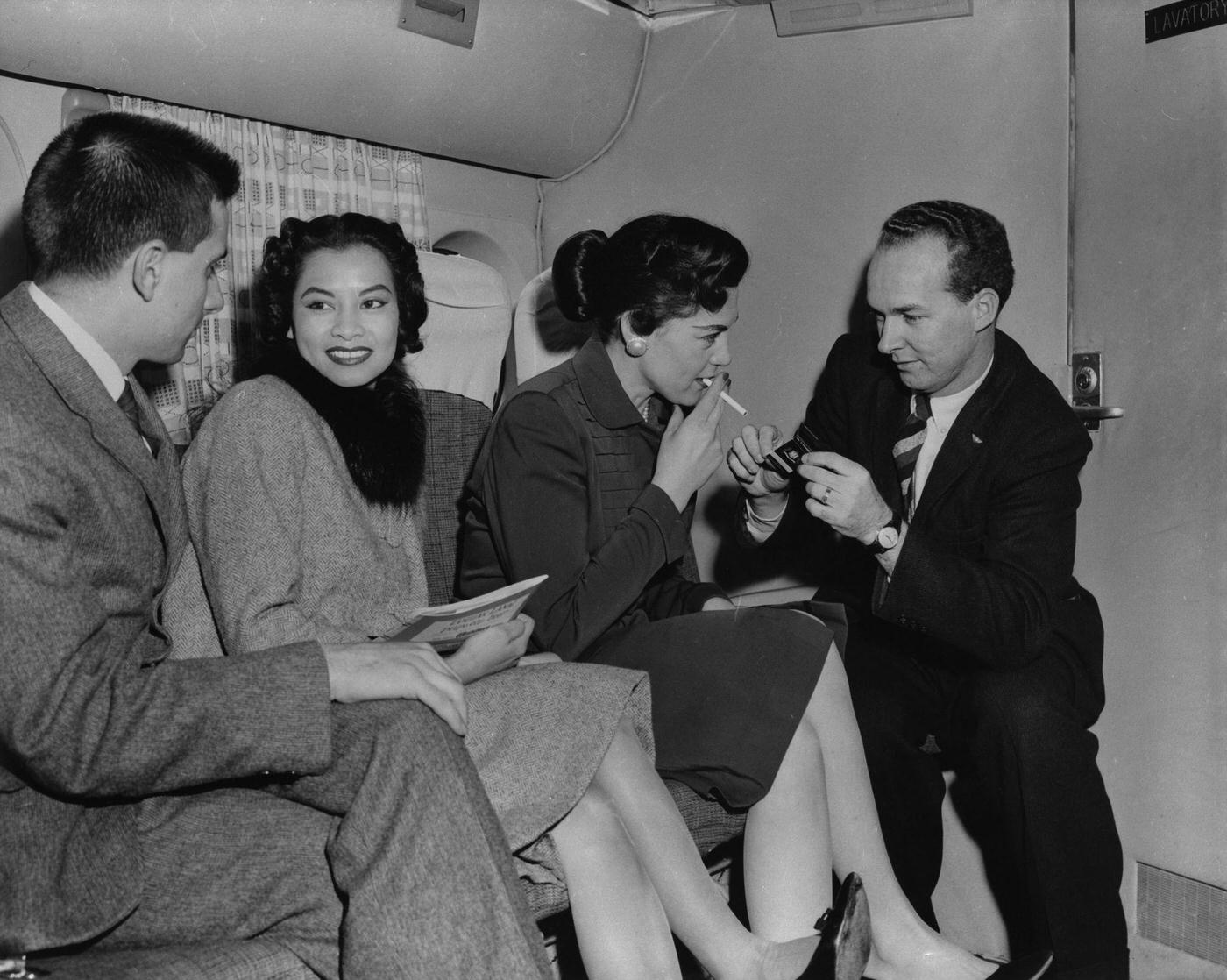
#100 A stewardess serves drinks while passengers have lunch aboard a BEA Vickers Viking passenger plane in 1958.
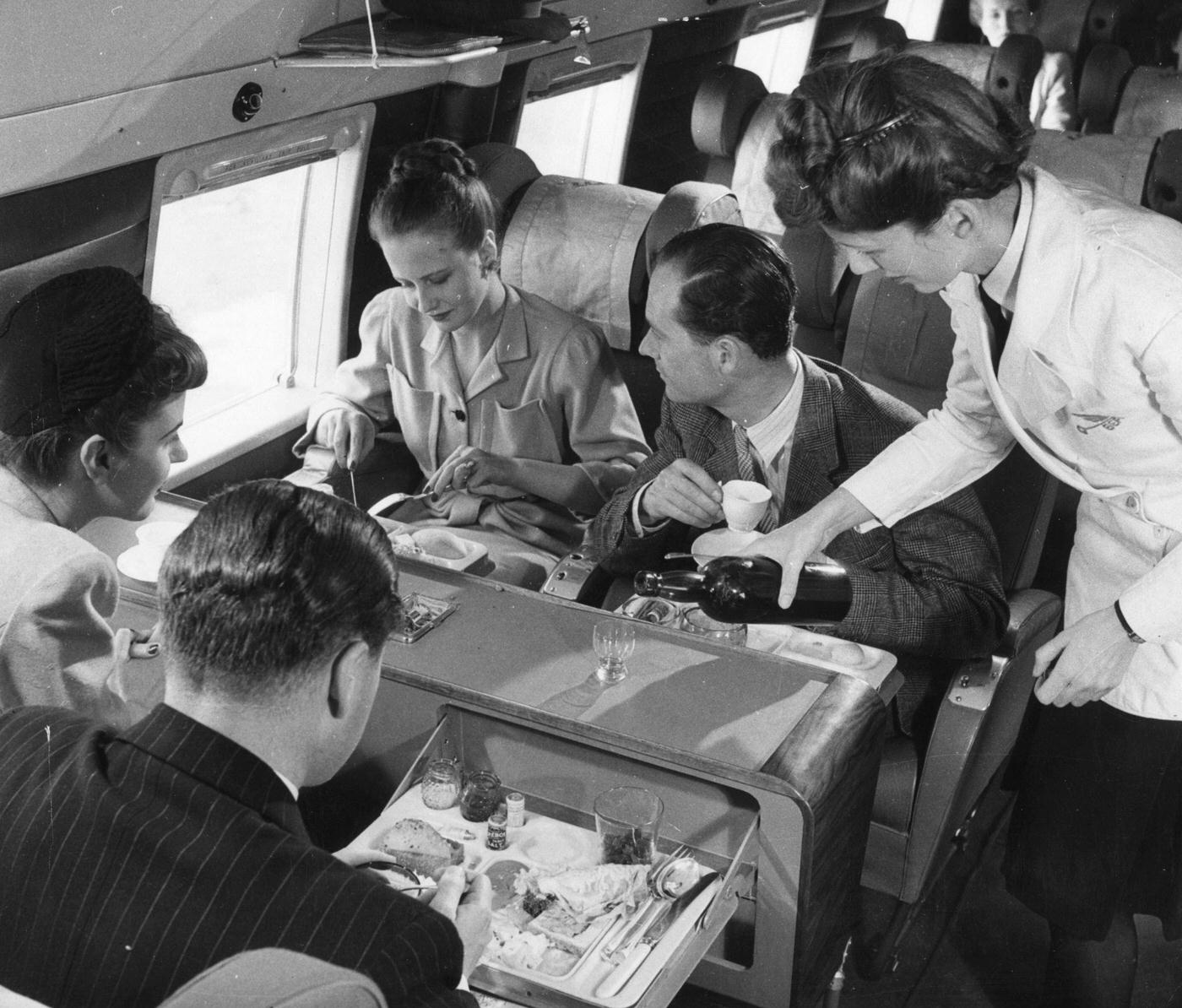
#101 In 1955, an interior view of the passenger cabin of a Douglas DC-7 Mainliner airplane shows a pair of flight attendants serving travelers.
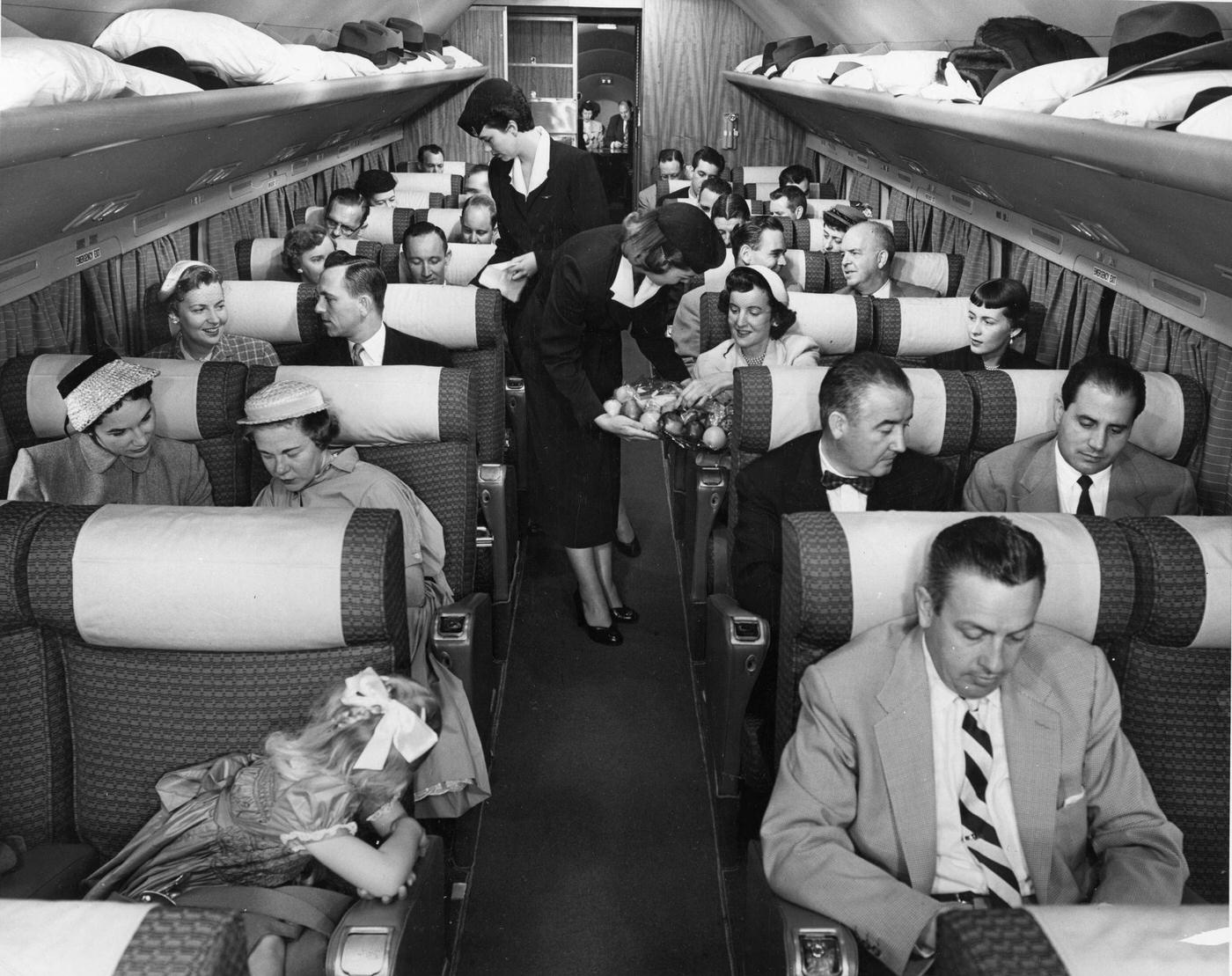
#102 In the mid-1950s, an air hostess serves a snack to passengers on a Transocean Air lines Boeing 377 Stratocruiser. Transocean Air lines was a pioneer discount airline that flew between 1946 and 1962.
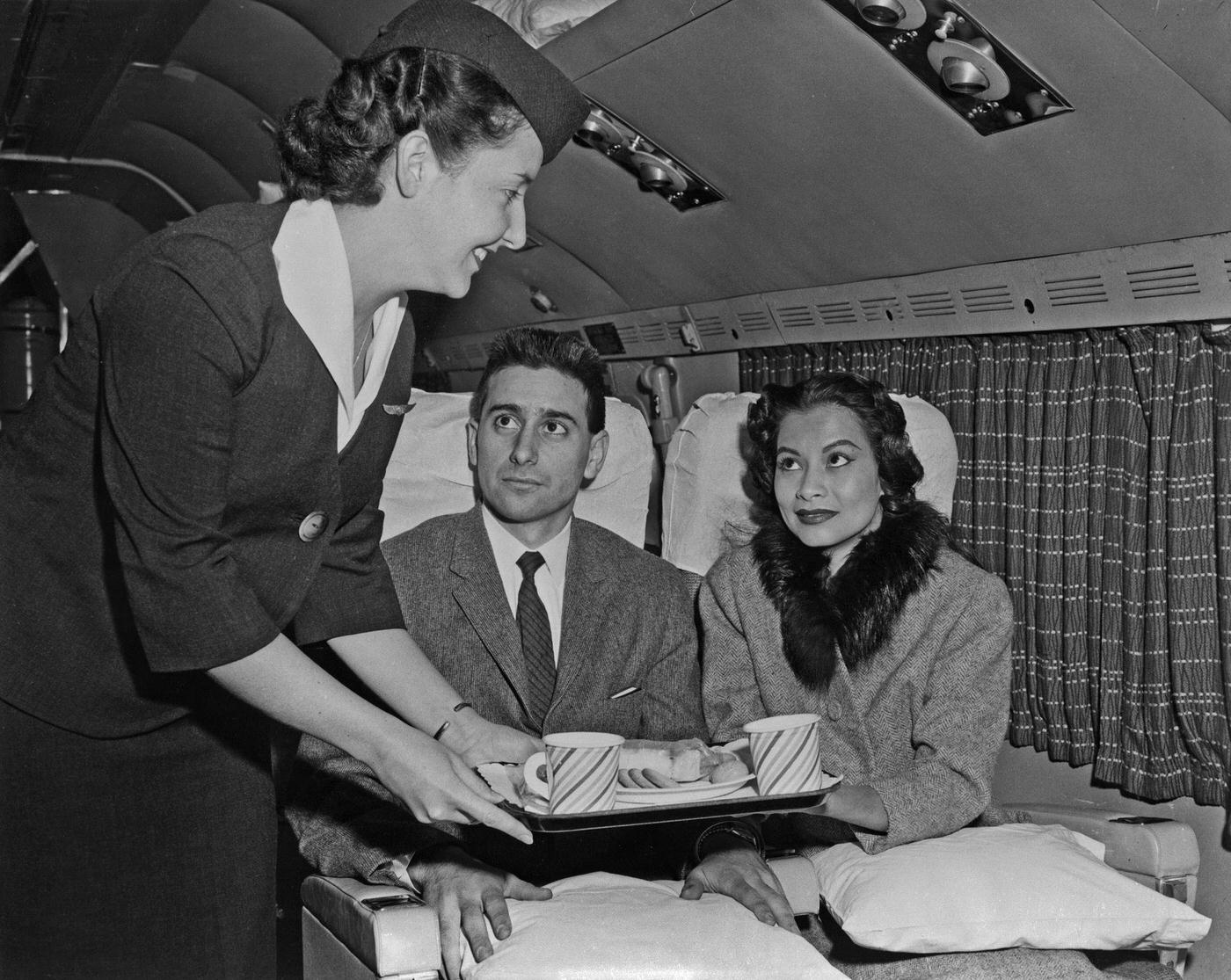
#103 This Vickers Viscount airliner was a surprise visitor to Woolsington (Newcastle Airport), having arrived from London with passengers due to a rail strike in 1955.
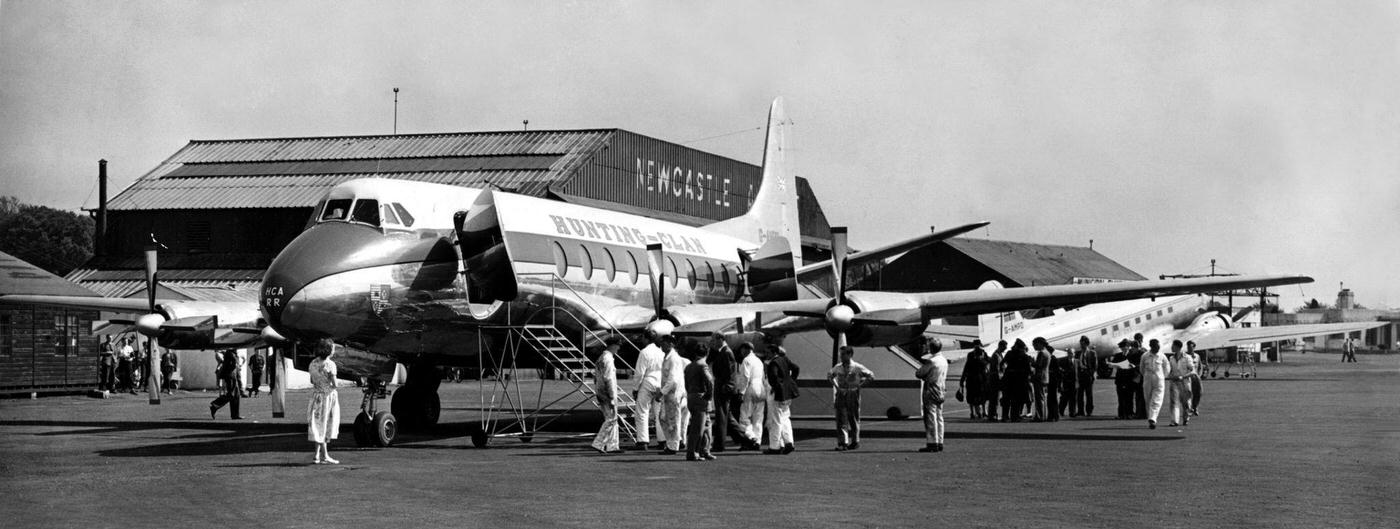
#104 Passengers relaxing on the sleeper seats during a demonstration flight of the new Comet 4 at Hatfield in 1958.
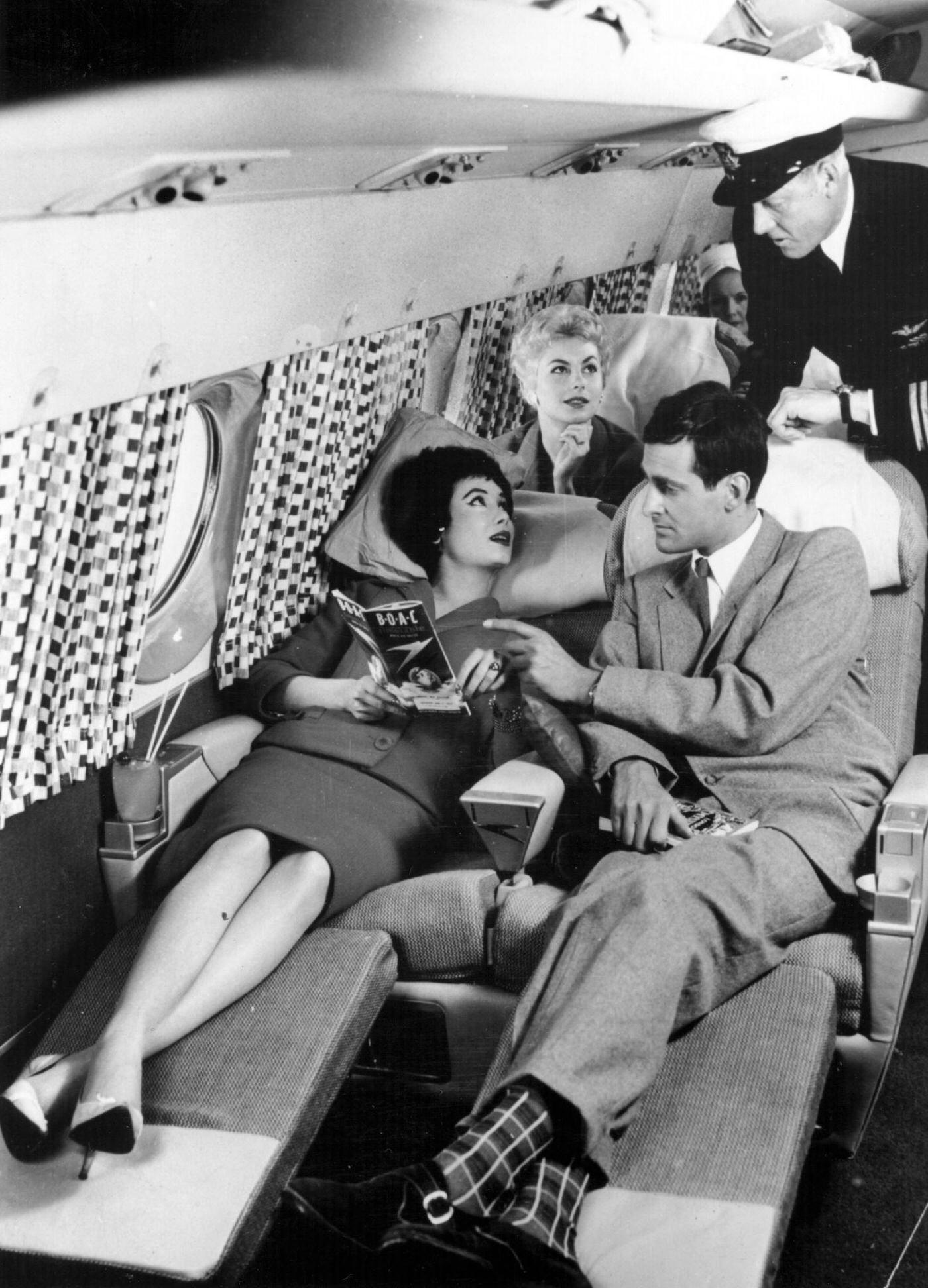
#105 In the 1950s, an interior view of the first-class compartment of a commercial passenger plane shows a flight attendant bending forward to adjust the seat of a sleeping man.
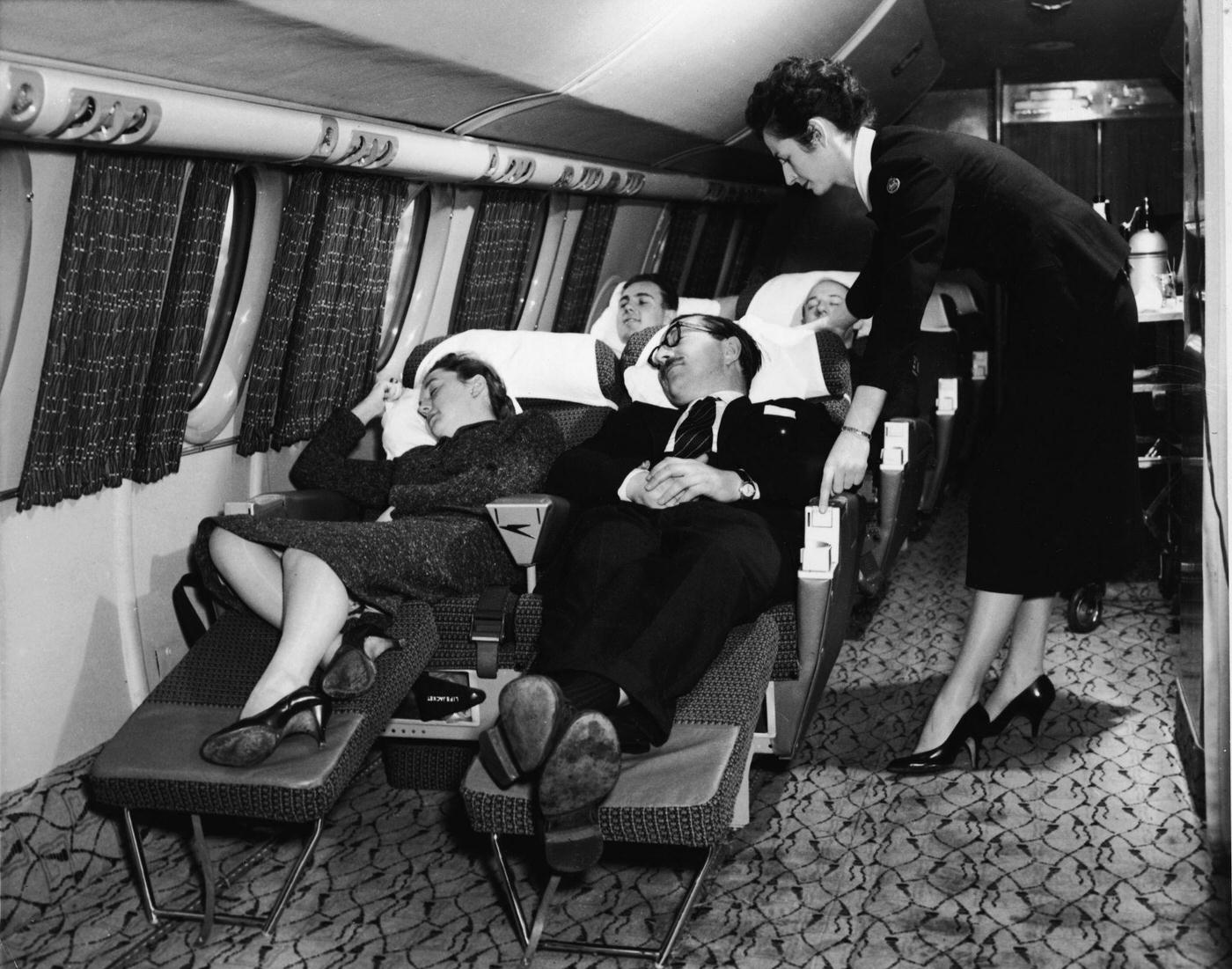
#106 In the 1950s, a first-class compartment of a commercial passenger plane shows a well-dressed couple in the foreground smiling and enjoying their meal, while behind them a flight attendant in a bow tie serves another happy couple.
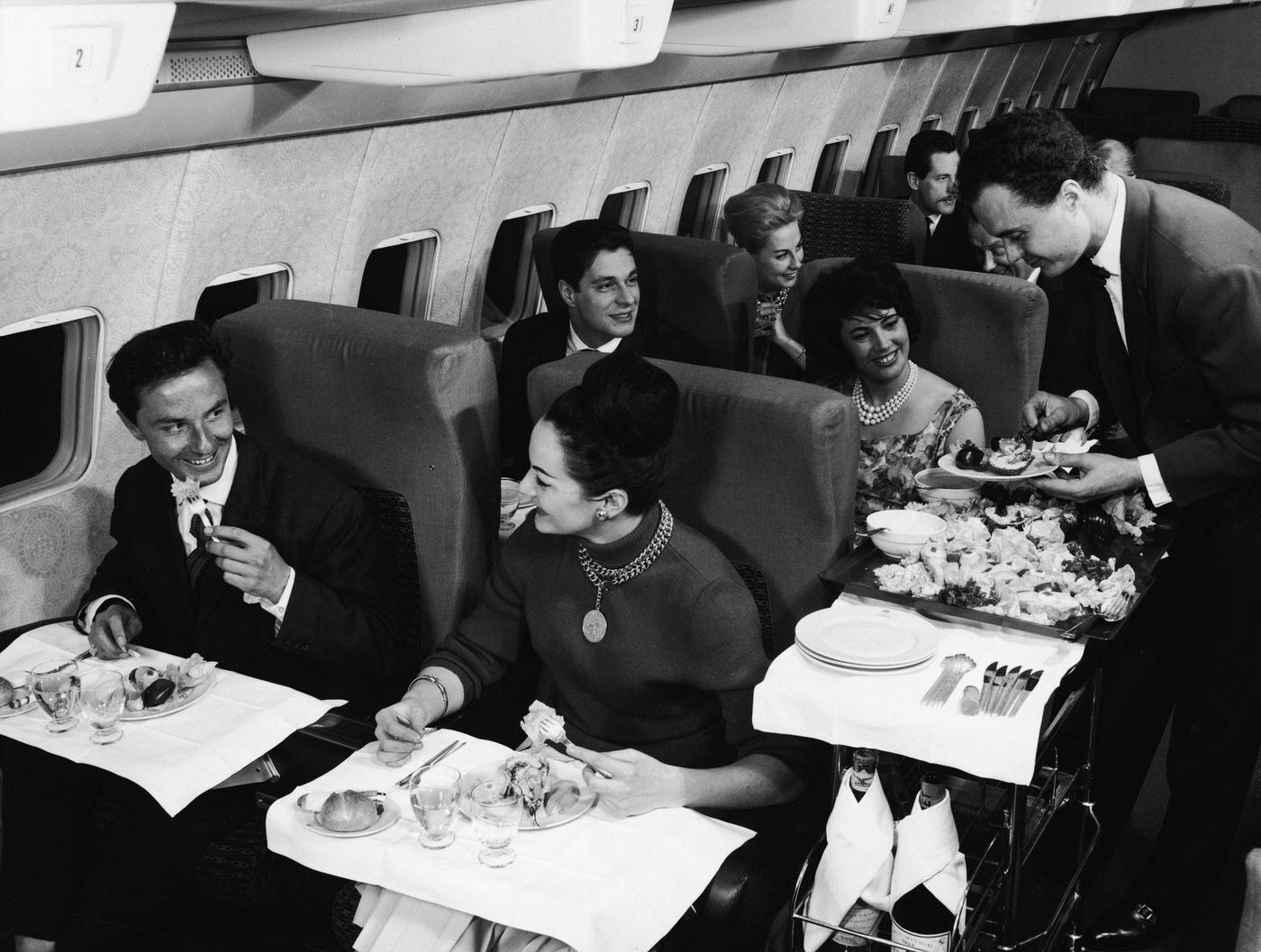
#107 In the 1950s, an interior view of a commercial passenger plane shows a woman contemplating a move in a checkers game she is losing to a young girl, while a man with a cigarette watches them.
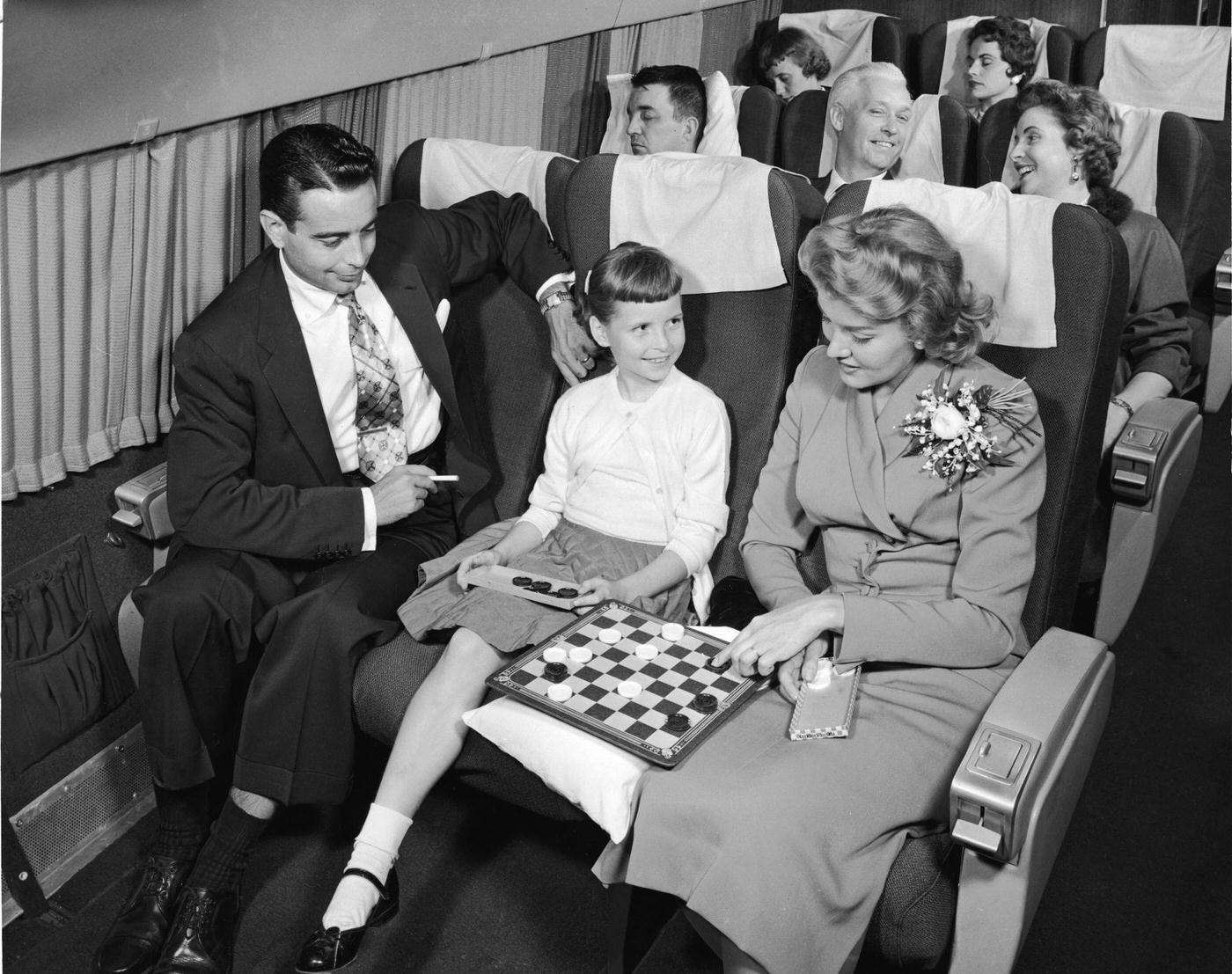
#108 Passengers on a Transocean Air lines Boeing 377 Stratocruiser in the mid-1950s. Transocean Air lines was a pioneer discount airline that flew between 1946 and 1962.
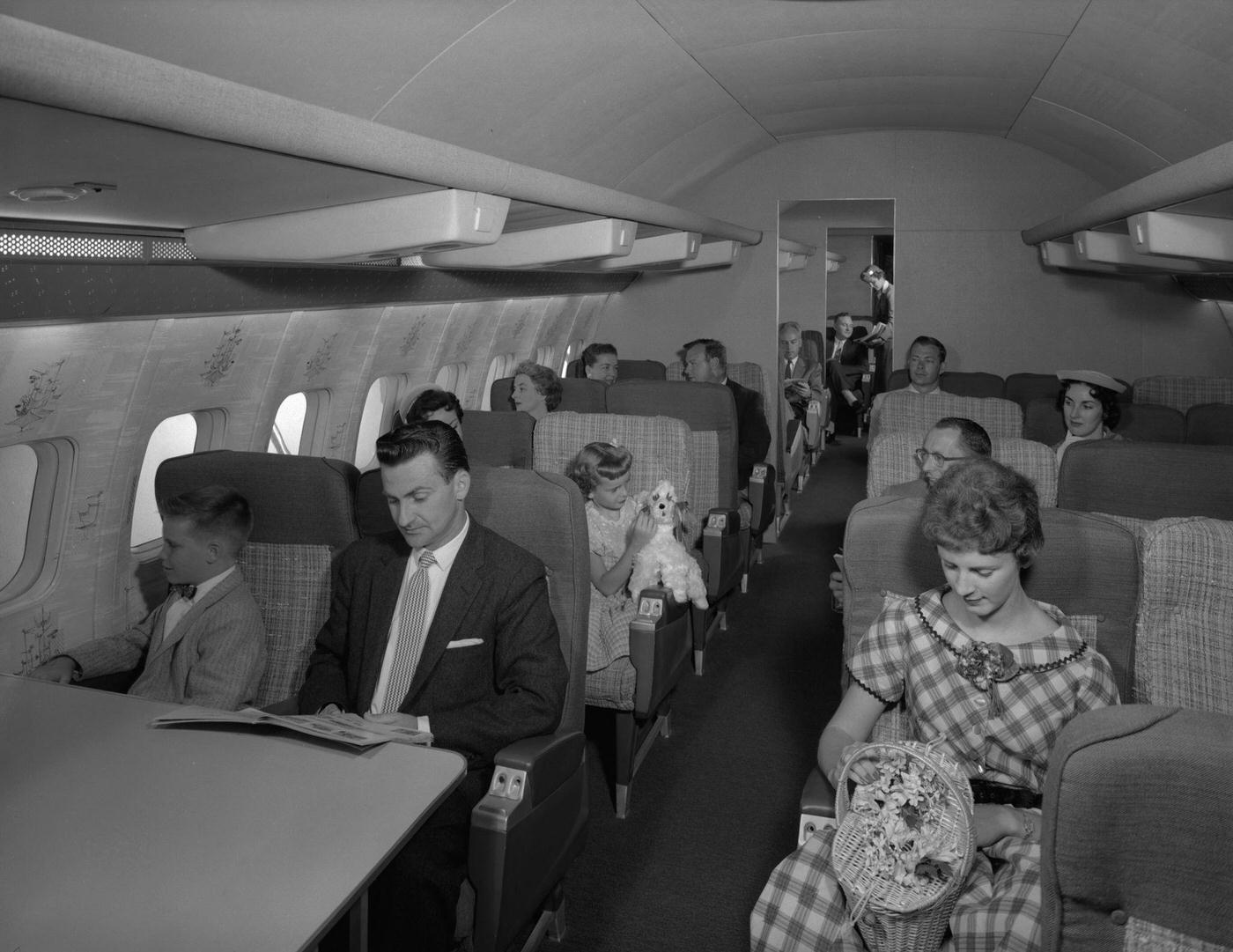
#109 Passengers prepare to take a nap on a Transocean Air lines Boeing 377 Stratocruiser in the mid-1950s. Transocean Air lines was a pioneer discount airline that flew between 1946 and 1962.
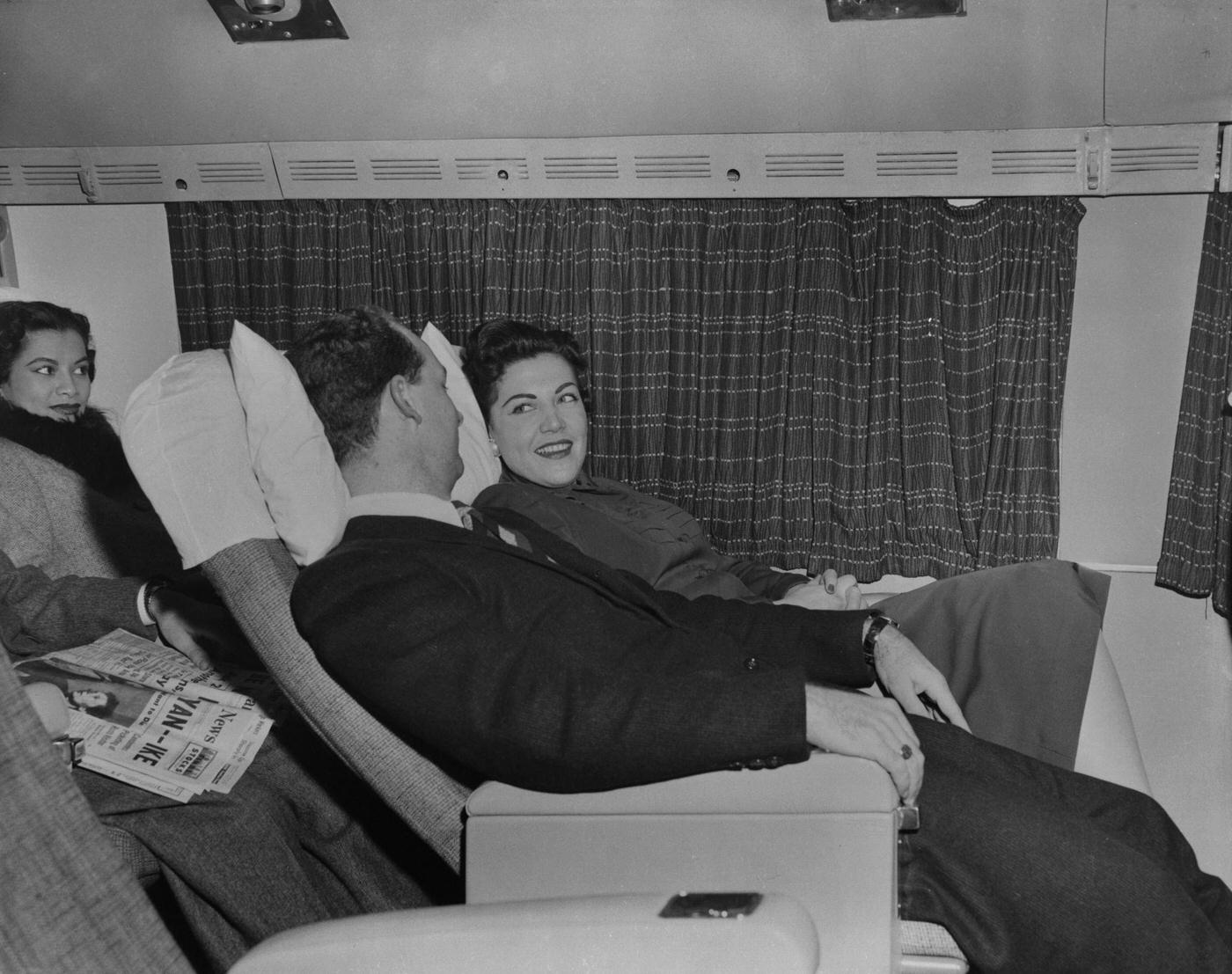
#110 Passengers on a Transocean Air Lines Boeing 377 Stratocruiser in the mid 1950s enjoy a light snack served by a friendly air hostess. Transocean Air Lines was a pioneering discount airline that operated between 1946 and 1962.
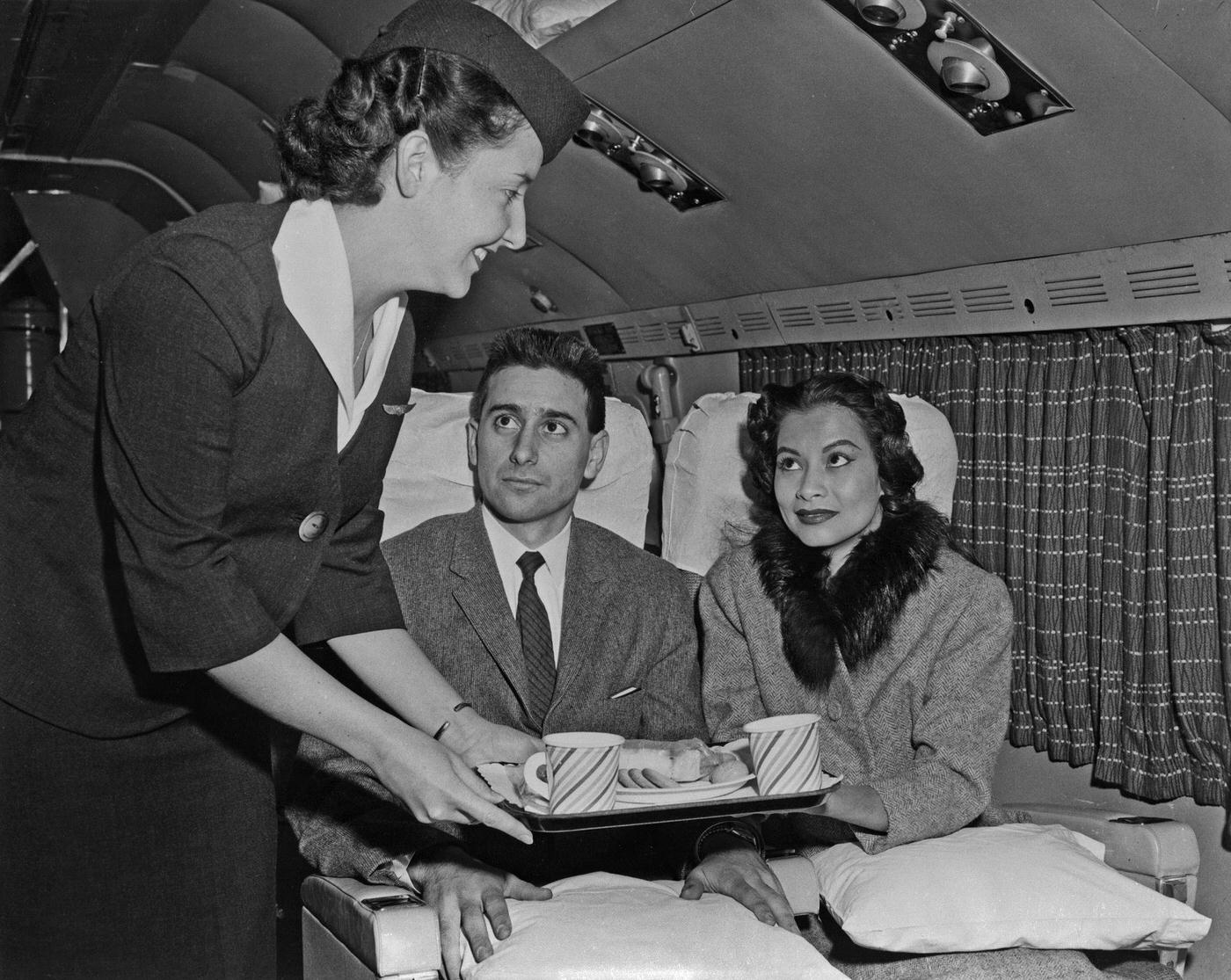
#111 During a flight on a Transocean Air Lines Boeing 377 Stratocruiser in the mid 1950s, an air hostess takes time to chat with passengers and ensure their comfort during the flight.
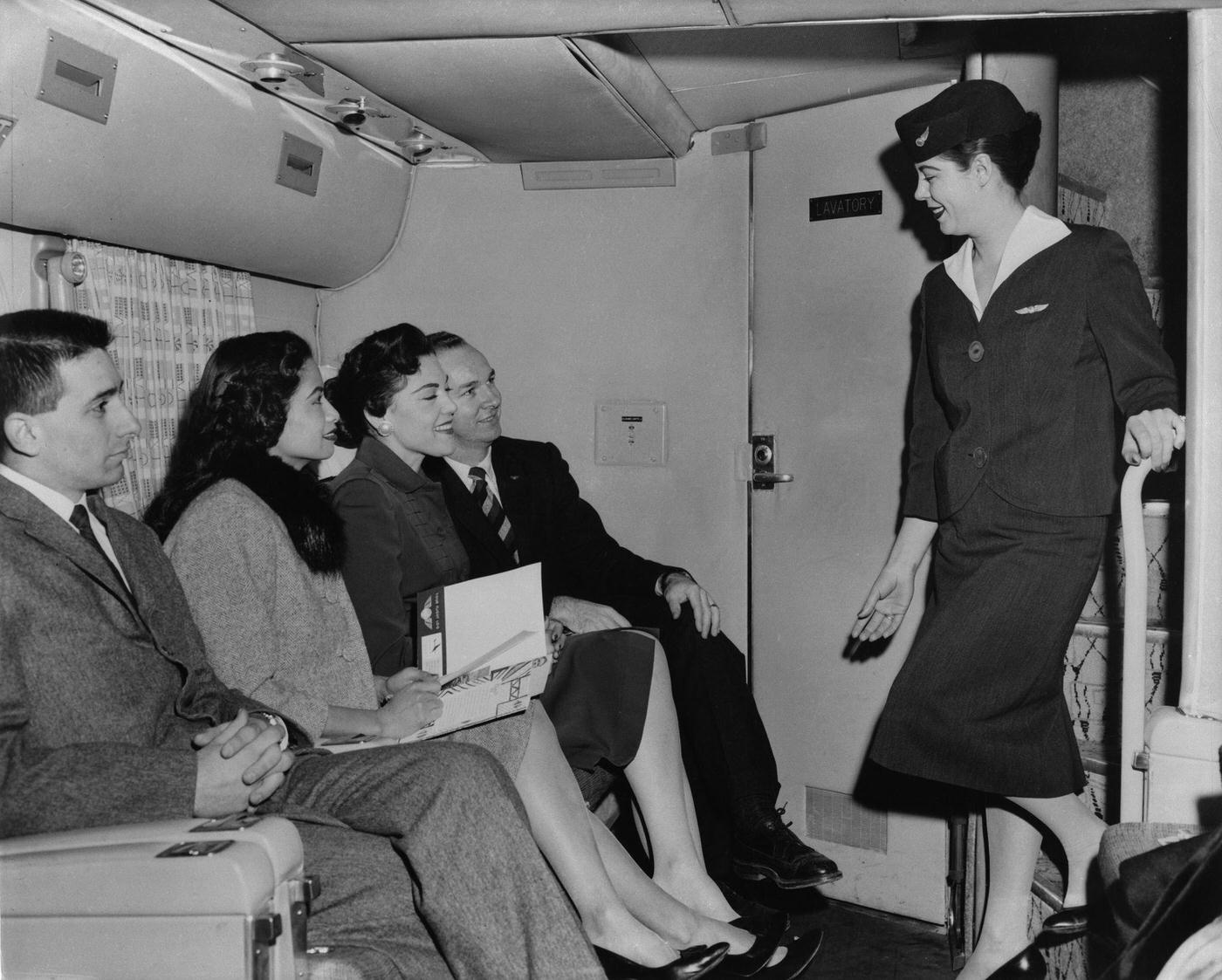
#112 Passengers take a moment to relax and enjoy a cigarette on a Transocean Air Lines Boeing 377 Stratocruiser flight in the mid 1950s. Transocean Air Lines was a pioneering discount airline that operated between 1946 and 1962.
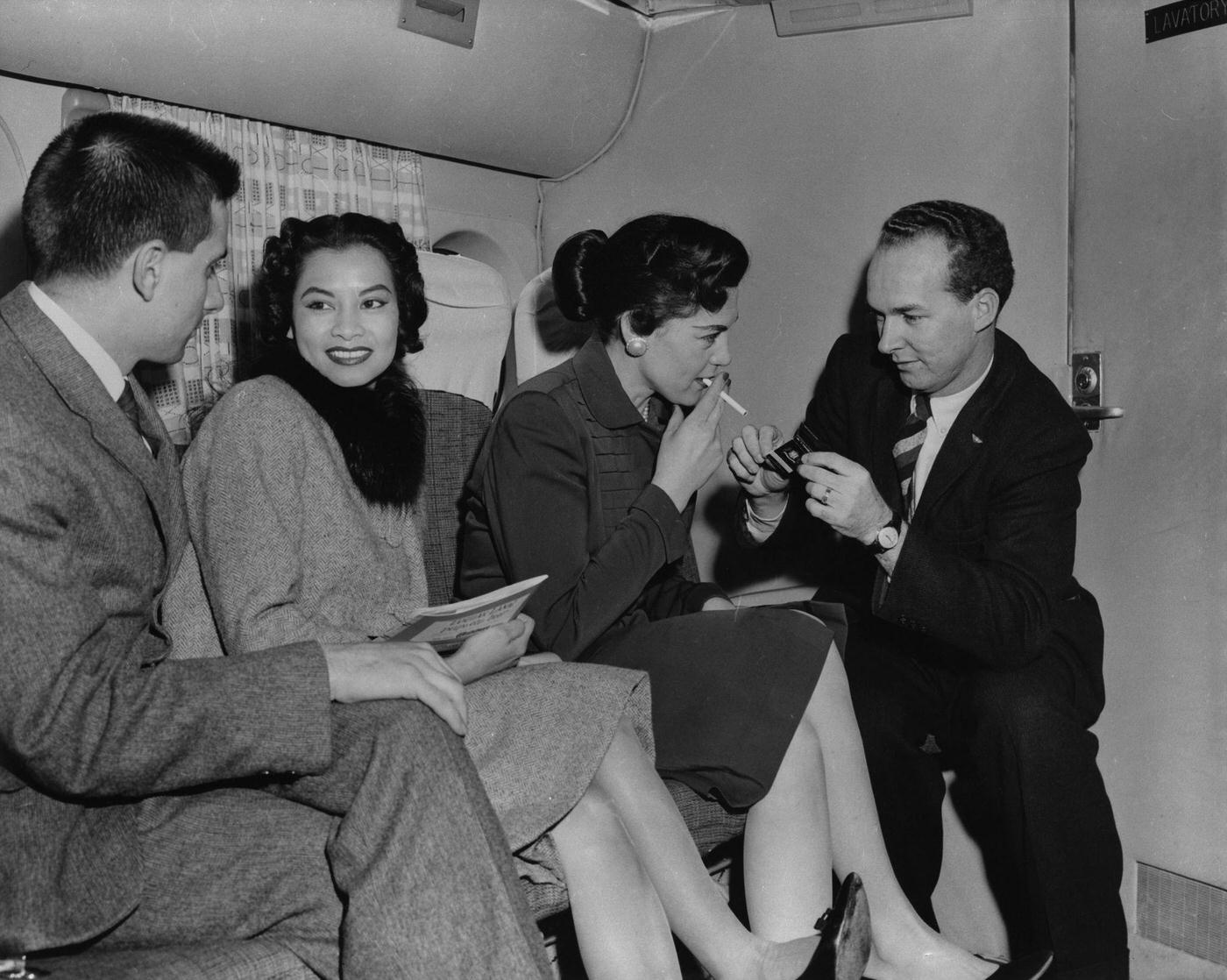
#113 An attentive air hostess serves passengers in the observation area of a Transocean Air Lines Boeing 377 Stratocruiser during a flight in the mid 1950s.
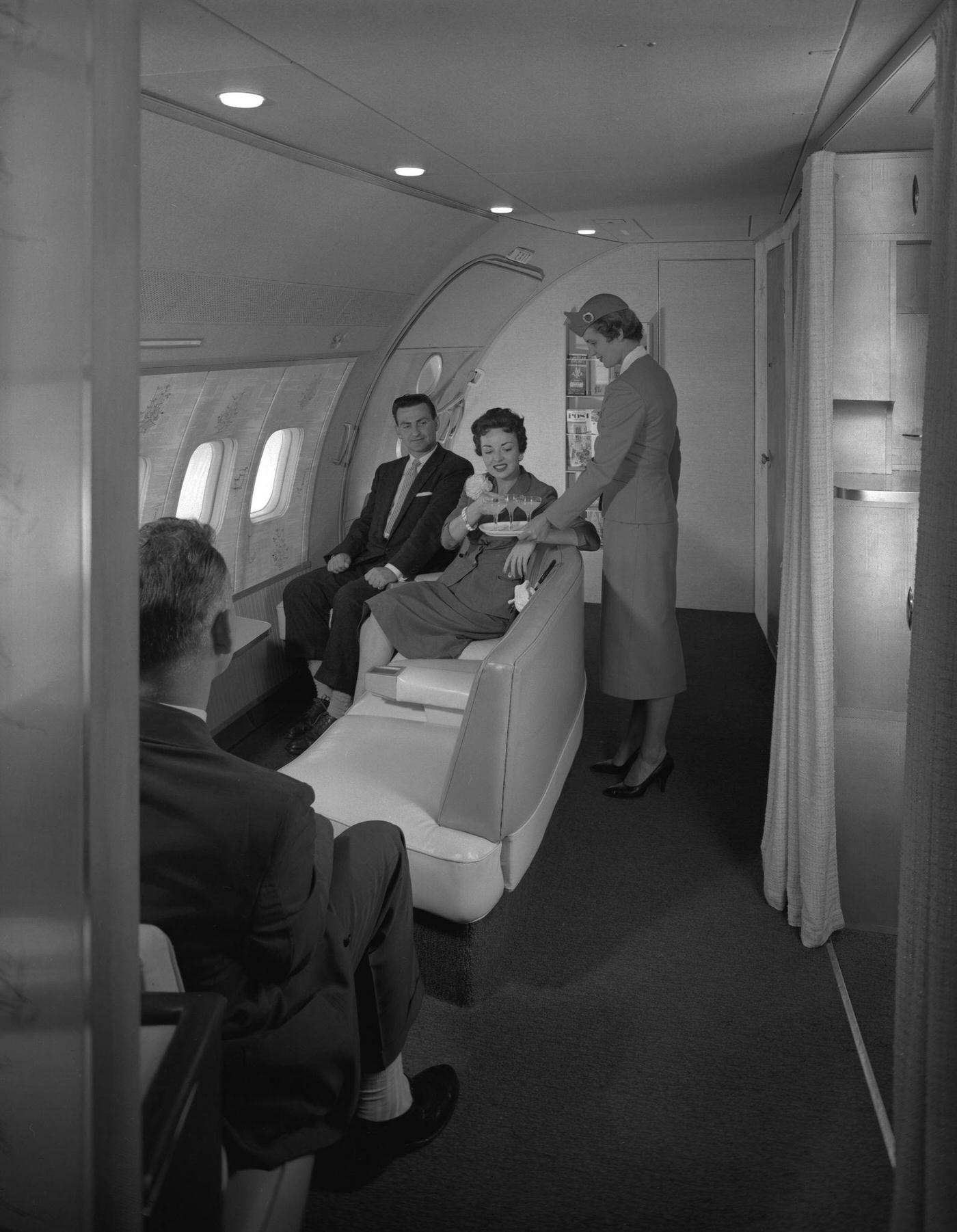
#114 Passengers are treated to excellent service on a Transocean Air Lines Boeing 377 Stratocruiser flight in the mid 1950s as an air hostess serves refreshments in the observation area. Transocean Air Lines was a pioneering discount airline that operated between 1946 and 1962.
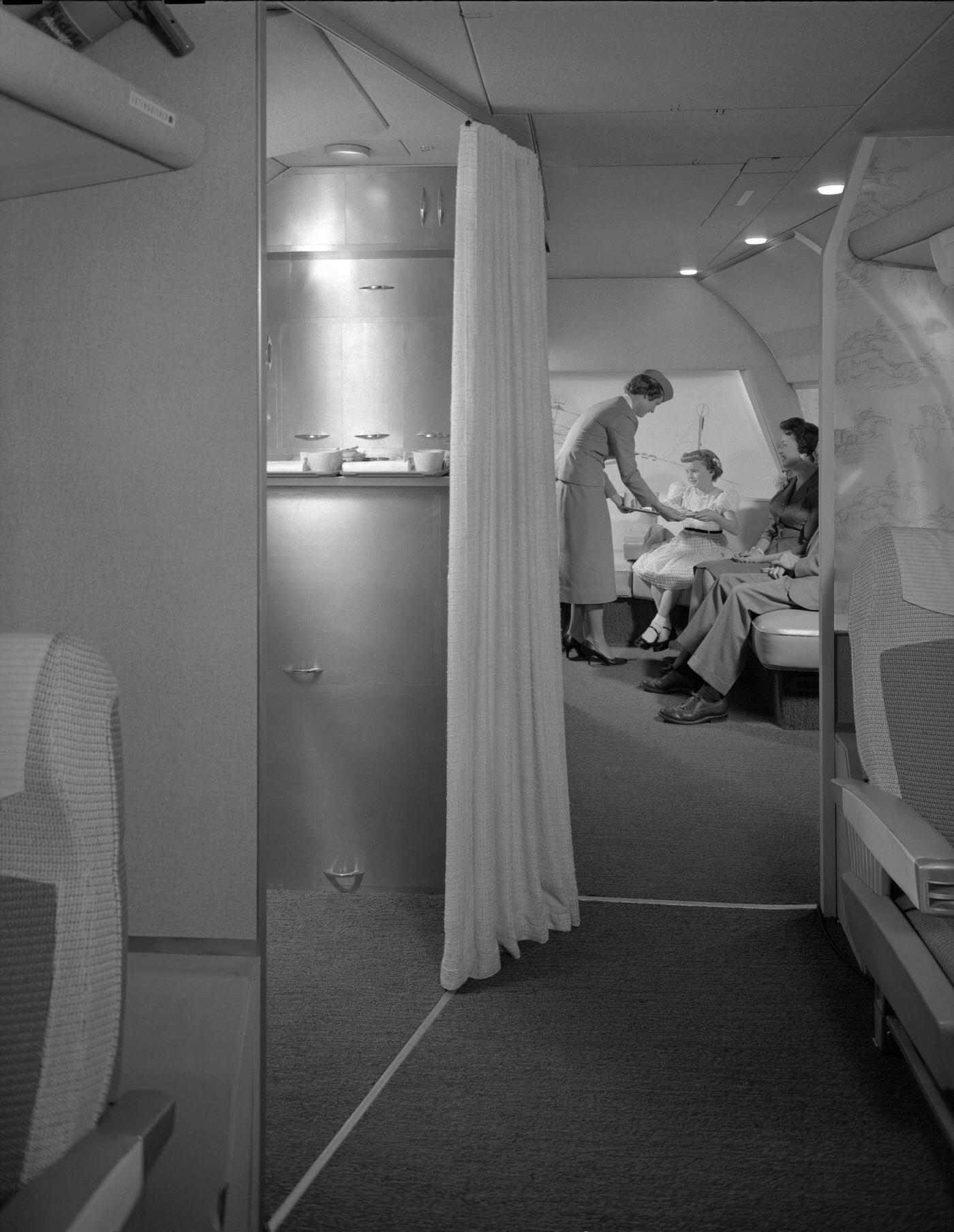
#115 Luggage being unloaded from airplane, 1950s
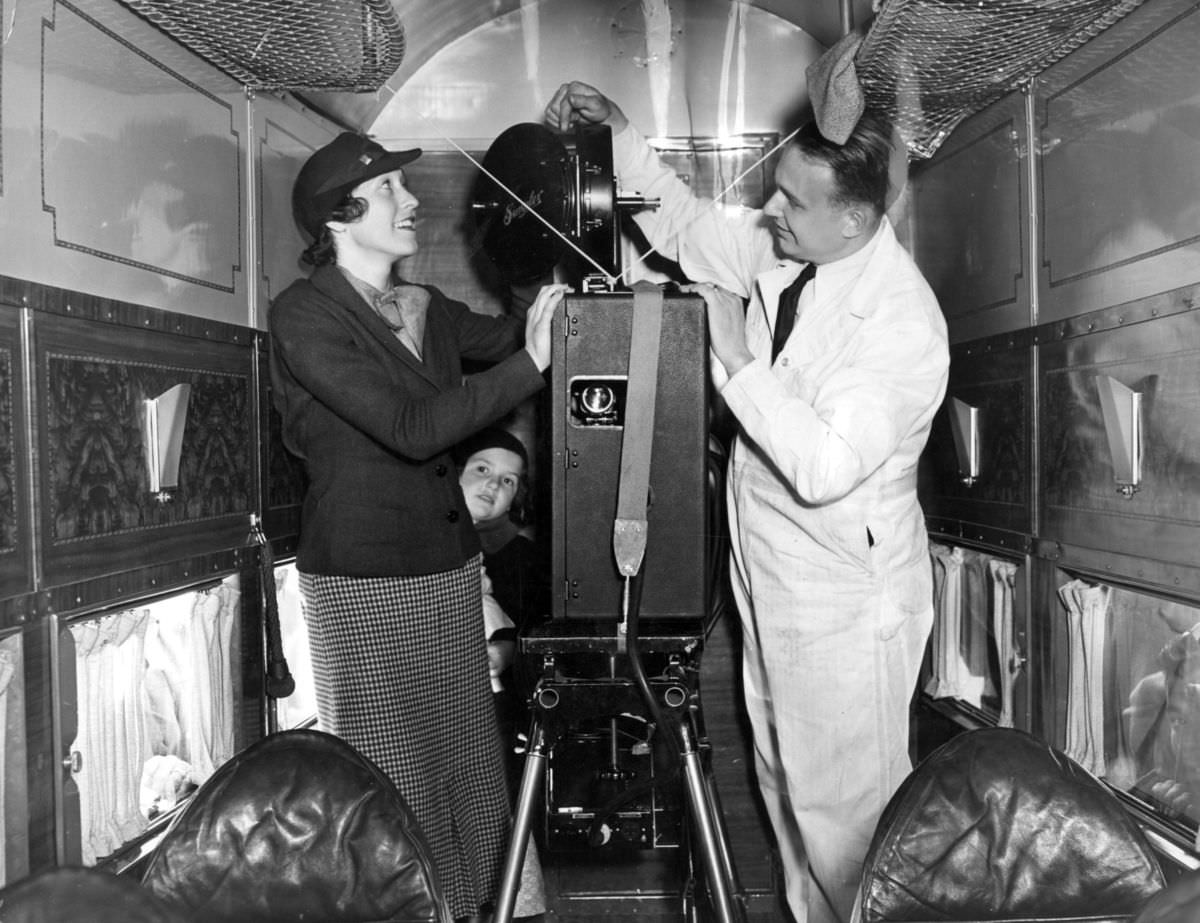
Written by Aurora Hale
I am a blogger, entrepreneur and small business coach. I'm an introvert and cat lover. My favourite hobbies are breakfast, lunch, and dinner.
© 2024 Bygonely
Share this Post 🥺
With social network:, or with username:.
Username or Email Address
Remember Me
Don't have an account? Register
Forgot password?
Enter your account data and we will send you a link to reset your password.
Your password reset link appears to be invalid or expired.
Privacy policy.
To use social login you have to agree with the storage and handling of your data by this website. Privacy Policy
Add to Collection
Public collection title
Private collection title
No Collections
Here you'll find all collections you've created before.
Hey Friend 🥺 Before You Go…
Subscribe to our newsletter and get the best historical content straight into your inbox.
Email address:
Don't worry, we don't spam

COMMENTS
In the 1920s, forget about jaunting across the Atlantic for a vacation in Europe in an airplane. Passenger airplanes were incapable of traveling long distances. Most were only able to fly for an hour or two before stopping to refuel. They also couldn't go faster than 100 mph or go higher than 3,000 feet in altitude.
Commercial Airlines initially struggled to get off the ground, but with help from the government, who awarded airlines contracts to deliver the mail, they soon began to flourish. Despite the Great Depression, air transportation experienced phenomenal growth and change from the late 1920s through the 1930s, before U.S. entry into World War II intervened.
As the decade of the 1940s ended, the era of commercial flight between the 1950s and 1960s was born and became known as the 'Golden Age of Air Travel' and the 'Jet Age'. By 1950, the trans-Atlantic route became the most traveled in the world, and its growing trade produced high profits and intense competition between major international ...
Tagged 1920 airplanes, 1920s passenger planes, air travel in the 1920s, aviation in the 1920s. Rob V. Rob V. founded Century-of-Flight.net in October of 2019. He holds commercial single and multi-engine instrument ratings, and is a licensed CFI / CFII for both single and multi-engine aircraft.
Here's a look back at what traveling was like 100 years ago. Commercial flights have been taking to the skies for more than a century. In the early 1920s, aviator Alfred W. Lawson built a series ...
Air travel was often slower than train travel and only happened during the day. In the 1920s, people bundled up for flights. Fox Photos/Stringer/Getty Images
Despite the Great Depression, air transportation experienced phenomenal growth and change from the late 1920s through the 1930s, before U.S. entry into World War II intervened. ... Sweeping cultural changes in the 1960s and 1970s reshaped the airline industry. More people began to fly, and air travel became less exclusive—for some. Across the ...
As detailed in the article The Birth of Commercial Aviation, the first successful airlines in the United States emerged from the Contract Air Mail (CAM) carriers established by the U.S. government and Postal Service that began operations in 1926.Turning the tide on a trend of failed ventures in early U.S. passenger air travel, the first airline to break through to economic success would be the ...
In the early days of commercial flight, the flying experience was harsh and uncomfortable. To even get the opportunity to fly was considered a luxury. Learn more about the evolution of the commercial flying experience in the United States using objects from the Museum's collection. Jump to: 1914-1927 1927-1941 1941-1958 1958-Today.
1920s . The roaring '20s really opened our eyes up to the romance and excitement of travel. ... let's go ahead and throw on "Lifestyles of the Rich and Famous," because the 2010s are when air ...
Air mail postal service started on the East Coast in 1918 and in 1921 expanded to California. The decade of the 1920s saw increased use of airplanes for mail, passenger, and freight service. Fourteen domestic airlines were founded in 1926. Charles Lindbergh's airplane, the Spirit of St. Louis. Written by Claudia Reinhardt.
Now a new book, Mapping the Airways, conjures the romance of those early days with a collection of maps from the British Airways Heritage Collection, the airline's archive of records and ...
Huge airships once embodied the future of air travel as they carried passengers across the world's oceans. ... airships began providing the first commercial transatlantic flights during the 1920s ...
The growing industry of travel agencies. People of the 1920s were already avid customers of travel agencies. The oldest one established by Thomas Cook dates back to 1840. It was the first to organize an air tour from New York to Chicago in 1927, advertising the experience of flight rather than a mere mode of transportation.
Air travel in the 1920s and 1930s was not confined to journeys on commercial airlines. Wherever flying had taken hold, and especially where flying clubs had been established, people flew privately for pleasure in small, light aircraft. Some journeys tracked commercial air routes across continents. Concurrent with the craze of motor touring ...
Flight naturally became even more of a sport in the early 1920s, and it also encouraged aviators to push the limits of flight (transatlantic challenges), but many others saw its commercial potential. As early as August 1919, Aircraft Transport & Travel began its aeroplane service from London to Paris.
This exhibit is now closed. Americans were wild about aviation in the 1920s and '30s, the period between the two world wars that came to be known as the Golden Age of Flight. Air races and daring record-setting flights dominated the news. Airplanes evolved from wood-and-fabric biplanes to streamlined metal monoplanes.
At the dawn of commercial air travel, Imperial Airways was Britain's shuttle to the world. As the British Empire's lone international airline in the 1920s and '30s, Imperial was responsible for ...
Passenger air travel in the 1920s and 30s was a uniquely exhilarating experience — provided you could afford it. But for those of us stuck in a world where flying has become a mundane and ...
In the 1930s, planes began to hit the 200 mph mark, and settled into a cruising altitude of about 13,000 feet. Not for the faint of heart. British Airways Empire Class planes in the 1930s were ...
The Scary Truth About Air Travel in the Downton Abbey Era. ... flying at all in the mid-1920s was a bold move. Stunt and military pilots had been taking to the skies for years, but commercial air ...
In many ways, air travel in the 1930s was similar to flying in the 1920s: planes were prone to turbulence and couldn't travel long distances. However, technology made the cabin experience more comfortable. For those who could afford to fly, air travel became a true luxury experience. Here is what it would have been like to travel by air in ...
A Look at Golden age of Air Travel in the 1950s. 177 Views. Air travel in the 1950s was marked by a significant increase in the number of people flying, as well as advancements in aircraft technology and infrastructure. The decade saw the introduction of jet airliners, which greatly increased the speed and efficiency of air travel.